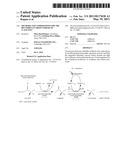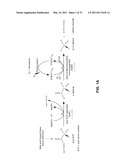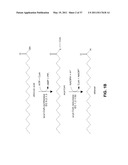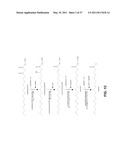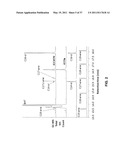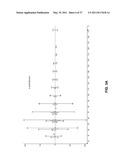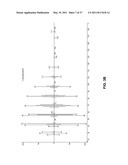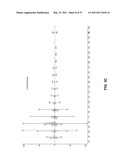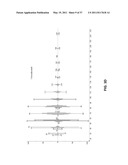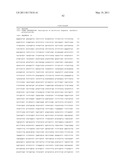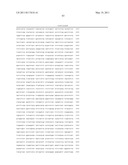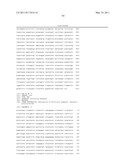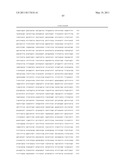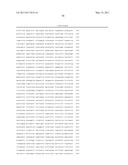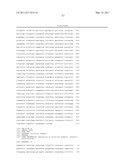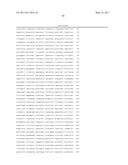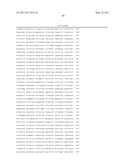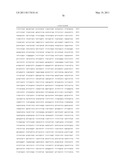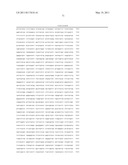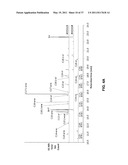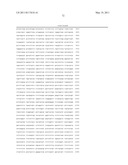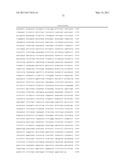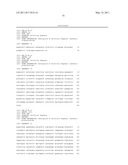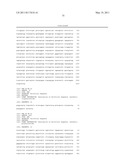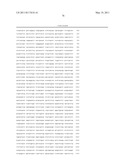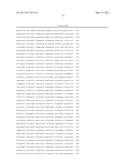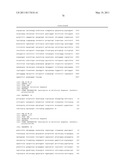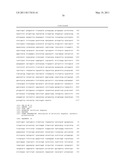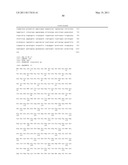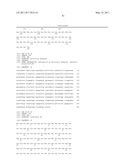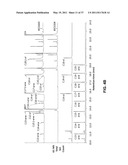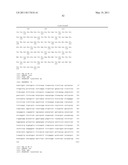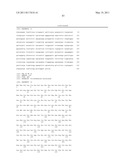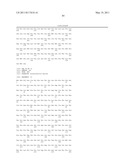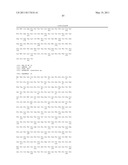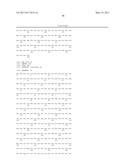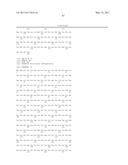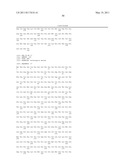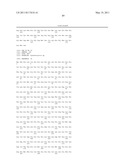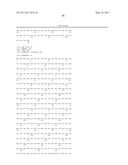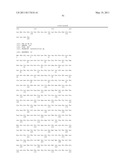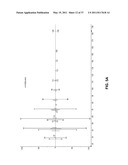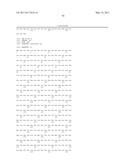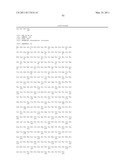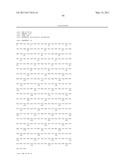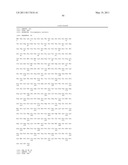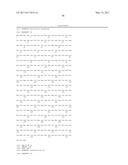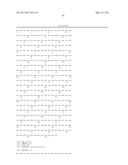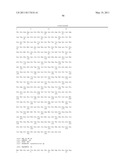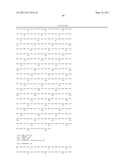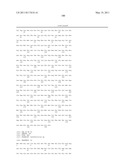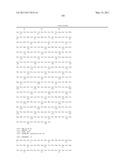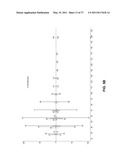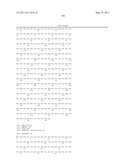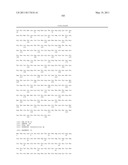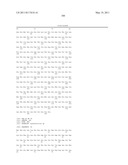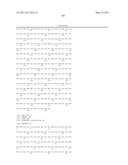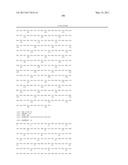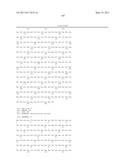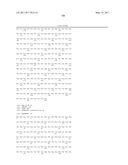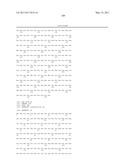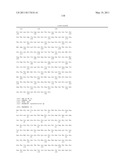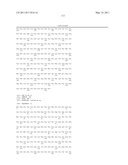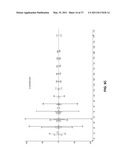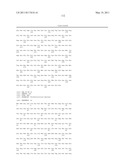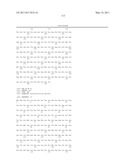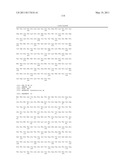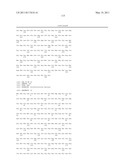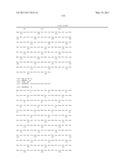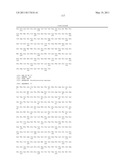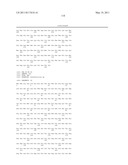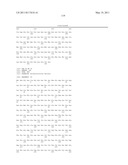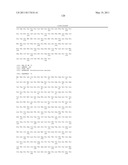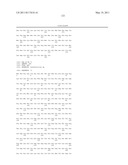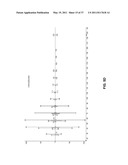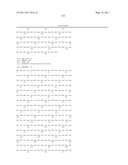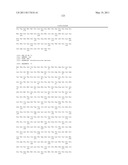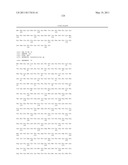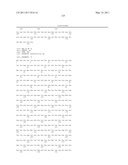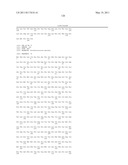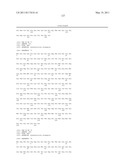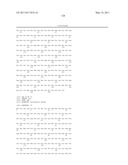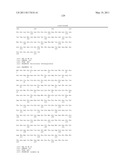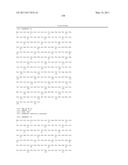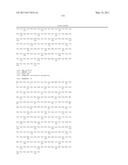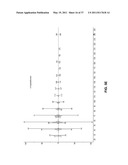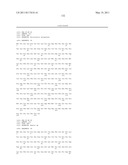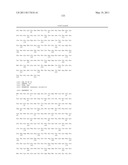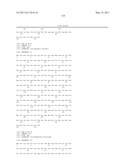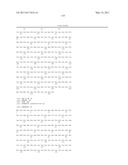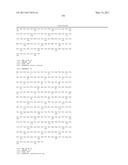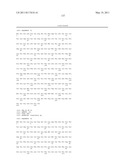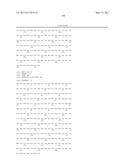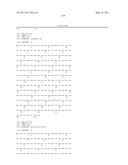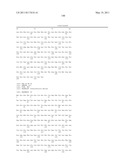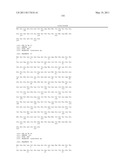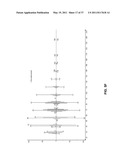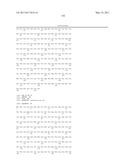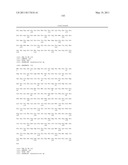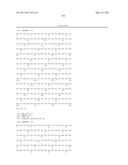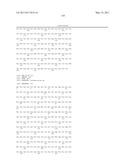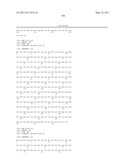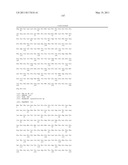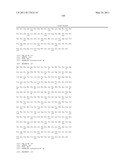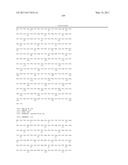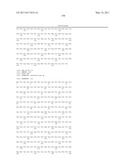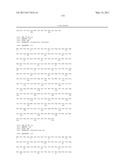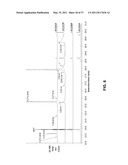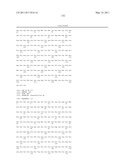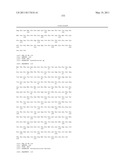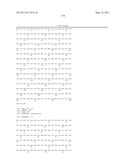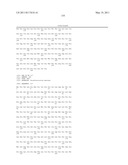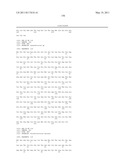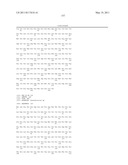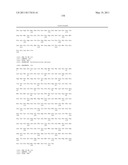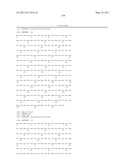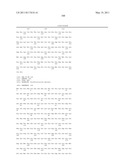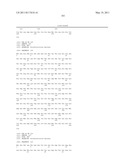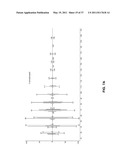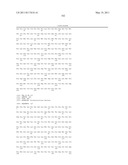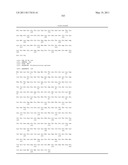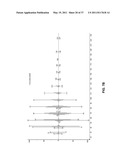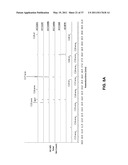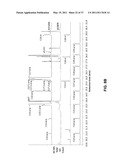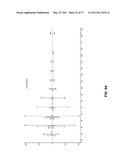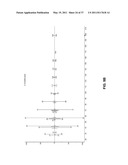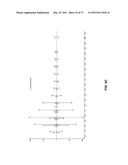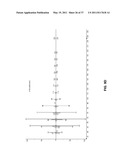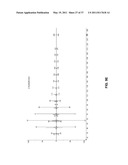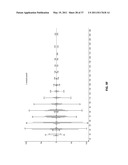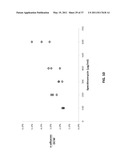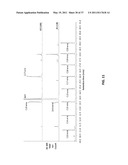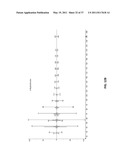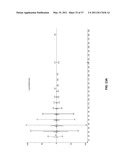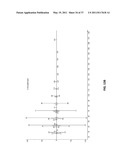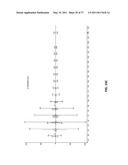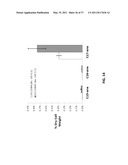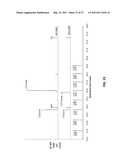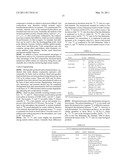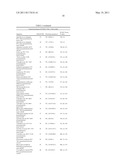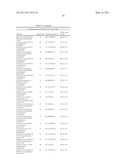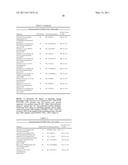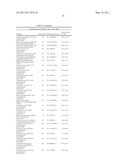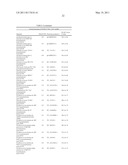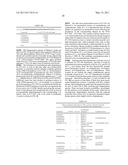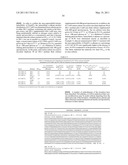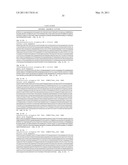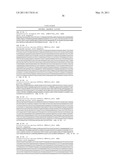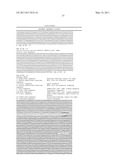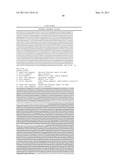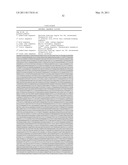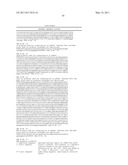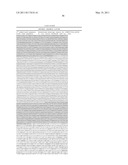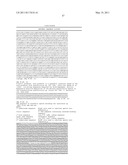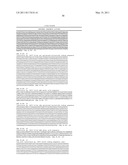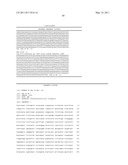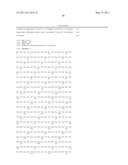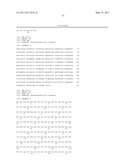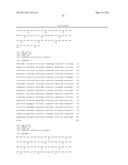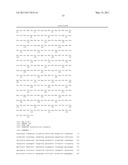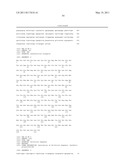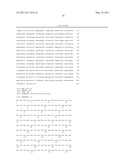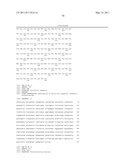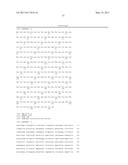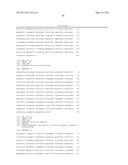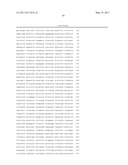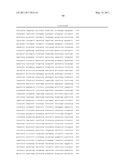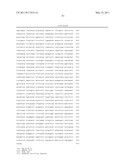Patent application title: Methods and Compositions for the Recombinant Biosynthesis of n-Alkanes
Inventors:
Nikos Basil Reppas (Brookline, MA, US)
Nikos Basil Reppas (Brookline, MA, US)
Christian Perry Ridley (Acton, MA, US)
Christian Perry Ridley (Acton, MA, US)
Assignees:
JOULE UNLIMITED, INC.
IPC8 Class: AC12P502FI
USPC Class:
435167
Class name: Micro-organism, tissue cell culture or enzyme using process to synthesize a desired chemical compound or composition preparing hydrocarbon only acyclic
Publication date: 2011-05-19
Patent application number: 20110117618
Claims:
1. A method for producing hydrocarbons, comprising: (i) culturing an
engineered cyanobacterium in a culture medium, wherein said engineered
cyanobacterium comprises a recombinant acyl-ACP reductase enzyme and a
recombinant alkanal decarboxylative monooxygenase enzyme, wherein at
least one of said recombinant enzymes is heterologous with respect to
said engineered cyanobacterium; and (ii) exposing said engineered
cyanobacterium to light and carbon dioxide, wherein said exposure results
in the conversion of said carbon dioxide by said engineered
cynanobacterium into n-alkanes, wherein the predominant n-alkane is
n-pentadecane.
2. The method of claim 1, wherein the amount of said n-alkanes produced is at least two times the amount produced by an otherwise identical cyanobacterium, cultured under identical conditions, but lacking said recombinant acyl-ACP reductase and alkanal decarboxylative monooxygenase enzymes.
3. The method of claim 1, wherein said engineered cyanobacterium produces n-alkanes comprising both n-pentadecane and n-heptadecane, and wherein the percentage by mass of n-pentadecane relative to n-pentadecane plus n-heptadecane is at least 50%.
4-5. (canceled)
6. The method of claim 1, further comprising isolating n-pentadecanefrom said engineered cyanobacterium or said culture medium.
7. The method of claim 1, wherein said enzymes are encoded by a plasmid.
8. The method of claim 1 wherein said enzymes are encoded by recombinant genes incorporated into the genome of said engineered cyanobacterium.
9. The method of claim 1 wherein said enzymes are encoded by genes which are present in multiple copies in said engineered cyanobacterium.
10-15. (canceled)
16. The method of claim 1, wherein said acyl-ACP reductase and alkanal decarboxylative monooxygenase enzymes are at least 95% identical to SEQ ID NO: 10 and SEQ ID NO: 12, respectively.
17-19. (canceled)
20. The method of claim 1, wherein said acyl-ACP reductase enzyme and said recombinant alkanal decarboxylative monooxygenase enzyme are encoded by genes which are part of an operon, and wherein the expression of said genes is controlled by one or more inducible promoters.
21. The method of claim 20, wherein at least one promoter is a urea-repressible, nitrate-inducible promoter.
22. (canceled)
23. The method of claim 21, wherein said nirA-type promoter is P(nir07).
24. The method of claim 1, wherein said recombinant acyl-ACP reductase and alkanal decarboxylative monooxygenase enzymes are least 95% identical to SEQ ID NO: 27 and SEQ ID NO: 29, respectively.
25. The method of claim 1, wherein said engineered cyanobacterium comprises at least two operons encoding distinct alkanal decarboxylative monooxygenase and acyl-ACP reductase enzymes.
26. The method of claim 25, wherein at least one operon encodes acyl-ACP reductase and alkanal decarboxylative monooxygenase enzymes which are at least 95% identical to SEQ ID NO: 27 and SEQ ID NO: 29, respectively.
27. The method of claim 25, wherein at least one operon encodes acyl-ACP reductase and alkanal decarboxylative monooxygenase enzymes which are at least 95% identical to SEQ ID NO:10 and SEQ ID NO: 12, respectively.
28. The method of claim 8, wherein said acyl-ACP reductase and alkanal decarboxylative monooxygenase enzymes are at least 95% identical to SEQ ID NO:10 and SEQ ID NO:12, respectively.
29. The method of claim 28, wherein expression of said acyl-ACP reductase and alkanal decarboxylative monooxygenase enzymes is controlled by an inducible promoter.
30. The method of claim 29, wherein said engineered cyanobacterium produces at least 0.5% DCW n-alkanes in the presence of an inducer.
31. The method of claim 29, wherein said engineered cyanobacterium further comprises a second operon encoding acyl-ACP reductase and alkanal decarboxylative monooxygenase enzymes which are at least 95% identical to SEQ ID NO: 27 and SEQ ID NO: 29, respectively.
32. The method of claim 1 wherein at least 95% of said n-alkanes, by mass, are n-pentadecane and n-heptadecane, and wherein the percentage by mass of n-pentadecane relative to n-pentadecane plus n-heptadecane is at least 80%.
33-36. (canceled)
Description:
CROSS-REFERENCE TO RELATED APPLICATIONS
[0001] This application claims priority to earlier filed U.S. Provisional Patent Application No. 61/224,463 filed, Jul. 9, 2009, U.S. Provisional Patent Application No. 61/228,937, filed Jul. 27, 2009, and U.S. utility application Ser. No. 12/759,657, filed Apr. 13, 2010, the disclosures of which are incorporated herein by reference.
FIELD OF THE INVENTION
[0002] The present disclosure relates to methods for conferring alkane-producing properties to a heterotrophic or photoautotrophic host, such that the modified host can be used in the commercial production of bioalkanes.
BACKGROUND OF THE INVENTION
[0003] Many existing photoautotrophic organisms (i.e., plants, algae, and photosynthetic bacteria) are poorly suited for industrial bioprocessing and have therefore not demonstrated commercial viability. Such organisms typically have slow doubling times (3-72 hrs) compared to industrialized heterotrophic organisms such as Escherichia coli (20 minutes), reflective of low total productivities. While a desire for the efficient biosynthetic production of fuels has led to the development of photosynthetic microorganisms which produce alkyl esters of fatty acids, a need still exists for methods of producing hydrocarbons, e.g., alkanes, using photosynthetic organisms.
SUMMARY OF THE INVENTION
[0004] The present invention provides, in certain embodiments, isolated polynucleotides comprising or consisting of nucleic acid sequences selected from the group consisting of the coding sequences for AAR and ADM enzymes, nucleic acid sequences that are codon-optimized variants of these sequences, and related nucleic acid sequences and fragments.
[0005] An AAR enzyme refers to an enzyme with the amino acid sequence of the SYNPCC7942--1594 protein (SEQ ID NO: 6) or a homolog thereof, wherein a SYNPCC7942--1594 homolog is a protein whose BLAST alignment (i) covers >90% length of SYNPCC7942--1594, (ii) covers >90% of the length of the matching protein, and (iii) has >50% identity with SYNPCC7942--1594 (when optimally aligned using the parameters provided herein), and retains the functional activity of SYNPCC7942--1594, i.e., the conversion of an acyl-ACP (ACP=acyl carrier protein) to an alkanal. An ADM enzyme refers to an enzyme with the amino acid sequence of the SYNPCC7942--1593 protein (SEQ ID NO: 8) or a homolog thereof, wherein a SYNPCC7942--1593 homolog is defined as a protein whose amino acid sequence alignment (i) covers >90% length of SYNPCC7942--1593, (ii) covers >90% of the length of the matching protein, and (iii) has >50% identity with SYNPCC7942--1593 (when aligned using the preferred parameters provided herein), and retains the functional activity of SYNPCC7942--1593, i.e., the conversion of an n-alkanal to an (n-1)-alkane. Exemplary AAR and ADM enzymes are listed in Table 1 and Table 2, respectively. Genes encoding AAR or ADM enzymes are referred to herein as AAR genes (aar) or ADM genes (adm), respectively.
[0006] Preferred parameters for BLASTp are: Expectation value: 10 (default); Filter: none; Cost to open a gap: 11 (default); Cost to extend a gap: 1 (default); Maximum alignments: 100 (default); Word size: 11 (default); No. of descriptions: 100 (default); Penalty Matrix: BLOWSUM62.
[0007] While Applicants refer herein to an alkanal decarboxylative monooxygenase enzyme, Applicants do so without intending to be bound to any particular reaction mechanism unless expressly set forth. For example, whether the enzyme encoded by SYNPCC7942--1593 or any other ADM gene carries out a decarbonylase or a decarboxylase reaction does not affect the utility of Applicants' invention, unless expressly set forth herein to the contrary.
[0008] The present invention further provides isolated polypeptides comprising or consisting of polypeptide sequences selected from the group consisting of the sequences listed in Table 1 and Table 2, and related polypeptide sequences, fragments and fusions. Antibodies that specifically bind to the isolated polypeptides of the present invention are also contemplated.
[0009] The present invention also provides methods for expressing a heterologous nucleic acid sequence encoding AAR and ADM in a host cell lacking catalytic activity for AAR and ADM (thereby conferring n-alkane producing capability in the host cell), or for expressing a nucleic acid encoding AAR and ADM in a host cell which comprises native AAR and/or ADM activity (thereby enhancing n-alkane producing capability in the host cell).
[0010] In addition, the present invention provides methods for producing carbon-based products of interest using the AAR and ADM genes, proteins and host cells described herein. For example, in one embodiment the invention provides a method for producing hydrocarbons, comprising: (i) culturing an engineered cyanobacterium in a culture medium, wherein said engineered cyanobacterium comprises a recombinant AAR enzyme and a recombinant ADM enzyme; and (ii) exposing said engineered cyanobacterium to light and carbon dioxide, wherein said exposure results in the conversion of said carbon dioxide by said engineered cynanobacterium into n-alkanes, wherein at least one of said n-alkanes is selected from the group consisting of n-tridecane, n-tetradecane, n-pentadecane, n-hexadecane, and n-heptadecane, and wherein the amount of said n-alkanes produced is between 0.1% and 5% dry cell weight and at least two times the amount produced by an otherwise identical cyanobacterium, cultured under identical conditions, but lacking said recombinant AAR and ADM enzymes.
[0011] In a related embodiment, the amount on n-alkanes produced by the engineered cyanobacterium is at least 0.1%, 0.2%, 0.3%, 0.4%, 0.5%, 0.6%, 0.7%, 0.8%, 0.9%, or 1% DCW, and at least two times the amount produced by an otherwise identical cyanobacterium, cultured under identical conditions, but lacking said recombinant AAR and ADM enzymes.
[0012] In a related embodiment, at least one of said recombinant enzymes is heterologous with respect to said engineered cyanobacterium. In another embodiment, said cyanobacterium does not synthesize alkanes in the absence of the expression of one or both of the recombinant enzymes. In another embodiment, at least one of said recombinant AAR or ADM enzymes is not heterologous to said engineered cyanobacterium.
[0013] In another related embodiment of the method, said engineered cyanobacterium further produces at least one n-alkene or n-alkanol. In yet another embodiment, the engineered cyanobacterium produces at least one n-alkene or n-alkanol selected from the group consisting of n-pentadecene, n-heptadecene, and 1-octadecanol. In a related embodiment, said n-alkanes comprise predominantly n-heptadecane, n-pentadecane or a combination thereof. In a related embodiment, more n-heptadecane and/or n-pentadecane are produced than all other n-alkane products combined. In yet another related embodiment, more n-heptadecane and/or n-pentadecane are produced by the engineered cyanobacterium than any other n-alkane or n-alkene produced by the engineered cyanobacterium. In yet another related embodiment, at least one n-pentadecene produced by said engineered cyanobacterium is selected from the group consisting of cis-3-heptadecene and cis-4-pentadecene. In yet another related embodiment, at least one n-heptadecene produced by said engineered cyanobacterium is selected from the group consisting of cis-4-pentadecene, cis-6-heptadecene, cis-8-heptadecene, cis-9-heptadecene, and cis, cis-heptadec-di-ene.
[0014] In yet another related embodiment, the invention further provides a step of isolating at least one n-alkane, n-alkene or n-alkanol from said engineered cyanobacterium or said culture medium. In yet another related embodiment, the engineered cyanobacterium is cultured in a liquid medium. In yet another related embodiment, the engineered cyanobacterium is cultured in a photobioreactor.
[0015] In another related embodiment, the AAR and/or ADM enzymes are encoded by a plasmid. In yet another related embodiment, the AAR and/or ADM enzymes are encoded by recombinant genes incorporated into the genome of the engineered cyanobacterium. In yet another related embodiment, the AAR and/or ADM enzymes are encoded by genes which are present in multiple copies in said engineered cyanobacterium. In yet another related embodiment, the recombinant AAR and/or ADM enzymes are encoded by genes which are part of an operon, wherein the expression of said genes is controlled by a single promoter. In yet another related embodiment, the recombinant AAR and/or ADM enzymes are encoded by genes which are expressed independently under the control of separate promoters. In yet another related embodiment, expression of the recombinant AAR and/or ADM enzymes in an engineered cyanobacterium is controlled by a promoter selected from the group consisting of a cI promoter, a cpcB promoter, a lacI-trc promoter, an EM7 promoter, an aphII promoter, a nirA promoter, and a nir07 promoter (referred to herein as "P(nir07)"). In yet another related embodiment, the enzymes are encoded by genes which are part of an operon, wherein the expression of said genes is controlled by one or more inducible promoters. In yet another related embodiment, at least one promoter is a urea-repressible, nitrate-inducible promoter. In yet another related embodiment, the urea-repressible, nitrate-inducible promoter is a nirA-type promoter. In yet another related embodiment, the nirA-type promoter is P(nir07) (SEQ ID NO: 24).
[0016] In yet another related embodiment, the cyanobacterium species that is engineered to express recombinant AAR and/or ADM enzymes produces less than approximately 0.01% DCW n-heptadecane or n-pentadecane in the absence of said recombinant AAR and/or ADM enzymes, 0.01% DCW corresponding approximately to the limit of detection of n-heptadecane and n-pentadecane by the gas chromatographic/flame ionization detection methods described herein. In another related embodiment, the engineered cyanobacterium of the method is a thermophile. In yet another related embodiment, the engineered cyanobacterium of the method is selected from the group consisting of an engineered Synechococcus sp. PCC7002 and an engineered Thermosynechococcus elongatus BP-1.
[0017] In yet another related embodiment, the recombinant AAR and/or ADM enzymes are selected from the group of enzymes listed in Table 1 and Table 2, respectively. In yet another related embodiment, the recombinant AAR enzymes are selected from the group consisting of SYNPCC7942--1594, tll1312, PMT9312--0533, and cce--1430. In yet another related embodiment, the recombinant ADM enzymes are selected from the group consisting of SYNPCC7942--1593, tll1313, PMT9312--0532, and cce--0778.
[0018] In yet another related embodiment, the recombinant AAR and ADM enzymes have the amino acid sequences of SEQ ID NO:10 and SEQ ID NO:12, respectively. In certain embodiments, the recombinant AAR and ADM enzymes are encoded by SEQ ID NOs: 9 and 11, respectively. In yet other embodiments, the recombinant AAR and ADM enzymes are encoded by SEQ ID NOs: 26 and 28, respectively, or SEQ ID NOs: 30 and 31 respectively, and have the amino acid sequences of SEQ ID NOs: 27 and 28, respectively. In certain embodiments, the recombinant AAR and ADM enzymes are encoded by SEQ ID NOs: 1 and 3, respectively, and have the amino acid sequences of SEQ NOs: 2 and 4, respectively. In still other embodiments, the recombinant AAR and ADM enzymes are encoded by SEQ ID NOs: 5 and 7, respectively, and have the amino acid sequences of SEQ ID NOs: 6 and 8, respectively.
[0019] In yet another related embodiment, the method comprising culturing the engineered cyanobacterium in the presence of an antibiotic, wherein said antibiotic selects for the presence of a recombinant gene encoding an AAR and/or ADM enzyme. In certain embodiments, the antibiotic is spectinomycin or kanamycin. In related embodiments, the amount of spectinomycin in the culture media is between 100 and 700 μg/ml, e.g., 100, 200, 300, 400, 500, 600, or 700 μg/ml of spectinomycin can be added to the culture media. In certain embodiments, the amount of spectinomycin added is about 600 μg/ml, and the amount of n-alkanes produced by the engineered cyanobacterium is at least about 3%, 4% or 5% DCW.
[0020] In another embodiment, the method for producing hydrocarbons comprises culturing a cyanobacterium expressing recombinant AAR and/or ADM enzymes in the presence of an exogenous substrate for one or both enzymes. In a related embodiment, the substrate is selected from the group consisting of an acyl-ACP, an acyl-CoA, and a fatty aldehyde. In another related embodiment, exogenous fatty alcohols or fatty esters or other indirect substrates can be added and converted to acyl-ACP or acyl-CoA by the cyanobacterium.
[0021] In yet another embodiment, the invention provides a composition comprising an n-alkane produced by any of the recombinant biosynthetic methods described herein. In yet another embodiment, the invention provides a composition comprising an n-alkene or n-alkanol produced by any of the recombinant biosynthetic methods described herein.
[0022] In certain embodiments, the invention provides an engineered host cell for producing an n-alkane, wherein said cell comprises one or more recombinant protein activities selected from the group consisting of an acyl-CoA reductase activity, an acyl-ACP reductase activity, an alkanal decarboxylative monooxygenase activity, and an electron donor activity. In related embodiments, the host cell comprises a recombinant acyl-ACP reductase activity, a recombinant alkanal decarboxylative monooxygenase activity, and a recombinant electron donor activity. In other embodiments, the host cell comprises a recombinant acyl-ACP reductase activity and a recombinant alkanal decarboxylative monooxygenase activity. In certain embodiments, the electron donor activity is a ferredoxin. In certain related embodiments, the host cell is capable of photosynthesis. In still other related embodiments, the host cell is a cyanobacterium. In still other embodiments, the host cell is a gram-negative bacterium, a gram-positive bacterium, or a yeast species.
[0023] In other embodiments, the invention provides an isolated or recombinant polynucleotide comprising or consisting of a nucleic acid sequence selected from the group consisting of: (a) SEQ ID NOs:1, 3, 5, 7, 9, 11, 13, 14, 30 or 31; (b) a nucleic acid sequence that is a degenerate variant of SEQ ID NOs: 1, 3, 5, 7, 9, 11, 13, 14, 30 or 31; (c) a nucleic acid sequence at least 90%, at least 95%, at least 96%, at least 97%, at least 98%, at least 99%%, at least 99.1%, at least 99.2%, at least 99.3%, at least 99.4%, at least 99.5%, at least 99.6%, at least 99.7%, at least 99.8% or at least 99.9% identical to SEQ ID NO: 1, 3, 5, 7, 9, 11, 13, 14, 30 or 31; (d) a nucleic acid sequence that encodes a polypeptide having the amino kid sequence of SEQ ID NO:2, 4, 6, 8, 10, 12, 27 or 29; (e) a nucleic acid sequence that encodes a polypeptide at least 50%, at least 60%, at least 70%, at least 80%, at least 90%, at least 95%, at least 96%, at least 97%, at least 98%, at least 99%%, at least 99.1%, at least 99.2%, at least 99.3%, at least 99.4%, at least 99.5%, at least 99.6%, at least 99.7%, at least 99.8% or at least 99.9% identical to SEQ ID NO:2, 4, 6, 8, 10, 12, 27 or 39; and (f) a nucleic acid sequence that hybridizes under stringent conditions to SEQ ID NOs: 1, 3, 5, 7, 9, 11, 13, 14, 30 or 31. In related embodiments, the nucleic acid sequence encodes a polypeptide having acyl-ACP reductase activity or alkanal decarboxylative monooxygenase activity.
[0024] In yet another embodiment, the invention provides an isolated, soluble polypeptide with alkanal decarboxylative monooxygenase activity wherein, in certain related embodiments, the polypeptide has an amino acid sequence of one of the proteins listed in Table 2. In related embodiments, the polypeptide has the amino acid sequence identical to, or at least 95% identical to, SEQ ID NO: 4, 8, 12 or 29.
[0025] In yet another embodiment, the invention provides a method for synthesizing an n-alkane from an acyl-ACP in vitro, comprising: contacting an acyl-ACP with a recombinant acyl-ACP reductase, wherein said acyl-ACP reductase converts said acyl-ACP to an n-alkanal; then contacting said n-alkanal with a recombinant, soluble alkanal decarboxylative monooxygenase in the presence of an electron donor, wherein said alkanal decarboxylative monooxygenase converts said n-alkanal to an (n-1) alkane. In a related embodiment, the invention provides a method for synthesizing an n-alkane from an n-alkanal in vitro, comprising: contacting said n-alkanal with a recombinant, soluble alkanal decarboxylative monooxygenase in the presence of an electron donor, wherein said alkanal decarboxylative monooxygenase converts said n-alkanal to an (n-1)-alkane. In certain related embodiments, the electron donor is a ferredoxin protein.
[0026] In another embodiment, the invention provides engineered cyanobacterial cells comprising recombinant AAR and ADM enzymes, wherein said cells comprise between 0.1% and 5%, between 1% and 5%, or between 2% and 5% dry cell weight n-alkanes, wherein said n-alkanes are predominantly n-pentadecane, n-heptadecane, or a combination thereof.
[0027] In other embodiments, the invention provides one of the expression and/or transformation vectors disclosed herein. In other related embodiments, the invention provides methods of using one of the expression and/or transformation vectors disclosed herein to transform a microorganism, e.g., a cyanobacterium.
[0028] In yet another embodiment of the method for producing hydrocarbons, the AAR and ADM enzymes are at least 95%, at least 96%, at least 97%, at least 98%, at least 99%, or 100% identical to SEQ ID NO: 6 and SEQ ID NO: 8, respectively. In a related embodiment, the engineered cyanobacterium produces n-pentadecane and n-heptadecane, wherein the percentage by mass of n-pentadecane relative to n-pentadecane plus n-heptadecane is at least 20%. In yet another related embodiment, the engineered cyanobacterium produces n-pentadecane and n-heptadecane, wherein the percentage by mass of n-pentadecane relative to n-pentadecane plus n-heptadecane is less than 30%. In yet another related embodiment, the engineered cyanobacterium produces n-pentadecane and n-heptadecane, wherein the percentage by mass of n-pentadecane relative to n-pentadecane plus n-heptadecane is between 20% and 30%.
[0029] In yet another embodiment of the method for producing hydrocarbons, the AAR and ADM enzymes are at least 95%, at least 96%, at least 97%, at least 98%, at least 99%, or 100% identical to SEQ ID NO:10 and SEQ ID NO: 12, respectively. In a related embodiment, the engineered cyanobacterium produces n-pentadecane and n-heptadecane, wherein the percentage by mass of n-pentadecane relative to n-pentadecane plus n-heptadecane is at least 50%. In yet another related embodiment, the percentage by mass of n-pentadecane relative to n-pentadecane plus n-heptadecane is less than 60%. In yet another related embodiment, the percentage by mass of n-pentadecane relative to n-pentadecane plus n-heptadecane is between 50% and 60%.
[0030] In yet another embodiment of the method for producing hydrocarbons, the engineered cyanobacterium comprises at least two distinct recombinant ADM enzymes and at least two distinct recombinant AAR enzymes. In a related embodiment, said engineered cyanobacterium comprises at least one operon encoding AAR and ADM enzymes which are at least 95% identical to SEQ ID NO: 27 and SEQ ID NO: 29, respectively. In yet another related embodiment, said engineered cyanobacterium comprises at least one operon encoding AAR and ADM enzymes which are at least 95% identical to SEQ ID NO:10 and SEQ ID NO: 12, respectively. In yet another related embodiment, expression of said AAR and ADM enzymes is controlled by an inducible promoter, e.g., a P(nir07) promoter. In yet another related embodiment, said recombinant ADM and AAR enzymes are chromosomally integrated. In yet another related embodiment, said engineered cyanobacterium produces n-alkanes in the presence of an inducer, and wherein at least 95% of said n-alkanes are n-pentadecane and n-heptadecane, and wherein the percentage by mass of n-pentadecane relative to n-pentadecane plus n-heptadecane is at least 80%.
[0031] In yet another embodiment of the method for producing hydrocarbons, the engineered cyanobacterium comprises recombinant AAR and ADM enzymes which are at least 95% identical to SEQ ID NO:10 and SEQ ID NO: 12, respectively. In a related embodiment, the recombinant AAR and ADM enzymes are under the control of an inducible promoter, e.g., a P(nir07) promoter. In yet another related embodiment, the engineered cyanobacterium produces at least 0.5% DCW n-alkanes in the presence of an inducer, and wherein said n-alkanes comprise n-pentadecane and n-heptadecane, and wherein the percentage by mass of n-pentadecane relative to n-pentadecane plus n-heptadecane is at least 50%.
[0032] In yet another embodiment, the invention provides a method for modulating the relative amounts of n-pentadecane and n-heptadecane in an engineered cyanobacterium, comprising controlling the expression of one or more recombinant AAR and/or ADM enzymes in said cyanobacterium, wherein said AAR and/or ADM enzymes are at least 95% identical or identical to the AAR and ADM enzymes of SEQ ID NO:s 10, 12, 27 or 29.
[0033] In another embodiment, the invention provides an engineered cyanobacterium, wherein said engineered cyanobacterium comprises one or more recombinant genes encoding an AAR enzyme, an ADM enzyme, or both enzymes, wherein at least one of said recombinant genes is under the control of a nitrate-inducible promoter.
[0034] In yet another embodiment, the invention provides a recombinant gene, wherein said gene comprises a promoter for controlling expression of said gene, wherein said promoter comprises a contiguous nucleic acid sequence identical to SEQ ID NO: 24.
[0035] In yet another embodiment, the invention provides an isolated DNA molecule comprising a promoter, wherein said promoter comprises a contiguous nucleic acid sequence identical to SEQ ID NO: 24.
[0036] In yet another embodiment, the invention provides an engineered bacterial strain selected from the group consisting of JCC1469, JCC1281, JCC1683, JCC1685, JCC1076, JCC1170, JCC1221, JCC879 and JCC1084t.
[0037] These and other embodiments of the invention are further described in the Figures, Description, Examples and Claims, herein.
BRIEF DESCRIPTION OF THE FIGURES
[0038] FIG. 1 depicts, in panel A, an enzymatic pathway for the production of n-alkanes based on the sequential activity of (1) an AAR enzyme (e.g., tll1312); and (2) an ADM enzyme (e.g., tll1313); B, Biosynthesis of n-alkanal via acyl-CoA. Acyl-CoAs are typically intermediates of fatty acid degradation; C, Biosynthesis of n-alkanal via acyl-ACP. Acyl-ACP's are typically intermediates of fatty acid biosynthesis. Note the three different types of ACP reductase: (i) β-ketoacyl-ACP reductase, (ii) enoyl-ACP reductase, and (iii) acyl-ACP reductase. Acyl-ACP reductase, a new enzyme, generates the substrate for alkanal decarboxylative monooxygenase. CoA, coenzyme A; ACP, acyl carrier protein; D, an alternative acyl-CoA-mediated alkane biosynthetic pathway. See additional discussion in Example 1, herein.
[0039] FIG. 2 represents 0-to-2700000-count total ion chromatograms of JCC9a and JCC1076 BHT (butylated hydroxytoluene)-acetone cell pellet extracts, as well as n-alkane and n-1-alkanol authentic standards. Peaks assigned by Method 1 are identified in regular font, those by Method 2 in italic font.
[0040] FIG. 3 depicts MS fragmentation spectra of JCC1076 peaks assigned by Method 1 (top mass spectrum of each panel), plotted against their respective NIST library hits (bottom mass spectrum of each panel). A, n-pentadecane; B, 1-tetradecanol; C, n-heptadecane; D, 1-hexadecanol.
[0041] FIG. 4A represents 0-to-7500000-count total ion chromatograms for the BHT-acetone extracts of JCC1113 and JCC1114 cell pellets, as well as C13-C20 n-alkane and C14, C16, and C18 n-1-alkanol authentic standards; B, represents 0-to-720000-count total ion chromatograms for BHT-acetone extracts of JCC1113 and JCC1114 cell pellets, as well as the n-alkane and n-alkanol authentic standards mentioned in 4A.
[0042] FIG. 5 depicts MS fragmentation spectra of JCC1113 peaks assigned by Method 1 (top mass spectrum of each panel), plotted against their respective NIST library hits (bottom mass spectrum of each panel). A, n-tridecane; B, n-tetradecane; C, n-pentadecane; D, n-hexadecane; E, n-heptadecane; F, 1-hexadecanol.
[0043] FIG. 6 represents 0-to-6100000-count total ion chromatograms of JCC1170 and JCC1169 BHT-acetone cell pellet extracts versus those of the control strains JCC1113 and JCC1114. No hydrocarbon products were observed in JCC1169. The unidentified peak in JCC1170 is likely cis-11-octadecenal.
[0044] FIG. 7 depicts MS fragmentation spectra of JCC1170 peaks assigned by Method 1 (top mass spectrum of each panel), plotted against their respective NIST library hits (bottom mass spectrum of each panel). A, 1-tetradecanol; B, 1-hexadecanol.
[0045] FIG. 8A represents 0-to-75000000-count total ion chromatograms for BHT-acetone extracts of JCC1221, JCC1220, JCC1160b, JCC1160a, JCC1160 and JCC879 cell pellets, as well as C13-C20 n-alkane and C14, C16, and C18 n-alkanol authentic standards. The doublet around 18.0 minutes corresponds to nonadec-di-ene and 1-nonadecene, respectively (data not shown), n-alkenes that are naturally produced by JCC138; 8B represents 0-to-2250000-count total ion chromatograms for BHT-acetone extracts of JCC1221 and JCC879 cell pellets, as well as the n-alkane and n-alkanol authentic standards mentioned in 8A.
[0046] FIG. 9 depicts MS fragmentation spectra of JCC1221 peaks assigned by Method 1 (top mass spectrum of each panel), plotted against their respective NIST library hits (bottom mass spectrum of each panel). A, n-tridecane; B, n-tetradecane; C, n-pentadecane; D, n-hexadecane; E, n-heptadecane; F, 1-octadecanol.
[0047] FIG. 10 depicts intracellular n-alkane production as a function of spectinomycin concentration in JCC1221.
[0048] FIG. 11 represents 0-to-1080000-count total ion chromatograms of the JCC1281 BHT-acetone cell pellet extractant versus that of the control strain JCC138, as well as of authentic standard n-alkanes.
[0049] FIG. 12 depicts MS fragmentation spectra of JCC1281 peaks assigned by Method 1 (top mass spectrum of each panel), plotted against their respective NIST library hits (bottom mass spectrum of each panel). A, n-pentadecane; B, n-heptadecane.
[0050] FIG. 13 depicts MS fragmentation spectra of JCC3 peaks assigned by Method 1 (top mass spectrum of each panel), plotted against their respective NIST library hits (bottom mass spectrum of each panel). A, n-pentadecane; B, n-hexadecane; C, n-heptadecane.
[0051] FIG. 14 depicts enhanced intracellular production of n-alkanes in JCC1084t compared to the control strain JCC1084. Error bars represent standard deviation of three independent observations.
[0052] FIG. 15 represents 0-to-31500000-count total ion chromatograms of JCC1113 and JCC1221 BHT-acetone cell pellet extracts, as well as authentic n-alkane standards.
DETAILED DESCRIPTION OF THE INVENTION
[0053] Unless otherwise defined herein, scientific and technical terms used in connection with the present invention shall have the meanings that are commonly understood by those of ordinary skill in the art. Further, unless otherwise required by context, singular terms shall include the plural and plural terms shall include the singular. Generally, nomenclatures used in connection with, and techniques of, biochemistry, enzymology, molecular and cellular biology, microbiology, genetics and protein and nucleic acid chemistry and hybridization described herein are those well known and commonly used in the art.
[0054] The methods and techniques of the present invention are generally performed according to conventional methods well known in the art and as described in various general and more specific references that are cited and discussed throughout the present specification unless otherwise indicated. See, e.g., Sambrook et al., Molecular Cloning: A Laboratory Manual, 2d ed., Cold Spring Harbor Laboratory Press, Cold Spring Harbor, N.Y. (1989); Ausubel et al., Current Protocols in Molecular Biology, Greene Publishing Associates (1992, and Supplements to 2002); Harlow and Lane, Antibodies: A Laboratory Manual, Cold Spring Harbor Laboratory Press, Cold Spring Harbor, N.Y. (1990); Taylor and Drickamer, Introduction to Glycobiology, Oxford Univ. Press (2003); Worthington Enzyme Manual, Worthington Biochemical Corp., Freehold, N.J.; Handbook of Biochemistry: Section A Proteins, Vol I, CRC Press (1976); Handbook of Biochemistry: Section A Proteins, Vol II, CRC Press (1976); Essentials of Glycobiology, Cold Spring Harbor Laboratory Press (1999).
[0055] All publications, patents and other references mentioned herein are hereby incorporated by reference in their entireties.
[0056] The following terms, unless otherwise indicated, shall be understood to have the following meanings:
[0057] The term "polynucleotide" or "nucleic acid molecule" refers to a polymeric form of nucleotides of at least 10 bases in length. The term includes DNA molecules (e.g., cDNA or genomic or synthetic DNA) and RNA molecules (e.g., mRNA or synthetic RNA), as well as analogs of DNA or RNA containing non-natural nucleotide analogs, non-native internucleoside bonds, or both. The nucleic acid can be in any topological conformation. For instance, the nucleic acid can be single-stranded, double-stranded, triple-stranded, quadruplexed, partially double-stranded, branched, hairpinned, circular, or in a padlocked conformation.
[0058] Unless otherwise indicated, and as an example for all sequences described herein under the general format "SEQ ID NO:", "nucleic acid comprising SEQ ID NO:1" refers to a nucleic acid, at least a portion of which has either (i) the sequence of SEQ ID NO:1, or (ii) a sequence complementary to SEQ ID NO:1. The choice between the two is dictated by the context. For instance, if the nucleic acid is used as a probe, the choice between the two is dictated by the requirement that the probe be complementary to the desired target.
[0059] An "isolated" RNA, DNA or a mixed polymer is one which is substantially separated from other cellular components that naturally accompany the native polynucleotide in its natural host cell, e.g., ribosomes, polymerases and genomic sequences with which it is naturally associated.
[0060] As used herein, an "isolated" organic molecule (e.g., an alkane, alkene, or alkanal) is one which is substantially separated from the cellular components (membrane lipids, chromosomes, proteins) of the host cell from which it originated, or from the medium in which the host cell was cultured. The term does not require that the biomolecule has been separated from all other chemicals, although certain isolated biomolecules may be purified to near homogeneity.
[0061] The term "recombinant" refers to a biomolecule, e.g., a gene or protein, that (1) has been removed from its naturally occurring environment, (2) is not associated with all or a portion of a polynucleotide in which the gene is found in nature, (3) is operatively linked to a polynucleotide which it is not linked to in nature, or (4) does not occur in nature. The term "recombinant" can be used in reference to cloned DNA isolates, chemically synthesized polynucleotide analogs, or polynucleotide analogs that are biologically synthesized by heterologous systems, as well as proteins and/or mRNAs encoded by such nucleic acids.
[0062] As used herein, an endogenous nucleic acid sequence in the genome of an organism (or the encoded protein product of that sequence) is deemed "recombinant" herein if a heterologous sequence is placed adjacent to the endogenous nucleic acid sequence, such that the expression of this endogenous nucleic acid sequence is altered. In this context, a heterologous sequence is a sequence that is not naturally adjacent to the endogenous nucleic acid sequence, whether or not the heterologous sequence is itself endogenous (originating from the same host cell or progeny thereof) or exogenous (originating from a different host cell or progeny thereof). By way of example, a promoter sequence can be substituted (e.g., by homologous recombination) for the native promoter of a gene in the genome of a host cell, such that this gene has an altered expression pattern. This gene would now become "recombinant" because it is separated from at least some of the sequence's that naturally flank it.
[0063] A nucleic acid is also considered "recombinant" if it contains any modifications that do not naturally occur to the corresponding nucleic acid in a genome. For instance, an endogenous coding sequence is considered "recombinant" if it contains an insertion, deletion or a point mutation introduced artificially, e.g., by human intervention. A "recombinant nucleic acid" also includes a nucleic acid integrated into a host cell chromosome at a heterologous site and a nucleic acid construct present as an episome.
[0064] As used herein, the phrase "degenerate variant" of a reference nucleic acid sequence encompasses nucleic acid sequences that can be translated, according to the standard genetic code, to provide an amino acid sequence identical to that translated from the reference nucleic acid sequence. The term "degenerate oligonucleotide" or "degenerate primer" is used to signify an oligonucleotide capable of hybridizing with target nucleic acid sequences that are not necessarily identical in sequence but that are homologous to one another within one or more particular segments.
[0065] The term "percent sequence identity" or "identical" in the context of nucleic acid sequences refers to the residues in the two sequences which are the same when aligned for maximum correspondence. The length of sequence identity comparison may be over a stretch of at least about nine nucleotides, usually at least about 20 nucleotides, more usually at least about 24 nucleotides, typically at least about 28 nucleotides, more typically at least about 32 nucleotides, and preferably at least about 36 or more nucleotides. There are a number of different algorithms known in the art which can be used to measure nucleotide sequence identity. For instance, polynucleotide sequences can be compared using FASTA, Gap or Bestfit, which are programs in Wisconsin Package Version 10.0, Genetics Computer Group (GCG), Madison, Wis. FASTA provides alignments and percent sequence identity of the regions of the best overlap between the query and search sequences. Pearson, Methods Enzymol. 183:63-98 (1990) (hereby incorporated by reference in its entirety). For instance, percent sequence identity between nucleic acid sequences can be determined using FASTA with its default parameters (a word size of 6 and the NOPAM factor for the scoring matrix) or using Gap with its default parameters as provided in GCG Version 6.1, herein incorporated by reference. Alternatively, sequences can be compared using the computer program, BLAST (Altschul et al., J. Mol. Biol. 215:403-410 (1990); Gish and States, Nature Genet. 3:266-272 (1993); Madden et al., Meth. Enzymol. 266:131-141 (1996); Altschul et al., Nucleic Acids Res. 25:3389-3402 (1997); Zhang and Madden, Genome Res. 7:649-656 (1997)), especially blastp or tblastn (Altschul et al., Nucleic Acids Res. 25:3389-3402 (1997)).
[0066] The term "substantial homology" or "substantial similarity," when referring to a nucleic acid or fragment thereof, indicates that, when optimally aligned with appropriate nucleotide insertions or deletions with another nucleic acid (or its complementary strand), there is nucleotide sequence identity in at least about 76%, 80%, 85%, preferably at least about 90%, and more preferably at least about 95%, 96%, 97%, 98% or 99% of the nucleotide bases, as measured by any well-known algorithm of sequence identity, such as FASTA, BLAST or Gap, as discussed above.
[0067] Alternatively, substantial homology or similarity exists when a nucleic acid or fragment thereof hybridizes to another nucleic acid, to a strand of another nucleic acid, or to the complementary strand thereof, under stringent hybridization conditions. "Stringent hybridization conditions" and "stringent wash conditions" in the context of nucleic acid hybridization experiments depend upon a number of different physical parameters. Nucleic acid hybridization will be affected by such conditions as salt concentration, temperature, solvents, the base composition of the hybridizing species, length of the complementary regions, and the number of nucleotide base mismatches between the hybridizing nucleic acids, as will be readily appreciated by those skilled in the art. One having ordinary skill in the art knows how to vary these parameters to achieve a particular stringency of hybridization.
[0068] In general, "stringent hybridization" is performed at about 25° C. below the thermal melting point (Tm) for the specific DNA hybrid under a particular set of conditions. "Stringent washing" is performed at temperatures about 5° C. lower than the Tm for the specific DNA hybrid under a particular set of conditions. The Tm, is the temperature at which 50% of the target sequence hybridizes to a perfectly matched probe. See Sambrook et al., Molecular Cloning: A Laboratory Manual, 2d ed., Cold Spring Harbor Laboratory Press, Cold Spring Harbor, N.Y. (1989), page 9.51, hereby incorporated by reference. For purposes herein, "stringent conditions" are defined for solution phase hybridization as aqueous hybridization (i.e., free of formamide) in 6×SSC (where 20×SSC contains 3.0 M NaCl and 0.3 M sodium citrate), 1% SDS at 65° C. for 8-12 hours, followed by two washes in 0.2×SSC, 0.1% SDS at 65° C. for 20 minutes. It will be appreciated by the skilled worker that hybridization at 65° C. will occur at different rates depending on a number of factors including the length and percent identity of the sequences which are hybridizing.
[0069] The nucleic acids (also referred to as polynucleotides) of this present invention may include both sense and antisense strands of RNA, cDNA, genomic DNA, and synthetic forms and mixed polymers of the above. They may be modified chemically or biochemically or may contain non-natural or derivatized nucleotide bases, as will be readily appreciated by those of skill in the art. Such modifications include, for example, labels, methylation, substitution of one or more of the naturally occurring nucleotides with an analog, internucleotide modifications such as uncharged linkages (e.g., methyl phosphonates, phosphotriesters, phosphoramidates, carbamates, etc.), charged linkages (e.g., phosphorothioates, phosphorodithioates, etc.), pendent moieties (e.g., polypeptides), intercalators (e.g., acridine, psoralen, etc.), chelators, alkylators, and modified linkages (e.g., alpha anomeric nucleic acids, etc.) Also included are synthetic molecules that mimic polynucleotides in their ability to bind to a designated sequence via hydrogen bonding and other chemical interactions. Such molecules are known in the art and include, for example, those in which peptide linkages substitute for phosphate linkages in the backbone of the molecule. Other modifications can include, for example, analogs in which the ribose ring contains a bridging moiety or other structure such as the modifications found in "locked" nucleic acids.
[0070] The term "mutated" when applied to nucleic acid sequences means that nucleotides in a nucleic acid sequence may be inserted, deleted or changed compared to a reference nucleic acid sequence. A single alteration may be made at a locus (a point mutation) or multiple nucleotides may be inserted, deleted or changed at a single locus. In addition, one or more alterations may be made at any number of loci within a nucleic acid sequence. A nucleic acid sequence may be mutated by any method known in the art including but not limited to mutagenesis techniques such as "error-prone PCR" (a process for performing PCR under conditions where the copying fidelity of the DNA polymerase is low, such that a high rate of point mutations is obtained along the entire length of the PCR product; see, e.g., Leung et al., Technique, 1:11-15 (1989) and Caldwell and Joyce, PCR Methods Applic. 2:28-33 (1992)); and "oligonucleotide-directed mutagenesis" (a process which enables the generation of site-specific mutations in any cloned DNA segment of interest; see, e.g., Reidhaar-Olson and Sauer, Science 241:53-57 (1988)).
[0071] The term "attenuate" as used herein generally refers to a functional deletion, including a mutation, partial or complete deletion, insertion, or other variation made to a gene sequence or a sequence controlling the transcription of a gene sequence, which reduces or inhibits production of the gene product, or renders the gene product non-functional. In some instances a functional deletion is described as a knockout mutation. Attenuation also includes amino acid sequence changes by altering the nucleic acid sequence, placing the gene under the control of a less active promoter, down-regulation, expressing interfering RNA, ribozymes or antisense sequences that target the gene of interest, or through any other technique known in the art. In one example, the sensitivity of a particular enzyme to feedback inhibition or inhibition caused by a composition that is not a product or a reactant (non-pathway specific feedback) is lessened such that the enzyme activity is not impacted by the presence of a compound. In other instances, an enzyme that has been altered to be less active can be referred to as attenuated.
[0072] Deletion: The removal of one or more nucleotides from a nucleic acid molecule or one or more amino acids from a protein, the regions on either side being joined together.
[0073] Knock-out: A gene whose level of expression or activity has been reduced to zero. In some examples, a gene is knocked-out via deletion of some or all of its coding sequence. In other examples, a gene is knocked-out via introduction of one or more nucleotides into its open reading frame, which results in translation of a non-sense or otherwise non-functional protein product.
[0074] The term "vector" as used herein is intended to refer to a nucleic acid molecule capable of transporting another nucleic acid to which it has been linked. One type of vector is a "plasmid," which generally refers to a circular double stranded DNA loop into which additional DNA segments may be ligated, but also includes linear double-stranded molecules such as those resulting from amplification by the polymerase chain reaction (PCR) or from treatment of a circular plasmid with a restriction enzyme. Other vectors include cosmids, bacterial artificial chromosomes (BAC) and yeast artificial chromosomes (YAC). Another type of vector is a viral vector, wherein additional DNA segments may be ligated into the viral genome (discussed in more detail below). Certain vectors are capable of autonomous replication in a host cell into which they are introduced (e.g., vectors having an origin of replication which functions in the host cell). Other vectors can be integrated into the genome of a host cell upon introduction into the host cell, and are thereby replicated along with the host genome. Moreover, certain preferred vectors are capable of directing the expression of genes to which they are operatively linked. Such vectors are referred to herein as "recombinant expression vectors" (or simply "expression vectors").
[0075] "Operatively linked" or "operably linked" expression control sequences refers to a linkage in which the expression control sequence is contiguous with the gene of interest to control the gene of interest, as well as expression control sequences that act in trans or at a distance to control the gene of interest.
[0076] The term "expression control sequence" as used herein refers to polynucleotide sequences which are necessary to affect the expression of coding sequences to which they are operatively linked. Expression control sequences are sequences which control the transcription, post-transcriptional events and translation of nucleic acid sequences. Expression control sequences include appropriate transcription initiation, termination, promoter and enhancer sequences; efficient RNA processing signals such as splicing and polyadenylation signals; sequences that stabilize cytoplasmic mRNA; sequences that enhance translation efficiency (e.g., ribosome binding sites); sequences that enhance protein stability; and when desired, sequences that enhance protein secretion. The nature of such control sequences differs depending upon the host organism; in prokaryotes, such control sequences generally include promoter, ribosomal binding site, and transcription termination sequence. The term "control sequences" is intended to include, at a minimum, all components whose presence is essential for expression, and can also include additional components whose presence is advantageous, for example, leader sequences and fusion partner sequences.
[0077] The term "recombinant host cell" (or simply "host cell"), as used herein, is intended to refer to a cell into which a recombinant vector has been introduced. It should be understood that such terms are intended to refer not only to the particular subject cell but to the progeny of such a cell. Because certain modifications may occur in succeeding generations due to either mutation or environmental influences, such progeny may not, in fact, be identical to the parent cell, but are still included within the scope of the term "host cell" as used herein. A recombinant host cell may be an isolated cell or cell line grown in culture or may be a cell which resides in a living tissue or organism.
[0078] The term "peptide" as used herein refers to a short polypeptide, e.g., one that is typically less than about 50 amino acids long and more typically less than about 30 amino acids long. The term as used herein encompasses analogs and mimetics that mimic structural and thus biological function.
[0079] The term "polypeptide" encompasses both naturally-occurring and non-naturally-occurring proteins, and fragments, mutants, derivatives and analogs thereof. A polypeptide may be monomeric or polymeric. Further, a polypeptide may comprise a number of different domains each of which has one or more distinct activities.
[0080] The term "isolated protein" or "isolated polypeptide" is a protein or polypeptide that by virtue of its origin or source of derivation (1) is not associated with naturally associated components that accompany it in its native state, (2) exists in a purity not found in nature, where purity can be adjudged with respect to the presence of other cellular material (e.g., is free of other proteins from the same species) (3) is expressed by a cell from a different species, or (4) does not occur in nature (e.g., it is a fragment of a polypeptide found in nature or it includes amino acid analogs or derivatives not found in nature or linkages other than standard peptide bonds). Thus, a polypeptide that is chemically synthesized or synthesized in a cellular system different from the cell from which it naturally originates will be "isolated" from its naturally associated components. A polypeptide or protein may also be rendered substantially free of naturally associated components by isolation, using protein purification techniques well known in the art. As thus defined, "isolated" does not necessarily require that the protein, polypeptide, peptide or oligopeptide so described has been physically removed from its native environment.
[0081] The term "polypeptide fragment" as used herein refers to a polypeptide that has a deletion, e.g., an amino-terminal and/or carboxy-terminal deletion compared to a full-length polypeptide. In a preferred embodiment, the polypeptide fragment is a contiguous sequence in which the amino acid sequence of the fragment is identical to the corresponding positions in the naturally-occurring sequence. Fragments typically are at least 5, 6, 7, 8, 9 or 10 amino acids long, preferably at least 12, 14, 16 or 18 amino acids long, more preferably at least 20 amino acids long, more preferably at least 25, 30, 35, 40 or 45, amino acids, even more preferably at least 50 or 60 amino acids long, and even more preferably at least 70 amino acids long.
[0082] A "modified derivative" refers to polypeptides or fragments thereof that are substantially homologous in primary structural sequence but which include, e.g., in vivo or in vitro chemical and biochemical modifications or which incorporate amino acids that are not found in the native polypeptide. Such modifications include, for example, acetylation, carboxylation, phosphorylation, glycosylation, ubiquitination, labeling, e.g., with radionuclides, and various enzymatic modifications, as will be readily appreciated by those skilled in the art. A variety of methods for labeling polypeptides and of substituents or labels useful for such purposes are well known in the art, and include radioactive isotopes such as 125I, 32P, 35S, and 3H, ligands which bind to labeled antiligands (e.g., antibodies), fluorophores, chemiluminescent agents, enzymes, and antiligands which can serve as specific binding pair members for a labeled ligand. The choice of label depends on the sensitivity required, ease of conjugation with the primer, stability requirements, and available instrumentation. Methods for labeling polypeptides are well known in the art. See, e.g., Ausubel et al., Current Protocols in Molecular Biology, Greene Publishing Associates (1992, and Supplements to 2002) (hereby incorporated by reference).
[0083] The term "fusion protein" refers to a polypeptide comprising a polypeptide or fragment coupled to heterologous amino acid sequences. Fusion proteins are useful because they can be constructed to contain two or more desired functional elements from two or more different proteins. A fusion protein comprises at least 10 contiguous amino acids from a polypeptide of interest, more preferably at least 20 or 30 amino acids, even more preferably at least 40, 50 or 60 amino acids, yet more preferably at least 75, 100 or 125 amino acids. Fusions that include the entirety of the proteins of the present invention have particular utility. The heterologous polypeptide included within the fusion protein of the present invention is at least 6 amino acids in length, often at least 8 amino acids in length, and usefully at least 15, 20, and 25 amino acids in length. Fusions that include larger polypeptides, such as an IgG Fc region, and even entire proteins, such as the green fluorescent protein ("GFP") chromophore-containing proteins, have particular utility. Fusion proteins can be produced recombinantly by constructing a nucleic acid sequence which encodes the polypeptide or a fragment thereof in frame with a nucleic acid sequence encoding a different protein or peptide and then expressing the fusion protein. Alternatively, a fusion protein can be produced chemically by crosslinking the polypeptide or a fragment thereof to another protein.
[0084] As used herein, the term "antibody" refers to a polypeptide, at least a portion of which is encoded by at least one immunoglobulin gene, or fragment thereof, and that can bind specifically to a desired target molecule. The term includes naturally-occurring forms, as well as fragments and derivatives.
[0085] Fragments within the scope of the term "antibody" include those produced by digestion with various proteases, those produced by chemical cleavage and/or chemical dissociation and those produced recombinantly, so long as the fragment remains capable of specific binding to a target molecule. Among such fragments are Fab, Fab', Fv, F(ab')2, and single chain Fv (scFv) fragments.
[0086] Derivatives within the scope of the term include antibodies (or fragments thereof) that have been modified in sequence, but remain capable of specific binding to a target molecule, including: interspecies chimeric and humanized antibodies; antibody fusions; heteromeric antibody complexes and antibody fusions, such as diabodies (bispecific antibodies), single-chain diabodies, and intrabodies (see, e.g., Intracellular Antibodies: Research and Disease Applications, (Marasco, ed., Springer-Verlag New York, Inc., 1998), the disclosure of which is incorporated herein by reference in its entirety).
[0087] As used herein, antibodies can be produced by any known technique, including harvest from cell culture of native B lymphocytes, harvest from culture of hybridomas, recombinant expression systems and phage display.
[0088] The term "non-peptide analog" refers to a compound with properties that are analogous to those of a reference polypeptide. A non-peptide compound may also be termed a "peptide mimetic" or a "peptidomimetic." See, e.g., Jones, Amino Acid and Peptide Synthesis, Oxford University Press (1992); Jung, Combinatorial Peptide and Nonpeptide Libraries: A Handbook, John Wiley (1997); Bodanszky et al., Peptide Chemistry--A Practical Textbook, Springer Verlag (1993); Synthetic Peptides: A Users Guide, (Grant, ed., W. H. Freeman and Co., 1992); Evans et al., J. Med. Chem. 30:1229 (1987); Fauchere, J. Adv. Drug Res. 15:29 (1986); Veber and Freidinger, Trends Neurosci., 8:392-396 (1985); and references sited in each of the above, which are incorporated herein by reference. Such compounds are often developed with the aid of computerized molecular modeling. Peptide mimetics that are structurally similar to useful peptides of the present invention may be used to produce an equivalent effect and are therefore envisioned to be part of the present invention.
[0089] A "polypeptide mutant" or "mutein" refers to a polypeptide whose sequence contains an insertion, duplication, deletion, rearrangement or substitution of one or more amino acids compared to the amino acid sequence of a native or wild-type protein. A mutein may have one or more amino acid point substitutions, in which a single amino acid at a position has been changed to another amino acid, one or more insertions and/or deletions, in which one or more amino acids are inserted or deleted, respectively, in the sequence of the naturally-occurring protein, and/or truncations of the amino acid sequence at either or both the amino or carboxy termini. A mutein may have the same but preferably has a different biological activity compared to the naturally-occurring protein.
[0090] A mutein has at least 85% overall sequence homology to its wild-type counterpart. Even more preferred are muteins having at least 90% overall sequence homology to the wild-type protein.
[0091] In an even more preferred embodiment, a mutein exhibits at least 95% sequence identity, even more preferably 98%, even more preferably 99% and even more preferably 99.9% overall sequence identity.
[0092] Sequence homology may be measured by any common sequence analysis algorithm, such as Gap or Bestfit.
[0093] Amino acid substitutions can include those which: (1) reduce susceptibility to proteolysis, (2) reduce susceptibility to oxidation, (3) alter binding affinity for forming protein complexes, (4) alter binding affinity or enzymatic activity, and (5) confer or modify other physicochemical or functional properties of such analogs.
[0094] As used herein, the twenty conventional amino acids and their abbreviations follow conventional usage. See Immunology--A Synthesis (Golub and Gren eds., Sinauer Associates, Sunderland, Mass., 2nd ed. 1991), which is incorporated herein by reference. Stereoisomers (e.g., D-amino acids) of the twenty conventional amino acids, unnatural amino acids such as α-, α-disubstituted amino acids, N-alkyl amino acids, and other unconventional amino acids may also be suitable components for polypeptides of the present invention. Examples of unconventional amino acids include: 4-hydroxyproline, γ-carboxyglutamate, ε-N,N,N-trimethyllysine, ε-N-acetyllysine, O-phosphoserine, N-acetylserine, N-formylmethionine, 3-methylhistidine, 5-hydroxylysine, N-methylarginine, and other similar amino acids and imino acids (e.g., 4-hydroxyproline). In the polypeptide notation used herein, the left-hand end corresponds to the amino terminal end and the right-hand end corresponds to the carboxy-terminal end, in accordance with standard usage and convention.
[0095] A protein has "homology" or is "homologous" to a second protein if the nucleic acid sequence that encodes the protein has a similar sequence to the nucleic acid sequence that encodes the second protein. Alternatively, a protein has homology to a second protein if the two proteins have "similar" amino acid sequences. (Thus, the term "homologous proteins" is defined to mean that the two proteins have similar amino acid sequences.) As used herein, homology between two regions of amino acid sequence (especially with respect to predicted structural similarities) is interpreted as implying similarity in function.
[0096] When "homologous" is used in reference to proteins or peptides, it is recognized that residue positions that are not identical often differ by conservative amino acid substitutions. A "conservative amino acid substitution" is one in which an amino acid residue is substituted by another amino acid residue having a side chain (R group) with similar chemical properties (e.g., charge or hydrophobicity). In general, a conservative amino acid substitution will not substantially change the functional properties of a protein. In cases where two or more amino acid sequences differ from each other by conservative substitutions, the percent sequence identity or degree of homology may be adjusted upwards to correct for the conservative nature of the substitution. Means for making this adjustment are well known to those of skill in the art. See, e.g., Pearson, 1994, Methods Mol. Biol. 24:307-31 and 25:365-89 (herein incorporated by reference).
[0097] The following six groups each contain amino acids that are conservative substitutions for one another: 1) Serine (S), Threonine (T); 2) Aspartic Acid (D), Glutamic Acid (E); 3) Asparagine (N), Glutamine (Q); 4) Arginine (R), Lysine (K); 5) Isoleucine (I), Leucine (L), Methionine (M), Alanine (A), Valine (V), and 6) Phenylalanine (F), Tyrosine (Y), Tryptophan (W).
[0098] Sequence homology for polypeptides, which is also referred to as percent sequence identity, is typically measured using sequence analysis software. See, e.g., the Sequence Analysis Software Package of the Genetics Computer Group (GCG), University of Wisconsin Biotechnology Center, 910 University Avenue, Madison, Wis. 53705. Protein analysis software matches similar sequences using a measure of homology assigned to various substitutions, deletions and other modifications, including conservative amino acid substitutions. For instance, GCG contains programs such as "Gap" and "Bestfit" which can be used with default parameters to determine sequence homology or sequence identity between closely related polypeptides, such as homologous polypeptides from different species of organisms or between a wild-type protein and a mutein thereof. See, e.g., GCG Version 6.1.
[0099] A preferred algorithm when comparing a particular polypeptide sequence to a database containing a large number of sequences from different organisms is the computer program BLAST (Altschul et al., J. Mol. Biol. 215:403-410 (1990); Gish and States, Nature Genet. 3:266-272 (1993); Madden et al., Meth. Enzymol. 266:131-141 (1996); Altschul et al., Nucleic Acids Res. 25:3389-3402 (1997); Zhang and Madden, Genome Res. 7:649-656 (1997)), especially blastp or tblastn (Altschul et al., Nucleic Acids Res. 25:3389-3402 (1997)).
[0100] Preferred parameters for BLASTp are: Expectation value: 10 (default); Filter: seg (default); Cost to open a gap: 11 (default); Cost to extend a gap: 1 (default); Max. alignments: 100 (default); Word size: 11 (default); No. of descriptions: 100 (default); Penalty Matrix: BLOWSUM62.
[0101] The length of polypeptide sequences compared for homology will generally be at least about 16 amino acid residues, usually at least about 20 residues, more usually at least about 24 residues, typically at least about 28 residues, and preferably more than about 35 residues. When searching a database containing sequences from a large number of different organisms, it is preferable to compare amino acid sequences. Database searching using amino acid sequences can be measured by algorithms other than blastp known in the art. For instance, polypeptide sequences can be compared using FASTA, a program in GCG Version 6.1. FASTA provides alignments and percent sequence identity of the regions of the best overlap between the query and search sequences. Pearson, Methods Enzymol. 183:63-98 (1990) (incorporated by reference herein). For example, percent sequence identity between amino acid sequences can be determined using FASTA with its default parameters (a word size of 2 and the PAM250 scoring matrix), as provided in GCG Version 6.1, herein incorporated by reference.
[0102] "Specific binding" refers to the ability of two molecules to bind to each other in preference to binding to other molecules in the environment. Typically, "specific binding" discriminates over adventitious binding in a reaction by at least two-fold, more typically by at least 10-fold, often at least 100-fold. Typically, the affinity or avidity of a specific binding reaction, as quantified by a dissociation constant, is about 10-7 M or stronger (e.g., about 10-8 M, 10-9 M or even stronger).
[0103] "Percent dry cell weight" refers to a measurement of hydrocarbon production obtained as follows: a defined volume of culture is centrifuged to pellet the cells. Cells are washed then dewetted by at least one cycle of microcentrifugation and aspiration. Cell pellets are lyophilized overnight, and the tube containing the dry cell mass is weighed again such that the mass of the cell pellet can be calculated within ±0.1 mg. At the same time cells are processed for dry cell weight determination, a second sample of the culture in question is harvested, washed, and dewetted. The resulting cell pellet, corresponding to 1-3 mg of dry cell weight, is then extracted by vortexing in approximately 1 ml acetone plus butylated hydroxytolune (BHT) as antioxidant and an internal standard, e.g., n-heptacosane. Cell debris is then pelleted by centrifugation and the supernatant (extractant) is taken for analysis by GC. For accurate quantitation of n-alkanes, flame ionization detection (FID) was used as opposed to MS total ion count. n-Alkane concentrations in the biological extracts were calculated using calibration relationships between GC-FID peak area and known concentrations of authentic n-alkane standards. Knowing the volume of the extractant, the resulting concentrations of the n-alkane species in the extracant, and the dry cell weight of the cell pellet extracted, the percentage of dry cell weight that comprised n-alkanes can be determined.
[0104] The term "region" as used herein refers to a physically contiguous portion of the primary structure of a biomolecule. In the case of proteins, a region is defined by a contiguous portion of the amino acid sequence of that protein.
[0105] The term "domain" as used herein refers to a structure of a biomolecule that contributes to a known or suspected function of the biomolecule. Domains may be co-extensive with regions or portions thereof; domains may also include distinct, non-contiguous regions of a biomolecule. Examples of protein domains include, but are not limited to, an Ig domain, an extracellular domain, a transmembrane domain, and a cytoplasmic domain.
[0106] As used herein, the term "molecule" means any compound, including, but not limited to, a small molecule, peptide, protein, sugar, nucleotide, nucleic acid, lipid, etc., and such a compound can be natural or synthetic.
[0107] "Carbon-based Products of Interest" include alcohols such as ethanol, propanol, isopropanol, butanol, fatty alcohols, fatty acid esters, wax esters; hydrocarbons and alkanes such as propane, octane, diesel, Jet Propellant 8 (JP8); polymers such as terephthalate, 1,3-propanediol, 1,4-butanediol, polyols, Polyhydroxyalkanoates (PHA), poly-beta-hydroxybutyrate (PHB), acrylate, adipic acid, c-caprolactone, isoprene, caprolactam, rubber; commodity chemicals such as lactate, Docosahexaenoic acid (DHA), 3-hydroxypropionate, γ-valerolactone, lysine, serine, aspartate, aspartic acid, sorbitol, ascorbate, ascorbic acid, isopentenol, lanosterol, omega-3 DHA, lycopene, itaconate, 1,3-butadiene, ethylene, propylene, succinate, citrate, citric acid, glutamate, malate, 3-hydroxypropionic acid (HPA), lactic acid, THF, gamma butyrolactone, pyrrolidones, hydroxybutyrate, glutamic acid, levulinic acid, acrylic acid, malonic acid; specialty chemicals such as carotenoids, isoprenoids, itaconic acid; pharmaceuticals and pharmaceutical intermediates such as 7-aminodeacetoxycephalosporanic acid (7-ADCA)/cephalosporin, erythromycin, polyketides, statins, paclitaxel, docetaxel, terpenes, peptides, steroids, omega fatty acids and other such suitable products of interest. Such products are useful in the context of biofuels, industrial and specialty chemicals, as intermediates used to make additional products, such as nutritional supplements, neutraceuticals, polymers, paraffin replacements, personal care products and pharmaceuticals.
[0108] Biofuel: A biofuel refers to any fuel that derives from a biological source. Biofuel can refer to one or more hydrocarbons, one or more alcohols, one or more fatty esters or a mixture thereof.
[0109] Hydrocarbon: The term generally refers to a chemical compound that consists of the elements carbon (C), hydrogen (H) and optionally oxygen (O). There are essentially three types of hydrocarbons, e.g., aromatic hydrocarbons, saturated hydrocarbons and unsaturated hydrocarbons such as alkenes, alkynes, and dienes. The term also includes fuels, biofuels, plastics, waxes, solvents and oils. Hydrocarbons encompass biofuels, as well as plastics, waxes, solvents and oils.
[0110] Unless otherwise defined, all technical and scientific terms used herein have the same meaning as commonly understood by one of ordinary skill in the art to which this present invention pertains. Exemplary methods and materials are described below, although methods and materials similar or equivalent to those described herein can also be used in the practice of the present invention and will be apparent to those of skill in the art. All publications and other references mentioned herein are incorporated by reference in their entirety. In case of conflict, the present specification, including definitions, will control. The materials, methods, and examples are illustrative only and not intended to be limiting.
[0111] Throughout this specification and claims, the word "comprise" or variations such as "comprises" or "comprising", will be understood to imply the inclusion of a stated integer or group of integers but not the exclusion of any other integer or group of integers.
Nucleic Acid Sequences
[0112] Alkanes, also known as paraffins, are chemical compounds that consist only of the elements carbon (C) and hydrogen (H) (i.e., hydrocarbons), wherein these atoms are linked together exclusively by single bonds (i.e., they are saturated compounds) without any cyclic structure. n-Alkanes are linear, i.e., unbranched, alkanes. Together, AAR and ADM enzymes function to synthesize n-alkanes from acyl-ACP molecules.
[0113] Accordingly, the present invention provides isolated nucleic acid molecules for genes encoding AAR and ADM enzymes, and variants thereof. Exemplary full-length nucleic acid sequences for genes encoding AAR are presented as SEQ ID NOs: 1, 5, and 13, and the corresponding amino acid sequences are presented as SEQ ID NOs: 2, 6, and 10, respectively. Exemplary full-length nucleic acid sequences for genes encoding ADM are presented as SEQ ID NOs: 3, 7, 14, and the corresponding amino acid sequences are presented as SEQ ID NOs: 4, 8, and 12, respectively. Additional nucleic acids provided by the invention include any of the genes encoding the AAR and ADM enzymes in Table 1 and Table 2, respectively.
[0114] In one embodiment, the present invention provides an isolated nucleic acid molecule having a nucleic acid sequence comprising or consisting of a gene coding for AAR and ADM, and homologs, variants and derivatives thereof expressed in a host cell of interest. The present invention also provides a nucleic acid molecule comprising or consisting of a sequence which is a codon-optimized version of the AAR and ADM genes described herein (e.g., SEQ ID NO: 9 and SEQ ID NO: 11, which are optimized for the expression of the AAR and ADM genes of Prochlorococcus marinus MIT 9312 in Synechoccocus sp. PCC 7002). In a further embodiment, the present invention provides a nucleic acid molecule and homologs, variants and derivatives of the molecule comprising or consisting of a sequence which is a variant of the AAR or ADM gene having at least 76% identity to the wild-type gene. The nucleic acid sequence can be preferably 80%, 85%, 90%, 95%, 98%, 99%, 99.9% or even higher identity to the wild-type gene.
[0115] In another embodiment, the nucleic acid molecule of the present invention encodes a polypeptide having the amino acid sequence of SEQ ID NO:2, 4, 6, 8, 10 or 12. Preferably, the nucleic acid molecule of the present invention encodes a polypeptide sequence of at least 50%, 60, 70%, 80%, 85%, 90% or 95% identity to SEQ ID NO:2, 4, 6, 8, 10 or 12 and the identity can even more preferably be 96%, 97%, 98%, 99%, 99.9% or even higher.
[0116] The present invention also provides nucleic acid molecules that hybridize under stringent conditions to the above-described nucleic acid molecules. As defined above, and as is well known in the art, stringent hybridizations are performed at about 25° C. below the thermal melting point (Tm) for the specific DNA hybrid under a particular set of conditions, where the Tm is the temperature at which 50% of the target sequence hybridizes to a perfectly matched probe. Stringent washing is performed at temperatures about 5° C. lower than the Tm, for the specific DNA hybrid under a particular set of conditions.
[0117] Nucleic acid molecules comprising a fragment of any one of the above-described nucleic acid sequences are also provided. These fragments preferably contain at least 20 contiguous nucleotides. More preferably the fragments of the nucleic acid sequences contain at least 25, 30, 35, 40, 45, 50, 60, 70, 80, 90, 100 or even more contiguous nucleotides.
[0118] The nucleic acid sequence fragments of the present invention display utility in a variety of systems and methods. For example, the fragments may be used as probes in various hybridization techniques. Depending on the method, the target nucleic acid sequences may be either DNA or RNA. The target nucleic acid sequences may be fractionated (e.g., by gel electrophoresis) prior to the hybridization, or the hybridization may be performed on samples in situ. One of skill in the art will appreciate that nucleic acid probes of known sequence find utility in determining chromosomal structure (e.g., by Southern blotting) and in measuring gene expression (e.g., by Northern blotting). In such experiments, the sequence fragments are preferably detectably labeled, so that their specific hydridization to target sequences can be detected and optionally quantified. One of skill in the art will appreciate that the nucleic acid fragments of the present invention may be used in a wide variety of blotting techniques not specifically described herein.
[0119] It should also be appreciated that the nucleic acid sequence fragments disclosed herein also find utility as probes when immobilized on microarrays. Methods for creating microarrays by deposition and fixation of nucleic acids onto support substrates are well known in the art. Reviewed in DNA Microarrays: A Practical Approach (Practical Approach Series), Schena (ed.), Oxford University Press (1999) (ISBN: 0199637768); Nature Genet. 21(1)(suppl):1-60 (1999); Microarray Biochip: Tools and Technology, Schena (ed.), Eaton Publishing Company/BioTechniques Books Division (2000) (ISBN: 1881299376), the disclosures of which are incorporated herein by reference in their entireties. Analysis of, for example, gene expression using microarrays comprising nucleic acid sequence fragments, such as the nucleic acid sequence fragments disclosed herein, is a well-established utility for sequence fragments in the field of cell and molecular biology. Other uses for sequence fragments immobilized on microarrays are described in Gerhold et al., Trends Biochem. Sci. 24:168-173 (1999) and Zweiger, Trends Biotechnol. 17:429-436 (1999); DNA Microarrays: A Practical Approach (Practical Approach Series), Schena (ed.), Oxford University Press (1999) (ISBN: 0199637768); Nature Genet. 21(1)(suppl):1-60 (1999); Microarray Biochip: Tools and Technology, Schena (ed.), Eaton Publishing Company/BioTechniques Books Division (2000) (ISBN: 1881299376), the disclosure of each of which is incorporated herein by reference in its entirety.
[0120] As is well known in the art, enzyme activities can be measured in various ways. For example, the pyrophosphorolysis of OMP may be followed spectroscopically (Grubmeyer et al., (1993) 1 Biol. Chem. 268:20299-20304). Alternatively, the activity of the enzyme can be followed using chromatographic techniques, such as by high performance liquid chromatography (Chung and Sloan, (1986) J. Chromatogr. 371:71-81). As another alternative the activity can be indirectly measured by determining the levels of product made from the enzyme activity. These levels can be measured with techniques including aqueous chloroform/methanol extraction as known and described in the art (Cf M. Kates (1986) Techniques of Lipidology; Isolation, analysis and identification of Lipids. Elsevier Science Publishers, New York (ISBN: 0444807322)). More modern techniques include using gas chromatography linked to mass spectrometry (Niessen, W. M. A. (2001). Current practice of gas chromatography--mass spectrometry. New York, N.Y.: Marcel Dekker. (ISBN: 0824704738)). Additional modern techniques for identification of recombinant protein activity and products including liquid chromatography-mass spectrometry (LCMS), high performance liquid chromatography (HPLC), capillary electrophoresis, Matrix-Assisted Laser Desorption Ionization time of flight-mass spectrometry (MALDI-TOF MS), nuclear magnetic resonance (NMR), near-infrared (NIR) spectroscopy, viscometry (Knothe, G (1997)Am. Chem. Soc. Symp. Series, 666: 172-208), titration for determining free fatty acids (Komers (1997) Fett/Lipid, 99(2): 52-54), enzymatic methods (Bailer (1991) Fresenius J. Anal. Chem. 340(3): 186), physical property-based methods, wet chemical methods, etc. can be used to analyze the levels and the identity of the product produced by the organisms of the present invention. Other methods and techniques may also be suitable for the measurement of enzyme activity, as would be known by one of skill in the art.
Vectors
[0121] Also provided are vectors, including expression vectors, which comprise the above nucleic acid molecules of the present invention, as described further herein. In a first embodiment, the vectors include the isolated nucleic acid molecules described above. In an alternative embodiment, the vectors of the present invention include the above-described nucleic acid molecules operably linked to one or more expression control sequences. The vectors of the instant invention may thus be used to express an AAR and/or ADM polypeptide contributing to n-alkane producing activity by a host cell.
[0122] Vectors useful for expression of nucleic acids in prokaryotes are well known in the art.
Isolated Polypeptides
[0123] According to another aspect of the present invention, isolated polypeptides (including muteins, allelic variants, fragments, derivatives, and analogs) encoded by the nucleic acid molecules of the present invention are provided. In one embodiment, the isolated polypeptide comprises the polypeptide sequence corresponding to SEQ ID NO:2, 4, 6, 8 10 or 12. In an alternative embodiment of the present invention, the isolated polypeptide comprises a polypeptide sequence at least 85% identical to SEQ ID NO:2, 4, 6, 8, 10 or 12. Preferably the isolated polypeptide of the present invention has at least 50%, 60, 70%, 80%, 85%, 90%, 95%, 98%, 98.1%, 98.2%, 98.3%, 98.4%, 98.5%, 98.6%, 98.7%, 98.8%, 98.9%, 99%, 99.1%, 99.2%, 99.3%, 99.4%, 99.5%, 99.6%, 99.7%, 99.8%, 99.9% or even higher identity to SEQ ID NO:2, 4, 6, 8, 10 or 12.
[0124] According to other embodiments of the present invention, isolated polypeptides comprising a fragment of the above-described polypeptide sequences are provided. These fragments preferably include at least 20 contiguous amino acids, more preferably at least 25, 30, 35, 40, 45, 50, 60, 70, 80, 90, 100 or even more contiguous amino acids.
[0125] The polypeptides of the present invention also include fusions between the above-described polypeptide sequences and heterologous polypeptides. The heterologous sequences can, for example, include sequences designed to facilitate purification, e.g. histidine tags, and/or visualization of recombinantly-expressed proteins. Other non-limiting examples of protein fusions include those that permit display of the encoded protein on the surface of a phage or a cell, fusions to intrinsically fluorescent proteins, such as green fluorescent protein (GFP), and fusions to the IgG Fc region.
Host Cell Transformants
[0126] In another aspect of the present invention, host cells transformed with the nucleic acid molecules or vectors of the present invention, and descendants thereof, are provided. In some embodiments of the present invention, these cells carry the nucleic acid sequences of the present invention on vectors, which may but need not be freely replicating vectors. In other embodiments of the present invention, the nucleic acids have been integrated into the genome of the host cells.
[0127] In a preferred embodiment, the host cell comprises one or more AAR or ADM encoding nucleic acids which express AAR or ADM in the host cell.
[0128] In an alternative embodiment, the host cells of the present invention can be mutated by recombination with a disruption, deletion or mutation of the isolated nucleic acid of the present invention so that the activity of the AAR and/or ADM protein(s) in the host cell is reduced or eliminated compared to a host cell lacking the mutation.
Selected or Engineered Microorganisms for the Production of Carbon-Based Products of Interest
[0129] Microorganism: Includes prokaryotic and eukaryotic microbial species from the Domains Archaea, Bacteria and Eucarya, the latter including yeast and filamentous fungi, protozoa, algae, or higher Protista. The terms "microbial cells" and "microbes" are used interchangeably with the term microorganism.
[0130] A variety of host organisms can be transformed to produce a product of interest. Photoautotrophic organisms include eukaryotic plants and algae, as well as prokaryotic cyanobacteria, green-sulfur bacteria, green non-sulfur bacteria, purple sulfur bacteria, and purple non-sulfur bacteria.
[0131] Extremophiles are also contemplated as suitable organisms. Such organisms withstand various environmental parameters such as temperature, radiation, pressure, gravity, vacuum, desiccation, salinity, pH, oxygen tension, and chemicals. They include hyperthermophiles, which grow at or above 80° C. such as Pyrolobus fumarii; thermophiles, which grow between 60-80° C. such as Synechococcus lividis; mesophiles, which grow between 15-60° C. and psychrophiles, which grow at or below 15° C. such as Psychrobacter and some insects. Radiation tolerant organisms include Deinococcus radiodurans. Pressure-tolerant organisms include piezophiles, which tolerate pressure of 130 MPa. Weight-tolerant organisms include barophiles. Hypergravity (e.g., >1 g) hypogravity (e.g., <1 g) tolerant organisms are also contemplated. Vacuum tolerant organisms include tardigrades, insects, microbes and seeds. Dessicant tolerant and anhydrobiotic organisms include xerophiles such as Artemia salina; nematodes, microbes, fungi and lichens. Salt-tolerant organisms include halophiles (e.g., 2-5 M NaCl) Halobacteriacea and Dunaliella salina. pH-tolerant organisms include alkaliphiles such as Natronobacterium, Bacillus firmus OF4, Spirulina spp. (e.g., pH>9) and acidophiles such as Cyanidium caldarium, Ferroplasma sp. (e.g., low pH). Anaerobes, which cannot tolerate O2 such as Methanococcus jannaschii; microaerophils, which tolerate some O2 such as Clostridium and aerobes, which require O2 are also contemplated. Gas-tolerant organisms, which tolerate pure CO2 include Cyanidium caldarium and metal tolerant organisms include metalotolerants such as Ferroplasma acidarmanus (e.g., Cu, As, Cd, Zn), Ralstonia sp. CH34 (e.g., Zn, Co, Cd, Hg, Pb). Gross, Michael. Life on the Edge: Amazing Creatures Thriving in Extreme Environments. New YorK: Plenum (1998) and Seckbach, J. "Search for Life in the Universe with Terrestrial Microbes Which Thrive Under Extreme Conditions." In Cristiano Batalli Cosmovici, Stuart Bowyer, and Dan Wertheimer, eds., Astronomical and Biochemical Origins and the Search for Life in the Universe, p. 511. Milan: Editrice Compositori (1997).
[0132] Plants include but are not limited to the following genera: Arabidopsis, Beta, Glycine, Jatropha, Miscanthus, Panicum, Phalaris, Populus, Saccharum, Salix, Simmondsia and Zea.
[0133] Algae and cyanobacteria include but are not limited to the following genera: Acanthoceras, Acanthococcus, Acaryochloris, Achnanthes, Achnanthidium, Actinastrum, Actinochloris, Actinocyclus, Actinotaenium, Amphichrysis, Amphidinium, Amphikrikos, Amphipleura, Amphiprora, Amphithrix, Amphora, Anabaena, Anabaenopsis, Aneumastus, Ankistrodesmus, Ankyra, Anomoeoneis, Apatococcus, Aphanizomenon, Aphanocapsa, Aphanochaete, Aphanothece, Apiocystis, Apistonema, Arthrodesmus, Artherospira, Ascochloris, Asterionella, Asterococcus, Audouinella, Aulacoseira, Bacillaria, Balbiania, Bambusina, Bangia, Basichlamys, Batrachospermum, Binuclearia, Bitrichia, Blidingia, Botrdiopsis, Botrydium, Botryococcus, Botryosphaerella, Brachiomonas, Brachysira, Brachytrichia, Brebissonia, Bulbochaete, Bumilleria, Bumilleriopsis, Caloneis, Calothrix, Campylodiscus, Capsosiphon, Carteria, Catena, Cavinula, Centritractus, Centronella, Ceratium, Chaetoceros, Chaetochloris, Chaetomorpha, Chaetonella, Chaetonema, Chaetopeltis, Chaetophora, Chaetosphaeridium, Chamaesiphon, Chara, Characiochloris, Characiopsis, Characium, Charales, Chilomonas, Chlainomonas, Chlamydoblepharis, Chlamydocapsa, Chlamydomonas, Chlamydomonopsis, Chlamydomyxa, Chlamydonephris, Chlorangiella, Chlorangiopsis, Chlorella, Chlorobotrys, Chlorobrachis, Chlorochytrium, Chlorococcum, Chlorogloea, Chlorogloeopsis, Chlorogonium, Chlorolobion, Chloromonas, Chlorophysema, Chlorophyta, Chlorosaccus, Chlorosarcina, Choricystis, Chromophyton, Chromulina, Chroococcidiopsis, Chroococcus, Chroodactylon, Chroomonas, Chroothece, Chrysamoeba, Chrysapsis, Chrysidiastrum, Chrysocapsa, Chrysocapsella, Chrysochaete, Chrysochromulina, Chrysococcus, Chrysocrinus, Chrysolepidomonas, Chrysolykos, Chrysonebula, Chrysophyta, Chrysopyxis, Chrysosaccus, Chrysophaerella, Chrysostephanosphaera, Clodophora, Clastidium, Closteriopsis, Closterium, Coccomyxa, Cocconeis, Coelastrella, Coelastrum, Coelosphaerium, Coenochloris, Coenococcus, Coenocystis, Colacium, Coleochaete, Collodictyon, Compsogonopsis, Compsopogon, Conjugatophyta, Conochaete, Coronastrum, Cosmarium, Cosmioneis, Cosmocladium, Crateriportula, Craticula, Crinalium, Crucigenia, Crucigeniella, Cryptoaulax, Cryptomonas, Cryptophyta, Ctenophora, Cyanodictyon, Cyanonephron, Cyanophora, Cyanophyta, Cyanothece, Cyanothomonas, Cyclonexis, Cyclostephanos, Cyclotella, Cylindrocapsa, Cylindrocystis, Cylindrospermum, Cylindrotheca, Cymatopleura, Cymbella, Cymbellonitzschia, Cystodinium Dactylococcopsis, Debarya, Denticula, Dermatochrysis, Dermocarpa, Dermocarpella, Desmatractum, Desmidium, Desmococcus, Desmonema, Desmosiphon, Diacanthos, Diacronema, Diadesmis, Diatoma, Diatomella, Dicellula, Dichothrix, Dichotomococcus, Dicranochaete, Dictyochloris, Dictyococcus, Dictyosphaerium, Didymocystis, Didymogenes, Didymosphenia, Dilabifilum, Dimorphococcus, Dinobryon, Dinococcus, Diplochloris, Diploneis, Diplostauron, Distrionella, Docidium, Draparnaldia, Dunaliella, Dysmorphococcus, Ecballocystis, Elakatothrix, Ellerbeckia, Encyonema, Enteromorpha, Entocladia, Entomoneis, Entophysalis, Epichrysis, Epipyxis, Epithemia, Eremosphaera, Euastropsis, Euastrum, Eucapsis, Eucocconeis, Eudorina, Euglena, Euglenophyta, Eunotia, Eustigmatophyta, Eutreptia, Fallacia, Fischerella, Fragilaria, Fragilariforma, Franceia, Frustulia, Curcilla, Geminella, Genicularia, Glaucocystis, Glaucophyta, Glenodiniopsis, Glenodinium, Gloeocapsa, Gloeochaete, Gloeochrysis, Gloeococcus, Gloeocystis, Gloeodendron, Gloeomonas, Gloeoplax, Gloeothece, Gloeotila, Gloeotrichia, Gloiodictyon, Golenkinia, Golenkiniopsis, Gomontia, Gomphocymbella, Gomphonema, Gomphosphaeria, Gonatozygon, Gongrosia, Gongrosira, Goniochloris, Gonium, Gonyostomum, Granulochloris, Granulocystopsis, Groenbladia, Gymnodinium, Gymnozyga, Gyrosigma, Haematococcus, Hafniomonas, Hallassia, Hammatoidea, Hannaea, Hantzschia, Hapalosiphon, Haplotaenium, Haptophyta, Haslea, Hemidinium, Hemitoma, Heribaudiella, Heteromastix, Heterothrix, Hibberdia, Hildenbrandia, Hillea, Holopedium, Homoeothrix, Hormanthonema, Hormotila, Hyalobrachion, Hyalocardium, Hyalodiscus, Hyalogonium, Hyalotheca, Hydrianum, Hydrococcus, Hydrocoleum, Hydrocoryne, Hydrodictyon, Hydrosera, Hydrurus, Hyella, Hymenomonas, Isthmochloron, Johannesbaptistia, Juranyiella, Karayevia, Kathablepharis, Katodinium, Kephyrion, Keratococcus, Kirchneriella, Klebsormidium, Kolbesia, Koliella, Komarekia, Korshikoviella, Kraskella, Lagerheimia, Lagynion, Lamprothamnium, Lemanea, Lepocinclis, Leptosira, Lobococcus, Lobocystis, Lobomonas, Luticola, Lyngbya, Malleochloris, Mallomonas, Mantoniella, Marssoniella, Martyana, Mastigocoleus, Gastogloia, Melosira, Merismopedia, Mesostigma, Mesotaenium, Micractinium, Micrasterias, Microchaete, Microcoleus, Microcystis, Microglena, Micromonas, Microspora, Microthamnion, Mischococcus, Monochrysis, Monodus, Monomastix, Monoraphidium, Monostroma, Mougeotia, Mougeotiopsis, Myochloris, Myromecia, Myxosarcina, Naegeliella, Nannochloris, Nautococcus, Navicula, Neglectella, Neidium, Nephroclamys, Nephrocytium, Nephrodiella, Nephroselmis, Netrium, Nitella, Nitellopsis, Nitzschia, Nodularia, Nostoc, Ochromonas, Oedogonium, Oligochaetophora, Onychonema, Oocardium, Oocystis, Opephora, Ophiocytium, Orthoseira, Oscillatoria, Oxyneis, Pachycladella, Palmella, Palmodictyon, Pnadorina, Pannus, Paralia, Pascherina, Paulschulzia, Pediastrum, Pedinella, Pedinomonas, Pedinopera, Pelagodictyon, Penium, Peranema, Peridiniopsis, Peridinium, Peronia, Petroneis, Phacotus, Phacus, Phaeaster, Phaeodermatium, Phaeophyta, Phaeosphaera, Phaeothamnion, Phormidium, Phycopeltis, Phyllariochloris, Phyllocardium, Phyllomitas, Pinnularia, Pitophora, Placoneis, Planctonema, Planktosphaeria, Planothidium, Plectonema, Pleodorina, Pleurastrum, Pleurocapsa, Pleurocladia, Pleurodiscus, Pleurosigma, Pleurosira, Pleurotaenium, Pocillomonas, Podohedra, Polyblepharides, Polychaetophora, Polyedriella, Polyedriopsis, Polygoniochloris, Polyepidomonas, Polytaenia, Polytoma, Polytomella, Porphyridium, Posteriochromonas, Prasinochloris, Prasinocladus, Prasinophyta, Prasiola, Prochlorphyta, Prochlorothrix, Protoderma, Protosiphon, Provasoliella, Prymnesium, Psammodictyon, Psammothidium, Pseudanabaena, Pseudenoclonium, Psuedocarteria, Pseudochate, Pseudocharacium, Pseudococcomyxa, Pseudodictyosphaerium, Pseudokephyrion, Pseudoncobyrsa, Pseudoquadrigula, Pseudosphaerocystis, Pseudostaurastrum, Pseudostaurosira, Pseudotetrastrum, Pteromonas, Punctastruata, Pyramichlamys, Pyramimonas, Pyrrophyta, Quadrichloris, Quadricoccus, Quadrigula, Radiococcus, Radiofilum, Raphidiopsis, Raphidocelis, Raphidonema, Raphidophyta, Peimeria, Rhabdoderma, Rhabdomonas, Rhizoclonium, Rhodomonas, Rhodophyta, Rhoicosphenia, Rhopalodia, Rivularia, Rosenvingiella, Rossithidium, Roya, Scenedesmus, Scherffelia, Schizochlamydella, Schizochlamys, Schizomeris, Schizothrix, Schroederia, Scolioneis, Scotiella, Scotiellopsis, Scourfieldia, Scytonema, Selenastrum, Selenochloris, Sellaphora, Semiorbis, Siderocelis, Diderocystopsis, Dimonsenia, Siphononema, Sirocladium, Sirogonium, Skeletonema, Sorastrum, Spermatozopsis, Sphaerellocystis, Sphaerellopsis, Sphaerodinium, Sphaeroplea, Sphaerozosma, Spiniferomonas, Spirogyra, Spirotaenia, Spirulina, Spondylomorum, Spondylosium, Sporotetras, Spumella, Staurastrum, Stauerodesmus, Stauroneis, Staurosira, Staurosirella, Stenopterobia, Stephanocostis, Stephanodiscus, Stephanoporos, Stephanosphaera, Stichococcus, Stichogloea, Stigeoclonium, Stigonema, Stipitococcus, Stokesiella, Strombomonas, Stylochrysalis, Stylodinium, Styloyxis, Stylosphaeridium, Surirella, Sykidion, Symploca, Synechococcus, Synechocystis, Synedra, Synochromonas, Synura, Tabellaria, Tabularia, Teilingia, Temnogametum, Tetmemorus, Tetrachlorella, Tetracyclus, Tetradesmus, Tetraedriella, Tetraedron, Tetraselmis, Tetraspora, Tetrastrum, Thalassiosira, Thamniochaete, Thorakochloris, Thorea, Tolypella, Tolypothrix, Trachelomonas, Trachydiscus, Trebouxia, Trentepholia, Treubaria, Tribonema, Trichodesmium, Trichodiscus, Trochiscia, Tryblionella, Ulothrix, Uroglena, Uronema, Urosolenia, Urospora, Uva, Vacuolaria, Vaucheria, Volvox, Volvulina, Westella, Woloszynskia, Xanthidium, Xanthophyta, Xenococcus, Zygnema, Zygnemopsis, and Zygonium. A partial list of cyanobacteria that can be engineered to express recombinant AAR and ADM enzymes is also provided in Table 1 and Table 2, herein. Additional cyanobacteria include members of the genus Chamaesiphon, Chroococcus, Cyanobacterium, Cyanobium, Cyanothece, Dactylococcopsis, Gloeobacter, Gloeocapsa, Gloeothece, Microcystis, Prochlorococcus, Prochloron, Synechococcus, Synechocystis, Cyanocystis, Dermocarpella, Stanieria, Xenococcus, Chroococcidiopsis, Myxosarcina, Arthrospira, Borzia, Crinalium, Geitlerinemia, Leptolyngbya, Limnothrix, Lyngbya, Microcoleus, Oscillatoria, Planktothrix, Prochlorothrix, Pseudanabaena, Spirulina, Starria, Symploca, Trichodesmium, Tychonema, Anabaena, Anabaenopsis, Aphanizomenon, Cyanospira, Cylindrospermopsis, Cylindrospermum, Nodularia, Nostoc, Scylonema, Calothrix, Rivularia, Tolypothrix, Chlorogloeopsis, Fischerella, Geitieria, lyengariella, Nostochopsis, Stigonema and Thermosynechococcus.
[0134] Green non-sulfur bacteria include but are not limited to the following genera: Chloroflexus, Chloronema, Oscillochloris, Heliothrix, Herpetosiphon, Roseiflexus, and Thermomicrobium.
[0135] Green sulfur bacteria include but are not limited to the following genera:
[0136] Chlorobium, Clathrochloris, and Prosthecochloris.
[0137] Purple sulfur bacteria include but are not limited to the following genera: Allochromatium, Chromatium, Halochromatium, Isochromatium, Marichromatium, Rhodovulum, Thermochromatium, Thiocapsa, Thiorhodococcus, and Thiocystis,
[0138] Purple non-sulfur bacteria include but are not limited to the following genera: Phaeospirillum, Rhodobaca, Rhodobacter, Rhodomicrobium, Rhodopila, Rhodopseudomonas, Rhodothalassium, Rhodospirillum, Rodovibrio, and Roseospira.
[0139] Aerobic chemolithotrophic bacteria include but are not limited to nitrifying bacteria such as Nitrobacteraceae sp., Nitrobacter sp., Nitrospina sp., Nitrococcus sp., Nitrospira sp., Nitrosomonas sp., Nitrosococcus sp., Nitrosospira sp., Nitrosolobus sp., Nitrosovibrio sp.; colorless sulfur bacteria such as, Thiovulum sp., Thiobacillus sp., Thiomicrospira sp., Thiosphaera sp., Thermothrix sp.; obligately chemolithotrophic hydrogen bacteria such as Hydrogenobacter sp., iron and manganese-oxidizing and/or depositing bacteria such as Siderococcus sp., and magnetotactic bacteria such as Aquaspirillum sp.
[0140] Archaeobacteria include but are not limited to methanogenic archaeobacteria such as Methanobacterium sp., Methanobrevibacter sp., Methanothermus sp., Methanococcus sp., Methanomicrobium sp., Methanospirillum sp., Methanogenium sp., Methanosarcina sp., Methanolobus sp., Methanothrix sp., Methanococcoides sp., Methanoplanus sp.; extremely thermophilic S-Metabolizers such as Thermoproteus sp., Pyrodictium sp., Sulfolobus sp., Acidianus sp. and other microorganisms such as, Bacillus subtilis, Saccharomyces cerevisiae, Streptomyces sp., Ralstonia sp., Rhodococcus sp., Corynebacteria sp., Brevibacteria sp., Mycobacteria sp., and oleaginous yeast.
[0141] Preferred organisms for the manufacture of n-alkanes according to the methods discloused herein include: Arabidopsis thaliana, Panicum virgatum, Miscanthus giganteus, and Zea mays (plants); Botryococcus braunii, Chlamydomonas reinhardtii and Dunaliela salina (algae); Synechococcus sp PCC 7002, Synechococcus sp. PCC 7942, Synechocystis sp. PCC 6803, Thermosynechococcus elongatus BP-1 (cyanobacteria); Chlorobium tepidum (green sulfur bacteria), Chloroflexus auranticus (green non-sulfur bacteria); Chromatium tepidum and Chromatium vinosum (purple sulfur bacteria); Rhodospirillum rubrum, Rhodobacter capsulatus, and Rhodopseudomonas palusris (purple non-sulfur bacteria).
[0142] Yet other suitable organisms include synthetic cells or cells produced by synthetic genomes as described in Venter et al. US Pat. Pub. No. 2007/0264688, and cell-like systems or synthetic cells as described in Glass et al. US Pat. Pub. No. 2007/0269862.
[0143] Still, other suitable organisms include microorganisms that can be engineered to fix carbon dioxide bacteria such as Escherichia coli, Acetobacter aceti, Bacillus subtilis, yeast and fungi such as Clostridium ljungdahlii, Clostridium thermocellum, Penicillium chrysogenum, Pichia pastoris, Saccharomyces cerevisiae, Schizosaccharomyces pombe, Pseudomonas fluorescens, or Zymomonas mobilis.
[0144] A suitable organism for selecting or engineering is autotrophic fixation of CO2 to products. This would cover photosynthesis and methanogenesis. Acetogenesis, encompassing the three types of CO2 fixation; Calvin cycle, acetyl-CoA pathway and reductive TCA pathway is also covered. The capability to use carbon dioxide as the sole source of cell carbon (autotrophy) is found in almost all major groups of prokaryotes. The CO2 fixation pathways differ between groups, and there is no clear distribution pattern of the four presently-known autotrophic pathways. See, e.g., Fuchs, G. 1989. Alternative pathways of autotrophic CO2 fixation, p. 365-382. In H. G. Schlegel, and B. Bowien (ed.), Autotrophic bacteria. Springer-Verlag, Berlin, Germany. The reductive pentose phosphate cycle (Calvin-Bassham-Benson cycle) represents the CO2 fixation pathway in almost all aerobic autotrophic bacteria, for example, the cyanobacteria.
[0145] For producing n-alkanes via the recombinant expression of AAR and/or ADM enzymes, an engineered cyanobacteria, e.g., a Synechococcus or Thermosynechococcus species, is preferred. Other preferred organisms include Synechocystis, Klebsiella oxytoca, Escherichia coli or Saccharomyces cerevisiae. Other prokaryotic, archaea and eukaryotic host cells are also encompassed within the scope of the present invention.
Carbon-Based Products of Interest: Hydrocarbons & Alcohols
[0146] In various embodiments of the invention, desired hydrocarbons and/or alcohols of certain chain length or a mixture thereof can be produced. In certain aspects, the host cell produces at least one of the following carbon-based products of interest: 1-dodecanol, 1-tetradecanol, 1-pentadecanol, n-tridecane, n-tetradecane, 15:1 n-pentadecane, n-pentadecane, 16:1 n-hexadecene, n-hexadecane, 17:1 n-heptadecene, n-heptadecane, 16:1 n-hexadecen-ol, n-hexadecan-1-ol and n-octadecen-1-ol, as shown in the Examples herein. In other aspects, the carbon chain length ranges from C10 to C20. Accordingly, the invention provides production of various chain lengths of alkanes, alkenes and alkanols suitable for use as fuels & chemicals.
[0147] In preferred aspects, the methods provide culturing host cells for direct product secretion for easy recovery without the need to extract biomass. These carbon-based products of interest are secreted directly into the medium. Since the invention enables production of various defined chain length of hydrocarbons and alcohols, the secreted products are easily recovered or separated. The products of the invention, therefore, can be used directly or used with minimal processing.
Fuel Compositions
[0148] In various embodiments, compositions produced by the methods of the invention are used as fuels. Such fuels comply with ASTM standards, for instance, standard specifications for diesel fuel oils D 975-09b, and Jet A, Jet A-1 and Jet B as specified in ASTM Specification D. 1655-68. Fuel compositions may require blending of several products to produce a uniform product. The blending process is relatively straightforward, but the determination of the amount of each component to include in a blend is much more difficult. Fuel compositions may, therefore, include aromatic and/or branched hydrocarbons, for instance, 75% saturated and 25% aromatic, wherein some of the saturated hydrocarbons are branched and some are cyclic. Preferably, the methods of the invention produce an array of hydrocarbons, such as C13-C17 or C10-C15 to alter cloud point. Furthermore, the compositions may comprise fuel additives, which are used to enhance the performance of a fuel or engine. For example, fuel additives can be used to alter the freezing/gelling point, cloud point, lubricity, viscosity, oxidative stability, ignition quality, octane level, and flash point. Fuels compositions may also comprise, among others, antioxidants, static dissipater, corrosion inhibitor, icing inhibitor, biocide, metal deactivator and thermal stability improver.
[0149] In addition to many environmental advantages of the invention such as CO2 conversion and renewable source, other advantages of the fuel compositions disclosed herein include low sulfur content, low emissions, being free or substantially free of alcohol and having high cetane number.
Carbon Fingerprinting
[0150] Biologically-produced carbon-based products, e.g., ethanol, fatty acids, alkanes, isoprenoids, represent a new commodity for fuels, such as alcohols, diesel and gasoline. Such biofuels have not been produced using biomass but use CO2 as its carbon source. These new fuels may be distinguishable from fuels derived form petrochemical carbon on the basis of dual carbon-isotopic fingerprinting. Such products, derivatives, and mixtures thereof may be completely distinguished from their petrochemical derived counterparts on the basis of 14C (fM) and dual carbon-isotopic fingerprinting, indicating new compositions of matter.
[0151] There are three naturally occurring isotopes of carbon: 12C, 13C, and 14C. These isotopes occur in above-ground total carbon at fractions of 0.989, 0.011, and 10-12, respectively. The isotopes 12C and 13C are stable, while 14C decays naturally to 14N, a beta particle, and an anti-neutrino in a process with a half-life of 5730 years. The isotope 14C originates in the atmosphere, due primarily to neutron bombardment of 14N caused ultimately by cosmic radiation. Because of its relatively short half-life (in geologic terms), 14C occurs at extremely low levels in fossil carbon. Over the course of 1 million years without exposure to the atmosphere, just 1 part in 1050 will remain 14C.
[0152] The 13C:12C ratio varies slightly but measurably among natural carbon sources. Generally these differences are expressed as deviations from the 13C:12C ratio in a standard material. The international standard for carbon is Pee Dee Belemnite, a form of limestone found in South Carolina, with a 13C fraction of 0.0112372. For a carbon source a, the deviation of the 13C:12C ratio from that of Pee Dee Belemnite is expressed as: δa=Rs)-1, where Ra=13C:12C ratio in the natural source, and Rs=13C:12C ratio in Pee Dee Belemnite, the standard. For convenience, δa is expressed in parts per thousand, or .Salinity.. A negative value of δa, shows a bias toward 12C over 13C as compared to Pee Dee Belemnite. Table A shows δa and 14C fraction for several natural sources of carbon.
TABLE-US-00001 TABLE A 13C:12C variations in natural carbon sources Source -δa (.Salinity.) References Underground coal 32.5 Farquhar et al. (1989) Plant Mol. Biol., 40: 503-37 Fossil fuels 26 Farquhar et al. (1989) Plant Mol. Biol., 40: 503-37 Ocean DIC* 0-1.5 Goericke et al. (1994) Chapter 9 in Stable Isotopes in Ecology and Environmental Science, by K. Lajtha and R. H. Michener, Blackwell Publishing; Ivlev (2010) Separation Sci. Technol. 36: 1819-1914 Atmospheric 6-8 Ivlev (2010) Separation Sci. CO2 Technol. 36: 1819-1914; Farquhar et al. (1989) Plant Mol. Biol., 40: 503-37 Freshwater DIC* 6-14 Dettman et al. (1999) Geochim. Cosmochim. Acta 63: 1049-1057 Pee Dee 0 Ivlev (2010) Separation Sci. Belemnite Technol. 36: 1819-1914 *DIC = dissolved inorganic carbon
[0153] Biological processes often discriminate among carbon isotopes. The natural abundance of 14C is very small, and hence discrimination for or against 14C is difficult to measure. Biological discrimination between 13C and 12C, however, is well-documented. For a biological product p, we can define similar quantities to those above: δp=(Rp/Rs)-1, where Rp=13C:12C ratio in the biological product, and Rs=13C:12C ratio in Pee Dee Belemnite, the standard. Table B shows measured deviations in the 13C:12C ratio for some biological products.
TABLE-US-00002 TABLE B 13C:12C variations in selected biological products Product -δp(.Salinity.) -D(.Salinity.)* References Plant sugar/starch from 18-28 10-20 Ivlev (2010) Separation atmospheric CO2 Sci. Technol. 36: 1819-1914 Cyanobacterial biomass from 18-31 16.5-31 Goericke et al. (1994) marine DIC Chapter 9 in Stable Isotopes in Ecology and Environmental Science, by K. Lajtha and R. H. Michener, Blackwell Publishing; Sakata et al. (1997) Geochim. Cosmochim. Acta, 61: 5379-89 Cyanobacterial lipid from marine 39-40 37.5-40 Sakata et al. (1997) DIC Geochim. Cosmochim. Acta, 61: 5379-89 Algal lipid from marine DIC 17-28 15.5-28 Goericke et al. (1994) Chapter 9 in Stable Isotopes in Ecology and Environmental Science, by K. Lajtha and R. H. Michener, Blackwell Publishing; Abelseon et al. (1961) Proc. Natl. Acad. Sci., 47: 623-32 Algal biomass from freshwater 17-36 3-30 Marty et al. (2008) Limnol. DIC Oceanogr.: Methods 6: 51-63 E. coli lipid from plant sugar 15-27 near 0 Monson et al. (1980) J. Biol. Chem., 255: 11435-41 Cyanobacterial lipid from fossil 63.5-66 37.5-40 -- carbon Cyanobacterial biomass from 42.5-57 16.5-31 -- fossil carbon *D = discrimination by a biological process in its utilization of 12C vs. 13C (see text)
[0154] Table B introduces a new quantity, D. This is the discrimination by a biological process in its utilization of 12C vs. 13C. We define D as follows: D=(Rp/Ra)-1. This quantity is very similar to δa and δp, except we now compare the biological product directly to the carbon source rather than to a standard. Using D, we can combine the bias effects of a carbon source and a biological process to obtain the bias of the biological product as compared to the standard. Solving for δp, we obtain: δp=(D)(δa)+D+δa, and, because (D)(δa) is generally very small compared to the other terms, δp≈δa++D.
[0155] For a biological product having a production process with a known D, we may therefore estimate δp by summing δa and D. We assume that D operates irrespective of the carbon source. This has been done in Table B for cyanobacterial lipid and biomass produced from fossil carbon. As shown in the Table A and Table B, above, cyanobacterial products made from fossil carbon (in the form of, for example, flue gas or other emissions) will have a higher δp than those of comparable biological products made from other sources, distinguishing them on the basis of composition of matter from these other biological products. In addition, any product derived solely from fossil carbon will have a negligible fraction of 14C, while products made from above-ground carbon will have a 14C fraction of approximately 10-12.
[0156] Accordingly, in certain aspects, the invention provides various carbon-based products of interest characterized as -δp(.Salinity.) of about 63.5 to about 66 and D(.Salinity.) of about 37.5 to about 40.
Antibodies
[0157] In another aspect, the present invention provides isolated antibodies, including fragments and derivatives thereof that bind specifically to the isolated polypeptides and polypeptide fragments of the present invention or to one or more of the polypeptides encoded by the isolated nucleic acids of the present invention. The antibodies of the present invention may be specific for linear epitopes, discontinuous epitopes or conformational epitopes of such polypeptides or polypeptide fragments, either as present on the polypeptide in its native conformation or, in some cases, as present on the polypeptides as denatured, as, e.g., by solubilization in SDS. Among the useful antibody fragments provided by the instant invention are Fab, Fab', Fv, F(ab)2, and single chain Fv fragments.
[0158] By "bind specifically" and "specific binding" is here intended the ability of the antibody to bind to a first molecular species in preference to binding to other molecular species with which the antibody and first molecular species are admixed. An antibody is said specifically to "recognize" a first molecular species when it can bind specifically to that first molecular species.
[0159] As is well known in the art, the degree to which an antibody can discriminate as among molecular species in a mixture will depend, in part, upon the conformational relatedness of the species in the mixture; typically, the antibodies of the present invention will discriminate over adventitious binding to unrelated polypeptides by at least two-fold, more typically by at least 5-fold, typically by more than 10-fold, 25-fold, 50-fold, 75-fold, and often by more than 100-fold, and on occasion by more than 500-fold or 1000-fold.
[0160] Typically, the affinity or avidity of an antibody (or antibody multimer, as in the case of an IgM pentamer) of the present invention for a polypeptide or polypeptide fragment of the present invention will be at least about 1×10-6 M, typically at least about 5×10-7 M, usefully at least about 1×10-7 M, with affinities and avidities of 1×10-8 M, 5×10-9 M, 1×10-10 M and even stronger proving especially useful.
[0161] The isolated antibodies of the present invention may be naturally-occurring forms, such as IgG, IgM, IgD, IgE, and IgA, from any mammalian species. For example, antibodies are usefully obtained from species including rodents-typically mouse, but also rat, guinea pig, and hamster-lagomorphs, typically rabbits, and also larger mammals, such as sheep, goats, cows, and horses. The animal is typically affirmatively immunized, according to standard immunization protocols, with the polypeptide or polypeptide fragment of the present invention.
[0162] Virtually all fragments of 8 or more contiguous amino acids of the polypeptides of the present invention may be used effectively as immunogens when conjugated to a carrier, typically a protein such as bovine thyroglobulin, keyhole limpet hemocyanin, or bovine serum albumin, conveniently using a bifunctional linker. Immunogenicity may also be conferred by fusion of the polypeptide and polypeptide fragments of the present invention to other moieties. For example, peptides of the present invention can be produced by solid phase synthesis on a branched polylysine core matrix; these multiple antigenic peptides (MAPs) provide high purity, increased avidity, accurate chemical definition and improved safety in vaccine development. See, e.g., Tam et al., Proc. Natl. Acad. Sci. USA 85:5409-5413 (1988); Posnett et al., J. Biol. Chem. 263, 1719-1725 (1988).
[0163] Protocols for immunization are well-established in the art. Such protocols often include multiple immunizations, either with or without adjuvants such as Freund's complete adjuvant and Freund's incomplete adjuvant. Antibodies of the present invention may be polyclonal or monoclonal, with polyclonal antibodies having certain advantages in immuno-histochemical detection of the proteins of the present invention and monoclonal antibodies having advantages in identifying and distinguishing particular epitopes of the proteins of the present invention. Following immunization, the antibodies of the present invention may be produced using any art-accepted technique. Host cells for recombinant antibody production--either whole antibodies, antibody fragments, or antibody derivatives--can be prokaryotic or eukaryotic. Prokaryotic hosts are particularly useful for producing phage displayed antibodies, as is well known in the art. Eukaryotic cells, including mammalian, insect, plant and fungal cells are also useful for expression of the antibodies, antibody fragments, and antibody derivatives of the present invention. Antibodies of the present invention can also be prepared by cell free translation.
[0164] The isolated antibodies of the present invention, including fragments and derivatives thereof, can usefully be labeled. It is, therefore, another aspect of the present invention to provide labeled antibodies that bind specifically to one or more of the polypeptides and polypeptide fragments of the present invention. The choice of label depends, in part, upon the desired use. In some cases, the antibodies of the present invention may usefully be labeled with an enzyme. Alternatively, the antibodies may be labeled with colloidal gold or with a fluorophore. For secondary detection using labeled avidin, streptavidin, captavidin or neutravidin, the antibodies of the present invention may usefully be labeled with biotin. When the antibodies of the present invention are used, e.g., for Western blotting applications, they may usefully be labeled with radioisotopes, such as 33P, 32P, 35S, 3H and 125I. As would be understood, use of the labels described above is not restricted to any particular application.
[0165] The following examples are for illustrative purposes and are not intended to limit the scope of the present invention.
Example 1
[0166] A pathway for the enzymatic synthesis of n-alkanes. An enzymatic process for the production of n-alkanes in, e.g., cyanobacteria is shown in FIG. 1A based on the sequential activity of (1) an AAR enzyme, e.g., tll1312, an acyl-ACP reductase; and (2) an ADM enzyme, e.g., tll1313, a putative alkanal decarboxylative monooxygenase, that uses reduced ferredoxin as electron donor. The AAR activity is distinct from the relatively well characterized acyl-CoA reductase activity exhibited by proteins such as Acr1 from Acinetobacter calcoaceticus (Reiser S and Somerville C (1997) J. Bacteriol. 179:2969-2975). A membranous ADM activity has previously been identified in insect microsomal preparations (Reed J R et al. (1994) Proc. Natl. Acad. Sci. USA 91:10000-10004; Reed J R et al. (1995) Musca domestica. Biochemistry 34:16221-16227).
[0167] FIGS. 1B and 1C summarize the names and activities of the enzymes involved in the biosynthesis of n-alkanals. FIG. 1B depicts the relatively well characterized acyl-CoA reductase activity (EC 1.2.1.50) exhibited by proteins such as Acr1 from Acinetobacter calcoaceticus. In FIG. 1C, the two well-known ACP-related reductases that are involved in fatty acid biosynthesis, β-ketoacyl-ACP reductase (EC 1.1.1.100) and enoyl-ACP reductase (EC 1.3.1.9, 1.3.1.10), are contrasted with the acyl-ACP reductase (AAR) (no EC number yet assigned) believed to be involved in the biosynthetic pathway for n-alkanes in cyanobacteria. The key difference between AAR and acyl-CoA reductase (EC 1.2.1.50) is that ACP is the acyl carrier rather than coenzyme A. Supporting this distinction, it has been shown that acyl-CoA reductase Acr1 from Acinetobacter calcoaceticus can only generate alkanals from acyl-CoA and not acyl-ACP (Resier S and Somerville C (1997) J Bacteriol. 179: 2969-2975).
[0168] ADM also lacks a presently assigned EC number. An alkanal monooxygenase (EC 1.14.14.3), often referred to as luciferase, is known to catalyze the conversion of n-alkanal to n-alkanoic acid. This activity is distinct from the ADM activity (n-alkanal to (n-1)-alkane) proposed herein, although both use n-alkanal and molecular oxygen as substrates.
[0169] Cyanobacterial AAR and ADM homologs for production of n-alkanes. In this example, homologs of cyanobacterial AAR and ADM genes (e.g., homologs of Synechococcus elongatus PCC 7942 SYNPCC7942--1594 and/or SYNPCC7942--1593 protein, respectively) are identified using a BLAST search. These proteins can be expressed in a variety of organisms (bacteria, yeast, plant, etc.) for the purpose of generating and isolating n-alkanes and other desired carbon-based products of interest from the organisms. A search of the non-redundant BLAST protein database revealed counterparts for each protein in other cyanobacteria.
[0170] To determine the degree of similarity among homologs of the Synechococcus elongatus PCC 7942 SYNPCC7942--1594 protein, the 341-amino acid protein sequence was queried using BLAST (http://blast.ncbi.nlm.nih.gov/) against the "nr" non-redundant protein database. Homologs were taken as matching proteins whose alignments (i) covered >90% length of SYNPCC7942--1594, (ii) covered >90% of the length of the matching protein, and (iii) had >50% identity with SYNPCC7942--1594 (Table 1).
TABLE-US-00003 TABLE 1 Protein homologs of SYNPCC7942_1594 (AAR) BLAST Score, Organism SEQ ID NO: Homolog accession # E-value Synechococcus elongatus 6 (SYNPCC7942_1594) n/a PCC 7942 Synechococcus elongatus 23 YP_400611.1 706, 0.0 PCC 7942 [cyanobacteria] taxid 1140 Synechococcus elongatus 24 YP_170761.1 706, 0.0 PCC 6301 [cyanobacteria] taxid 269084 Anabaena variabilis ATCC 25 YP_323044.1 538, 4e-151 29413 [cyanobacteria] taxid 240292 Nostoc sp. PCC 7120 26 NP_489324.1 535, 3e-150 [cyanobacteria] taxid 103690 `Nostoc azollae` 0708 27 ZP_03763674.1 533, 1e-149 [cyanobacteria] taxid 551115 Cyanothece sp. PCC 7425 28 YP_002481152.1 526, 9e-148 [cyanobacteria] taxid 395961 Nodularia spumigena CCY 29 ZP_01628095.1 521, 3e-146 9414 [cyanobacteria] taxid 313624 Lyngbya sp. PCC 8106 30 ZP_01619574.1 520, 6e-146 [cyanobacteria] taxid 313612 Nostoc punctiforme PCC 31 YP_001865324.1 520, 7e-146 73102 [cyanobacteria] taxid 63737 Trichodesmium erythraeum 32 YP_721978.1 517, 6e-145 IMS101 [cyanobacteria] taxid 203124 Thermosynechococcus 2 NP_682102.1 516, 2e-144 elongatus BP-1 [cyanobacteria] taxid 197221 Acaryochloris marina 33 YP_001518341.1 512, 2e-143 MBIC11017 [cyanobacteria] taxid 329726 Cyanothece sp. PCC 8802 34 ZP_03142196.1 510, 8e-143 [cyanobacteria] taxid 395962 Cyanothece sp. PCC 8801 35 YP_002371106.1 510, 8e-143 [cyanobacteria] taxid 41431 Microcoleus chthonoplastes 36 YP_002619867.1 509, 2e-142 PCC 7420 [cyanobacteria] taxid 118168 Arthrospira maxima CS-328 37 ZP_03273554.1 507, 7e-142 [cyanobacteria] taxid 513049 Synechocystis sp. PCC 6803 38 NP_442146.1 504, 5e-141 [cyanobacteria] taxid 1148 Cyanothece sp. CCY 0110 39 ZP_01728620.1 501, 4e-140 [cyanobacteria] taxid 391612 Synechococcus sp. PCC 7335 40 YP_002711557.1 500, 1e-139 [cyanobacteria] taxid 91464 Cyanothece sp. ATCC 51142 41 YP_001802846.1 489, 2e-136 [cyanobacteria] taxid 43989 Gloeobacter violaceus PCC 42 NP_926091.1 487, 7e-136 7421 [cyanobacteria] taxid 251221 Microcystis aeruginosa 43 YP_001660322.1 486, 1e-135 NIES-843 [cyanobacteria] taxid 449447 Crocosphaera watsonii WH 44 ZP_00516920.1 486, 1e-135 8501 [cyanobacteria] taxid 165597 Microcystis aeruginosa PCC 45 emb|CAO90781.1 484, 8e-135 7806 [cyanobacteria] taxid 267872 Synechococcus sp. WH 5701 46 ZP_01085337.1 471, 4e-131 [cyanobacteria] taxid 69042 Synechococcus sp. RCC307 47 YP_001227841.1 464, 8e-129 [cyanobacteria] taxid 316278 uncultured marine type-A 48 gb|ABD96327.1 462, 2e-128 Synechococcus GOM 3O6 [cyanobacteria] taxid 364150 Synechococcus sp. WH 8102 49 NP_897828.1 462, 2e-128 [cyanobacteria] taxid 84588 Synechococcus sp. WH 7803 50 YP_001224378.1 459, 2e-127 [cyanobacteria] taxid 32051 uncultured marine type-A 51 gb|ABD96480.1 458, 3e-127 Synechococcus GOM 5D20 [cyanobacteria] taxid 364154 Synechococcus sp. WH 7805 52 ZP_01123215.1 457, 5e-127 [cyanobacteria] taxid 59931 uncultured marine type-A 53 gb|ABB92249.1 457, 8e-127 Synechococcus 5B2 [cyanobacteria] taxid 359140 Synechococcus sp. RS9917 54 ZP_01079773.1 456, 2e-126 [cyanobacteria] taxid 221360 Synechococcus sp. CC9902 55 YP_377636.1 454, 6e-126 [cyanobacteria] taxid 316279 Prochlorococcus marinus 56 NP_874926.1 453, 9e-126 subsp. marinus str. CCMP1375 [cyanobacteria] taxid 167539 Prochlorococcus marinus str. 57 NP_895058.1 453, 1e-125 MIT 9313 [cyanobacteria] taxid 74547 uncultured marine type-A 58 gb|ABD96274.1 452, 2e-125 Synechococcus GOM 3M9 [cyanobacteria] taxid 364149 uncultured marine type-A 59 gb|ABD96442.1 452, 2e-125 Synechococcus GOM 4P21 [cyanobacteria] taxid 364153 Synechococcus sp. BL107 60 ZP_01469469.1 452, 2e-125 [cyanobacteria] taxid 313625 Cyanobium sp. PCC 7001 61 YP_002597253.1 451, 4e-125 [cyanobacteria] taxid 180281 Prochlorococcus marinus str. 62 YP_001014416.1 449, 2e-124 NATL1A [cyanobacteria] taxid 167555 Prochlorococcus marinus str. 63 YP_001010913.1 447, 6e-124 MIT 9515 [cyanobacteria] taxid 167542 Synechococcus sp. CC9605 64 YP_381056.1 447, 8e-124 [cyanobacteria] taxid 110662 Prochlorococcus marinus str. 65 YP_001550421.1 446, 2e-123 MIT 9211 [cyanobacteria] taxid 93059 Prochlorococcus marinus 66 NP_892651.1 446, 2e-123 subsp. pastoris str. CCMP1986 [cyanobacteria] taxid 59919 Prochlorococcus marinus str. 67 YP_001090783.1 445, 3e-123 MIT 9301 [cyanobacteria] taxid 167546 Synechococcus sp. RS9916 68 ZP_01472595.1 445, 3e-123 [cyanobacteria] taxid 221359 Prochlorococcus marinus str. 69 YP_293055.1 445, 4e-123 NATL2A [cyanobacteria] taxid 59920 Prochlorococcus marinus str. 70 YP_002673377.1 444, 7e-123 MIT 9202 [cyanobacteria] taxid 93058 Synechococcus sp. CC9311 71 YP_731192.1 443, 1e-122 [cyanobacteria] taxid 64471 Prochlorococcus marinus str. 72 YP_001483815.1 442, 2e-122 MIT 9215 [cyanobacteria] taxid 93060 Prochlorococcus marinus str. 73 YP_001008982.1 442, 3e-122 AS9601 [cyanobacteria] taxid 146891 Synechococcus sp. JA-3-3Ab 74 YP_473896.1 441, 5e-122 [cyanobacteria] taxid 321327 Synechococcus sp. JA-2- 75 YP_478638.1 440, 8e-122 3B'a(2-13) [cyanobacteria] taxid 321332 Prochlorococcus marinus str. 76 YP_397030.1 436, 1e-120 MIT 9312 [cyanobacteria] taxid 74546
[0171] To determine the degree of similarity among homologs of the Synechococcus elongatus PCC 7942 SYNPCC7942--1593 protein, the 231 amino acid protein sequence was queried using BLAST (http://blast.ncbi.nlm.nih.gov/) against the "nr" non-redundant protein database. Homologs were taken as matching proteins whose alignments (i) covered >90% length of SYNPCC7942--1593, (ii) covered >90% of the length of the matching protein, (iii) and had >50% identity with SYNPCC7942--1593 (Table 2).
TABLE-US-00004 TABLE 2 Protein homologs of SYNPCC7942_1593 (ADM) BLAST Score, Organism SEQ ID NO: Homolog accession # E-value Synechococcus elongatus PCC 8 (SYNPCC7942_1593) n/a 7942 [cyanobacteria] Synechococcus elongatus PCC 77 YP_400610.1 475, 1e-132 7942 [cyanobacteria] taxid 1140 Synechococcus elongatus PCC 78 YP_170760.1 475, 2e-132 6301 [cyanobacteria] taxid 269084 Arthrospira maxima CS-328 79 ZP_03273549.1 378, 3e-103 [cyanobacteria] taxid 513049 Microcoleus chthonoplastes PCC 80 YP_002619869.1 376, 1e-102 7420 [cyanobacteria] taxid 118168 Lyngbya sp. PCC 8106 81 ZP_01619575.1 374, 5e-102 [cyanobacteria] taxid 313612 Nodularia spumigena CCY 9414 82 ZP_01628096.1 369, 1e-100 [cyanobacteria] taxid 313624 Microcystis aeruginosa NIES-843 83 YP_001660323.1 367, 5e-100 [cyanobacteria] taxid 449447 Microcystis aeruginosa PCC 7806 84 emb|CAO90780.1 364, 3e-99 [cyanobacteria] taxid 267872 Nostoc sp. PCC 7120 85 NP_489323.1 363, 1e-98 [cyanobacteria] taxid 103690 Anabaena variabilis ATCC 29413 86 YP_323043.1 362, 2e-98 [cyanobacteria] taxid 240292 Crocosphaera watsonii WH 8501 87 ZP_00514700.1 359, 1e-97 [cyanobacteria] taxid 165597 Trichodesmium erythraeum 88 YP_721979.1 358, 2e-97 IMS101 [cyanobacteria] taxid 203124 Synechococcus sp. PCC 7335 89 YP_002711558.1 357, 6e-97 [cyanobacteria] taxid 91464 `Nostoc azollae` 0708 90 ZP_03763673.1 355, 3e-96 [cyanobacteria] taxid 551115 Synechocystis sp. PCC 6803 91 NP_442147.1 353, 5e-96 [cyanobacteria] taxid 1148 Cyanothece sp. ATCC 51142 92 YP_001802195.1 352, 2e-95 [cyanobacteria] taxid 43989 Cyanothece sp. CCY 0110 93 ZP_01728578.1 352, 2e-95 [cyanobacteria] taxid 391612 Cyanothece sp. PCC 7425 94 YP_002481151.1 350, 7e-95 [cyanobacteria] taxid 395961 Nostoc punctiforme PCC 73102 95 YP_001865325.1 349, 1e-94 [cyanobacteria] taxid 63737 Acaryochloris marina 96 YP_001518340.1 344, 4e-93 MBIC11017 [cyanobacteria] taxid 329726 Cyanothece sp. PCC 8802 97 ZP_03142957.1 342, 1e-92 [cyanobacteria] taxid 395962 Cyanothece sp. PCC 8801 98 YP_002370707.1 342, 1e-92 [cyanobacteria] taxid 41431 Thermosynechococcus elongatus 4 NP_682103.1 332, 2e-89 BP-1 [cyanobacteria] taxid 197221 Synechococcus sp. JA-2-3B'a(2- 99 YP_478639.1 319, 1e-85 13) [cyanobacteria] taxid 321332 Synechococcus sp. RCC307 100 YP_001227842.1 319, 1e-85 [cyanobacteria] taxid 316278 Synechococcus sp. WH 7803 101 YP_001224377.1 313, 8e-84 [cyanobacteria] taxid 32051 Synechococcus sp. WH 8102 102 NP_897829.1 311, 3e-83 [cyanobacteria] taxid 84588 Synechococcus sp. WH 7805 103 ZP_01123214.1 310, 6e-83 [cyanobacteria] taxid 59931 uncultured marine type-A 104 gb|ABD96376.1 309, 1e-82 Synechococcus GOM 3O12 [cyanobacteria] taxid 364151 Synechococcus sp. JA-3-3Ab 105 YP_473897.1 309, 1e-82 [cyanobacteria] taxid 321327 uncultured marine type-A 106 gb|ABD96328.1 309, 1e-82 Synechococcus GOM 3O6 [cyanobacteria] taxid 364150 uncultured marine type-A 107 gb|ABD96275.1 308, 2e-82 Synechococcus GOM 3M9 [cyanobacteria] taxid 364149 Synechococcus sp. CC9311 108 YP_731193.1 306, 7e-82 [cyanobacteria] taxid 64471 uncultured marine type-A 109 gb|ABB92250.1 306, 9e-82 Synechococcus 5B2 [cyanobacteria] taxid 359140 Synechococcus sp. WH 5701 110 ZP_01085338.1 305, 3e-81 [cyanobacteria] taxid 69042 Gloeobacter violaceus PCC 7421 111 NP_926092.1 303, 8e-81 [cyanobacteria] taxid 251221 Synechococcus sp. RS9916 112 ZP_01472594.1 303, 9e-81 [cyanobacteria] taxid 221359 Synechococcus sp. RS9917 113 ZP_01079772.1 300, 6e-80 [cyanobacteria] taxid 221360 Synechococcus sp. CC9605 114 YP_381055.1 300, 7e-80 [cyanobacteria] taxid 110662 Prochlorococcus marinus str. MIT 115 YP_001016795.1 294, 4e-78 9303 [cyanobacteria] taxid 59922 Cyanobium sp. PCC 7001 116 YP_002597252.1 294, 6e-78 [cyanobacteria] taxid 180281 Prochlorococcus marinus str. MIT 117 NP_895059.1 291, 3e-77 9313 [cyanobacteria] taxid 74547 Synechococcus sp. CC9902 118 YP_377637.1 289, 1e-76 [cyanobacteria] taxid 316279 Prochlorococcus marinus str. MIT 119 YP_001090782.1 287, 5e-76 9301 [cyanobacteria] taxid 167546 Synechococcus sp. BL107 120 ZP_01469468.1 287, 6e-76 [cyanobacteria] taxid 313625 Prochlorococcus marinus str. 121 YP_001008981.1 286, 2e-75 AS9601 [cyanobacteria] taxid 146891 Prochlorococcus marinus str. MIT 12 YP_397029.1 282, 1e-74 9312 [cyanobacteria] taxid 74546 Prochlorococcus marinus subsp. 122 NP_892650.1 280, 9e-74 pastoris str. CCMP1986 [cyanobacteria] taxid 59919 Prochlorococcus marinus str. MIT 123 YP_001550420.1 279, 2e-73 9211 [cyanobacteria] taxid 93059 Prochlorococcus marinus str. 124 YP_293054.1 276, 9e-73 NATL2A [cyanobacteria] taxid 59920 Prochlorococcus marinus str. 125 YP_001014415.1 276, 9e-73 NATL1A [cyanobacteria] taxid 167555 Prochlorococcus marinus subsp. 126 NP_874925.1 276, 1e-72 marinus str. CCMP1375 [cyanobacteria] taxid 167539 Prochlorococcus marinus str. MIT 127 YP_001010912.1 273, 6e-72 9515 [cyanobacteria] taxid 167542 Prochlorococcus marinus str. MIT 128 YP_001483814.1 273, 9e-72 9215 [cyanobacteria] taxid 93060
[0172] The amino acid sequences referred to in the Table, as those sequences appeared in the NCBI database on Jul. 9, 2009, by accession number are incorporated by reference herein.
[0173] An AAR enzyme from Table 1, and/or an ADM enzyme from Table 2, or both can be expressed in a host cell of interest, wherein the host may be a heterologous host or the native host, i.e., the species from which the genes were originally derived. In one embodiment, the invention provides a method of imparting n-alkane synthesis capability in a heterologous organism, lacking native homologs of AAR and/or ADM, by engineering the organism to express a gene encoding one of the enzymes listed in Table 1 or Table 2. Also provided are methods of modulating n-alkane synthesis in an organism which already expresses one or both of the AAR and ADM enzymes by increasing the expression of the native enzymes, or by augmenting native gene expression by the recombinant expression of heterologous AAR and/or ADM enzymes. In addition, the invention provides methods of modulating the degree of alkane synthesis by varying certain parameters, including the identity and/or compatibility of electron donors, culture conditions, promoters for expressing AAR and/or ADM enzymes, and the like.
[0174] If the host lacks a suitable electron donor or lacks sufficient levels of a suitable electron donor to achieve production of the desired amount of n-alkane, such electron donor may also be introduced recombinantly. Guidelines for optimizing electron donors for the reaction catalyzed by the recombinant ADM proteins described herein may be summarized as follows: [0175] 1. In cyanobacteria, electrons are shuttled from photosystem I to ferredoxin and from ferredoxin to the ADM enzyme. [0176] 2. In bacteria that lack photosystem I, electrons can be shuttled from NADPH to ferredoxin via the action of ferredoxin-NADP+ reductase (EC 1.18.1.2) and from ferredoxin to the ADM enzyme. [0177] 3. In bacteria that lack photosystem I, electrons can be shuttled from NADPH to flavodoxin via the action of ferredoxin-NADP+ reductase (EC 1.18.1.2) and from flavodoxin to the ADM enzyme. [0178] 4. In bacteria that lack photosystem I, electrons can be shuttled from NADH to ferredoxin via the action of Trichomonas vaginalis NADH dehydrogenase and from ferredoxin to the ADM enzyme. [0179] 5. In all bacteria, electrons can be shuttled from pyruvate to ferredoxin by the action of pyruvate:ferredoxin oxidoreductase (EC 1.2.7.1), and from ferredoxin to the ADM enzyme.
[0180] In addition to the in vivo production of n-alkanes discussed above, AAR and ADM proteins encoded by the genes listed in Tables 1 and 2 can be purified. When incubated in vitro with an appropriate electron donor (e.g., a ferredoxin, as discussed above), the proteins will catalyze the enzymatic synthesis of n-alkanes in vitro from appropriate starting materials (e.g., an acyl-ACP or n-alkanal).
[0181] In addition to the pathways for n-alkane synthesis described above, the invention also provides an alternative pathway, namely, acyl-CoA→n-alkanal→(n-1)-alkane, via the successive activities of acyl-CoA reductase (ACR) and ADM. Normally, acyl-CoA is the first intermediate in metabolic pathways of fatty acid oxidation; thus, upon import into the cell, exogenously added free fatty acids are converted to acyl-CoAs by acyl-CoA synthetase (FIG. 1B). Acyl-CoA can also be derived purely biosynthetically as follows: acyl-ACP→free fatty acid→acyl-CoA, via the activities of cytoplasmic acyl-ACP thioesterase (EC 3.1.2.14; an example is leader-signal-less E. coli TesA) and the endogenous and/or heterologous acyl-CoA synthetase. Thus, in one embodiment, the invention provides a method for the biosynthesis of n-alkanes via the pathway: acyl-ACP→intracellular free fatty acid→acyl-CoA→n-alkanal→(n-1)-alkane (FIG. 1D), catalzyed by the successive activities of acyl-ACP thioesterase, acyl-CoA synthetase, acyl-CoA reductase, and ADM. For example, the acyl-CoA reductase Acr1 from Acinetobacter calcoaceticus and the ADM from Synechococcus sp. PCC7942 (SYNPCC7942--1593) can be used to transform E. coli, which is cultured in the presence of exogenous free fatty acids. The free fatty acids are taken up by the cells as acyl-CoA, which are then converted to n-alkanal by Acr1, and thence to (n-1)-alkane by ADM.
Example 2
Production of n-Alkanes, n-Alkenes, and Fatty Alcohols in Escherichia coli K-12 Through Heterologous Expression of Synechococcus elongatus PCC7942 SYNPCC7942--1593 (adm) and SYNPCC7942--1594 (aar)
[0182] The natural SYNPCC7942--1593-SYNPCC7942--1594 operonic sequence was PCR-amplified from the genomic DNA of Synechococcus elongatus PCC7942 and cloned into the pAQ1 homologous recombination vector pJB5 via NdeI and EcoRI. The resulting plasmid was denoted pJB823. This construct placed the SYNPCC7942--1593-SYNPCC7942--1594 operon under the transcriptional control of the constitutive aphII promoter. The sequence of pJB823 is provided as SEQ ID NO: 15. The intracellular hydrocarbon products of E. coli K-12 EPI400® (Epicentre) harboring pJB823, JCC1076, were compared to those of EPI400® harboring pJB5, the control strain JCC9a, by gas chromatography-mass spectrometry (GC-MS). Clonal cultures of JCC9a and JCC1076 were grown overnight at 37° C. in Luria Broth (LB) containing 2% glucose, 100 μg/ml carbenicillin, 50 μg/ml spectinomycin, 50 μg/ml streptomycin, and 1× CopyCutter Induction Solution (Epicentre). For each strain, 15 ml of saturated culture was collected by centrifugation. Cell pellets were washed thoroughly by three cycles of resuspension in Milli-Q water and microcentrifugation, and then dewetted as much as possible by three cycles of microcentrifugation and aspiration. Cell pellets were then extracted by vortexing for five minutes in 0.8 ml acetone containing 100 μg/mlbutylated hydroxytoluene (BHT; a general antioxidant) and 100 μg/ml ethyl arachidate (EA; an internal reporter of extraction efficiency). Cell debris was pelleted by centrifugation, and 700 μl extractant was pipetted into a GC vial. These JCC9a and JCC1067 acetone samples, along with authentic standards, were then analyzed by GC-MS.
[0183] The gas chromatograph was an Agilent 7890A GC equipped with a 5975C electron-impact mass spectrometer. Liquid samples (1.0 μl) were injected into the GC with a 7683 automatic liquid sampler equipped with a 10 μl syringe. The GC inlet temperature was 290° C. and split-less injection was used. The capillary column was an Agilent HP-5MS (30 m×0.25 mm×0.25 μm). The carrier gas was helium at a flow rate of 1.0 ml/min. The GC oven temperature program was 50° C., hold 1 min/10° C. per min to 290° C./hold 9 min. The GC-MS interface temperature was 290° C. The MS source temperature was 230° C., and the quadrapole temperature was 150° C. The mass range was 25-600 amu. MS fragmentation spectra were matched against the NIST MS database, 2008 version.
[0184] Peaks present in the total-ion GC-MS chromatograms were chemically assigned in one of two ways. In the first, assignment was done by ensuring that both the retention time and the fragmentation mass spectrum corresponded to the retention time and fragmentation mass spectrum, respectively, of an authentic standard--this is referred to as "Method 1", and is essentially unambiguous. In the absence of authentic standards, only a tentative chemical assignment can be reached; this was done by collectively integrating the following data for the peak in question: (i) the structure of the fragmentation spectrum, especially with regard to the weight of the molecular ion, and to the degree to which it resembled a hydrocarbon-characteristic "envelope" mass spectrum, (ii) the retention time, especially with regard to its qualitative compatibility with the assigned compound, e.g., cis-unsaturated n-alkenes elute slightly before their saturated n-alkane counterparts, and (iii) the likelihood that the assigned compound is chemically compatible with the operation of the AAR-ADM and related pathways in the host organism in question, e.g., fatty aldehydes generated by AAR are expected to be converted to the corresponding fatty alcohols by host dehydrogenases in E. coli if they are not acted upon sufficiently quickly by ADM. This second approach to peak assignment is referred to as "Method 2". In the total-ion GC-MS chromatogram in FIG. 2, as well as in all such chromatograms in subsequent figures, peaks chemically assigned by Method 1 are labeled in regular font, whereas those assigned by Method 2 are labeled in italic font.
[0185] Total ion chromatograms (TICs) of JCC9a and JCC1076 acetone cell pellet extractants are shown in FIG. 2. The TICs of C8-C20 n-alkane authentic standards (Sigma 04070), as well as 1-tetradecanol (Sigma 185388) plus 1-hexadecanol (Sigma 258741) plus 1-octadecanol (Sigma 258768), are also shown. Hydrocarbons identified in JCC1076, but not in control strain JCC9a, are detailed in Table 3. These hydrocarbons are n-pentadecane (1), 1-tetradecanol (1), n-heptadecene (2), n-heptadecane (1), and 1-hexadecanol (1), where the number in parentheses indicates the GC-MS peak assignment method. MS fragmentation spectra of the Method 1 peaks are shown in FIG. 3, plotted against their respective library hits.
TABLE-US-00005 TABLE 3 Hydrocarbons detected by GC-MS in acetone cell pellet extractants of JCC1076 but not JCC9a, in increasing order of retention time. GC-MS Peak Candidate Compound JCC9a JCC1076 Assigment isomer n-pentadecane - + Method 1 1-tetradecanol - + Method 1 n-heptadecene - + Method 2 cis-7- (envelope-type MS heptadecene with molecular ion mass 238) n-pentadecane - + Method 1 1-hexadecanol - + Method 1 "-" not detected; "+" detected.
[0186] The formation of these five products is consistent with both the expected incomplete operation, i.e., acyl-ACP→fatty aldehyde→fatty alcohol, and expected complete operation, i.e., acyl-ACP fatty aldehyde→alkane/alkene, of the AAR-ADM pathway in E. coli, whose major straight-chain acyl-ACPs include 12:0, 14:0, 16:0, 18:0, 16:1Δ9cis, and 18:1Δ11cis acyl groups (Heipieper H J (2005); Appl Environ Microbiol 71:3388). Assuming that n-heptadecene (2) is derived 18:1Δ11 cis-ACP, it would correspond to cis-7-heptadecene. Indeed, an n-heptadecene isomer was identified as the highest-confidence MS fragmentation library hit at that retention time, with the expected molecular ion of molecular weight 238; also, as expected, it elutes slightly before n-heptadecane.
Example 3
[0187] Production of n-Alkanes, n-Alkenes, and Fatty Alcohols in Escherichia coli B Through Heterologous Expression of Synechococcus elongatus PCC7942 SYNPCC7942--1593 (adm) and SYNPCC7942--1594 (aar)
[0188] The natural SYNPCC7942--1593-SYNPCC7942--1594 operonic sequence was excised from pJB823 using NdeI and EcoRI, and cloned into the commercial expression vector pCDFDuet®-1 (Novagen) cut with via NdeI and MfeI. The resulting plasmid was denoted pJB855 (SEQ ID NO: 16). This construct placed the SYNPCC7942--1593-SYNPCC7942--1594 operon under the transcriptional control of the inducible T7lacO promoter.
[0189] The intracellular hydrocarbon products of E. coli BL21(DE3) (Novagen) harboring pJB855, JCC1113, were compared to those of E. coli. BL21(DE3) harboring pCDFDuet®-1, the control strain JCC114, by gas chromatography-mass spectrometry (GC-MS). Starter clonal cultures of JCC1114 and JCC1113 were grown overnight at 37° C. in M9 minimal medium supplemented with 6 mg/l FeSO4.7H2O, 50 μg/ml spectinomycin, and 2% glucose as carbon source; this medium is referred to M9fs. Each starter culture was used to inoculate a 32 ml culture of M9fs at an initial OD600 of 0.1. Inoculated cultures were grown at 37° C. at 300 rpm until an OD600 of 0.4 has been reached, at which point IPTG was added to a final concentration of 1 mM. After addition of inducer, cultures were grown under the same conditions for an additional 17 hours. For each strain, 12 ml of saturated culture was then collected by centrifugation. Cell pellets were washed thoroughly by 3 cycles of resuspension in Milli-Q water and microcentrifugation, and then dewetted as much as possible by 3 cycles of microcentrifugation and aspiration. Cell pellets were then extracted by vortexing for 5 minutes in 0.7 ml acetone containing 20 μg/ml BHT and 20 μg/ml EA. Cell debris was pelleted by centrifugation, and 600 μl supernatant was pipetted into a GC vial. These JCC1114 and JCC1113 samples, along with authentic standards, were then analyzed by GC-MS as described in Example 2. The TICs of JCC1114 and JCC1113 acetone cell pellet extractants are shown in FIG. 4; n-alkane and 1-alkanol standards are as in Example 2. Hydrocarbons identified in JCC1113, but not in control strain JCC1114, are detailed in Table 4.
TABLE-US-00006 TABLE 4 Hydrocarbons detected by GC-MS in acetone cell pellet extractants of JCC1113 but not JCC1114 in increasing order of retention time. Compound JCC1114 JCC1113 GC-MS Peak Assigment Candidate isomer n-tridecane - + Method 1 n-tetradecane - + Method 1 n-pentadecene - + Method 2 (envelope-type MS cis-7-pentadecene with molecular ion mass 210) 1-dodecanol - + Method 2 n-pentadecane - + Method 1 n-hexadecene - + Method 2 (envelope-type MS cis-8-hexadecene with molecular ion mass 224) n-hexadecane - + Method 1 1-tetradecanol - + Method 1 n-heptadecene - + Method 2 (envelope-type MS cis-7-heptadecene with molecular ion mass 238) n-heptadecane - + Method 1 1-pentadecanol - + Method 2 1-hexadecenol - + Method 2 cis-9-hexadecen-1-ol 1-hexadecanol - + Method 1 1-octadecenol - + Method 2 (envelope-type MS cis-11-octadecen-1-ol with molecular ion mass 250) "-" not detected; "+" detected.
[0190] These hydrocarbons are n-tridecane (1), n-tetradecane (1), n-pentadecene (2), 1-dodecanol (2), n-pentadecane (1), n-hexadecene (2), n-hexadecane (1), 1-tetradecanol (1), n-heptadecene (2), n-heptadecane (1), 1-pentadecanol (2), 1-hexadecenol (2), 1-hexadecanol (1), and 1-octadecenol (2), where the number in parentheses indicates the GC-MS peak assignment method. MS fragmentation spectra of Method 1 peaks are shown in FIG. 5, plotted against their respective library hits. The major products were n-pentadecane and n-heptadecene.
[0191] The formation of these fourteen products is consistent with both the expected incomplete operation, i.e., acyl-ACP→fatty aldehyde→fatty alcohol, and expected complete operation, i.e., acyl-ACP→fatty aldehyde→alkane/alkene, of the Aar-Adm pathway in E. coli, whose major straight-chain acyl-ACPs include 12:0, 14:0, 16:0, 18:0, 16:1Δ9cis, and 18:1Δ11cis acyl groups (Heipieper H J (2005). Adaptation of Escherichia coli to Ethanol on the Level of Membrane Fatty Acid Composition. Appl Environ Microbiol 71:3388). Assuming that n-pentadecene (2) is derived 16:1Δ9cis-ACP, it would correspond to cis-7-pentadecene. Indeed, an n-pentadecene isomer was identified as the highest-confidence MS fragmentation library hit at that retention time, with the expected molecular ion of molecular weight 210; also, as expected, it elutes slightly before n-pentadecane. With respect to 1-dodecanol (2), a sufficiently clean fragmentation spectrum could not be obtained for that peak due to the overlapping, much larger n-pentadecane (1) peak. Its presence, however, is consistent with the existence of 12:0-ACP in E. coli, and its retention time is exactly that extrapolated from the relationship between 1-alkanol carbon number and observed retention time, for the 1-tetradecanol, 1-hexadecanol, and 1-octadecanol authentic standards that were run. Assuming that n-hexadecene (2) is derived from the trace-level unsaturated 17:1Δ9cis acyl group expected in the E. coli acyl-ACP population due to rare acyl chain initiation with propionyl-CoA as opposed to malonyl-CoA, it would correspond to cis-8-hexadecene. Indeed, an n-hexadecene isomer was identified as the highest-confidence MS fragmentation library hit at that retention time, with the expected molecular ion of molecular weight 224; also, as expected, it elutes slightly before n-hexadecane. Assuming that n-heptadecene (2) is derived 18:1Δ11cis-ACP, it would correspond to cis-7-heptadecene. Indeed, an n-heptadecene isomer was identified as the highest-confidence MS fragmentation library hit at that retention time, with the expected molecular ion of molecular weight 238; also, as expected, it elutes slightly before n-heptadecane. With respect to 1-pentadecanol (2), a sufficiently clean fragmentation spectrum could not be obtained for that peak due to its low abundance. Its presence, however, is consistent with the existence of trace-level 15:0 acyl group expected in the E. coli acyl-ACP population due to rare acyl chain initiation with propionyl-CoA as opposed to malonyl-CoA, and its retention time is exactly that interpolated from the relationship between 1-alkanol carbon number and observed retention time, for the 1-tetradecanol, 1-hexadecanol, and 1-octadecanol authentic standards that were run. In addition, 1-pentadecanol was identified as the highest-confidence MS fragmentation library hit at that retention time in acetone extracts of JCC1170, a BL21(DE3) derivative that expresses Aar without Adm (see Example 4). With respect to 1-hexadecenol (2), a sufficiently clean fragmentation spectrum could not be obtained for that peak due to its low abundance; however, assuming that it is derived 16:1Δ9cis-ACP, it would correspond to cis-9-hexadecen-1-ol. Also, as expected, it elutes slightly before 1-hexadecanol. Finally, assuming that n-octadecenol (2) is derived 18:11Δ9cis-ACP, it would correspond to cis-11-octadecen-1-ol. Indeed, an n-octadecen-1-ol isomer was identified as the highest-confidence MS fragmentation library hit at that retention time, with the expected molecular ion of molecular weight 250; also, as expected, it elutes slightly before 1-octadecanol.
Example 4
Production of Fatty Alcohols in Escherichia coli B Through Heterologous Expression of Synechococcus elongatus SYNPCC7942--1594 (aar) without Co-Expression of SYNPCC7942--1593 (adm)
[0192] In order to test the hypothesis that both AAR and ADM are required for alkane biosynthesis, as well as the prediction that expression of AAR alone should result in the production of fatty alcohols only in E. coli (due to non-specific dehydrogenation of the fatty aldehydes generated), expression constructs containing just SYNPCC7942--1593 (ADM) and just SYNPCC7942--1594 (AAR), were created. Accordingly, the SYNPCC7942--1593 and SYNPCC7942--1594 coding sequences were individually PCR-amplified and cloned via NdeI and MfeI into the commercial expression vector pCDFDuet®-1 (Novagen). The resulting plasmids were denoted pJB881 (SYNPCC7942--1593 only) and pJB882 (SYNPCC7942--1594 only); in each construct, the coding sequence was placed under the transcriptional control of the inducible T7lacO promoter.
[0193] The intracellular hydrocarbon products of E. coli BL21(DE3) (Novagen) harboring pJB881, JCC1169, and of E. coli BL21(DE3) (Novagen) harboring pJB882, JCC1170, were compared to those of E. coli BL21(DE3) harboring pCDFDuet®-1, the negative control strain JCC114, as well as to the positive control SYNPCC7942--1593-SYNPCC7942--1594 strain JCC1113 (Example 3), by gas chromatography-mass spectrometry (GC-MS). Clonal cultures of JCC1169, JCC1170, JCC1114, and JCC1113 were grown, extracted, and analyzed by GC-MS as described in Example 3, with the following exception: the JCC1170 culture was grown overnight in M9fs medium without IPTG, because the culture did not grow if IPTG was added. Presumably, this was due to the toxic over-accumulation of fatty alcohols that occurred even in the absence of inducer.
[0194] The TICs of JCC1169, JCC1170, JCC1114, and JCC1113 acetone cell pellet extractants are shown in FIG. 6; n-alkane and 1-alkanol standard traces have been omitted. Hydrocarbons identified in JCC1170, but not in control strain JCC1114, are detailed in Table 5.
TABLE-US-00007 TABLE 5 Hydrocarbons detected by GC-MS in acetone cell pellet extractants of JCC1170 but not JCC1114 in increasing order of retention time. Compound JCC1114 JCC1170 GC-MS Peak Assigment Candidate isomer 1-tetradecanol - + Method 1 1-pentadecanol - + Method 2 (envelope-type MS with molecular ion mass 182) 1-hexadecenol - + Method 2 (envelope-type MS cis-9-hexadecen-1-ol with molecular ion mass 222) 1-hexadecanol - + Method 1 1-octadecenol - + Method 2 (envelope-type MS cis-11-octadecen-1-ol with molecular ion mass 250) "-" not detected; "+" detected.
[0195] These hydrocarbons are 1-tetradecanol (1), 1-pentadecanol (2), 1-hexadecenol (2), 1-hexadecanol (1), and 1-ocadecenol (2), where the number in parentheses indicates the GC-MS peak assignment method. MS fragmentation spectra of Method 1 peaks are shown in FIG. 7, plotted against their respective library hits. No hydrocarbons were identified in JCC1169, whose trace was indistinguishable from that of JCC1114, as expected owing to absence of fatty aldehyde substrate generation by AAR.
[0196] The lack of production of alkanes, alkenes, and fatty alkanols in JCC1169, the production of only fatty alcohols in JCC1170, and the production of alkanes, alkenes, and fatty alkanols in JCC1113 (as discussed in Example 3) are all consistent with the proposed mechanism of alkane biosynthesis by AAR and ADM in E. coli. Thus, the formation of the five fatty alcohols in JCC1170 is consistent with only AAR being active, and active on the known straight-chain acyl-ACPs (see Example 3). With respect to 1-pentadecanol (2), its presence is consistent with the existence of trace-level 15:0 acyl group expected in the E. coli acyl-ACP population due to rare acyl chain initiation with propionyl-CoA as opposed to malonyl-CoA and its retention time is exactly that interpolated from the relationship between 1-alkanol carbon number and observed retention time, for the 1-tetradecanol, 1-hexadecanol, and 1-octadecanol authentic standards that were run. Most importantly, the 1-pentadecanol (2) peak exhibits an envelope-type fragmentation mass spectrum, with the expected molecular ion of molecular weight 182. Unlike in the case of JCC1113, a clean fragmentation spectrum from the candidate 1-hexadecenol peak could now be obtained due to increased abundance. The top library hit was a 1-hexadecenol with the expected molecular ion of molecular weight 222. Assuming that it is derived from 16:1Δ9cis hexadecenyl-ACP, the isomeric assignment would be cis-9-hexadecen-1-ol; also, as expected, it elutes slightly before 1-hexadecanol. Assuming that n-octadecenol (2) is derived 18:11Δ9cis-ACP, it would correspond to cis-11-octadecen-1-ol. Indeed, an n-octadecen-1-ol isomer was identified as the highest-confidence MS fragmentation library hit at that retention time, with the expected molecular ion of molecular weight 250; also, as expected, it elutes slightly before 1-octadecanol. There is also an unidentified side peak in JCC1170 that elutes in the tail of 1-hexadecenol and whose fragmentation mass spectrum was not sufficiently clean to enable possible identification. It is hypothesized that this could be the primary C18 aldehyde product expected of AAR-only activity in E. coli, i.e., cis-11-octadecenal.
Example 5
[0197] Production of n-Alkanes, n-Alkenes, and Fatty Alcohol in Synechococcus sp. PCC 7002 Through Heterologous Expression of Synechococcus elongatus PCC7942 SYNPCC7942--1593 (adm) and SYNPCC7942--1594 (aar)
[0198] In order to test whether heterologous expression of AAR and ADM would lead to the desired alkane biosynthesis in a cyanobacterial host, the SYNPCC7942--1593-SYNPCC7942--1594 operon was expressed in Synechococcus sp. PCC 7002 (JCC138). Accordingly, plasmid pJB823 was transformed into JCC138, generating strain JCC1160. The sequence and annotation of this plasmid is provided as SEQ ID NO: 15, and described in Example 2. In this construct, the SYNPCC7942--1593-SYNPCC7942--1594 operon is placed under the transcriptional control of the constitutive aphII promoter. 500 base pair upstream and downstream homology regions direct homologous recombinational integration into the native high-copy pAQ1 plasmid of JCC138, and an aadA gene permits selection of transformants by virtue of their resistance to spectinomycin.
[0199] To test the effect of potentially stronger promoters, constructs directly analogous to pJB823 were also generated that substituted the aphII promoter with the following: the promoter of cro from lambda phage (PcI), the promoter of cpcB from Synechocystis sp. PCC 6803 (PcpcB), the trc promoter along with an upstream copy of a promoter-lacI cassette (PlacI-trc), the synthetic EM7 promoter (PEM7). Promoters were exchanged via the NotI and NdeI sites flanking the promoter upstream of the SYNPCC7942--1593-SYNPCC7942--1594 operon in the pJB823 vector. The corresponding final plasmids were as follows: pJB886 (Pcl), pJB887 (PcpcB), pJB889 (PlacI-trc), pJB888 (PEM7), and pJB823 (PaphII). These sequences of pJB886, pJB887, pJB889, and pJB888 are identical to the sequence of pJB823 except in the region between the NotI and NdeI sites, where they differ according to the promoter used. The sequences of the different promoter regions are provided as SEQ ID NO: 19 (PcI), SEQ ID NO: (PcpcB), SEQ ID NO: 21 (PlacI-trc), and SEQ ID NO: 22 (PEM7). The sequence of the PaphII promoter is presented in SEQ ID NO: 15.
[0200] pJB886, pJB887, pJB889, pJB888, pJB823, as well as pJB5 (the empty pAQ1 targeting vector that entirely lacked the SYNPCC7942--1593-SYNPCC7942--1594 operonic sequence) were naturally transformed into JCC138 using a standard cyanobacterial transformation protocol, generating strains JCC1221 (PcI), JCC1220 (PcpcB), JCC1160b (PlacI-trc), JCC1160a (PEM7), JCC1160 (PaphII), and JCC879 (pJB5), respectively. Briefly, 5-10 μg of plasmid DNA was added to 1 ml of neat JCC138 culture that had been grown to an OD730 of approximately 1.0. The cell-DNA mixture was incubated at 37° C. for 4 hours in the dark with gentle mixing, plated onto A+ plates, and incubated in a photoincubator (Percival) for 24 hours, at which point spectinomycin was underlaid to a final concentration of 50 μg/ml. Spectinomycin-resistant colonies appeared after 5-8 days of further incubation under 24 hr-light conditions (˜100 μmol photons m-2 s-1). Following one round of colony purification on A+ plates supplemented with 100 μg/ml spectinomycin, single colonies of each of the six transformed strains were grown in test-tubes for 4-8 days at 37° C. at 150 rpm in 3% CO2-enriched air at ˜100 μmol photons m-2 s-1 in a Multitron II (Infors) shaking photoincubator. The growth medium used for liquid culture was A+ with 200 μg/ml spectinomycin.
[0201] In order to compare the intracellular hydrocarbon products of strains JCC1221, JCC1220, JCC1160b, JCC1160a, JCC1160, and JCC879, 24 OD730-ml worth of cells (˜2.4×109 cells) of each strain was collected from the aforementioned test-tube cultures by centrifugation. Cell pellets were washed thoroughly by 3 cycles of resuspension in Milli-Q water and microcentrifugation, and then dewetted as much as possible by 3 cycles of microcentrifugation and aspiration. Cell pellets were then extracted by vortexing for 5 minutes in 0.7 ml acetone containing 20 μg/ml BHT and 20 μg/ml EA. Cell debris was pelleted by centrifugation, and 600 supernatant was pipetted into a GC vial. The six extractants, along with authentic standards, were then analyzed by GC-MS as described in Example 2.
[0202] The TICs of JCC1221, JCC1220, JCC1160b, JCC1160a, JCC1160, and JCC879 acetone cell pellet extractants are shown in FIG. 8; n-alkane and 1-alkanol standards are as in Example 2. Consistent with a range of promoter strengths, and with function of the AAR-ADM pathway, there was a range of hydrocarbon accumulation, the order of accumulation being PcI>PcpcB>PlacI-trc>PEM7>PaphII (FIG. 8A).
[0203] In JCC1160, approximately 0.2% of dry cell weight was found as n-alkanes and n-alkan-1-ol (excluding n-nonadec-1-ene). Of this 0.2%, approximately three-quarters corresponded to n-alkanes, primary products being n-heptadecane and n-pentadecane. These hydrocarbons were not detected in JCC879. The data are summarized in Table 6A.
TABLE-US-00008 TABLE 6A Hydrocarbons detected in acetone extracts of JCC1160 and JCC879. Approximate % of dry cell weight Compound JCC879 JCC1160 n-pentadecane not detected 0.024% n-hexadecane nd 0.004% n-heptadecane nd 0.110% n-octadecan-1-ol nd 0.043% Total 0.181% % of products that are n-alkanes 76%
[0204] The highest accumulator was JCC1221 (PcI). Hydrocarbons identified in JCC1221, but not in control strain JCC879, are detailed in Table 6B, Table 6C and FIG. 8B. These hydrocarbons are n-tridecane (1), n-tetradecane (1), n-pentadecene (2), n-pentadecane (1), n-hexadecane (1), n-heptadec-di-ene (2), three isomers of n-heptadecene (2), n-heptadecane (1), and 1-ocadecanol (1), where the number in parentheses indicates the GC-MS peak assignment method.
TABLE-US-00009 TABLE 6B n-Alkanes quantitated in acetone extract of JCC1221 Compound % of JCC1221 dry cell weight n-tridecane <0.001% n-tetradecane 0.0064% n-pentadecane 0.40% n-hexadecane 0.040% n-heptadecane 1.2% Total 1.67%
[0205] MS fragmentation spectra of Method 1 peaks are shown in FIG. 9, plotted against their respective library hits. The only alkanes/alkenes observed in JCC879 were 1-nonadecene and a smaller amount of nonadec-di-ene, alkenes that are known to be naturally synthesized by JCC138 (Winters K et al. (1969) Science 163:467-468). The major products observed in JCC1221 were n-pentadecane (˜25%) and n-heptadecane (˜75%); all others were in relatively trace levels.
[0206] The formation of n-pentadecane and n-heptadecane in JCC1221, as well as the nine other trace hydrocarbon products, is consistent with the virtually complete operation of the ADM-AAR pathway in JCC138, i.e., 16:0 hexadecyl-ACP→n-hexadecanal→n-pentadecane and 18:0 octadecyl-ACP→n-octadecanal→n-heptadecane. Indeed it is known that the major acyl-ACP species in this organism are C16:0 and C18:0 (Murata N et al. (1992) Plant Cell Physiol 33:933-941). Relatively much less fatty alcohol is produced relative to AAR-ADM expression in E. coli (Example 3), as expected given the presence in JCC138 of a cyanobacterial ferredoxin/ferredoxin-NADPH reductase system that can regenerate the di-iron active site of ADM, thereby preventing the accumulation of hexadecanal and octadecanal that could in turn be non-specifically dehydrogenated to the corresponding 1-alkanols. Thus, in JCC1221, only a very small 1-octadecanol (1) peak is observed (FIG. 8).
[0207] The other trace hydrocarbons seen in JCC1221 are believed to be unsaturated isomers of n-pentadecane and n-heptadecane (Table 6C). It is hypothesized that all these alkenes are generated by desaturation events following the production of the corresponding alkanes by the SYNPCC7942--1593 Adm. This contrasts with the situation in E. coli, where double bonds are introduced into the growing acyl chain while it is linked to the acyl carrier protein (Example 3). JCC138 is known to have a variety of position-specific acyl-lipid desaturases that, while nominally active only on fatty acids esterified to glycerolipids, could potentially act on otherwise unreactive alkanes produced nonphysiologically by the action of AAR and ADM. JCC138 desaturases, i.e., DesA, DesB, and DesC, introduce cis double bonds at the Δ9, Δ12, and Δ15 positions of C18 acyl chains, and at the Δ9 and Δ12 positions of C16 acyl chains (Murata N and Wada H (1995) Biochem J. 308:1-8). The candidate n-pentadecene peak is believed to be cis-4-pentadecene (Table 6C).
[0208] Assuming also that heptadecane could also serve as a substrate for JCC138 desaturases, and that it would be desaturated at positions analogous to the Δ9, Δ12, and Δ15 of the C18 acyl moiety, there are four theoretically possible mono-unsaturated isomers: cis-3-heptadecene, cis-6-heptadecene, cis-8-heptadecene, and cis-9-heptadecene. These isomers do not include the single n-heptadecene species nominally observed in E. coli, cis-7-heptadecene (Example 2). It is believed that the three peaks closest to the n-heptadecane peak--denoted by subscripts 1, 2, and 3 in Table 6C and FIG. 8B-encompass at least three of these four mono-unsaturated heptadecane isomers. Consistent with this, n-heptadecene2 and n-heptadecene3 peaks have the expected molecular ions of mass 238 in their envelope-type fragmentation spectra. There are many isomeric possibilities, accordingly, for the putative cis,cis-heptadec-di-ene peak, which has an envelope-type fragmentation spectrum with the expected molecular ions of mass 236. As expected, all putative heptadecene species elute slightly before n-heptadecane.
TABLE-US-00010 TABLE 6C Alkane and alkenes detected by GC-MS in acetone cell pellet extractants of JCC1221 but not JCC879 in increasing order of retention time. GC-MS Peak Compound JCC879 JCC1221 Assigment Candidate isomer n-tridecane - + Method 1 n-tetradecane - + Method 1 n-pentadecene - + Method 2 cis-4-pentadecene n-pentadecane - + Method 1 n-hexadecane - + Method 1 n-heptadec-di-ene - + Method 2 (envelope- cis,cis-heptadec-di-ene type MS with molecular ion mass 236) n-heptadecene3 - + Method 2 (envelope- cis-[3/6/8/9]- type MS with heptadecene molecular ion mass 238) n-heptadecene2 - + Method 2 (envelope- cis-[3/6/8/9]- type MS with heptadecene molecular ion mass 238) n-heptadecene1 - + Method 2 cis-[3/6/8/9]- heptadecene n-heptadecane - + Method 1 1-octadecanol - + Method 1 "-", not detected; "+", detected.
Example 6
Intracellular Accumulation of n-Alkanes to up to 5% of Dry Cell Weight in Synechococcus sp. PCC 7002 Through Heterologous Expression of Synechococcus elongatus PCC7942 SYNPCC7942--1593 (adm) and SYNPCC7942--1594 (aar)
[0209] In order to quantitate more accurately the level of intracellular accumulation of n-alkane products in the alkanogen JCC1221 (Example 5), the levels of n-pentadecane and n-heptadecane, as well as the relatively trace products n-tetradecane and n-hexadecane, were quantified with respect to dry cell weight (DCW). Based on the hypothesis that the extent of n-alkane production could correlate positively with the level of SYNPCC7942--1593-SYNPCC7942--1594 operon expression, the DCW-normalized n-alkane levels of JCC1221 were determined as a function of the spectinomycin concentration of the growth medium. The rationale was that the higher the spectinomycin selective pressure, the higher the relative copy number of pAQ1, and the more copies of the aadA-linked SYNPCC7942--1593-SYNPCC7942--1594 operon.
[0210] A clonal starter culture of JCC1221 was grown up in A+ medium supplemented with 100 μg/ml spectinomycin in for 7 days at 37° C. at 150 rpm in 3% CO2-enriched air at 100 mmol photons m-2 s-1 in a Multitron II (Infors) shaking photoincubator. At this point, this culture
[0211] was used to inoculate triplicate 30 ml JB2.1 medium (PCT/US2009/006516) flask cultures supplemented with 100, 200, 300, 400, or 600 μg/ml spectinomycin. JB2.1 medium consists of 18.0 g/l sodium chloride, 5.0 g/1 magnesium sulfate heptahydrate, 4.0 g/l sodium nitrate, 1.0 g/l Tris, 0.6 g/l potassium chloride, 0.3 g/l calcium chloride (anhydrous), 0.2 g/l potassium phosphate monobasic, 34.3 mg/l boric acid, 29.4 mg/l EDTA (disodium salt dihydrate), 14.1 mg/l iron (III) citrate hydrate, 4.3 mg/l manganese chloride tetrahydrate, 315.0 μg/l zinc chloride, 30.0 μg/1 molybdenum (VI) oxide, 12.2 μg/l cobalt (II) chloride hexahydrate, 10.0 μg/l vitamin B12, and 3.0 μg/1 copper (II) sulfate pentahydrate. The 15 cultures were grown for 10 days at 37° C. at 150 rpm in 3% CO2-enriched air at ˜100 μmol photons m-2 s-1 in a Multitron II (Infors) shaking photoincubator.
[0212] For each culture, 5-10 ml was used for dry cell weight determination. To do so, a defined volume of culture--corresponding to approximately 20 mg DCW--was centrifuged to pellet the cells. Cells were transferred to a pre-weighed eppendorf tube, and then washed by 2 cycles of resuspension in Milli-Q water and microcentrifugation, and dewetted by 3 cycles of microcentrifugation and aspiration. Wet cell pellets were frozen at -80° C. for two hours and then lyophilized overnight, at which point the tube containing the dry cell mass was weighed again such that the mass of the cell pellet could be calculated within ±0.1 mg. In addition, for each culture, 0.3-0.8 ml was used for acetone extraction of the cell pellet for GC analysis. To do so, a defined volume of culture--corresponding to approximately 1.4 mg DCW--was microcentrifuged to pellet the cells. Cells were then washed by 2 cycles of resuspension in Milli-Q water and microcentrifugation, and then dewetted by 4 cycles of microcentrifugation and aspiration. Dewetted cell pellets were then extracted by vortexing for 1 minute in 1.0 ml acetone containing 50 μg/ml BHT and 160 μg/mln-heptacosane internal standard (Sigma 51559). Cell debris was pelleted by centrifugation, and 700 μl supernatant was pipetted into a GC vial.
[0213] Concentrations of n-tetradecane, n-pentadecane, n-hexadecane, and n-heptadecane in the fifteen extractants were quantitated by gas chromatography/flame ionization detection (GC/FID). Unknown n-alkane peak areas in biological samples were converted to concentrations via linear calibration relationships determined between known n-tetradecane, n-pentadecane, n-hexadecane, and n-heptadecane authentic standard concentrations and their corresponding GC-FID peak areas. Standards were obtained from Sigma. GC-FID conditions were as follows. An Agilent 7890A GC/FID equipped with a 7683 series autosampler was used. 1 μl of each sample was injected into the GC inlet (split 5:1, pressure: 20 psi, pulse time: 0.3 min, purge time: 0.2 min, purge flow: 15 ml/min) and an inlet temperature of 280° C. The column was a HP-5MS (Agilent, 30 m×0.25 mm×0.25 μm) and the carrier gas was helium at a flow of 1.0 ml/min. The GC oven temperature program was 50° C., hold one minute; 10° C./min increase to 280° C.; hold ten minutes. n-Alkane production was calculated as a percentage of the DCW extracted in acetone.
[0214] Consistent with scaling between pAQ1 selective pressure and the extent of intracellular n-alkane production in JCC1221, there was a roughly positive relationship between the % n-alkanes with respect to DCW and spectinomycin concentration (FIG. 10). For all JCC1221 cultures, n-alkanes were ˜25% n-pentadecane and ˜75% n-heptadecane. The minimum n-alkane production was ˜1.8% of DCW at 100 μg/ml spectinomycin and 5.0% in one of the 600 μg/ml spectinomycin cultures.
Example 7
Production of n-Alkanes in Synechococcus sp. PCC 7002 Through Heterologous Expression of Prochlorococcus marinus MIT 9312 PMT9312--0532 (adm) and PMT9312--0533 (aar)
[0215] This candidate Adm/Aar pair from Prochlorococcus marinus MIT9312 was selected for functional testing by heterologous expression in JCC138 because of the relatively low amino acid homology (62%) of these proteins to their Synechococcus elongatus PCC7942 counterparts, SYNPCC7942--1593 and SYNPCC7942--1594. Specifically, the 252-amino acid protein PMT9312--0532 exhibits only 62% amino acid identity with the 232 amino acid protein SYNPCC7942--1593, wherein amino acids 33-246 of the former are aligned with amino acids 11-224 of the latter. The 347 amino acid protein PMT9312--0533 exhibits only 61% amino acid identity with the 342 amino acid protein SYNPCC7942--1594, wherein amino acids 1-337 of the former are aligned with amino acids 1-339 of the latter.
[0216] A codon- and restriction-site-optimized version of the PMT9312--0532-PMT9312--0533 operon was synthesized by DNA2.0 (Menlo Park, Calif.), flanked by NdeI and EcoRI sites. The operon was cloned into the pAQ1 homologous recombination vector pJB5 via NdeI and EcoRI, such that the PMT9312--0532-PMT9312--0533 operon was placed under transcriptional control of the aphII promoter. The sequence of the pJB947 vector is provided as SEQ ID NO: 17.
[0217] pJB947 was transformed into JCC138 as described in Example 5, generating strain JCC1281. The hydrocarbon products of this strain were compared to those of the negative control strain JCC879, corresponding to JCC138 transformed with empty pJB5 (see Example 5). Eight OD730-ml worth of cells (˜8×108 cells) of each strain was collected by centrifugation, having been grown in A+ medium supplemented with 200 μg/ml spectinomycin as described in Example 5. Cell pellets were washed thoroughly by 3 cycles of resuspension in Milli-Q water and microcentrifugation, and then dewetted as much as possible by 3 cycles of microcentrifugation and aspiration. Cell pellets were then extracted by vortexing for 5 minutes in 0.7 ml acetone containing 20 μg/ml BHT and 20 μg/ml EA. Cell debris was pelleted by centrifugation, and 600 μl supernatant was pipetted into a GC vial. Samples were analyzed by GC-MS as described in Example 5.
[0218] The TICs of JCC1281 and JCC879 acetone cell pellet extractants are shown in FIG. 11; n-alkane standards are as in Example 6. Hydrocarbons identified in JCC1281, but not in control strain JCC879, were n-pentadecane (1) and n-heptadecane (1), where the number in parentheses indicates the GC-MS peak assignment method. MS fragmentation spectra of Method 1 peaks are shown in FIG. 12, plotted against their respective library hits (as noted in Example 5, the only alkanes/alkenes observed in JCC879 were 1-nonadecene and a smaller amount of nonadec-di-ene, alkenes that are known to be naturally synthesized by JCC138). The amount of n-alkanes produced in JCC1281 is at least 0.1% dry cell weight, and at least 2-two times higher than the amount produced by JCC879. The ratio of n-pentadecane:n-heptadecane (˜40%:˜60%) in JCC1281 was higher than that observed in JCC1221 (˜25%:˜75%), suggesting that the PMT9312--0532 (ADM) and/or the PMT9312--0533 (AAR) exhibit higher activity towards the C16 substrates relative to C18 substrates, compared to SYNPCC7942--1593 (ADM) and/or SYNPCC7942--1594 (AAR).
Example 8
Augmentation of Native n-Alkane Production in Thermosynechococcus elongatus BP-1 by Overexpression of the Native tll1313 (adm)-tll1312 (aar) Operon
[0219] Genes encoding Thermosynechococcus elongatus BP-1 tll1312 (AAR) and tll1313 (ADM) are incorporated into one or more plasmids (e.g., pJB5 derivatives), comprising promoters of differing strength. The plasmids are used to transform Thermosynechococcus elongatus BP-1. Overexpression of the genes in the transformed cells are measured as will the amount of n-alkanes, particularly heptadecane, produced by the transformed cells, in a manner similar to that described in Example 3. The n-alkanes and other carbon-based products of interest can also be isolated from the cell or cell culture, as needed.
[0220] Wild-type Thermosynechococcus elongatus BP-1, referred to as JCC3, naturally produces n-heptadecane as the major intracellular hydrocarbon product, with traces of n-hexadecane and n-pentadecane. These n-alkanes were identified by GC-MS using Method 1; fragmentation spectra are shown in FIG. 13. Briefly, a colony of JCC3 was grown in B-HEPES medium to a final OD730 of ˜4, at which point 5 OD730-ml worth of cells was harvested, extracted in acetone, and analyzed by GC-MS as detailed in Example 5.
[0221] In an effort to augment this n-alkane production, the native tll1313-tll1312 operonic sequence from this organism was PCR-amplified and cloned into the Thermosynechococcus elongatus BP-1 chromosomal integration vector pJB825. This construct places the tll1313-tll1312 operon under the transcriptional control of the constitutive cI promoter. The sequence of the resulting plasmid, pJB825t, is shown in SEQ ID NO:18.
[0222] pJB825 and pJB825t were naturally transformed into JCC3 using a standard cyanobacterial transformation protocol, generating strains JCC1084 and JCC1084t, respectively. Briefly, 25 μg of plasmid DNA was added to 0.5 ml of concentrated JCC3 culture (OD730 ˜100) that had originally been grown to an OD730 of approximately 1.0 in B-HEPES at 45° C. in 3% CO2-enriched air at ˜100 μmol photons m-2 s-1 in a Multitron II (Infors) shaking photoincubator. The cell-DNA mixture was incubated at 37° C. for 4 hours in the dark with gentle mixing, made up to 7 ml with fresh B-HEPES medium, and then incubated under continuous light conditions (˜100 μmol photons m-2 s-1) for 20 hours at 45° C. at 150 rpm in 3% CO2-enriched air at˜100 μmol photons m-2 s-1 in a Multitron II (Infors) shaking photoincubator. At this point, cells were collected by centrifugation and serial dilutions were mixed with molten top agar and plated on the surface of B-HEPES plates supplemented with 60 μg/ml kanamycin. Transformant colonies appeared in the top agar layer within around 7 days upon incubation in a photoincubator (Percival) in 1% CO2-enriched air at continuous ˜100 μmol photons m-2 s-1 irradiance. Single colonies of JCC1084 and JCC1084t were then grown up in triplicate to an OD730 of ˜6 in B-HEPES/60 μg/ml kanamycin liquid culture, and their intracellular hydrocarbon products quantitated by GC-FID.
[0223] 3.5 OD730-ml worth of cells (˜3.5×108 cells) of each replicate culture of each strain was collected by centrifugation. Cell pellets were washed thoroughly by 3 cycles of resuspension in Milli-Q water and microcentrifugation, and then dewetted as much as possible by 3 cycles of microcentrifugation and aspiration. Cell pellets were then extracted by vortexing for 1 minutes in 0.7 ml acetone containing 20 μg/ml BHT and 20 μg/ml n-heptacosane. Cell debris was pelleted by centrifugation, and 600 μl supernatant was pipetted into a GC vial. The two extractants, along with authentic C8-C20 n-alkane authentic standards (Sigma 04070), were then analyzed by GC coupled with flame ionization detection (FID) as described in Example 6. Quantitation of n-pentadecane, n-hexadecane, and n-heptadecane by GC-FID, and dry cell weights were taken as described in Example 6.
[0224] Consistent with increased expression of tll1313-tll1312 in JCC1084t relative to the control strain JCC1084, n-pentadecane, n-hexadecane, and n-heptadecane were ˜500%, ˜100%, and ˜100% higher, respectively, in JCC1084t relative to their % DCW levels in JCC1084 (FIG. 14). The total n-alkane concentration in both strains was less than 1%. The n-alkane concentration in JCC1084t was at least 0.62% and at least twice as much n-alkane was produced relative to JCC1084.
Example 9
Comparison of Intracellular Hydrocarbon Products of JCC1113 (a Derivative of E. coli) and JCC1221 (a Derivative of Synechococcus sp. PCC 7002), Both Strains Heterologously Expressing Synechococcus elongatus SYNPCC7942--1593 (adm) and SYNPCC7942--1594 (aar)
[0225] GC-MS TICs of JCC1113 and JCC1221 acetone cell pellet extractants are shown in FIG. 15, along with the TIC of C8-C20 n-alkane authentic standards (Sigma 04070). These two strains are derived from E. coli BL21(DE3) and Synechococcus sp. PCC7002, respectively, and are described in detail in Examples 3 and 5, respectively. JCC1113 synthesizes predominantly n-heptadecene and n-pentadecane, whereas JCC1221 synthesizes predominantly n-heptadecane and n-pentadecane. This figure visually emphasizes the different retention times of the n-heptadecene isomer produced in JCC1113 and n-heptadecane produced in JCC1221.
Example 10
Production of Hydrocarbons in Yeast
[0226] The methods of the invention can be performed in a number of lower eukaryotes such as Saccharomyces cerevisiae, Trichoderma reesei, Aspergillus nidulans and Pichia pastoris. Engineering such organisms may include optimization of genes for efficient transcription and/or translation of the encoded protein. For instance, because the ADM and AAR genes introduced into a fungal host are of cyanobacterial origin, it may be necessary to optimize the base pair composition. This includes codon optimization to ensure that the cellular pools of tRNA are sufficient. The foreign genes (ORFs) may contain motifs detrimental to complete transcription/translation in the fungal host and, thus, may require substitution to more amenable sequences. The expression of each introduced protein can be followed both at the transcriptional and translational stages by well known Northern and Western blotting techniques, respectively.
[0227] Use of various yeast expression vectors including genes encoding activities which promote the ADM or AAR pathways, a promoter, a terminator, a selectable marker and targeting flanking regions. Such promoters, terminators, selectable markers and flanking regions are readily available in the art. In a preferred embodiment, the promoter in each case is selected to provide optimal expression of the protein encoded by that particular ORF to allow sufficient catalysis of the desired enzymatic reaction. This step requires choosing a promoter that is either constitutive or inducible, and provides regulated levels of transcription. In another embodiment, the terminator selected enables sufficient termination of transcription. In yet another embodiment, the selectable/counterselectable markers used are unique to each ORF to enable the subsequent selection of a fungal strain that contains a specific combination of the ORFs to be introduced. In a further embodiment, the locus to which relevant plasmid construct (encoding promoter, ORF and terminator) is localized, is determined by the choice of flanking region.
[0228] The engineered strains can be transformed with a range of different genes for production of carbon-based products of interest, and these genes are stably integrated to ensure that the desired activity is maintained throughout the fermentation process. Various combinations of enzyme activities can be engineered into the fungal host such as the ADM, ADR pathways while undesired pathways are attenuated or knocked out.
Example 11
[0229] Quantitation of Intracellular n-pentadecane:n-heptadecane Ratio of Synechococcus sp. PCC 7002 Strains Constitutively Expressing Heterologous Synechococcus elongatus SYNPCC7942--1593 (adm) plus SYNPCC7942--1594 (aar) or Heterologous Prochlorococcus marinus MIT 9312 PMT9312--0532 (adm) Plus PMT9312--0533 (aar) on pAQ1
[0230] In Example 5 ("Production of n-Alkanes, n-Alkenes, and Fatty Alcohol in Synechococcus sp. PCC 7002 through Heterologous Expression of Synechococcus elongatus PCC7942 SYNPCC7942--1593 (adm) and SYNPCC7942--1594 (aar)") and Example 7 ("Production of n-Alkanes in Synechococcus sp. PCC 7002 through Heterologous Expression of Prochlorococcus marinus MIT 9312 PMT9312--0532 (adm) and PMT9312--0533 (aar)"), the intracellular hydrocarbon products of JCC138 (Synechococcus sp. PCC 7002) strains expressing the Synechococcus elongatus sp. PCC7942 and Prochlorococcus marinus MIT 9312 adm-aar operons were analyzed by GC-MS. In this Example, GC-FID (Gas Chromatography-Flame Ionization Detection) was applied to more accurately measure these products with respect to dry cell weight. Of special interest was the ratio between n-pentadecane and n-heptadecane. In this regard, it is noted that Synechococcus elongatus sp. PCC7942 naturally synthesizes n-heptadecane as the major intracellular n-alkane, whereas Prochlorococcus marinus MIT 9312 naturally synthesizes n-pentadecane as the major intracellular n-alkane.
[0231] The following four strains were compared: (1) JCC138, corresponding to wild-type Synechococcus sp. PCC 7002, (2) JCC879, corresponding to negative control strain JCC138 transformed with pAQ1-targeting plasmid pJB5 described in Example 5, (3) JCC1469, corresponding to JCC138 ΔSYNPCC7002_A1173::gent (JCC1218) transformed with pAQ1-targeting plasmid pJB886 encoding constitutively expressed Synechococcus elongatus sp. PCC7942 adm-aar described in Example 5, and (4) JCC1281, corresponding to JCC138 transformed with pAQ1-targeting plasmid pJB947 encoding constitutively expressed Prochlorococcus marinus MIT 9312 adm-aar, described in Example 7. A clonal starter culture of each strain was grown up for 5 days at 37° C. at 150 rpm in 2% CO2-enriched air at ˜100 μmol photons m-2 s-1 in a Multitron II (Infors) shaking photoincubator in A+ (JCC138), A+ supplemented with 100 μg/ml spectinomycin (JCC879 and JCC1281), or A+ supplemented with 100 μg/ml spectinomycin and 50 μg/ml gentamycin (JCC1469). At this point, each starter culture was used to inoculate duplicate 30 ml JB2.1 medium flask cultures supplemented with no antibiotics (JCC138) or 400 μg/ml spectinomycin (JCC879, JCC1469, and JCC1281). The eight cultures were then grown for 14 days at 37° C. at 150 rpm in 2% CO2-enriched air at ˜100 μmol photons m-2 s-1 in a Multitron II (Infors) shaking photoincubator.
[0232] For each culture, 25 OD730-ml worth of cells was collected by centrifugation in a pre-weighed eppendorf tube. Cells were washed by two cycles of resuspension in Milli-Q water and microcentrifugation, and dewetted by two cycles of microcentrifugation and aspiration. Wet cell pellets were frozen at -80° C. for two hours and then lyophilized overnight, at which point the tube containing the dry cell mass was weighed again such that the mass of the cell pellet (˜6 mg) could be calculated within ±0.1 mg. In parallel, 4 OD730-ml worth of cells from each culture was collected by centrifugation in an eppendorf tube, washed thoroughly by three cycles of resuspension in Milli-Q water and microcentrifugation, and then dewetted as much as possible by threes cycles of microcentrifugation and aspiration. Dewetted cell pellets were then extracted by vortexing for 15 seconds in 1 ml acetone containing 23.6 mg/l BHT and 24.4 mg/l n-heptacosane (C27) internal standard (ABH); cell debris was pelleted by centrifugation, and 450 μl supernatant was submitted for GC-FID. Acetone-extracted DCW was calculated as 4/25, or 16%, of the DCW measured for 25 OD730-ml worth of cells. In parallel with the eight biological sample extractions, six empty eppendorf tubes were extracted with ABH in the same fashion. The extraction/injection efficiency of all ABH extractants was assessed by calculating the ratio between the n-heptacosane GC-FID peak area of the sample and the average n-heptacosane GC-FID peak area of the six empty-tube controls--only ratios of 100%±3% were accepted (Table 7).
[0233] Concentrations of n-tridecane (C13), n-tetradecane (C14), n-pentadecane (C15), n-hexadecane (C16), n-heptadecane (C17), and n-octadecane (C18), in the eight extractants were quantitated by (GC/FID). Unknown n-alkane peak areas in biological samples were converted to concentrations via linear calibration relationships determined between known n-tridecane, n-tetradecane, n-pentadecane, n-hexadecane, n-heptadecane, and n-octadecane authentic standard concentrations and their corresponding GC-FID peak areas. Based on these linear-regression calibration relationships, 95% confidence intervals (95% CI) were calculated for interpolated n-alkane concentrations in the biological samples; interpolation was used in all cases, never extrapolation. 95% confidence intervals were reported as percentages--95% CI % in Table 1--of the interpolated concentration in question. GC-FID conditions were as follows. An Agilent 7890A GC/FID equipped with a 7683 series autosampler was used. 1 μl of each sample was injected into the GC inlet (split 8:1, pressure) and an inlet temperature of 290° C. The column was a HP-5MS (Agilent, 20 m×0.18 mm×0.18 μm) and the carrier gas was helium at a flow of 1.0 ml/min. The GC oven temperature program was 80° C., hold 0.3 minutes; 17.6° C./min increase to 290° C.; hold 6 minutes. n-Alkane production was expressed as a percentage of the acetone-extracted DCW. The coefficient of variation of the n-heptacosane GC-FID peak area of the six empty-tube controls was 1.0%.
[0234] GC-FID data are summarized in Table 7. As expected, control strains JCC138 and JCC879 made no n-alkanes, whereas JCC1469 and JCC1281 made n-alkanes, ˜98% of which comprised n-pentadecane and n-heptadecane. JCC1469 made significantly more n-alkanes as a percentage of DCW (˜1.9%) compared to JCC1281 (˜0.7%), likely explaining the relatively low final OD730 of the JCC1469 cultures. For the duplicate JCC121 cultures expressing Synechococcus elongatus sp. PCC7942 adm-aar, the percentage by mass of n-pentadecane relative to n-pentadecane plus n-heptadecane was 26.2% and 25.3%, whereas it was 57.4% and 57.2% for the duplicate JCC1221 cultures expressing Prochlorococcus marinus MIT 9312 adm-aar (Table 7). This result quantitatively confirms that these two different adm-aar operons generate different n-alkane product length distributions when expressed in vivo in a cyanobacterial host.
TABLE-US-00011 TABLE 7 Table 7 n-Pentadecane and n-heptadecane quantitated by GC-FID in acetone cell pellet extractants of JCC138, JCC879, JCC1469, and JCC1281. C27-normalized C15 as % of C17 as % of (C15 + C17)/(C13 + C14 + extraction/injection DCW (95% DCW (95% C15 + C16 + C17) C15/(C15 + C17) Strain OD730 efficiency CI %) CI %) Mass % Mass % JCC138 #1 12.5 98% nd nd na na JCC138 #2 13.5 99% nd nd na na JCC879 #1 9.8 100% nd nd na na JCC879 #2 8.5 101% nd nd na na JCC1469 #1 3.1 101% 0.60% (1.1%) 1.69% (0.7%) 97.8% 26.2% JCC1469 #2 3.2 102% 0.36% (1.0%) 1.05% (1.1%) 98.0% 25.3% JCC1281 #1 9.7 101% 0.26% (1.2%) 0.19% (0.9%) 97.2% 57.4% JCC1281 #2 4.8 101% 0.51% (1.9%) 0.38% (1.1%) 97.2% 57.2% n-Octadecane was not detected in any of the samples; nd: not detected, na: not applicable.
Example 12
[0235] Quantitation of Intracellular n-pentadecane:n-heptadecane Ratio of Synechococcus sp. PCC 7002 Strains Inducibly Expressing Chromosomally-Integrated Heterologous Prochlorococcus marinus MIT 9312 PMT9312--0532 (adm) Plus PMT9312--0533 (aar) with or without Heterologous Cyanothece sp. ATCC51142 Cce--0778 (adm) Plus Cce--1430 (aar)
[0236] In order to confirm that heterologous expression of Aar and Adm from the chromosome would lead to intracellular n-alkane accumulation, the Prochlorococcus marinus MIT9312 adm-aar operon (encoding PMT9312--0532 plus PMT9312--0533) described in Example 7 was chromosomally integrated at the SYNPCC7002_A0358 locus. To do so, a SYNPCC7002_A0358-targeting vector (pJB1279; SEQ ID NO: 23) was constructed containing 750 bp regions of upstream and downstream homology designed to recombinationally replace the SYNPCC7002_A0358 gene with a spectinomycin-resistance cassette downstream of a multiple cloning site (MCS) situated between said regions of homology. Instead of using a constitutive promoter to express the adm-aar operon, an inducible promoter was employed. Specifically, a urea-repressible, nitrate-inducible nirA-type promoter, P(nir07) (SEQ ID NO:24), was inserted into the MCS via NotI and NdeI, generating the base homologous recombination vector pJB1279.
[0237] Two operons were cloned downstream of P(nir07) of pJB1279 to generate two experimental constructs, wherein said operons were placed under transcriptional control of P(nir07). The first operon comprised only the aforementioned Prochlorococcus PMT9312--0532-PMT9312--0533 operon, inserted via NdeI and EcoRI, resulting in the final plasmid pJB286alk_p; the sequence of this adm-aar operon was exactly as described in Example 7. The second operon comprised (1) the same Prochlorococcus PMT9312--0532-PMT9312--0533 adm-aar operon, followed by (2) an adm-aar operon derived from Cyanothece sp. ATCC51142 genes cce--0778 (SEQ ID NO: 31) and cce--1430 (SEQ ID NO: 30), respectively, inserted via EcoRI (selecting the correct orientation by screening), resulting in the final plasmid pJB1256. It is to be noted that Cyanothece sp. ATCC51142 naturally synthesizes n-pentadecane as the major intracellular n-alkane. This Cyanothece adm-aar operon (SEQ ID NO: 25) was codon- and restriction-site-optimized prior to synthesis by DNA2.0 (Menlo Park, Calif.). The operon expresses proteins with amino acid sequences identical to those of the AAR and ADM enzymes from Cyanothece sp. ATCC51142 (SEQ ID NOs: 27 and 29, respectively). The complete operon in plasmid pJB 1256, therefore, comprises 4 genes--ADM and AAR from Prochlorococcus PMT9312 and ADM and AAR from Cyanothece sp. ATCC51142--under the control of a single P(nir07) promoter.
[0238] pJB1279, pJB286alk_p, and pJB1256 were naturally transformed into JCC138 exactly as described in Example 5, generating spectinomycin-resistant strains JCC1683c, JCC1683, and JCC1685, respectively. As a first test, a clonal starter culture of each of these three strains, as well as of JCC138, was grown up for 5 days at 37° C. at 150 rpm in 2% CO2-enriched air at ˜100 μmol photons m-2 s-1 in a Multitron H (Infors) shaking photoincubator in A+ (JCC138) or A+ supplemented with 100 μg/ml spectinomycin (JCC1683c, JCC1683, and JCC1685). At this point, each starter culture was used to inoculate a 30 ml JB2.1 medium plus 3 mM urea flask culture supplemented with no antibiotics (JCC138) or 100 μg/ml spectinomycin (JCC1683c, JCC1683, and JCC1685). The four cultures were then grown for 14 days at 37° C. at 150 rpm in 2% CO2-enriched air at 100 μmmol photons m-2 s-1 in a Multitron II (Infors) shaking photoincubator.
[0239] 20 OD730-ml worth of cells was collected by centrifugation in a pre-weighed eppendorf tube. Cells were washed by two cycles of resuspension in Milli-Q water and microcentrifugation, and dewetted by two cycles of microcentrifugation and aspiration. Wet cell pellets were frozen at -80° C. for two hours and then lyophilized overnight, at which point the tube containing the dry cell mass was weighed again such that the mass of the cell pellet (˜6 mg) could be calculated within ±0.1 mg. In parallel, 3.5 OD730-ml worth of cells from each culture was collected by centrifugation in an eppendorf tube, washed thoroughly by three cycles of resuspension in Milli-Q water and microcentrifugation, and then dewetted as much as possible by three cycles of microcentrifugation and aspiration. Dewetted cell pellets were then extracted by vortexing for 15 seconds in. 1.0 ml acetone containing 18.2 mg/l BHT and 16.3 mg/l n-heptacosane (C27) internal standard (ABH); cell debris was pelleted by centrifugation, and 500 μl supernatant was submitted for GC-FID. Acetone-extracted DCW was calculated as 3.5/20, or 17.5%, of the DCW measured for 20 OD730-ml worth of cells. In parallel with the four biological sample extractions, eight empty eppendorf tubes were extracted with ABH in the same fashion. The extraction/injection efficiency of all ABH extractants was assessed by calculating the ratio between the n-heptacosane GC-FID peak area of the sample and the average n-heptacosane GC-FID peak area of the six empty-tube controls--only ratios of 100%±11% were accepted (Table 8).
[0240] Concentrations of n-tridecane (C13), n-tetradecane (C14), n-pentadecane (C15), n-hexadecane (C16), n-heptadecane (C17), and n-octadecane (C18), in the four extractants were quantitated by (GC/FID) as described in Example 11. GC-FID conditions were as follows. An Agilent 7890A GC/FID equipped with a 7683 series autosampler was used. 1 μl of each sample was injected into the GC inlet (split 5:1, pressure) and an inlet temperature of 290° C. The column was a HP-5 (Agilent, 30 m×0.32 mm×0.25 μm) and the carrier gas was helium at a flow of 1.0 ml/min. The GC oven temperature program was 50° C., hold 1.0 minute; 10° C./min increase to 290° C.; hold 9 minutes. n-Alkane production was calculated as a percentage of the acetone-extracted DCW. The coefficient of variation of the n-heptacosane GC-FID peak area of the eight empty-tube controls was 3.6%.
[0241] GC-FID data are summarized in Table 8. As expected, controls strains JCC138 and JCC1683c made no n-alkanes, whereas JCC683 and JCC1685 made n-alkanes, ˜97% of which comprised n-pentadecane and n-heptadecane. JCC1685 made significantly more n-alkanes as a percentage of DCW (˜0.42%) compared to JCC1683 (˜0.16%), likely explaining the relatively low final OD730 of the JCC1685 culture. For JCC1683 expressing Prochlorococcus marinus MIT 9312 adm-aar, the percentage by mass of n-pentadecane relative to n-pentadecane plus n-heptadecane was 53.2%, in quantitative agreement with that of JCC1281 expressing the same operon on pAQ1 (57.3%; Table 7). In contrast, for JCC1685 which additionally expresses Cyanothece sp. ATCC51142 adm-aar, the percentage by mass of n-pentadecane relative to n-pentadecane plus n-heptadecane was 83.7%. This result demonstrates that the in vivo expression of cce--0778 and cce--1430 in a cyanobacterial host biases the n-alkane product length distribution towards n-pentadecane--even more so than does expression of PMT9312--0532 and PMT9312--0533. The total amount of intracellular n-alkane produced by chromosomal integrants JCC1683 and JCC1685 is apparently lower than that of pAQ1-based transformants such as JCC1469, presumably owing to a combination of lower-copy expression (i.e., chromosome versus high-copy pAQ1), and partially repressed transcription--due to the initial presence of urea in the growth medium--of P(nir07) compared to the constitutive promoters P(aphII) (JCC1281) and P(cI) (JCC1469).
TABLE-US-00012 TABLE 8 Table 8 n-Pentadecane and n-heptadecane quantitated by GC-FID in acetone cell pellet extractants of JCC138, JCC1683c, JCC1683, and JCC1685. C27-normalized C15 as % of C17 as % of (C15 + C17)/(C13 + C14 + extraction/injection DCW DCW C15 + C16 + C17) C15/(C15 + C17) Strain OD730 efficiency Mass % Mass % JCC138 17.0 110% nd nd na na JCC1683c 13.4 108% nd nd na na JCC1683 12.2 111% 0.083% (7.6%) 0.073% (12.5%) 97.3% 53.2% JCC1685 10.0 110% 0.341% (13.0%) 0.066% (8.8%) 96.7% 83.7% n-Octadecane was not detected in any of the samples; nd: not detected, na: not applicable. indicates data missing or illegible when filed
[0242] In order to confirm the urea-repressibility/nitrate-inducibility of P(nir07), the intracellular n-alkane product distribution of JCC1685 was determined from cultures grown in either JB2.1 medium, containing only nitrate as the nitrogen source, and JB2.1 supplemented with 6 mM urea, urea being preferentially utilized as nitrogen source relative to nitrate and provided at a concentration such that it became depleted when the culture reached an OD730 of ˜4. JCC1683c in JB2.1 was run in parallel as a negative control. Accordingly, a clonal starter culture of JCC1683c and JCC1685 was grown up for 5 days at 37° C. at 150 rpm in 2% CO2-enriched air at ˜100 μmol photons m-2 s-1 in a Multitron H (Infors) shaking photoincubator in A+supplemented with 100 μg/ml spectinomycin. At this point, each starter culture was used to inoculate duplicate 30 ml JB2.1 medium flask cultures supplemented with 400 μg/ml spectinomycin; in addition, the JCC1685 starter culture was used to inoculate duplicate 30 ml JB2.1 medium plus 6 mM urea flask cultures supplemented with 400 μg/ml spectinomycin. The six cultures were then grown for 14 days at 37° C. at 150 rpm in 2% CO2-enriched air at ˜100 μmol photons m-2 s-1 in a Multitron II (Infors) shaking photoincubator. Intracellular n-alkanes as a percentage of DCW were determined exactly as described in Example 11; data are summarized in Table 9. Consistent with the urea repressibility of P(nir07), n-alkanes as a percentage of JCC185 DCW were significantly higher in the absence of urea (˜0.59%) compared to in the presence of urea (˜0.15%). This likely explained the relatively low final OD730 of the no-urea cultures.
TABLE-US-00013 TABLE 9 Table 9 n-Pentadecane and n-heptadecane quantitated by GC-FID in acetone cell pellet extractants of JCC1683c and JCC1685 as a function of urea in the growth medium. C27-normalized C15 as % of C17 as % of n-alkanes (C15 + C17)/(C13 + C14 + extraction/injection DCW (95%) DCW (95% as % of C15 + C16 + C17) C15/(C15 + C17) Strain Medium OD730 efficiency CI %) CI %) DCW Mass % Mass % JCC1683c #1 JB2.1 9.5 101% nd nd na na na JCC1683c #2 JB2.1 9.5 101% nd nd na na na JCC1685 #1 JB2.1 + 7.4 102% 0.076% (7.1%) 0.067% (1.5%) 0.14% 100% 53.2% 6 mM JCC1685 #2 JB2.1 + 6.4 102% 0.090% (3.3%) 0.051% (2.3%) 0.15% 94.6% 63.9% 6 mM JCC1685 #1 JB2.1 1.2 101% 0.42% (1.4%) 0.14% (1.1%) 0.57% 97.9% 74.9% JCC1685 #2 JB2.1 3.3 102% 0.49% (1.6%) 0.11% (1.6%) 0.60% 100% 81.4% n-Octadecane was not detected in any of the samples; nd: not detected, na: not applicable.
[0243] A number of embodiments of the invention have been described. Nevertheless, it will be understood that various modifications may be made without departing from the spirit and scope of the invention. All publications, patents and other references mentioned herein are hereby incorporated by reference in their entirety.
TABLE-US-00014 INFORMAL SEQUENCE LISTING SEQ ID NO: 1 ThermoSynechococcus elongatus BP-1; tll1312 (AAR) nucleic acid sequence ATGTTTGGATTAATTGGTCATCTGACGAGTCTGGAGCACGCCCAAGCCGTTGCCCATCAGTTGGG TTACCCCGAATATGCCGATCAAGGCTTGGAATTTTGGTGTATGGCACCGCCGCAGATCGTCGATG AGATTACGGTGACGAGCGTAACGGGCAAAACTATCTATGGCAAATACGTTGAGTCCTGCTTTTTA CCAGAGATGCTGGCCAACCAGCGGGTGAAGGCAGCGACTCGCAAAGTTATTAACGCCATGGCCCA TGCCCAAAAGCACAACATTGACATTACGGCCTTGGGGGGCTTCTCCTCGATCATCTTTGAGAACT TTGATCTGGAGAAAATGTCCCACATTCGCAACATTGAACTGGACTTTCGCCGCTTTACAACGGGG AATACCCATACCGCCTATATCATCTGCCAACAAATTGAGCAGGCGGCGCCCCAAGTGGGGATTGA TTTGCGGCAGGCAACCGTGGCTGTTTGTGGGGCTACGGGGGATATTGGTAGTGCCGTCTGCCGTT GGTTGAATACCTGTTTAGATGTGCAAGATCTCTTACTCGTAGCACGGAATCGCGATCGCCTGCTG GAGCTACAGGCGGAATTGGGACGGGGGAAAATCCTCGACTTGATGGAGGCGCTGCCCCTTGCCGA TATTGTGGTTTGGGTGGCCAGTATGCCCAAGGGAGTTGAGCTGAGCATTGAGCAGTTAAAACGCC CCTCCCTGATGATTGATGGTGGTTATCCCAAAAATATGGCCACCAAAATTCAGCACCCCCAGATT CATGTTCTCAATGGTGGCATTGTCGAGCATGCCCTCGACATTGACTGGAAAATTATGGAAATTGT GAATATGGATGTGCCCTCGCGGCAGATGTTTGCCTGTTTTGCAGAGGCTATGCTTTTAGAGTTCG AGGGCTGGCACACCAATTTCTCTTGGGGACGCAATCAAATCACTGTGGAAAAGATGCAGCAAATT GGTGAGGTCTCCCGTAAACATGGATTTCAGCCACTACTGTTGAATCCTCAGTAA (SEQ ID NO: 1) SEQ ID NO: 2 ThermoSynechococcus elongatus BP-1 tll1312 (AAR) amino acid sequence MFGLIGHLTSLEHAQAVAHQLGYPEYADQGLEFWCMAPPQIVDEITVTSVTGKTIYGKYVESCFL PEMLANQRVKAATRKVINAMAHAQKHNIDITALGGFSSIIFENFDLEKMSHIRNIELDFRRFTTG NTHTAYIICQQIEQAAPQVGIDLRQATVAVCGATGDIGSAVCRWLNTCLDVQDLLLVARNRDRLL ELQAELGRGKILDLMEALPLADIVVWVASMPKGVELSIEQLKRPSLMIDGGYPKNMATKIQHPQI HVLNGGIVEHALDIDWKIMEIVNMDVPSRQMFACFAEAMLLEFEGWHTNFSWGRNQITVEKMQQI GEVSRKHGFQPLLLNPQ (SEQ ID NO: 2) SEQ ID NO: 3 ThermoSynechococcus elongatus BP-1 tll1313 (ADM) nucleic acid sequence ATGACAACGGCTACCGCTACACCTGTTTTGGACTACCATAGCGATCGCTACAAGGATGCCTACAG CCGCATTAACGCCATTGTCATTGAAGGTGAACAGGAAGCTCACGATAACTATATCGATTTAGCCA AGCTGCTGCCACAACACCAAGAGGAACTCACCCGCCTTGCCAAGATGGAAGCTCGCCACAAAAAG GGGTTTGAGGCCTGTGGTCGCAACCTGAGCGTAACGCCAGATATGGAATTTGCCAAAGCCTTCTT TGAAAAACTGCGCGCTAACTTTCAGAGGGCTCTGGCGGAGGGAAAAACTGCGACTTGTCTTCTGA TTCAAGCTTTGATCATCGAATCCTTTGCGATCGCGGCCTACAACATCTACATCCCAATGGCGGAT CCTTTCGCCCGTAAAATTACTGAGAGTGTTGTTAAGGACGAATACAGCCACCTCAACTTTGGCGA AATCTGGCTCAAGGAACACTTTGAAAGCGTCAAAGGAGAGCTCGAAGAAGCCAATCGCGCCAATT TACCCTTGGTCTGGAAAATGCTCAACCAAGTGGAAGCAGATGCCAAAGTGCTCGGCATGGAAAAA GATGCCCTTGTGGAAGACTTCATGATTCAGTACAGTGGTGCCCTAGAAAATATCGGCTTTACCAC CCGCGAAATTATGAAGATGTCAGTTTATGGCCTCACTGGGGCATAA (SEQ ID NO: 3) SEQ ID NO: 4 ThermoSynechococcus elongatus BP-1 tll1313 (ADM) amino acid sequence MTTATATPVLDYHSDRYKDAYSRINAIVIEGEQEAHDNYIDLAKLLPQHQEELTRLAKMEARHKK GFEACGRNLSVTPDMEFAKAFFEKLRANFQRALAEGKTATCLLIQALTIESFAIAAYNIYIPMAD PFARKITESVVKDEYSHLNFGEIWLKEHFESVKGELEEANRANLPLVWKMLNQVEADAKVLGMEK DALVEDFMIQYSGALENIGFTTREIMKMSVYGLTGA (SEQ ID NO: 4) SEQ ID NO: 5 Synechococcus elongatus PCC 7942; SYNPCC7942_1594 (AAR) nucleic acid sequence ATGTTCGGTCTTATCGGTCATCTCACCAGTTTGGAGCAGGCCCGCGACGTTTCTCGCAGGATGG GCTACGACGAATACGCCGATCAAGGATTGGAGTTTTGGAGTAGCGCTCCTCCTCAAATCGTTGA TGAAATCACAGTCACCAGTGCCACAGGCAAGGTGATTCACGGTCGCTACATCGAATCGTGTTTC TTGCCGGAAATGCTGGCGGCGCGCCGCTTCAAAACAGCCACGCGCAAAGTTCTCAATGCCATGT CCCATGCCCAAAAACACGGCATCGACATCTCGGCCTTGGGGGGCTTTACCTCGATTATTTTCGA GAATTTCGATTTGGCCAGTTTGCGGCAAGTGCGCGACACTACCTTGGAGTTTGAACGGTTCACC ACCGGCAATACTCACACGGCCTACGTAATCTGTAGACAGGTGGAAGCCGCTGCTAAAACGCTGG GCATCGACATTACCCAAGCGACAGTAGCGGTTGTCGGCGCGACTGGCGATATCGGTAGCGCTGT CTGCCGCTGGCTCGACCTCAAACTGGGTGTCGGTGATTTGATCCTGACGGCGCGCAATCAGGAG CGTTTGGATAACCTGCAGGCTGAACTCGGCCGGGGCAAGATTCTGCCCTTGGAAGCCGCTCTGC CGGAAGCTGACTTTATCGTGTGGGTCGCCAGTATGCCTCAGGGCGTAGTGATCGACCCAGCAAC CCTGAAGCAACCCTGCGTCCTAATCGACGGGGGCTACCCCAAAAACTTGGGCAGCAAAGTCCAA GGTGAGGGCATCTATGTCCTCAATGGCGGGGTAGTTGAACATTGCTTCGACATCGACTGGCAGA TCATGTCCGCTGCAGAGATGGCGCGGCCCGAGCGCCAGATGTTTGCCTGCTTTGCCGAGGCGAT GCTCTTGGAATTTGAAGGCTGGCATACTAACTTCTCCTGGGGCCGCAACCAAATCACGATCGAG AAGATGGAAGCGATCGGTGAGGCATCGGTGCGCCACGGCTTCCAACCCTTGGCATTGGCAATTT GA (SEQ ID NO: 5) SEQ ID NO: 6 Synechococcus elongatus PCC 7942; SYNPCC7942_1594 (AAR) amino acid sequence MFGLIGHLTSLEQARDVSRRMGYDEYADQGLEFWSSAPPQIVDEITVTSATGKVIHGRYIESCFL PEMLAARRFKTATRKVLNAMSHAQKHGIDISALGGFTSIIFENFDLASLRQVRDTTLEFERFTTG NTHTAYVICRQVEAAAKTLGIDITQATVAVVGATGDIGSAVCRWLDLKLGVGDLILTARNQERLD NLQAELGRGKILPLEAALPEADFIVWVASMPQGVVIDPATLKQPCVLIDGGYPKNLGSKVQGEGI YVLNGGVVEHCFDIDWQIMSAAEMARPERQMFACFAEAMLLEFEGWHTNFSWGRNQITIEKMEAI GEASVRHGFQPLALAI (SEQ ID NO: 6) SEQ ID NO: 7 Synechococcus elongatus PCC 7942; SYNPCC7942_1593 (ADM) nucleic acid sequence ATGCCGCAGCTTGAAGCCAGCCTTGAACTGGACTTTCAAAGCGAGTCCTACAAAGACGCTTACAG CCGCATCAACGCGATCGTGATTGAAGGCGAACAAGAGGCGTTCGACAACTACAATCGCCTTGCTG AGATGCTGCCCGACCAGCGGGATGAGCTTCACAAGCTAGCCAAGATGGAACAGCGCCACATGAAA GGCTTTATGGCCTGTGGCAAAAATCTCTCCGTCACTCCTGACATGGGTTTTGCCCAGAAATTTTT CGAGCGCTTGCACGAGAACTTCAAAGCGGCGGCTGCGGAAGGCAAGGTCGTCACCTGCCTACTGA TTCAATCGCTAATCATCGAGTGCTTTGCGATCGCGGCTTACAACATCTACATCCCAGTGGCGGAT GCTTTTGCCCGCAAAATCACGGAGGGGGTCGTGCGCGACGAATACCTGCACCGCAACTTCGGTGA AGAGTGGCTGAAGGCGAATTTTGATGCTTCCAAAGCCGAACTGGAAGAAGCCAATCGTCAGAACC TGCCCTTGGTTTGGCTAATGCTCAACGAAGTGGCCGATGATGCTCGCGAACTCGGGATGGAGCGT GAGTCGCTCGTCGAGGACTTTATGATTGCCTACGGTGAAGCTCTGGAAAACATCGGCTTCACAAC GCGCGAAATCATGCGTATGTCCGCCTATGGCCTTGCGGCCGTTTGA (SEQ ID NO: 7) SEQ ID NO: 8 Synechococcus elongatus PCC 7942; SYNPCC7942_1593 (ADM) amino acid sequence MPQLEASLELDFQSESYKDAYSRINAIVIEGEQEAFDNYNRLAEMLPDQRDELHKLAKMEQRHMK GFMACGKNLSVTPDMGFAQKFFERLHENFKAAAAEGKVVTCLLIQSLIIECFAIAAYNIYIPVAD AFARKITEGVVRDEYLHRNFGEEWLKANFDASKAELEEANRQNLPLVWLMLNEVADDARELGMER ESLVEDFMIAYGEALENIGFTTREIMRMSAYGLAAV (SEQ ID NO: 8) SEQ ID NO: 9 Prochlorococcus marinus MIT9312 PMT9312_0533 (AAR) optimized nucleic acid sequence ATGTTTGGTCTGATTGGTCATAGCACCAGCTTTGAGGACGCAAAGCGCAAGGCGAGCCTGCTGGG TTTCGACCACATCGCGGATGGCGATCTGGATGTGTGGTGTACCGCACCGCCGCAACTGGTTGAAA ACGTGGAAGTCAAAAGCGCGACGGGTATCAGCATTGAAGGTAGCTATATCGATAGCTGCTTCGTG CCGGAGATGCTGAGCCGCTTCAAGACCGCGCGTCGTAAAGTTCTGAATGCAATGGAGCTGGCGCA GAAAAAGGGTATCAATATCACTGCCCTGGGTGGCTTTACCTCCATTATCTTTGAGAACTTCAACC TGTTGCAGCACAAGCAAATCCGTAATACCAGCCTGGAGTGGGAGCGTTTCACCACGGGTAACACG CACACGGCATGGGTGATTTGTCGTCAGCTGGAGATCAACGCACCGCGCATTGGCATCGACCTGAA AACTGCAACGGTCGCTGTTATCGGCGCGACCGGCGATATTGGTAGCGCGGTGTGTCGCTGGCTGG TCAATAAGACCGGCATTAGCGAACTGCTGATGGTCGCTCGCCAACAACAGCCACTGACCCTGCTG CAAAAAGAACTGGACGGTGGCACCATCAAGAGCCTGGATGAAGCCCTGCCGCAGGCGGATATTGT CGTGTGGGTTGCTTCGATGCCTAAGACGATCGAAATTGAGATTGAAAACCTGAAAAAGCCGTGCC TGATGATCGACGGTGGCTACCCGAAGAATCTGGACGAGAAATTCAAAGGCAAAAACATTCACGTG TTGAAGGGTGGTATCGTCGAGTTTTTCAACGACATTGGCTGGAACATGATGGAGTTGGCGGAGAT GCAAAACCCGCAGCGTGAGATGTTTGCGTGCTTCGCCGAAGCTATGATTCTGGAGTTTGAGAAAT GCCATACCAACTTTAGCTGGGGCCGTAACAATATCAGCTTGGAGAAGATGGAGTTCATCGGTGCT GCATCTCTGAAGCACGGTTTCAGCGCGATCGGTCTGGATAAACAGCCGAAAGTCTTGACCGTTTG A (SEQ ID NO: 9) SEQ ID NO: 10 Prochlorococcus marinus MIT9312 PMT9312_0533 (AAR) protein sequence MFGLIGHSTSFEDAKRKASLLGFDHIADGDLDVWCTAPPQLVENVEVKSATGISIEGSYIDSCFV PEMLSRFKTARRKVLNAMELAQKKGINITALGGFTSIIFENFNLLQHKQIRNTSLEWERFTTGNT HTAWVICRQLEINAPRIGIDLKTATVAVIGATGDIGSAVCRWLVNKTGISELLMVARQQQPLTLL QKELDGGTIKSLDEALPQADIVVWVASMPKTIEIEIENLKKPCLMIDGGYPKNLDEKFKGKNIHV LKGGIVEFFNDIGWNMMELAEMQNPQREMFACFAEAMILEEKCHTNFSWGRNNISLEKMEFIGAA SLKHGFSAIGLDKQPKVLTV (SEQ ID NO: 10) SEQ ID NO: 11 Prochlorococcus marinus MIT9312 PMT9312_0532 (ADM) optimized nucleic acid sequence ATGCACAATGAATTGAAAATCACGGATATGCAAACGCTGGAAACCAACACCAAGACGACCGAAGA GTCTATTGACACCAATAGCCTGAACCTGCCGGACTTTACTACCGACAGCTACAAGGATGCCTATT CTCGCATTAACGCCATCGTTATTGAGGGCGAACAGGAAGCTCATGACAATTACATCTCCATCGCA ACGCTGATCCCGAATGAGCTGGAAGAGCTGACGAAGCTGGCACGTATGGAGCTGAAACACAAGAA AGGTTTTACTGCGTGCGGTCGTAATCTGGGTGTGGACGCAGACATGGTTTTCGCGAAAAAGTTCT TCAGCAAACTGCACGGCAATTTCCAAATCGCGCTGGAAAAAGGTAACCTGACCACCTGCTTGCTG ATCCAAGCGATTCTGATCGAAGCATTTGCGATTTCCGCGTACAATGTTTACATCCGTGTGGCCGA CCCATTTGCCAAAAAGATTACCGAGGGTGTTGTCAAAGACGAGTATCTGCATCTGAACTATGGTC AGGAGTGGCTGAAAAAGAATCTGTCCACGTGTAAAGAAGAGCTGATGGAGGCCAACAAGGTCAAT CTGCCGCTGATTAAGAAAATGCTGGACGAAGTGGCAGAAGATGCGAGCGTTTTGGCGATGGATCG TGAAGAGTTGATGGAAGAGTTCATGATTGCGTACCAGGATACCCTGTTGGAGATTGGCCTGGATA ATCGCGAAATTGCCCGTATGGCGATGGCGGCCATTGTTTAG (SEQ ID NO: 11) SEQ ID NO: 12 Prochlorococcus marinus MIT9312 PMT9312_0532 (ADM) protein sequence MHNELKITDMQTLETNTKTTEESIDTNSLNLPDFTTDSYKDAYSRINAIVIEGEQEAHDNYISIA TLIPNELEELTKLARMELKHKKGFTACGRNLGVDADMVFAKKFFSKLHGNFQIALEKGNLTTCLL IQAILIEAFAISAYNVYIRVADPFAKKITEGVVKDEYLHLNYGQEWLKKNLSTCKEELMEANKVN LPLIKKMLDEVAEDASVLAMDREELMEEFMIAYQDTLLEIGLDNREIARMAMAAIV (SEQ ID NO: 12) SEQ ID NO: 13 Prochlorococcus marinus MIT9312 PMT9312_0533 (AAR) nucleic acid sequence ATGTTTGGGTTAATAGGCCACTCAACTAGTTTTGAAGATGCAAAAAGAAAAGCTTCATTACTAGG CTTTGATCATATTGCTGATGGTGATCTAGATGTTTGGTGTACAGCCCCTCCTCAATTGGTTGAAA ATGTAGAAGTTAAGAGTGCTACTGGAATATCTATTGAAGGTTCTTATATAGATTCTTGCTTTGTT CCTGAAATGCTTTCTAGGTTTAAAACCGCAAGAAGAAAAGTATTAAATGCTATGGAATTAGCTCA GAAAAAAGGGATTAACATTACGGCTTTAGGAGGATTTACTTCTATTATTTTCGAAAATTTTAATC TTCTTCAACATAAACAAATTAGAAATACTTCATTAGAGTGGGAAAGGTTTACTACAGGTAATACA CACACTGCCTGGGTTATTTGTAGGCAACTAGAAATAAATGCTCCTCGCATAGGGATAGATCTTAA AACTGCAACTGTTGCTGTTATTGGTGCTACAGGTGATATAGGAAGTGCTGTTTGTAGGTGGCTTG TCAATAAAACTGGTATTTCAGAACTTCTTATGGTGGCTAGACAACAACAACCATTAACTCTATTA CAGAAAGAATTAGATGGTGGCACTATAAAAAGTTTAGATGAAGCATTGCCTCAAGCGGATATTGT TGTATGGGTTGCAAGTATGCCTAAAACGATTGAAATTGAAATTGAAAACTTAAAAAAACCATGTT TAATGATTGATGGTGGATACCCTAAAAATCTTGATGAGAAATTTAAAGGTAAAAATATTCATGTT TTAAAAGGAGGTATAGTAGAGTTTTTCAATGATATTGGCTGGAATATGATGGAACTTGCAGAAAT GCAGAACCCTCAGAGAGAGATGTTTGCTTGCTTTGCAGAAGCTATGATTTTAGAATTTGAAAAGT GTCATACCAACTTTAGTTGGGGAAGGAATAACATTTCTCTTGAAAAAATGGAATTTATTGGAGCA GCTTCTTTGAAACATGGTTTTTCTGCGATTGGACTTGATAAACAGCCTAAAGTATTGACTGTTTG A (SEQ ID NO: 13) SEQ ID NO: 14 Prochlorococcus marinus MIT9312 PMT9312_0532 (ADM) nucleic acid sequence ATGCATAATGAGCTAAAGATTACTGACATGCAAACTCTAGAAACAAATACAAAAACTACTGAAGA ATCCATAGACACGAATTCTTTGAATCTTCCCGACTTTACAACAGATTCCTATAAGGATGCATATA GCAGAATAAATGCAATTGTTATAGAGGGAGAGCAAGAGGCTCATGATAATTACATTTCAATAGCA ACGTTAATACCAAATGAGTTAGAAGAATTAACTAAGTTGGCGAGAATGGAACTCAAGCATAAAAA AGGATTTACTGCTTGTGGAAGAAATTTAGGAGTAGATGCTGATATGGTATTCGCAAAAAAATTCT TTTCTAAATTGCATGGTAATTTTCAAATTGCTTTAGAAAAAGGAAATTTAACAACTTGTCTTCTG ATACAAGCTATTTTAATTGAAGCTTTTGCTATATCTGCTTATAACGTTTACATAAGAGTTGCTGA TCCTTTTGCAAAAAAAATAACAGAGGGAGTGGTTAAAGATGAATATCTCCATCTAAATTACGGCC AAGAGTGGCTTAAAAAGAATTTATCTACTTGTAAAGAAGAATTAATGGAAGCCAATAAGGTTAAC CTTCCCTTAATTAAAAAGATGTTAGATGAAGTAGCAGAAGATGCATCAGTTTTGGCTATGGATAG AGAAGAGTTAATGGAAGAATTTATGATTGCTTACCAAGACACTCTTCTAGAAATAGGTCTTGATA ATAGAGAAATTGCAAGAATGGCTATGGCAGCGATTGTTTAA (SEQ ID NO: 14) SEQ ID NO: 15 plasmid JB823 1st underlined sequence Upstream homology region for pAQ1 1st double-underlined lowercase NotI site for promoter swapping sequence 1st italic sequence aphII promoter 2nd double-underlined lowercase NdeI site for promoter swapping sequence 1st bold sequence SYNPCC7942_1593 (adm) coding sequence 1st lower case sequence Intergenic sequence 2nd bold sequence SYNPCC7942_1594 (aar) coding sequence 2nd italic sequence aadA coding sequence; specR selection marker 2nd underlined sequence Downstream homology region for pAQ1 2nd lowercase sequence Vector backbone GTCAGCAAGCTCTGGAATTTCCCGATTCTCTGATGGGAGATCCAAAAATTCTCGCAGTCCCTCA ATCACGATATCGGTCTTGGATCGCCCTGTAGCTTCCGACAACTGCTCAATTTTTTCGAGCATCT CTACCGGGCATCGGAATGAAATTAACGGTGTTTTAGCCATGTGTTATACAGTGTTTACAACTTG ACTAACAAATACCTGCTAGTGTATACATATTGTATTGCAATGTATACGCTATTTTCACTGCTGT CTTTAATGGGGATTATCGCAAGCAAGTAAAAAAGCCTGAAAACCCCAATAGGTAAGGGATTCCG AGCTTACTCGATAATTATCACCTTTGAGCGCCCCTAGGAGGAGGCGAAAAGCTATGTCTGACAA GGGGTTTGACCCCTGAAGTCGTTGCGCGAGCATTAAGGTCTGCGGATAGCCCATAACATACTTT TGTTGAACTTGTGCGCTTTTATCAACCCCTTAAGGGCTTGGGAGCGTTTTATgcggccgcGGGG GGGGGGGGGAAAGCCACGTTGTGTCTCAAAATCTCTGATGTTACATTGCACAAGATAAAAATAT ATCATCATGAACAATAAAACTGTCTGCTTACATAAACAGTAATACAAGGGGTcatatgCCGCAG CTTGAAGCCAGCCTTGAACTGGACTTTCAAAGCGAGTCCTACAAAGACGCTTACAGCCGCATCA ACGCGATCGTGATTGAAGGCGAACAAGAGGCGTTCGACAACTACAATCGCCTTGCTGAGATGCT GCCCGACCAGCGGGATGAGCTTCACAAGCTAGCCAAGATGGAACAGCGCCACATGAAAGGCTTT ATGGCCTGTGGCAAAAATCTCTCCGTCACTCCTGACATGGGTTTTGCCCAGAAATTTTTCGAGC GCTTGCACGAGAACTTCAAAGCGGCGGCTGCGGAAGGCAAGGTCGTCACCTGCCTACTGATTCA ATCGCTAATCATCGAGTGCTTTGCGATCGCGGCTTACAACATCTACATCCCAGTGGCGGATGCT TTTGCCCGCAAAATCACGGAGGGGGTCGTGCGCGACGAATACCTGCACCGCAACTTCGGTGAAG AGTGGCTGAAGGCGAATTTTGATGCTTCCAAAGCCGAACTGGAAGAAGCCAATCGTCAGAACCT GCCCTTGGTTTGGCTAATGCTCAACGAAGTGGCCGATGATGCTCGCGAACTCGGGATGGAGCGT GAGTCGCTCGTCGAGGACTTTATGATTGCCTACGGTGAAGCTCTGGAAAACATCGGCTTCACAA CGCGCGAAATCATGCGTATGTCCGCCTATGGCCTTGCGGCCGTTTGAtccaggaaatctgaATG TTCGGTCTTATCGGTCATCTCACCAGTTTGGAGCAGGCCCGCGACGTTTCTCGCAGGATGGGCT ACGACGAATACGCCGATCAAGGATTGGAGTTTTGGAGTAGCGCTCCTCCTCAAATCGTTGATGA AATCACAGTCACCAGTGCCACAGGCAAGGTGATTCACGGTCGCTACATCGAATCGTGTTTCTTG CCGGAAATGCTGGCGGCGCGCCGCTTCAAAACAGCCACGCGCAAAGTTCTCAATGCCATGTCCC ATGCCCAAAAACACGGCATCGACATCTCGGCCTTGGGGGGCTTTACCTCGATTATTTTCGAGAA TTTCGATTTGGCCAGTTTGCGGCAAGTGCGCGACACTACCTTGGAGTTTGAACGGTTCACCACC GGCAATACTCACACGGCCTACGTAATCTGTAGACAGGTGGAAGCCGCTGCTAAAACGCTGGGCA TCGACATTACCCAAGCGACAGTAGCGGTTGTCGGCGCGACTGGCGATATCGGTAGCGCTGTCTG CCGCTGGCTCGACCTCAAACTGGGTGTCGGTGATTTGATCCTGACGGCGCGCAATCAGGAGCGT TTGGATAACCTGCAGGCTGAACTCGGCCGGGGCAAGATTCTGCCCTTGGAAGCCGCTCTGCCGG AAGCTGACTTTATCGTGTGGGTCGCCAGTATGCCTCAGGGCGTAGTGATCGACCCAGCAACCCT
GAAGCAACCCTGCGTCCTAATCGACGGGGGCTACCCCAAAAACTTGGGCAGCAAAGTCCAAGGT GAGGGCATCTATGTCCTCAATGGCGGGGTAGTTGAACATTGCTTCGACATCGACTGGCAGATCA TGTCCGCTGCAGAGATGGCGCGGCCCGAGCGCCAGATGTTTGCCTGCTTTGCCGAGGCGATGCT CTTGGAATTTGAAGGCTGGCATACTAACTTCTCCTGGGGCCGCAACCAAATCACGATCGAGAAG ATGGAAGCGATCGGTGAGGCATCGGTGCGCCACGGCTTCCAACCCTTGGCATTGGCAATTTGAG GTCTGTGAATTCGGTTTTCCGTCCTGTCTTGATTTTCAAGCAAACAATGCCTCCGATTTCTAAT CGGAGGCATTTGTTTTTGTTTATTGCAAAAACAAAAAATATTGTTACAAATTTTTACAGGCTAT TAAGCCTACCGTCATAAATAATTTGCCATTTACTAGTTTTTAATTAACCAGAACCTTGACCGAA CGCAGCGGTGGTAACGGCGCAGTGGCGGTTTTCATGGCTTGTTATGACTGTTTTTTTGGGGTAC AGTCTATGCCTCGGGCATCCAAGCAGCAAGCGCGTTACGCCGTGGGTCGATGTTTGATGTTATG GAGCAGCAACGATGTTACGCAGCAGGGCAGTCGCCCTAAAACAAAGTTAAACATCATGAGGGAA GCGGTGATCGCCGAAGTATCGACTCAACTATCAGAGGTAGTTGGCGTCATCGAGCGCCATCTCG AACCGACGTTGCTGGCCGTACATTTGTACGGCTCCGCAGTGGATGGCGGCCTGAAGCCACACAG TGATATTGATTTGCTGGTTACGGTGACCGTAAGGCTTGATGAAACAACGCGGCGAGCTTTGATC AACGACCTTTTGGAAACTTCGGCTTCCCCTGGAGAGAGCGAGATTCTCCGCGCTGTAGAAGTCA CCATTGTTGTGCACGACGACATCATTCCGTGGCGTTATCCAGCTAAGCGCGAACTGCAATTTGG AGAATGGCAGCGCAATGACATTCTTGCAGGTATCTTCGAGCCAGCCACGATCGACATTGATCTG GCTATCTTGCTGACAAAAGCAAGAGAACATAGCGTTGCCTTGGTAGGTCCAGCGGCGGAGGAAC TCTTTGATCCGGTTCCTGAACAGGATCTATTTGAGGCGCTAAATGAAACCTTAACGCTATGGAA CTCGCCGCCCGACTGGGCTGGCGATGAGCGAAATGTAGTGCTTACGTTGTCCCGCATTTGGTAC AGCGCAGTAACCGGCAAAATCGCGCCGAAGGATGTCGCTGCCGACTGGGCAATGGAGCGCCTGC CGGCCCAGTATCAGCCCGTCATACTTGAAGCTAGACAGGCTTATCTTGGACAAGAAGAAGATCG CTTGGCCTCGCGCGCAGATCAGTTGGAAGAATTTGTCCACTACGTGAAAGGCGAGATCACCAAG GTAGTCGGCAAATAATGTCTAACAATTCGTTCAAGCCGACGCCGCTTCGCGGCGCGGCTTAACT CAAGCGTTAGATGCACTAAGCACATAATTGCTCACAGCCAAACTATCAGGTCAAGTCTGCTTTT ATTATTTTTAAGCGTGCATAATAAGCCCTACACAAATTGGGAGATATATCATGAGGCGCGCCAC GAGTGCGGGGAAATTTCGGGGGCGATCGCCCCTATATCGCAAAAAGGAGTTACCCCATCAGAGC TATAGTCGAGAAGAAAACCATCATTCACTCAACAAGGCTATGTCAGAAGAGAAACTAGACCGGA TCGAAGCAGCCCTAGAGCAATTGGATAAGGATGTGCAAACGCTCCAAACAGAGCTTCAGCAATC CCAAAAATGGCAGGACAGGACATGGGATGTTGTGAAGTGGGTAGGCGGAATCTCAGCGGGCCTA GCGGTGAGCGCTTCCATTGCCCTGTTCGGGTTGGTCTTTAGATTTTCTGTTTCCCTGCCATAAA AGCACATTCTTATAAGTCATACTTGTTTACATCAAGGAACAAAAACGGCATTGTGCCTTGCAAG GCACAATGTCTTTCTCTTATGCACAGATGGGGACTGGAAACCACACGCACAATTCCCTTAAAAA GCAACCGCAAAAAATAACCATCAAAATAAAACTGGACAAATTCTCATGTGggccggccaaaatg aagtgaagttcctatactttctagagaataggaacttctatagtgagtcgaataagggcgacac aaaatttattctaaatgcataataaatactgataacatcttatagtttgtattatattttgtat tatcgttgacatgtataattttgatatcaaaaactgattttccctttattattttcgagattta ttttcttaattctctttaacaaactagaaatattgtatatacaaaaaatcataaataatagatg aatagtttaattataggtgttcatcaatcgaaaaagcaacgtatcttatttaaagtgcgttgct tttttctcatttataaggttaaataattctcatatatcaagcaaagtgacaggcgcccttaaat attctgacaaatgctctttccctaaactccccccataaaaaaacccgccgaagcgggtttttac gttatttgcggattaacgattactcgttatcagaaccgcccagggggcccgagcttaagactgg ccgtcgttttacaacacagaaagagtttgtagaaacgcaaaaaggccatccgtcaggggccttc tgcttagtttgatgcctggcagttccctactctcgccttccgcttcctcgctcactgactcgct gcgctcggtcgttcggctgcggcgagcggtatcagctcactcaaaggcggtaatacggttatcc acagaatcaggggataacgcaggaaagaacatgtgagcaaaaggccagcaaaaggccaggaacc gtaaaaaggccgcgttgctggcgtttttccataggctccgcccccctgacgagcatcacaaaaa tcgacgctcaagtcagaggtggcgaaacccgacaggactataaagataccaggcgtttccccct ggaagctccctcgtgcgctctcctgttccgaccctgccgcttaccggatacctgtccgcctttc tcccttcgggaagcgtggcgctttctcatagctcacgctgtaggtatctcagttcggtgtaggt cgttcgctccaagctgggctgtgtgcacgaaccccccgttcagcccgaccgctgcgccttatcc ggtaactatcgtcttgagtccaacccggtaagacacgacttatcgccactggcagcagccactg gtaacaggattagcagagcgaggtatgtaggcggtgctacagagttcttgaagtggtgggctaa ctacggctacactagaagaacagtatttggtatctgcgctctgctgaagccagttaccttcgga aaaagagttggtagctcttgatccggcaaacaaaccaccgctggtagcggtggtttttttgttt gcaagcagcagattacgcgcagaaaaaaaggatctcaagaagatcctttgatcttttctacggg gtctgacgctcagtggaacgacgcgcgcgtaactcacgttaagggattttggtcatgagcttgc gccgtcccgtcaagtcagcgtaatgctctgcttttaccaatgcttaatcagtgaggcacctatc tcagcgatctgtctatttcgttcatccatagttgcctgactccccgtcgtgtagataactacga tacgggagggcttaccatctggccccagcgctgcgatgataccgcgagaaccacgctcaccggc tccggatttatcagcaataaaccagccagccggaagggccgagcgcagaagtggtcctgcaact ttatccgcctccatccagtctattaattgttgccgggaagctagagtaagtagttcgccagtta atagtttgcgcaacgttgttgccatcgctacaggcatcgtggtgtcacgctcgtcgtttggtat ggcttcattcagctccggttcccaacgatcaaggcgagttacatgatcccccatgttgtgcaaa aaagcggttagctccttcggtcctccgatcgttgtcagaagtaagttggccgcagtgttatcac tcatggttatggcagcactgcataattctcttactgtcatgccatccgtaagatgcttttctgt gactggtgagtactcaaccaagtcattctgagaatagtgtatgcggcgaccgagttgctcttgc ccggcgtcaatacgggataataccgcgccacatagcagaactttaaaagtgctcatcattggaa aacgttcttcggggcgaaaactctcaaggatcttaccgctgttgagatccagttcgatgtaacc cactcgtgcacccaactgatcttcagcatcttttactttcaccagcgtttctgggtgagcaaaa acaggaaggcaaaatgccgcaaaaaagggaataagggcgacacggaaatgttgaatactcatat tcttcctttttcaatattattgaagcatttatcagggttattgtctcatgagcggatacatatt tgaatgtatttagaaaaataaacaaataggggtcagtgttacaaccaattaaccaattctgaac attatcgcgagcccatttatacctgaatatggctcataacaccccttgtttgcctggcggcagt agcgcggtggtcccacctgaccccatgccgaactcagaagtgaaacgccgtagcgccgatggta gtgtggggactccccatgcgagagtagggaactgccaggcatcaaataaaacgaaaggctcagt cgaaagactgggcctttcgcccgggctaattatggggtgtcgcccttattcgactctatagtga agttcctattctctagaaagtataggaacttctgaagtggggcctgcagg (SEQ ID NO: 15) SEQ ID NO: 16 plasmid pJB855 1st bold sequence SYNPCC7942_1593 coding sequence 2nd bold sequence SYNPCC7942_1594 coding sequence Italic sequence aadA spectinomycin selection marker (reverse complement) GGGGAATTGTGAGCGGATAACAATTCCCCTGTAGAAATAATTTTGTTTAACTTTAATAAGGAGAT ATACCATGGGCAGCAGCCATCACCATCATCACCACAGCCAGGATCCGAATTCGAGCTCGGCGCGC CTGCAGGTCGACAAGCTTGCGGCCGCATAATGCTTAAGTCGAACAGAAAGTAATCGTATTGTACA CGGCCGCATAATCGAAATTAATACGACTCACTATAGGGGAATTGTGAGCGGATAACAATTCCCCA TCTTAGTATATTAGTTAAGTATAAGAAGGAGATATACATATGCCGCAGCTTGAAGCCAGCCTTGA ACTGGACTTTCAAAGCGAGTCCTACAAAGACGCTTACAGCCGCATCAACGCGATCGTGATTGAAG GCGAACAAGAGGCGTTCGACAACTACAATCGCCTTGCTGAGATGCTGCCCGACCAGCGGGATGAG CTTCACAAGCTAGCCAAGATGGAACAGCGCCACATGAAAGGCTTTATGGCCTGTGGCAAAAATCT CTCCGTCACTCCTGACATGGGTTTTGCCCAGAAATTTTTCGAGCGCTTGCACGAGAACTTCAAAG CGGCGGCTGCGGAAGGCAAGGTCGTCACCTGCCTACTGATTCAATCGCTAATCATCGAGTGCTTT GCGATCGCGGCTTACAACATCTACATCCCAGTGGCGGATGCTTTTGCCCGCAAAATCACGGAGGG GGTCGTGCGCGACGAATACCTGCACCGCAACTTCGGTGAAGAGTGGCTGAAGGCGAATTTTGATG CTTCCAAAGCCGAACTGGAAGAAGCCAATCGTCAGAACCTGCCCTTGGTTTGGCTAATGCTCAAC GAAGTGGCCGATGATGCTCGCGAACTCGGGATGGAGCGTGAGTCGCTCGTCGAGGACTTTATGAT TGCCTACGGTGAAGCTCTGGAAAACATCGGCTTCACAACGCGCGAAATCATGCGTATGTCCGCCT ATGGCCTTGCGGCCGTTTGATCCAGGAAATCTGAATGTTCGGTCTTATCGGTCATCTCACCAGTT TGGAGCAGGCCCGCGACGTTTCTCGCAGGATGGGCTACGACGAATACGCCGATCAAGGATTGGAG TTTTGGAGTAGCGCTCCTCCTCAAATCGTTGATGAAATCACAGTCACCAGTGCCACAGGCAAGGT GATTCACGGTCGCTACATCGAATCGTGTTTCTTGCCGGAAATGCTGGCGGCGCGCCGCTTCAAAA CAGCCACGCGCAAAGTTCTCAATGCCATGTCCCATGCCCAAAAACACGGCATCGACATCTCGGCC TTGGGGGGCTTTACCTCGATTATTTTCGAGAATTTCGATTTGGCCAGTTTGCGGCAAGTGCGCGA CACTACCTTGGAGTTTGAACGGTTCACCACCGGCAATACTCACACGGCCTACGTAATCTGTAGAC AGGTGGAAGCCGCTGCTAAAACGCTGGGCATCGACATTACCCAAGCGACAGTAGCGGTTGTCGGC GCGACTGGCGATATCGGTAGCGCTGTCTGCCGCTGGCTCGACCTCAAACTGGGTGTCGGTGATTT GATCCTGACGGCGCGCAATCAGGAGCGTTTGGATAACCTGCAGGCTGAACTCGGCCGGGGCAAGA TTCTGCCCTTGGAAGCCGCTCTGCCGGAAGCTGACTTTATCGTGTGGGTCGCCAGTATGCCTCAG GGCGTAGTGATCGACCCAGCAACCCTGAAGCAACCCTGCGTCCTAATCGACGGGGGCTACCCCAA AAACTTGGGCAGCAAAGTCCAAGGTGAGGGCATCTATGTCCTCAATGGCGGGGTAGTTGAACATT GCTTCGACATCGACTGGCAGATCATGTCCGCTGCAGAGATGGCGCGGCCCGAGCGCCAGATGTTT GCCTGCTTTGCCGAGGCGATGCTCTTGGAATTTGAAGGCTGGCATACTAACTTCTCCTGGGGCCG CAACCAAATCACGATCGAGAAGATGGAAGCGATCGGTGAGGCATCGGTGCGCCACGGCTTCCAAC CCTTGGCATTGGCAATTTGAGGTCTGTGAATTGGATATCGGCCGGCCACGCGATCGCTGACGTCG GTACCCTCGAGTCTGGTAAAGAAACCGCTGCTGCGAAATTTGAACGCCAGCACATGGACTCGTCT ACTAGCGCAGCTTAATTAACCTAGGCTGCTGCCACCGCTGAGCAATAACTAGCATAACCCCTTGG GGCCTCTAAACGGGTCTTGAGGGGTTTTTTGCTGAAACCTCAGGCATTTGAGAAGCACACGGTCA CACTGCTTCCGGTAGTCAATAAACCGGTAAACCAGCAATAGACATAAGCGGCTATTTAACGACCC TGCCCTGAACCGACGACCGGGTCATCGTGGCCGGATCTTGCGGCCCCTCGGCTTGAACGAATTGT TAGACATTATTTGCCGACTACCTTGGTGATCTCGCCTTTCACGTAGTGGACAAATTCTTCCAACT GATCTGCGCGCGAGGCCAAGCGATCTTCTTCTTGTCCAAGATAAGCCTGTCTAGCTTCAAGTATG ACGGGCTGATACTGGGCCGGCAGGCGCTCCATTGCCCAGTCGGCAGCGACATCCTTCGGCGCGAT TTTGCCGGTTACTGCGCTGTACCAAATGCGGGACAACGTAAGCACTACATTTCGCTCATCGCCAG CCCAGTCGGGCGGCGAGTTCCATAGCGTTAAGGTTTCATTTAGCGCCTCAAATAGATCCTGTTCA GGAACCGGATCAAAGAGTTCCTCCGCCGCTGGACCTACCAAGGCAACGCTATGTTCTCTTGCTTT TGTCAGCAAGATAGCCAGATCAATGTCGATCGTGGCTGGCTCGAAGATACCTGCAAGAATGTCAT TGCGCTGCCATTCTCCAAATTGCAGTTCGCGCTTAGCTGGATAACGCCACGGAATGATGTCGTCG TGCACAACAATGGTGACTTCTACAGCGCGGAGAATCTCGCTCTCTCCAGGGGAAGCCGAAGTTTC CAAAAGGTCGTTGATCAAAGCTCGCCGCGTTGTTTCATCAAGCCTTACGGTCACCGTAACCAGCA AATCAATATCACTGTGTGGCTTCAGGCCGCCATCCACTGCGGAGCCGTACAAATGTACGGCCAGC AACGTCGGTTCGAGATGGCGCTCGATGACGCCAACTACCTCTGATAGTTGAGTCGATACTTCGGC GATCACCGCTTCCCTCATACTCTTCCTTTTTCAATATTATTGAAGCATTTATCAGGGTTATTGTC TCATGAGCGGATACATATTTGAATGTATTTAGAAAAATAAACAAATAGCTAGCTCACTCGGTCGC TACGCTCCGGGCGTGAGACTGCGGCGGGCGCTGCGGACACATACAAAGTTACCCACAGATTCCGT GGATAAGCAGGGGACTAACATGTGAGGCAAAACAGCAGGGCCGCGCCGGTGGCGTTTTTCCATAG GCTCCGCCCTCCTGCCAGAGTTCACATAAACAGACGCTTTTCCGGTGCATCTGTGGGAGCCGTGA GGCTCAACCATGAATCTGACAGTACGGGCGAAACCCGACAGGACTTAAAGATCCCCACCGTTTCC GGCGGGTCGCTCCCTCTTGCGCTCTCCTGTTCCGACCCTGCCGTTTACCGGATACCTGTTCCGCC TTTCTCCCTTACGGGAAGTGTGGCGCTTTCTCATAGCTCACACACTGGTATCTCGGCTCGGTGTA GGTCGTTCGCTCCAAGCTGGGCTGTAAGCAAGAACTCCCCGTTCAGCCCGACTGCTGCGCCTTAT CCGGTAACTGTTCACTTGAGTCCAACCCGGAAAAGCACGGTAAAACGCCACTGGCAGCAGCCATT GGTAACTGGGAGTTCGCAGAGGATTTGTTTAGCTAAACACGCGGTTGCTCTTGAAGTGTGCGCCA AAGTCCGGCTACACTGGAAGGACAGATTTGGTTGCTGTGCTCTGCGAAAGCCAGTTACCACGGTT AAGCAGTTCCCCAACTGACTTAACCTTCGATCAAACCACCTCCCCAGGTGGTTTTTTCGTTTACA GGGCAAAAGATTACGCGCAGAAAAAAAGGATCTCAAGAAGATCCTTTGATCTTTTCTACTGAACC GCTCTAGATTTCAGTGCAATTTATCTCTTCAAATGTAGCACCTGAAGTCAGCCCCATACGATATA AGTTGTAATTCTCATGTTAGTCATGCCCCGCGCCCACCGGAAGGAGCTGACTGGGTTGAAGGCTC TCAAGGGCATCGGTCGAGATCCCGGTGCCTAATGAGTGAGCTAACTTACATTAATTGCGTTGCGC TCACTGCCCGCTTTCCAGTCGGGAAACCTGTCGTGCCAGCTGCATTAATGAATCGGCCAACGCGC GGGGAGAGGCGGTTTGCGTATTGGGCGCCAGGGTGGTTTTTCTTTTCACCAGTGAGACGGGCAAC AGCTGATTGCCCTTCACCGCCTGGCCCTGAGAGAGTTGCAGCAAGCGGTCCACGCTGGTTTGCCC CAGCAGGCGAAAATCCTGTTTGATGGTGGTTAACGGCGGGATATAACATGAGCTGTCTTCGGTAT CGTCGTATCCCACTACCGAGATGTCCGCACCAACGCGCAGCCCGGACTCGGTAATGGCGCGCATT GCGCCCAGCGCCATCTGATCGTTGGCAACCAGCATCGCAGTGGGAACGATGCCCTCATTCAGCAT TTGCATGGTTTGTTGAAAACCGGACATGGCACTCCAGTCGCCTTCCCGTTCCGCTATCGGCTGAA TTTGATTGCGAGTGAGATATTTATGCCAGCCAGCCAGACGCAGACGCGCCGAGACAGAACTTAAT GGGCCCGCTAACAGCGCGATTTGCTGGTGACCCAATGCGACCAGATGCTCCACGCCCAGTCGCGT ACCGTCTTCATGGGAGAAAATAATACTGTTGATGGGTGTCTGGTCAGAGACATCAAGAAATAACG CCGGAACATTAGTGCAGGCAGCTTCCACAGCAATGGCATCCTGGTCATCCAGCGGATAGTTAATG ATCAGCCCACTGACGCGTTGCGCGAGAAGATTGTGCACCGCCGCTTTACAGGCTTCGACGCCGCT TCGTTCTACCATCGACACCACCACGCTGGCACCCAGTTGATCGGCGCGAGATTTAATCGCCGCGA CAATTTGCGACGGCGCGTGCAGGGCCAGACTGGAGGTGGCAACGCCAATCAGCAACGACTGTTTG CCCGCCAGTTGTTGTGCCACGCGGTTGGGAATGTAATTCAGCTCCGCCATCGCCGCTTCCACTTT TTCCCGCGTTTTCGCAGAAACGTGGCTGGCCTGGTTCACCACGCGGGAAACGGTCTGATAAGAGA CACCGGCATACTCTGCGACATCGTATAACGTTACTGGTTTCACATTCACCACCCTGAATTGACTC TCTTCCGGGCGCTATCATGCCATACCGCGAAAGGTTTTGCGCCATTCGATGGTGTCCGGGATCTC GACGCTCTCCCTTATGCGACTCCTGCATTAGGAAATTAATACGACTCACTATA (SEQ ID NO: 16) SEQ ID NO: 17 plasmid pJB947 1st underlined sequence Upstream homology region for pAQ1 1st italic sequence aphII promoter 1st bold sequence PMT9312_0532 (adm) coding sequence 1st lower case sequence Intergenic sequence 2nd bold sequence PMT9312_0533 (aar) 2nd italic sequence aadA coding sequence; spectinomycin selection marker 2nd underlined sequence Downstream homology region for pAQ1 2nd lower case sequence Vector backbone GTCAGCAAGCTCTGGAATTTCCCGATTCTCTGATGGGAGATCCAAAAATTCTCGCAGTCCCTCAAT CACGATATCGGTCTTGGATCGCCCTGTAGCTTCCGACAACTGCTCAATTTTTTCGAGCATCTCTAC CGGGCATCGGAATGAAATTAACGGTGTTTTAGCCATGTGTTATACAGTGTTTACAACTTGACTAAC AAATACCTGCTAGTGTATACATATTGTATTGCAATGTATACGCTATTTTCACTGCTGTCTTTAATG GGGATTATCGCAAGCAAGTAAAAAAGCCTGAAAACCCCAATAGGTAAGGGATTCCGAGCTTACTCG ATAATTATCACCTTTGAGCGCCCCTAGGAGGAGGCGAAAAGCTATGTCTGACAAGGGGTTTGACCC CTGAAGTCGTTGCGCGAGCATTAAGGTCTGCGGATAGCCCATAACATACTTTTGTTGAACTTGTGC GCTTTTATCAACCCCTTAAGGGCTTGGGAGCGTTTTATGCGGCCGCGGGGGGGGGGGGGAAAGCCA CGTTGTGTCTCAAAATCTCTGATGTTACATTGCACAAGATAAAAATATATCATCATGAACAATAAA ACTGTCTGCTTACATAAACAGTAATACAAGGGGTCATATGCACAATGAATTGAAAATCACGGATAT GCAAACGCTGGAAACCAACACCAAGACGACCGAAGAGTCTATTGACACCAATAGCCTGAACCTGCC GGACTTTACTACCGACAGCTACAAGGATGCCTATTCTCGCATTAACGCCATCGTTATTGAGGGCGA ACAGGAAGCTCATGACAATTACATCTCCATCGCAACGCTGATCCCGAATGAGCTGGAAGAGCTGAC GAAGCTGGCACGTATGGAGCTGAAACACAAGAAAGGTTTTACTGCGTGCGGTCGTAATCTGGGTGT GGACGCAGACATGGTTTTCGCGAAAAAGTTCTTCAGCAAACTGCACGGCAATTTCCAAATCGCGCT GGAAAAAGGTAACCTGACCACCTGCTTGCTGATCCAAGCGATTCTGATCGAAGCATTTGCGATTTC CGCGTACAATGTTTACATCCGTGTGGCCGACCCATTTGCCAAAAAGATTACCGAGGGTGTTGTCAA AGACGAGTATCTGCATCTGAACTATGGTCAGGAGTGGCTGAAAAAGAATCTGTCCACGTGTAAAGA AGAGCTGATGGAGGCCAACAAGGTCAATCTGCCGCTGATTAAGAAAATGCTGGACGAAGTGGCAGA AGATGCGAGCGTTTTGGCGATGGATCGTGAAGAGTTGATGGAAGAGTTCATGATTGCGTACCAGGA TACCCTGTTGGAGATTGGCCTGGATAATCGCGAAATTGCCCGTATGGCGATGGCGGCCATTGTTTA GtaatatttctaattaactaataaaggaagtctgaATGTTTGGTCTGATTGGTCATAGCACCAGCT TTGAGGACGCAAAGCGCAAGGCGAGCCTGCTGGGTTTCGACCACATCGCGGATGGCGATCTGGATG TGTGGTGTACCGCACCGCCGCAACTGGTTGAAAACGTGGAAGTCAAAAGCGCGACGGGTATCAGCA TTGAAGGTAGCTATATCGATAGCTGCTTCGTGCCGGAGATGCTGAGCCGCTTCAAGACCGCGCGTC GTAAAGTTCTGAATGCAATGGAGCTGGCGCAGAAAAAGGGTATCAATATCACTGCCCTGGGTGGCT TTACCTCCATTATCTTTGAGAACTTCAACCTGTTGCAGCACAAGCAAATCCGTAATACCAGCCTGG AGTGGGAGCGTTTCACCACGGGTAACACGCACACGGCATGGGTGATTTGTCGTCAGCTGGAGATCA ACGCACCGCGCATTGGCATCGACCTGAAAACTGCAACGGTCGCTGTTATCGGCGCGACCGGCGATA TTGGTAGCGCGGTGTGTCGCTGGCTGGTCAATAAGACCGGCATTAGCGAACTGCTGATGGTCGCTC GCCAACAACAGCCACTGACCCTGCTGCAAAAAGAACTGGACGGTGGCACCATCAAGAGCCTGGATG AAGCCCTGCCGCAGGCGGATATTGTCGTGTGGGTTGCTTCGATGCCTAAGACGATCGAAATTGAGA TTGAAAACCTGAAAAAGCCGTGCCTGATGATCGACGGTGGCTACCCGAAGAATCTGGACGAGAAAT TCAAAGGCAAAAACATTCACGTGTTGAAGGGTGGTATCGTCGAGTTTTTCAACGACATTGGCTGGA ACATGATGGAGTTGGCGGAGATGCAAAACCCGCAGCGTGAGATGTTTGCGTGCTTCGCCGAAGCTA TGATTCTGGAGTTTGAGAAATGCCATACCAACTTTAGCTGGGGCCGTAACAATATCAGCTTGGAGA AGATGGAGTTCATCGGTGCTGCATCTCTGAAGCACGGTTTCAGCGCGATCGGTCTGGATAAACAGC CGAAAGTCTTGACCGTTTGAaattGAATTCGGTTTTCCGTCCTGTCTTGATTTTCAAGCAAACAAT GCCTCCGATTTCTAATCGGAGGCATTTGTTTTTGTTTATTGCAAAAACAAAAAATATTGTTACAAA TTTTTACAGGCTATTAAGCCTACCGTCATAAATAATTTGCCATTTACTAGTTTTTAATTAACCAGA ACCTTGACCGAACGCAGCGGTGGTAACGGCGCAGTGGCGGTTTTCATGGCTTGTTATGACTGTTTT TTTGGGGTACAGTCTATGCCTCGGGCATCCAAGCAGCAAGCGCGTTACGCCGTGGGTCGATGTTTG ATGTTATGGAGCAGCAACGATGTTACGCAGCAGGGCAGTCGCCCTAAAACAAAGTTAAACATCATG AGGGAAGCGGTGATCGCCGAAGTATCGACTCAACTATCAGAGGTAGTTGGCGTCATCGAGCGCCAT CTCGAACCGACGTTGCTGGCCGTACATTTGTACGGCTCCGCAGTGGATGGCGGCCTGAAGCCACAC AGTGATATTGATTTGCTGGTTACGGTGACCGTAAGGCTTGATGAAACAACGCGGCGAGCTTTGATC AACGACCTTTTGGAAACTTCGGCTTCCCCTGGAGAGAGCGAGATTCTCCGCGCTGTAGAAGTCACC ATTGTTGTGCACGACGACATCATTCCGTGGCGTTATCCAGCTAAGCGCGAACTGCAATTTGGAGAA TGGCAGCGCAATGACATTCTTGCAGGTATCTTCGAGCCAGCCACGATCGACATTGATCTGGCTATC TTGCTGACAAAAGCAAGAGAACATAGCGTTGCCTTGGTAGGTCCAGCGGCGGAGGAACTCTTTGAT CCGGTTCCTGAACAGGATCTATTTGAGGCGCTAAATGAAACCTTAACGCTATGGAACTCGCCGCCC GACTGGGCTGGCGATGAGCGAAATGTAGTGCTTACGTTGTCCCGCATTTGGTACAGCGCAGTAACC GGCAAAATCGCGCCGAAGGATGTCGCTGCCGACTGGGCAATGGAGCGCCTGCCGGCCCAGTATCAG CCCGTCATACTTGAAGCTAGACAGGCTTATCTTGGACAAGAAGAAGATCGCTTGGCCTCGCGCGCA GATCAGTTGGAAGAATTTGTCCACTACGTGAAAGGCGAGATCACCAAGGTAGTCGGCAAATAATGT CTAACAATTCGTTCAAGCCGACGCCGCTTCGCGGCGCGGCTTAACTCAAGCGTTAGATGCACTAAG CACATAATTGCTCACAGCCAAACTATCAGGTCAAGTCTGCTTTTATTATTTTTAAGCGTGCATAAT AAGCCCTACACAAATTGGGAGATATATCATGAGGCGCGCCACGAGTGCGGGGAAATTTCGGGGGCG ATCGCCCCTATATCGCAAAAAGGAGTTACCCCATCAGAGCTATAGTCGAGAAGAAAACCATCATTC ACTCAACAAGGCTATGTCAGAAGAGAAACTAGACCGGATCGAAGCAGCCCTAGAGCAATTGGATAA GGATGTGCAAACGCTCCAAACAGAGCTTCAGCAATCCCAAAAATGGCAGGACAGGACATGGGATGT TGTGAAGTGGGTAGGCGGAATCTCAGCGGGCCTAGCGGTGAGCGCTTCCATTGCCCTGTTCGGGTT GGTCTTTAGATTTTCTGTTTCCCTGCCATAAAAGCACATTCTTATAAGTCATACTTGTTTACATCA AGGAACAAAAACGGCATTGTGCCTTGCAAGGCACAATGTCTTTCTCTTATGCACAGATGGGGACTG GAAACCACACGCACAATTCCCTTAAAAAGCAACCGCAAAAAATAACCATCAAAATAAAACTGGACA AATTCTCATGTGggccggccaaaatgaagtgaagttcctatactttctagagaataggaacttcta tagtgagtcgaataagggcgacacaaaatttattctaaatgcataataaatactgataacatctta tagtttgtattatattttgtattatcgttgacatgtataattttgatatcaaaaactgattttccc tttattattttcgagatttattttcttaattctctttaacaaactagaaatattgtatatacaaaa
aatcataaataatagatgaatagtttaattataggtgttcatcaatcgaaaaagcaacgtatctta tttaaagtgcgttgcttttttctcatttataaggttaaataattctcatatatcaagcaaagtgac aggcgcccttaaatattctgacaaatgctctttccctaaactccccccataaaaaaacccgccgaa gcgggtttttacgttatttgcggattaacgattactcgttatcagaaccgcccagggggcccgagc ttaagactggccgtcgttttacaacacagaaagagtttgtagaaacgcaaaaaggccatccgtcag gggccttctgcttagtttgatgcctggcagttccctactctcgccttccgcttcctcgctcactga ctcgctgcgctcggtcgttcggctgcggcgagcggtatcagctcactcaaaggcggtaatacggtt atccacagaatcaggggataacgcaggaaagaacatgtgagcaaaaggccagcaaaaggccaggaa ccgtaaaaaggccgcgttgctggcgtttttccataggctccgcccccctgacgagcatcacaaaaa tcgacgctcaagtcagaggtggcgaaacccgacaggactataaagataccaggcgtttccccctgg aagctccctcgtgcgctctcctgttccgaccctgccgcttaccggatacctgtccgcctttctccc ttcgggaagcgtggcgctttctcatagctcacgctgtaggtatctcagttcggtgtaggtcgttcg ctccaagctgggctgtgtgcacgaaccccccgttcagcccgaccgctgcgccttatccggtaacta tcgtcttgagtccaacccggtaagacacgacttatcgccactggcagcagccactggtaacaggat tagcagagcgaggtatgtaggcggtgctacagagttcttgaagtggtgggctaactacggctacac tagaagaacagtatttggtatctgcgctctgctgaagccagttaccttcggaaaaagagttggtag ctcttgatccggcaaacaaaccaccgctggtagcggtggtttttttgtttgcaagcagcagattac gcgcagaaaaaaaggatctcaagaagatcctttgatcttttctacggggtctgacgctcagtggaa cgacgcgcgcgtaactcacgttaagggattttggtcatgagcttgcgccgtcccgtcaagtcagcg taatgctctgcttttaccaatgcttaatcagtgaggcacctatctcagcgatctgtctatttcgtt catccatagttgcctgactccccgtcgtgtagataactacgatacgggagggcttaccatctggcc ccagcgctgcgatgataccgcgagaaccacgctcaccggctccggatttatcagcaataaaccagc cagccggaagggccgagcgcagaagtggtcctgcaactttatccgcctccatccagtctattaatt gttgccgggaagctagagtaagtagttcgccagttaatagtttgcgcaacgttgttgccatcgcta caggcatcgtggtgtcacgctcgtcgtttggtatggcttcattcagctccggttcccaacgatcaa ggcgagttacatgatcccccatgttgtgcaaaaaagcggttagctccttcggtcctccgatcgttg tcagaagtaagttggccgcagtgttatcactcatggttatggcagcactgcataattctcttactg tcatgccatccgtaagatgcttttctgtgactggtgagtactcaaccaagtcattctgagaatagt gtatgcggcgaccgagttgctcttgcccggcgtcaatacgggataataccgcgccacatagcagaa ctttaaaagtgctcatcattggaaaacgttcttcggggcgaaaactctcaaggatcttaccgctgt tgagatccagttcgatgtaacccactcgtgcacccaactgatcttcagcatcttttactttcacca gcgtttctgggtgagcaaaaacaggaaggcaaaatgccgcaaaaaagggaataagggcgacacgga aatgttgaatactcatattcttcctttttcaatattattgaagcatttatcagggttattgtctca tgagcggatacatatttgaatgtatttagaaaaataaacaaataggggtcagtgttacaaccaatt aaccaattctgaacattatcgcgagcccatttatacctgaatatggctcataacaccccttgtttg cctggcggcagtagcgcggtggtcccacctgaccccatgccgaactcagaagtgaaacgccgtagc gccgatggtagtgtggggactccccatgcgagagtagggaactgccaggcatcaaataaaacgaaa ggctcagtcgaaagactgggcctttcgcccgggctaattatggggtgtcgcccttattcgactcta tagtgaagttcctattctctagaaagtataggaacttctgaagtggggcctgcagg (SEQ ID NO: 17) SEQ ID NO: 18 plasmid pJB825t 1st underlined sequence Upstream homology region for TS1 chromosomal integration site 1st italic sequence cI promoter with JCC138 rbcL ribosome-binding sequence 1st bold sequence tll1313 (adm) coding sequence 1st lower case sequence Native intergenic sequence 2nd bold sequence tll1312 (aar) coding sequence 2nd italic sequence kanHTK coding sequence; thermostable kanamycin selection marker 2nd underlined sequence Downstream homology region for TS1 chromosomal integration site 2nd lower case sequence Vector backbone TGGGAGTCAATAAACCCGATGTGCGTTGGATTTGCCACTACCAGCCGCCCCTGCAACTCAGTGAA TATCTCCAAGAGGTGGGACGCGCTGGGCGAGATGGCGAAGCGGCACAGGCCCTGGTTTTGGTGAG CGATCGCTGGGGCTTGGATCGCGAAGATCAACAGCGTTGGTCTTTTTTTCAGCACCAAAGTCAAG ACACCTACAATCGCGCCATGGCACTTCAGACGCAGCTGCCCCTCCAGGGTAATCTGCAGCAACTG CGGCAACACTTTCCTGAAGTGGAATTGACCCTGGCATTACTGCATCAACAGGGGGCCCTCCGCTG GCAAGATCCCTTTCACTATTGCCGTCAACCCTTGGCACAGGTGCCACCCCCACCCAAAGACCCTC AAGAACAGTTGATGCAAAAGTTCCTCTATCACCGGGGCTGCCGCTGGCAGTTTCTCCTCCAAGCC TTTGGTTTTGCCACTGAGGCAAGGGGATTCCACTGTGGCCATTGCGATCGCTGTCGGCCGCCGCA CCGCTCCCGCAAAATACCGTAAATTGCCAGCGCTGTATCACTGGAATATTGGGTACACTGGCACA TAGAACGGTCGCTTTACCATTGGTAGGCAAAAGTTTCTCAGCAGTCATTCTGTTGCCGCAAGGTA GGGGTTGCAGGCATGGGGCTACTACAAGTTGAGGAAATTCGCGAAGCACTTCAAGATGTGCTTTC AGAACACGCCCTTGTTGTGCAAGTTAATCAGTTTCGCAACCAATTAAACATTATTTTGAACAAGC CCCCCGGCACCGTTGCCCATTATTCTGCCCTAGCGGATTTTCTCAAGTCGCGCTTGGGACAGTTT CATCTCAATGATATTGACCGCATTAAAATAATTGGCCGCATACAGGGTTCGCCTAAACCCGATTG GGAAGAGGTCATTGATCTACGTCCCCCCAACCCAGCCCTAGCTGCCCCTGTGTATGCTTCTTCTG CCCCGTGGGTGGTGGCGATCGCTGCTGGCTTTGTCAGTTTACTGGTGATCTTTAGCTATCACCTT GGTCAGTAGCAGCAACAGCAACGGCTGTAGCCGTTGATCGAAGGTTCCTTTGGTCAAAAGGGCGT CGTGATGACGGACTTTAAGTGGCACATTGAGGGTGGTACAGGGTTTATTGTCGGGGTTCTTAAAA ACTACAGTAAAGGGTATTTTCGCTTAGTTCAGGCGGACTTTGAACTCTTTGACCAAGGCGGTCAG CAAGTTGGGACAGTGGCGGTACAGGTTTATGGTCTTGGCCCTGAGGAAACATGGCAATTCCGTGA ACTGATAGCCAATCATCAGGCAGTGCGAGCACGGCTGGTAAAATTACAGTCATTCAATTAAGGTT TTTCTAATGTTTAGGTTTCCCCAGCAGGGAGCGACACCGCTTGCTATGGCACACCTTAAAGCCCT GATCTTTGATGTCGATGGCACCTTAGCAGATACGGAGCGGGATGGCCATCGTATCGCCTTCAACA AGGCCTTTGCCGCCGCTGGTCTAGATTGGGAATGGGACATTCCCCTCTATGGTCAACTCCTGGCG GTGGCTGGGGGCAAGGAGCGGATCCGGTATTACCTTGAGTGCTTTCGTCCCGATTGGCCACGTCC CCAAAATTTGGATGCTCTGATTGCCGATTTACACAAGGCCAAGACCCGCTATTATACCGAGCTAT TGGCGGCAGGGGCTATTCCCCTGCGGCCGGGGGTGAAACGGCTCCTCACTGAAGCCCGGGAAGCA GGATTACGTTTGGCGATCGCCACCACGACCACCCCTGCCAATGTCACCGCACTCCTTGAAAATGC CCTCGCTCCTGATGGCGTCAGTTGGTTTGAGATAATTGCTGCCGGGGATGTAGTTCCAGCCAAGA AACCCGCGCCCGACATTTACTTCTACACGCTTGAAAAGATGCGCCTCTCACCCCAAGAGTGCCTT GCCTTTGAGGATTCCGCCAATGGGATTCAGGCGGCCACTGCCAGTCACCTAGCGACCATTATCAC GATTACCGACTACACCAAGGATCATGATTTTCGTGATGCAGCGCTGGTCTTGGATTGCTTAGGGG AACCGGACTACCCCTTTCAGGTTCTGCGCGGTGAGGTGGGTTGGACAACCTATGTGGATGTCCCC CTATTGCGATCGCTGCACCAGCAGTGGACAAGCACGTTGAGTCAGGGATAATTTTCTGGCCGCAG CGTTTTACATTGAATATGACCCCCTTAGTCTGAGGATCAAGGAACATAATGTACACGATTGATTT AATTCTGCGTCATGTCCCCATGCCCGTCAGCATTGAACGCAAGGAAAGTGCAGCAGCGATGGCAG TCTATCAGCAAATTCAGCAGGCCATGGCCAGTGGTACTCCAACTTTCCTCGAACTGACGTGCGAT CGCCAAGTGGGCAAGAAGTTAACGGTGCTCACCTCAGAAATTGTCGCCGTGCAAATGGCGGATAA GGATGCCCCCTCCAGTACTATCAGTCGTGGGGGATTCTTTGCTCAATTAGTGCAGCAAACCAGCA ACTGAGGGAAAATGCCTCAATAAAGTTGAGTTTTTCTTGGCAATGCTGATTCTTTGCCGTTAGGA TACTAAGCAGACCGATCCGTAGGGGAACGTGAAGCAAATCCTCCCCGTCTGAAAGTCAGGTATCT CTGGTGTGTCGTAATAGGGTTGTCTATGGTGCAGCGTTTCCTGCCGGTTCTGATTTTGTTGGGGT GTAGTTTTGGTCTTGCGACCCCTGCCCTTGTGCGTGCCCAAGCCAATCAGGGCTTTACGTTTACT TGGGGTGAGGGGCCGAGTGGCCGACAGCAGTTGCAATACCACTTAGATAACGGCACCCCCGGTTT TATGGGCGATCGCTATTGGCTGCGGCTGGGTCAGCAGAAAGTGGCCATCAATCGCATTAACATTA CCTATCCCGACTACTACAACGGTATTATTGATCCCAAAGGCATTGAGGTGCGCATCGGTGGCGAT CGCGGCAATCGCTTCTTCCAATTTCGCCGTGACCCCGGCACCAAAATTCAATTGGCGGAAGTCTC CGTTGATCGCGATAACCGCGTGATTGATATTGTGCCGGCTGAGGTGATTCCCGCCGGAACACCGG TGCAAGTTATTCTCAATAATGTGCGCAACCCTAACAATGGCGGCATGTACTATTTCAATGCCCGC ATTGGCTCCCCTGGAGATATTCCCCTCATGCGCTACGTTGGCACCTGGATTCTCAGCATTGCCAA TAACTAAAACCCGTCAAACTCGAGCATTGGTGAGCGGGTTAGCCATTTCTAACTATTGCGGGGCG ATCGCCCTAGACTAGTTTTTTGTCTATTATTGCCGGTTCACTCTTTACACCAGATGCCAGATTCC GTTAGGTCTTCATTCCCCTCCATTTCTCCTCTGCTCACGCCTCTGATGTACCGCCTCGTGGGGGA CGTTGTCCTGCGGCGCTATTTTCGTACCCTTGAGGTGCAAGGGCAGGAGCGGGTGCCCCAAAGGG GTCCAGTGATCTTGGCCCCCACCCACCGTTCCCGCTGGGATGCGCTGATTATTCCCTATGTCACT GGGCGGCGGGTGAGTGGGCGCGACCTCTACTACATGGTGTCCCACGATGAGATGTTGGGACTACA GGGCTGGGTGATTGCTCAGTGTGGCGGTTTTCCCGTCAATACCCAAGCGCCTTCGGTGAGTGCGT TGCGTACGGGTGTGGAACTGCTCCGGCAGGGGCAAGCCTTGGTGGTGTTCCCTGAGGGGAATATC TTTCGCGATCGCCAGATTCATCCCCTCAAGCCGGGGTTGGCTCGCTTAGCCCTTCAGGCGGCCCA GCGCTGTGAACAAGCAATCCAGATTCTGCCAATTTTACTCGATTATGCCCAGCCCTACCCACAGT GGGGAAGTGCGGTCAAGGTAATCATTGGGGCTCCCTTGAGTACCGACAATTACGATGCCAGCCGG CCAAAAAGTGCTGCCCAACAACTGACCAGTGATCTCTTTAGAAGACTTCAGCAGCTCCAAGGGGG GCGATCGCCCCTGTGTTTTGCTTAGACCTCAAACTTCCATCCCCGCGGCCGCTCTTGATAACCCA AGAGGGCATTTTTTAGGCGCGCCTCGAGTAACACCGTGCGTGTTGACTATTTTACCTCTGGCGGT GATAATGGTTGCAGGATCCTTTTGCTGGAGGAAGAATTCATGACAACGGCTACCGCTACACCTGT TTTGGACTACCATAGCGATCGCTACAAGGATGCCTACAGCCGCATTAACGCCATTGTCATTGAAG GTGAACAGGAAGCTCACGATAACTATATCGATTTAGCCAAGCTGCTGCCACAACACCAAGAGGAA CTCACCCGCCTTGCCAAGATGGAAGCTCGCCACAAAAAGGGGTTTGAGGCCTGTGGTCGCAACCT GAGCGTAACGCCAGATATGGAATTTGCCAAAGCCTTCTTTGAAAAACTGCGCGCTAACTTTCAGA GGGCTCTGGCGGAGGGAAAAACTGCGACTTGTCTTCTGATTCAAGCTTTGATCATCGAATCCTTT GCGATCGCGGCCTACAACATCTACATCCCAATGGCGGATCCTTTCGCCCGTAAAATTACTGAGAG TGTTGTTAAGGACGAATACAGCCACCTCAACTTTGGCGAAATCTGGCTCAAGGAACACTTTGAAA GCGTCAAAGGAGAGCTCGAAGAAGCCAATCGCGCCAATTTACCCTTGGTCTGGAAAATGCTCAAC CAAGTGGAAGCAGATGCCAAAGTGCTCGGCATGGAAAAAGATGCCCTTGTGGAAGACTTCATGAT TCAGTACAGTGGTGCCCTAGAAAATATCGGCTTTACCACCCGCGAAATTATGAAGATGTCAGTTT ATGGCCTCACTGGGGCATAAtggtggcttaacgtatcgttacatttcagtcaccacacgcttgtA TGTTTGGATTAATTGGTCATCTGACGAGTCTGGAGCACGCCCAAGCCGTTGCCCATCAGTTGGGT TACCCCGAATATGCCGATCAAGGCTTGGAATTTTGGTGTATGGCACCGCCGCAGATCGTCGATGA GATTACGGTGACGAGCGTAACGGGCAAAACTATCTATGGCAAATACGTTGAGTCCTGCTTTTTAC CAGAGATGCTGGCCAACCAGCGGGTGAAGGCAGCGACTCGCAAAGTTATTAACGCCATGGCCCAT GCCCAAAAGCACAACATTGACATTACGGCCTTGGGGGGCTTCTCCTCGATCATCTTTGAGAACTT TGATCTGGAGAAAATGTCCCACATTCGCAACATTGAACTGGACTTTCGCCGCTTTACAACGGGGA ATACCCATACCGCCTATATCATCTGCCAACAAATTGAGCAGGCGGCGCCCCAAGTGGGGATTGAT TTGCGGCAGGCAACCGTGGCTGTTTGTGGGGCTACGGGGGATATTGGTAGTGCCGTCTGCCGTTG GTTGAATACCTGTTTAGATGTGCAAGATCTCTTACTCGTAGCACGGAATCGCGATCGCCTGCTGG AGCTACAGGCGGAATTGGGACGGGGGAAAATCCTCGACTTGATGGAGGCGCTGCCCCTTGCCGAT ATTGTGGTTTGGGTGGCCAGTATGCCCAAGGGAGTTGAGCTGAGCATTGAGCAGTTAAAACGCCC CTCCCTGATGATTGATGGTGGTTATCCCAAAAATATGGCCACCAAAATTCAGCACCCCCAGATTC ATGTTCTCAATGGTGGCATTGTCGAGCATGCCCTCGACATTGACTGGAAAATTATGGAAATTGTG AATATGGATGTGCCCTCGCGGCAGATGTTTGCCTGTTTTGCAGAGGCTATGCTTTTAGAGTTCGA GGGCTGGCACACCAATTTCTCTTGGGGACGCAATCAAATCACTGTGGAAAAGATGCAGCAAATTG GTGAGGTCTCCCGTAAACATGGATTTCAGCCACTACTGTTGAATCCTCAGTAAGCGGCCGCAAAA AAAACGGGCCGGCGTATTATCGCCGGCCCGAGTAACACCGTGCGTGTTGACTATTTTACCTCTGG CGGTGATAATGGTTGCAGGATCCTTTTGCTGGAGGAAAACCATATGAAAGGACCAATAATAATGA CTAGAGAAGAAAGAATGAAGATTGTTCATGAAATTAAGGAACGAATATTGGATAAATATGGGGAT GATGTTAAGGCAATTGGTGTTTATGGCTCTCTTGGTCGTCAGACTGATGGGCCCTATTCGGATAT TGAGATGATGTGTGTTCTGTCAACAGAGGGAGTAGAGTTCAGCTATGAATGGACAACCGGTGAGT GGAAGGCGGAAGTGAATTTTTATAGCGAAGAGATTCTACTAGATTATGCATCTCGGGTGGAACCG GATTGGCCGCTTACACATGGTCGATTTTTCTCTATTTTGCCGATTTATGATCCAGGTGGATACTT TGAGAAAGTGTACCAAACTGCTAAATCGGTAGAAGCCCAAAAGTTCCACGATGCGATCTGTGCCC TTATCGTAGAAGAGCTGTTTGAATATGCAGGCAAATGGCGTAATATTCGTGTGCAAGGACCGACA ACATTTCTACCATCCTTGACTGTACAGGTGGCAATGGCAGGTGCCATGTTGATTGGTCTGCATCA TCGCATCTGTTATACGACGAGCGCTTCGGTCTTAACTGAAGCAGTTAAGCAACCAGATCTTCCTC CAGGTTATGTCCAACTGTGCCAGCTCGTAATGTCTGGTCAACTTTCCGACCCTGAGAAACTTCTG GAATCGCTAGAGAATTTCTGGAATGGGGTTCAGGAGTGGGCGGAACGACACGGATATATAGTGGA TGTGTCAAAACGCATACCATTTTGATGTCTAACCCCCTTCCTTGCCCACAGCTTCGTCGATGGCG CGAAATTTCGGGTAAATATAATGACCCTCTTGATAACCCAAGAGGGCATTTTTTAGGCGCGCCCT AAGCGTCCGTAGGCACAATTAAGGCTTCAAATTGTTGGCGAAGCTGCTCAGTCACTTCCTTGACG GCTTGCCGTGCCCCTTGGCGATCGCGCCGGTACAGAGGCCAATAGCTCTCTAAATTGAGAGGGTC GCCGACACTGAGGCGCACCTGCCGCAAACCCACCAAACGATTGAGATTCGAGCTTTTTCCCTCTA GCCAATCAAATGTGCGCCAGAGAATCAGCGCGACATCTGCAAAGCGATGAATCGTGAATTTCTCA CGGATATAGCTACCCGTAATTGAGGTAAATCGCTCCGCAAGACGCATATGACGCAATCGCACATT GGCTTCCTCGGCCAACCAATCGGCTAGGCAGCGCTCTACGGCCGAAAGTTGTGCCAAATCACTGC GAAACATCCGTTCCCAAGCAGCCTGTTCAATGCGTCGGCAGCGACTCACAAAATCGGCACTGGGC TTCAGACCAAAGTAGGACTCTGCCACCACAAGGGCGCTGTTGAGGAGGCGCTGAATTCGCGCTGC CAATTTAGCATTGGCAGAGTCAAAGGGGGGCAGTTCGGGAAAATCTTGACCATAGGAGGTGGCAT AAAAAGCCTCCAGGCGATCCAAGAGGTGGATCGCTAAATTCAGCAGGCGGCGGTAGAGGTCGTCT GGCTGGGTACTGTGAGAATCTGTAGGGCACCCAAGGCGGTTCTCCAGTTGTGCCATCAGCCTTGC CATGCGCTCCCAAGAGGGCTGACTGAGGCTGTACTGAATGCCAATGGGAAGAATGACCACGGGGA GCGATCGCCCCGCCTTGGCTAAATCTTCTAGACACCAAAATCCCAGTTGGGCCACCCCCGGCTCC AAAGGTGCGACCAGTTCGTTGTGCTCATTCGTTGCTCCCTCCGGCGCTGCCGCTAGGGGAAATCG TCCTCCGAGAAGTAGCTCCCGCGCTGAGCGCAGGGCTTGGCTATCGAGCTTACCGCGCATGATGG AAATCCCCCCCAACCGTGAAAAGAGCCAACCAATCTGCGCCCCTGCCCAGAGGGGAATCCCGCGA TCGTAGAGAAAATAGCCATTTGTCGGCGGACGCAAGGGAATGCCCAGCCGCCGTGCTGTTTGCGG CAGTAAATGCCACATCAAATAGCCCATCACCAACGGATCATCCGTACAGGGATGGCGAAAGGCAA TGAGGAGCCGGACCTGTCCCTGCTGAAACTGCTGGTAATAACGGGCAAGGGTCTCCACATTCACC CCTTCAACCCGCTGTAGCCCAAGACCATAGCGAATGTAGAGGGGCAGGAGTCTTGCTACTGTCCA CCAGACGGGGTAGCTAAACCGCTGGGGGAGAAAATGCAACGGCGGTTGGGCAGTTGTCACTACAC TGGACATTAGGCAAGCTCCTCAGGGCAATGGCTAAACTGAGGCAGTGGCCAACTCCGCAATTAAC TGCTCTAACATCGGTTGATCGGCCCAATAGACAGCATTACAAAACTGACAGGTGGCTTCTGCCTT TGCCTCTGTGGCTAGGATATCTCTTAATTCTGCCTCCCCTAGGAGCTTGAGTGCCGCTAACATCC GTTCATGGGAACAGCCACAGTGGAAGCGCACCATTTGCCGTTGGGGCAAGATTTGTAAATCCATA TCCCCTAAGAGTTCCTGAAAGATATCTGGCAGTGTCCGCCCTGCCTGTAGCAGTGGTGTAAAGCC CTTAAGATTGGCCACCCGTTGTTCAAGGGTCGCGATCAGGTGTTCATCATTGGCCGCTTTGGGTA GCACCTGTAACATCAACCCACCGGCGGCAGTCACCCCGGACTCTTCGACAAAAACACCCAACATC AGGGCGGAGGGGGTTTGCTCTGAGGTGGCGAGGTAGTAGGTGATGTCTTCTGCAATTTCGCCGGA GACTAGCTCCACCGTGCTGGAATAGGGGTAGCCGTAGCCAAGATCGTGGATGACGTAGAGATATC CCTGATGGCCCACCGCTGCCCCCACATCGAGTTTGCCCTTGGCATTGGGGGGCAGTTCAACACTG GGGTACTGCACATAGCCGCGAACTGTGCCATCGGCACCAGCATCGGCAAAAATGGTTCCTAGGGG ACCGTTGCCCTGAATGCGCACATTCACCCGTGCTTGGGGCTGTTTGAAACTGGAGGCAAGGATTA AGCCTGCGGCCATGGTTCGTCCCAAGGCCGCTGTGGCCACGTAGGACAGTTGGTGACGTTTGCGG GCTTCATCAGTGAGTTGAGTGGTAATCACACCTACGGCCCGGATGCCTTCGGCAGCGGCAGTTGC TCGCAACAGAAAATCGGCCATGTTCAACCTACGAAATGTTTTGTTACATTTAGTGTGACATACTC CCACCGCTGACCAGGGCACAATGGGGCAAAAAACCATCAATCCTGCCTTTGGTGACCGATCCAGT ACAGCCAGCCAGGGCTTAAGACTGGGAAGACCCCTAGCACTGGGGCTAGAAAATTGGCGATGATA GGCAAGCAATAGTCATTCAGCGTCCAGTCATTCCGCCTATGGCCATGCCCCTCACTGTCTTGCCT GCCACAACTGTTTTGACAGAAGCGACTCAATTGCCCCAGGGCGGCTTGATTACGGAGATTCCGAC GCTGGCGATCGCCCACCGTTTGGCCCAGCAGTTGCGCCGCCATTGGCCCCTAGAGACCCCCTTAA CGCTGATTGATGCGCAATACCAGAGTATCCCCCTGACCCTTGGGGAATTGGCCGAGCTCACCGAT GCCAACTGTCCTTTACAGCTCTATGTGCCGCCCCCCTTGCCAGAGGCCTTGACGCAATTTCAACG CCTGATGGATGTGGTTCGAGAGCTGCGCCATCCGGAGCGTGGCTGTCCTTGGGATTTGCAGCAAA CCCCAACCAGTCTCATTCCCTATGTCCTTGAGGAAGCCTATGAAGTGGTACATGCCCTGCAGGAG GGAGATGCGGGGGCGATCGCCGAAGAATTGGGAGACCTGTTGCTTCAAGTTGTTCTCCAGAGCCA ACTTGCCCAAGAAGCCGGCCAATTTACCCTTGCTCAAGTCATTCAAAGGATTACCGATAAACTCA TCCGCCGCCATCCCCACGTCTTTGGTGAAGTGGCACTCACCACTGCTCAAGAGGTGCGCGACCAA TGGGAGCAAATCAAAGCGGCTGAAAAAGGCACCGAACTCCCCCTGAGTCAAACGCTGCAACGTTA CGCACGCACCCTCCCACCCCTGATGGCCGGCATGAAAATTGGTGAGCGAGCCAGTCGCGCTGGCC TCGATTGGCCGACGATTAGTGGTGCATGGGAGAAATTTTACGAGGAACTGGCGGAGTTTCAGGAG GCCCTTCTGCAAGGGAATGCTGAGCAACAGGCAGCGGAATTAGGAGACCTGCTCTTCAGTGTGAT TAACCTTGCCCGCTGGTGCCAACTGGATCCTGTTAATGCCCTGCAACAAACCTACCAACGCTTTA TTCAACGCTTGGCCTGTATTGAGGCAGTCATCGATCGCCCCCTTGAGACGTACACCCTAGAAGAA CTAGAAGCCCTCTGGCAACAGGCCAAAGTACAGTTAGCCACCGACAGCGAGGCAACCCCTATGGA GACTGAGGAAGAGGCCTAGTCCGCTGCGGCCCTTGCCACCTTCAGTTCATCGAGATTCCACAGGG GGCCCCCCAGCGCCGTGGGCTTGGCGCCAATGACATGATTGCGAAAAGCTGTAAGGGAGAGGGGA TTCACGAGGTAAATAAAGGGGAGATATTCCTGAGCTAGTCGTTGGGCTTCCGCATAAATTTGCTG CCGTCGTTCCAGATTGAGCTCCTGGGCACCTTGGACATACAGGTCACTGATGCGCTGCTCCCAGT CAGCGACGACTCGACCCGTAATGGGTGGTTGATTCGGTGACGGTTGCTGATTGAATGTATGCAAA AGGCCATCCACACGCCAGATATTGGCACCGCTATTGGGTTCATTGCCCCCCCCAGTAAAGCCGAG GATATGGGCTTCCCACTCTAGGGAATTGGAGAGACGATCCACGAGGGTACCAAAGGCCAAAAATT GCAGATCCACCTGCATGCCGATCGCCCCTAGGTCCTGCTGAACTTGCGTCGggccggccaaaatg aagtgaagttcctatactttctagagaataggaacttctatagtgagtcgaataagggcgacaca aaatttattctaaatgcataataaatactgataacatcttatagtttgtattatattttgtatta tcgttgacatgtataattttgatatcaaaaactgattttccctttattattttcgagatttattt tcttaattctctttaacaaactagaaatattgtatatacaaaaaatcataaataatagatgaata gtttaattataggtgttcatcaatcgaaaaagcaacgtatcttatttaaagtgcgttgctttttt ctcatttataaggttaaataattctcatatatcaagcaaagtgacaggcgcccttaaatattctg acaaatgctctttccctaaactccccccataaaaaaacccgccgaagcgggtttttacgttattt gcggattaacgattactcgttatcagaaccgcccagggggcccgagcttaagactggccgtcgtt ttacaacacagaaagagtttgtagaaacgcaaaaaggccatccgtcaggggccttctgcttagtt tgatgcctggcagttccctactctcgccttccgcttcctcgctcactgactcgctgcgctcggtc gttcggctgcggcgagcggtatcagctcactcaaaggcggtaatacggttatccacagaatcagg ggataacgcaggaaagaacatgtgagcaaaaggccagcaaaaggccaggaaccgtaaaaaggccg cgttgctggcgtttttccataggctccgcccccctgacgagcatcacaaaaatcgacgctcaagt cagaggtggcgaaacccgacaggactataaagataccaggcgtttccccctggaagctccctcgt gcgctctcctgttccgaccctgccgcttaccggatacctgtccgcctttctcccttcgggaagcg tggcgctttctcatagctcacgctgtaggtatctcagttcggtgtaggtcgttcgctccaagctg ggctgtgtgcacgaaccccccgttcagcccgaccgctgcgccttatccggtaactatcgtcttga gtccaacccggtaagacacgacttatcgccactggcagcagccactggtaacaggattagcagag cgaggtatgtaggcggtgctacagagttcttgaagtggtgggctaactacggctacactagaaga acagtatttggtatctgcgctctgctgaagccagttaccttcggaaaaagagttggtagctcttg atccggcaaacaaaccaccgctggtagcggtggtttttttgtttgcaagcagcagattacgcgca gaaaaaaaggatctcaagaagatcctttgatcttttctacggggtctgacgctcagtggaacgac gcgcgcgtaactcacgttaagggattttggtcatgagcttgcgccgtcccgtcaagtcagcgtaa tgctctgcttttaccaatgcttaatcagtgaggcacctatctcagcgatctgtctatttcgttca
tccatagttgcctgactccccgtcgtgtagataactacgatacgggagggcttaccatctggccc cagcgctgcgatgataccgcgagaaccacgctcaccggctccggatttatcagcaataaaccagc cagccggaagggccgagcgcagaagtggtcctgcaactttatccgcctccatccagtctattaat tgttgccgggaagctagagtaagtagttcgccagttaatagtttgcgcaacgttgttgccatcgc tacaggcatcgtggtgtcacgctcgtcgtttggtatggcttcattcagctccggttcccaacgat caaggcgagttacatgatcccccatgttgtgcaaaaaagcggttagctccttcggtcctccgatc gttgtcagaagtaagttggccgcagtgttatcactcatggttatggcagcactgcataattctct tactgtcatgccatccgtaagatgcttttctgtgactggtgagtactcaaccaagtcattctgag aatagtgtatgcggcgaccgagttgctcttgcccggcgtcaatacgggataataccgcgccacat agcagaactttaaaagtgctcatcattggaaaacgttcttcggggcgaaaactctcaaggatctt accgctgttgagatccagttcgatgtaacccactcgtgcacccaactgatcttcagcatctttta ctttcaccagcgtttctgggtgagcaaaaacaggaaggcaaaatgccgcaaaaaagggaataagg gcgacacggaaatgttgaatactcatattcttcctttttcaatattattgaagcatttatcaggg ttattgtctcatgagcggatacatatttgaatgtatttagaaaaataaacaaataggggtcagtg ttacaaccaattaaccaattctgaacattatcgcgagcccatttatacctgaatatggctcataa caccccttgtttgcctggcggcagtagcgcggtggtcccacctgaccccatgccgaactcagaag tgaaacgccgtagcgccgatggtagtgtggggactccccatgcgagagtagggaactgccaggca tcaaataaaacgaaaggctcagtcgaaagactgggcctttcgcccgggctaattatggggtgtcg cccttattcgactctatagtgaagttcctattctctagaaagtataggaacttctgaagtggggc ctgcagg (SEQ ID NO: 18) SEQ ID NO: 19 cI promoter used for transcription in pJB886. Terminal NotI and NdeI sites used for promoter exchanges are capitalized. GCGGCCGCtcgagtaacaccgtgcgtgttgactattttacctctggcggtgataatggt tgcaggatccttttgctggaggaaaacCATATG (SEQ ID NO: 19) SEQ ID NO: 20 cpcB promoter used for transcription in pJB887. GCGGCCGCttcgttataaaataaacttaacaaatctatacccacctgtagagaagagtc cctgaatatcaaaatggtgggataaaaagctcaaaaaggaaagtaggctgtggttccct aggcaacagtcttccctaccccactggaaactaaaaaaacgagaaaagttcgcaccgaa catcaattgcataattttagccctaaaacataagctgaacgaaactggttgtcttccct tcccaatccaggacaatctgagaatcccctgcaacattacttaacaaaaaagcaggaat aaaattaacaagatgtaacagacataagtcccatcaccgttgtataaagttaactgtgg gattgcaaaagcattcaagcctaggcgctgagctgtttgagcatcccggtggcccttgt cgctgcctccgtgtttctccctggatttatttaggtaatatctctcataaatccccggg tagttaacgaaagttaatggagatcagtaacaataactctagggtcattactttggact ccctcagtttatccgggggaattgtgtttaagaaaatcccaactcataaagtcaagtag gagattaatCATATG (SEQ ID NO: 20) SEQ ID NO: 21 lacI-trc promoter used for transcription in pJB889. Terminal NotI and NdeI sites used for promoter exchanges are capitalized. GCGGCCGCgaaggcgaagcggcatgcatttacgttgacaccatcgaatggtgcaaaacc tttcgcggtatggcatgatagcgcccggaagagagtcaattcagggtggtgaatatgaa accagtaacgttatacgatgtcgcagagtatgccggtgtctcttatcagaccgtttccc gcgtggtgaaccaggccagccacgtttctgcgaaaacgcgggaaaaagtggaagcggcg atggcggagctgaattacattcccaaccgcgtggcacaacaactggcgggcaaacagtc gttgctgattggcgttgccacctccagtctggccctgcacgcgccgtcgcaaattgtcg cggcgattaaatctcgcgccgatcaactgggtgccagcgtggtggtgtcgatggtagaa cgaagcggcgtcgaagcctgtaaagcggcggtgcacaatcttctcgcgcaacgcgtcag tgggctgatcattaactatccgctggatgaccaggatgccattgctgtggaagctgcct gcactaatgttccggcgttatttcttgatgtctctgaccagacacccatcaacagtatt attttctcccatgaagacggtacgcgactgggcgtggagcatctggtcgcattgggtca ccagcaaatcgcgctgttagcgggcccattaagttctgtctcggcgcgtctgcgtctgg ctggctggcataaatatctcactcgcaatcaaattcagccgatagcggaacgggaaggc gactggagtgccatgtccggttttcaacaaaccatgcaaatgctgaatgagggcatcgt tcccactgcgatgctggttgccaacgatcagatggcgctgggcgcaatgcgcgccatta ccgagtccgggctgcgcgttggtgcggatatctcggtagtgggatacgacgataccgaa gacagctcatgttatatcccgccgtcaaccaccatcaaacaggattttcgcctgctggg gcaaaccagcgtggaccgcttgctgcaactctctcagggccaggcggtgaagggcaatc agctgttgcccgtctcactggtgaaaagaaaaaccaccctggcgcccaatacgcaaacc gcctctccccgcgcgttggccgattcattaatgcagctggcacgacaggtttcccgact ggaaagcgggcagtgagcgcaacgcaattaatgtgagttagcgcgaattgatctggttt gacagcttatcatcgagctcgactgcacggtgcaccaatgcttctggcgtcaggcagcc atcggaagctgtggtatggctgtgcaggtcgtaaatcactgcataattcgtgtcgctca aggcgcactcccgttctggataatgttttttgcgccgacatcataacggttctggcaaa tattctgaaatgagctgttgacaattaatcatccggctcgtataatgtgtggaattgtg agcggataacaatttcacacaggaaacagCATATG (SEQ ID NO: 21) SEQ ID NO: 22 EM7 promoter used for transcription in pJB888. Terminal NotI and NdeI sites used for promoter exchanges are capitalized. GCGGCCGCtgttgacaattaatcatcggcatagtatatcggcatagtataatacgacaa ggtgaggaactaaCATATG (SEQ ID NO: 22) SEQ ID NO: 23 DNA sequence of pJB1279. 1st underlined sequence Upstream homology region for SYNPCC7002_A0358 1st italic sequence P(nir07) promoter; this promoter is a synthetic construct based on the nirA promoter from Synechococcus sp. PCC 7942. (Shin-Ichi Maeda et al. (1998) J. Bacteriol., 180: 4080-4088. 2nd italic sequence aadA coding sequence; spectinomycin selection marker 2nd underlined sequence Downstream homology region for SYNPCC7002_A0358 Lower case sequence E. coli vector backbone (pUC ori, kan) ACAACTCGGCTTCCGAGCTTGGCTCCACCATGGTTATATCTGGAGTAACCAGAATTTCG ACAACTTCGACGACTATCTCGGTGCTTTTACCTCCAACCAACGCAAAAACATTAAGCGC GAACGCAAAGCCGTTGACAAAGCAGGTTTATCCCTCAAGATGATGACCGGGGACGAAAT TCCCGCCCATTACTTCCCACTCATTTATCGTTTCTATAGCAGCACCTGCGACAAATTTT TTTGGGGGAGTAAATATCTCCGGAAACCCTTTTTTGAAACCCTAGAATCTACCTATCGC CATCGCGTTGTTCTGGCCGCCGCTTACACGCCAGAAGATGACAAACATCCCGTCGGTTT ATCTTTTTGTATCCGTAAAGATGATTATCTTTATGGTCGTTATTGGGGGGCCTTTGATG AATATGACTGTCTCCATTTTGAAGCCTGCTATTACAAACCGATCCAATGGGCAATCGAG CAGGGAATTACGATGTACGATCCGGGCGCTGGCGGAAAACATAAGCGACGACGTGGTTT CCCGGCAACCCCAAACTATAGCCTCCACCGTTTTTATCAACCCCGCATGGGCCAAGTTT TAGACGCTTATATTGATGAAATTAATGCCATGGAGCAACAGGAAATTGAAGCGATCAAT GCGGATATTCCCTTTAAACGGCAGGAAGTTCAATTGAAAATTTCCTAGCTTCACTAGCC AAAAGCGCGATCGCCCACCGACCATCCTCCCTTGGGGGAGATGCGGCCGCTTGTAGCAA TTGCTACTAAAAACTGCGATCGCTGCTGAAATGAGCTGGAATTTTGTCCCTCTCAGCTC AAAAAGTATCAATGATTACTTAATGTTTGTTCTGCGCAAACTTCTTGCAGAACATGCAT GATTTACAAAAAGTTGTAGTTTCTGTTACCAATTGCGAATCGAGAACTGCCTAATCTGC CGAGTATGCGATCCTTTAGCAGGAGGAAAACCATATGAGATCTGTAGTAGGATCCCTCG AGAGTGAGAGCCGGCGAGCTCATAGTATGTACATGATGACTGTACCCATGGTTGAATTC GGTTTTCCGTCCTGTCTTGATTTTCAAGCAAACAATGCCTCCGATTTCTAATCGGAGGC ATTTGTTTTTGTTTATTGCAAAAACAAAAAATATTGTTACAAATTTTTACAGGCTATTA AGCCTACCGTCATAAATAATTTGCCATTTACTAGTTTTTAATTAACCAGAACCTTGACC GAACGCAGCGGTGGTAACGGCGCAGTGGCGGTTTTCATGGCTTGTTATGACTGTTTTTT TGGGGTACAGTCTATGCCTCGGGCATCCAAGCAGCAAGCGCGTTACGCCGTGGGTCGAT GTTTGATGTTATGGAGCAGCAACGATGTTACGCAGCAGGGCAGTCGCCCTAAAACAAAG TTAAACATCATGAGGGAAGCGGTGATCGCCGAAGTATCGACTCAACTATCAGAGGTAGT TGGCGTCATCGAGCGCCATCTCGAACCGACGTTGCTGGCCGTACATTTGTACGGCTCCG CAGTGGATGGCGGCCTGAAGCCACACAGTGATATTGATTTGCTGGTTACGGTGACCGTA AGGCTTGATGAAACAACGCGGCGAGCTTTGATCAACGACCTTTTGGAAACTTCGGCTTC CCCTGGAGAGAGCGAGATTCTCCGCGCTGTAGAAGTCACCATTGTTGTGCACGACGACA TCATTCCGTGGCGTTATCCAGCTAAGCGCGAACTGCAATTTGGAGAATGGCAGCGCAAT GACATTCTTGCAGGTATCTTCGAGCCAGCCACGATCGACATTGATCTGGCTATCTTGCT GACAAAAGCAAGAGAACATAGCGTTGCCTTGGTAGGTCCAGCGGCGGAGGAACTCTTTG ATCCGGTTCCTGAACAGGATCTATTTGAGGCGCTAAATGAAACCTTAACGCTATGGAAC TCGCCGCCCGACTGGGCTGGCGATGAGCGAAATGTAGTGCTTACGTTGTCCCGCATTTG GTACAGCGCAGTAACCGGCAAAATCGCGCCGAAGGATGTCGCTGCCGACTGGGCAATGG AGCGCCTGCCGGCCCAGTATCAGCCCGTCATACTTGAAGCTAGACAGGCTTATCTTGGA CAAGAAGAAGATCGCTTGGCCTCGCGCGCAGATCAGTTGGAAGAATTTGTCCACTACGT GAAAGGCGAGATCACCAAGGTAGTCGGCAAATAATGTCTAACAATTCGTTCAAGCCGAC GCCGCTTCGCGGCGCGGCTTAACTCAAGCGTTAGATGCACTAAGCACATAATTGCTCAC AGCCAAACTATCAGGTCAAGTCTGCTTTTATTATTTTTAAGCGTGCATAATAAGCCCTA CACAAATTGGGAGATATATCATGAGGCGCGCCTGATCAGTTGGTGCTGCATTAGCTAAG AAGGTCAGGAGATATTATTCGACATCTAGCTGACGGCCATTGCGATCATAAACGAGGAT ATCCCACTGGCCATTTTCAGCGGCTTCAAAGGCAATTTTAGACCCATCAGCACTAATGG TTGGATTACGCACTTCTTGGTTTAAGTTATCGGTTAAATTCCGCTTTTGTTCAAACTCG CGATCATAGAGATAAATATCAGATTCGCCGCGACGATTGACCGCAAAGACAATGTAGCG ACCATCTTCAGAAACGGCAGGATGGGAGGCAATTTCATTTAGGGTATTGAGGCCCGGTA ACAGAATCGTTTGCCTGGTGCTGGTATCAAATAGATAGATATCCTGGGAACCATTGCGG TCTGAGGCAAAAACGAGGTAGGGTTCGGCGATCGCCGGGTCAAATTCGAGGGCCCGACT ATTTAAACTGCGGCCACCGGGATCAACGGGAAAATTGACAATGCGCGGATAACCAACGC AGCTCTGGAGCAGCAAACCGAGGCTACCGAGGAAAAAACTGCGTAGAAAAGAAACATAG CGCATAGGTCAAAGGGAAATCAAAGGGCGGGCGATCGCCAATTTTTCTATAATATTGTC CTAACAGCACACTAAAACAGAGCCATGCTAGCAAAAATTTGGAGTGCCACCATTGTCGG GGTCGATGCCCTCAGGGTCGGGGTGGAAGTGGATATTTCCGGCGGCTTACCGAAAATGA TGGTGGTCGGACTGCggccggccaaaatgaagtgaagttcctatactttctagagaata ggaacttctatagtgagtcgaataagggcgacacaaaatttattctaaatgcataataa atactgataacatcttatagtttgtattatattttgtattatcgttgacatgtataatt ttgatatcaaaaactgattttccctttattattttcgagatttattttcttaattctct ttaacaaactagaaatattgtatatacaaaaaatcataaataatagatgaatagtttaa ttataggtgttcatcaatcgaaaaagcaacgtatcttatttaaagtgcgttgctttttt ctcatttataaggttaaataattctcatatatcaagcaaagtgacaggcgcccttaaat attctgacaaatgctctttccctaaactccccccataaaaaaacccgccgaagcgggtt tttacgttatttgcggattaacgattactcgttatcagaaccgcccagggggcccgagc ttaagactggccgtcgttttacaacacagaaagagtttgtagaaacgcaaaaaggccat ccgtcaggggccttctgcttagtttgatgcctggcagttccctactctcgccttccgct tcctcgctcactgactcgctgcgctcggtcgttcggctgcggcgagcggtatcagctca ctcaaaggcggtaatacggttatccacagaatcaggggataacgcaggaaagaacatgt gagcaaaaggccagcaaaaggccaggaaccgtaaaaaggccgcgttgctggcgtttttc cataggctccgcccccctgacgagcatcacaaaaatcgacgctcaagtcagaggtggcg aaacccgacaggactataaagataccaggcgtttccccctggaagctccctcgtgcgct ctcctgttccgaccctgccgcttaccggatacctgtccgcctttctcccttcgggaagc gtggcgctttctcatagctcacgctgtaggtatctcagttcggtgtaggtcgttcgctc caagctgggctgtgtgcacgaaccccccgttcagcccgaccgctgcgccttatccggta actatcgtcttgagtccaacccggtaagacacgacttatcgccactggcagcagccact ggtaacaggattagcagagcgaggtatgtaggcggtgctacagagttcttgaagtggtg ggctaactacggctacactagaagaacagtatttggtatctgcgctctgctgaagccag ttaccttcggaaaaagagttggtagctcttgatccggcaaacaaaccaccgctggtagc ggtggtttttttgtttgcaagcagcagattacgcgcagaaaaaaaggatctcaagaaga tcctttgatcttttctacggggtctgacgctcagtggaacgacgcgcgcgtaactcacg ttaagggattttggtcatgagcttgcgccgtcccgtcaagtcagcgtaatgctctgctt ttagaaaaactcatcgagcatcaaatgaaactgcaatttattcatatcaggattatcaa taccatatttttgaaaaagccgtttctgtaatgaaggagaaaactcaccgaggcagttc cataggatggcaagatcctggtatcggtctgcgattccgactcgtccaacatcaataca acctattaatttcccctcgtcaaaaataaggttatcaagtgagaaatcaccatgagtga cgactgaatccggtgagaatggcaaaagtttatgcatttctttccagacttgttcaaca ggccagccattacgctcgtcatcaaaatcactcgcatcaaccaaaccgttattcattcg tgattgcgcctgagcgaggcgaaatacgcgatcgctgttaaaaggacaattacaaacag gaatcgagtgcaaccggcgcaggaacactgccagcgcatcaacaatattttcacctgaa tcaggatattcttctaatacctggaacgctgtttttccggggatcgcagtggtgagtaa ccatgcatcatcaggagtacggataaaatgcttgatggtcggaagtggcataaattccg tcagccagtttagtctgaccatctcatctgtaacatcattggcaacgctacctttgcca tgtttcagaaacaactctggcgcatcgggcttcccatacaagcgatagattgtcgcacc tgattgcccgacattatcgcgagcccatttatacccatataaatcagcatccatgttgg aatttaatcgcggcctcgacgtttcccgttgaatatggctcatattcttcctttttcaa tattattgaagcatttatcagggttattgtctcatgagcggatacatatttgaatgtat ttagaaaaataaacaaataggggtcagtgttacaaccaattaaccaattctgaacatta tcgcgagcccatttatacctgaatatggctcataacaccccttgtttgcctggcggcag tagcgcggtggtcccacctgaccccatgccgaactcagaagtgaaacgccgtagcgccg atggtagtgtggggactccccatgcgagagtagggaactgccaggcatcaaataaaacg aaaggctcagtcgaaagactgggcctttcgcccgggctaattagggggtgtcgccctta ttcgactctatagtgaagttcctattctctagaaagtataggaacttctgaagtggggc ctgcagg (SEQ ID NO: 23) SEQ ID NO: 24 P(nir07) promoter; this promoter is a synthetic construct based on the nirA promoter from Synechococcus sp. PCC 7942. (Shin-Ichi Maeda et al. (1998). cis-Acting Sequences Required for NtcB-Dependent, Nitrite- Responsive Positive Regulation of the Nitrate Assimilation Operon in the Cyanobacterium Synechococcus sp. Strain PCC 7942. J. Bacteriol. 180: 4080-4088 GCTTGTAGCAATTGCTACTAAAAACTGCGATCGCTGCTGAAATGAGCTGGAATTTTGTC CCTCTCAGCTCAAAAAGTATCAATGATTACTTAATGTTTGTTCTGCGCAAACTTCTTGC AGAACATGCATGATTTACAAAAAGTTGTAGTTTCTGTTACCAATTGCGAATCGAGAACT GCCTAATCTGCCGAGTATGCGATCCTTTAGCAGGAGGAAAACCAT (SEQ ID NO: 24) SEQ ID NO: 25 DNA sequence of synthetic operon encoding the Cyanothece sp. ATCC 51142 adm and aar genes 1st underlined sequence EcoRI site used to subclone operon into pJB286alk_p Italic sequence 3' UTR sequence containing ribosome-binding sequence 1st bold sequence cce_0778 (adm) coding sequence Lower case sequence Intergenic sequence 2nd bold sequence cce_1430 (aar) coding sequence 2nd underlined sequence EcoRI site used to subclone operon into pJB286alk_p GAATTCTATAAGTAGGAGGTAAAAACATGCAAGAACTGGCCCTGAGAAGCGAGCTGGAC TTCAATAGCGAAACCTATAAAGATGCGTATAGCCGTATTAACGCCATTGTGATCGAAGG CGAGCAAGAAGCATACCAAAACTACCTGGACATGGCGCAACTGCTGCCGGAGGACGAGG CTGAGCTGATTCGTTTGAGCAAGATGGAGAACCGTCACAAAAAGGGTTTTCAAGCGTGC GGCAAGAACCTCAATGTGACTCCGGATATGGATTATGCACAGCAGTTCTTTGCGGAGCT GCACGGCAATTTTCAGAAGGCTAAAGCCGAGGGTAAGATTGTTACCTGCCTGCTCATCC AAAGCCTGATCATCGAGGCGTTTGCGATTGCAGCCTACAACATTTACATTCCAGTGGCT GATCCGTTTGCACGTAAAATCACCGAGGGTGTCGTCAAGGATGAGTATACCCACCTGAA TTTCGGCGAAGTTTGGTTGAAGGAACATTTTGAAGCAAGCAAGGCGGAGTTGGAGGACG CCAACAAAGAGAACTTACCGCTGGTCTGGCAGATGTTGAACCAGGTCGAAAAGGATGCC GAAGTGCTGGGTATGGAGAAAGAGGCTCTGGTGGAGGACTTTATGATTAGCTATGGTGA GGCACTGAGCAACATCGGCTTTTCTACGAGAGAAATCATGAAGATGAGCGCGTACGGTC TGCGTGCAGCATAActcgagtataagtaggagataaaaacATGTTCGGCTTGATTGGCC ACCTGACTAGCCTGGAGCACGCGCACAGCGTGGCGGATGCGTTTGGCTACGGCCCGTAC GCAACCCAGGGTTTAGACCTGTGGTGTAGCGCACCGCCACAGTTTGTTGAGCACTTTCA TGTCACGAGCATTACGGGCCAAACGATTGAGGGTAAATACATTGAGAGCGCGTTTTTGC CGGAGATGTTGATTAAACGTCGTATCAAAGCAGCGATCCGTAAGATTCTGAACGCGATG GCATTTGCGCAGAAGAACAATTTGAACATTACCGCGCTGGGTGGCTTCAGCAGCATTAT CTTTGAGGAGTTTAATCTGAAGGAGAATCGTCAGGTTCGCAATGTGAGCTTGGAGTTTG ACCGCTTCACCACCGGTAACACCCATACTGCTTACATTATCTGCCGTCAAGTCGAACAG GCGAGCGCGAAACTGGGTATCGACCTGTCCCAAGCGACCGTGGCGATTTGCGGTGCCAC GGGTGATATTGGCAGCGCAGTTTGTCGCTGGCTGGATCGCAAAACCGACACCCAAGAGC TGTTCCTGATTGCGCGCAATAAGGAACGCTTGCAACGTCTGCAAGATGAACTGGGTCGC GGCAAGATCATGGGCCTGGAAGAGGCACTGCCGGAAGCAGACATTATTGTGTGGGTTGC CTCCATGCCGAAGGGCGTGGAGATTAATGCGGAAACCCTGAAGAAGCCGTGTCTGATCA TTGACGGTGGCTACCCGAAGAATCTGGACACGAAAATCAAGCATCCGGACGTGCACATT TTGAAGGGTGGTATTGTAGAGCATTCGTTGGACATTGATTGGAAAATCATGGAAACCGT GAACATGGACGTTCCGAGCCGTCAAATGTTTGCGTGCTTCGCAGAGGCGATCTTGCTGG AGTTCGAGCAATGGCACACGAACTTCTCGTGGGGTCGCAATCAAATCACGGTGACGAAG ATGGAACAGATTGGTGAGGCGAGCGTGAAGCATGGTCTGCAACCGCTGCTGTCCTGGTA AGAATTC (SEQ ID NO: 25) SEQ ID NO: 26 Cyanothece sp. ATCC 51142 aar optimized nucleotide coding sequence
ATGTTCGGCTTGATTGGCCACCTGACTAGCCTGGAGCACGCGCACAGCGTGGCGGATGC GTTTGGCTACGGCCCGTACGCAACCCAGGGTTTAGACCTGTGGTGTAGCGCACCGCCAC AGTTTGTTGAGCACTTTCATGTCACGAGCATTACGGGCCAAACGATTGAGGGTAAATAC ATTGAGAGCGCGTTTTTGCCGGAGATGTTGATTAAACGTCGTATCAAAGCAGCGATCCG TAAGATTCTGAACGCGATGGCATTTGCGCAGAAGAACAATTTGAACATTACCGCGCTGG GTGGCTTCAGCAGCATTATCTTTGAGGAGTTTAATCTGAAGGAGAATCGTCAGGTTCGC AATGTGAGCTTGGAGTTTGACCGCTTCACCACCGGTAACACCCATACTGCTTACATTAT CTGCCGTCAAGTCGAACAGGCGAGCGCGAAACTGGGTATCGACCTGTCCCAAGCGACCG TGGCGATTTGCGGTGCCACGGGTGATATTGGCAGCGCAGTTTGTCGCTGGCTGGATCGC AAAACCGACACCCAAGAGCTGTTCCTGATTGCGCGCAATAAGGAACGCTTGCAACGTCT GCAAGATGAACTGGGTCGCGGCAAGATCATGGGCCTGGAAGAGGCACTGCCGGAAGCAG ACATTATTGTGTGGGTTGCCTCCATGCCGAAGGGCGTGGAGATTAATGCGGAAACCCTG AAGAAGCCGTGTCTGATCATTGACGGTGGCTACCCGAAGAATCTGGACACGAAAATCAA GCATCCGGACGTGCACATTTTGAAGGGTGGTATTGTAGAGCATTCGTTGGACATTGATT GGAAAATCATGGAAACCGTGAACATGGACGTTCCGAGCCGTCAAATGTTTGCGTGCTTC GCAGAGGCGATCTTGCTGGAGTTCGAGCAATGGCACACGAACTTCTCGTGGGGTCGCAA TCAAATCACGGTGACGAAGATGGAACAGATTGGTGAGGCGAGCGTGAAGCATGGTCTGC AACCGCTGCTGTCCTGGTAA (SEQ ID NO: 26) SEQ ID NO: 27 Cyanothece sp. ATCC 51142 AAR amino acid sequence MFGLIGHLTSLEHAHSVADAFGYGPYATQGLDLWCSAPPQFVEHFHVTSITGQTIEGKYIESAF LPEMLIKRRIKAAIRKILNAMAFAQKNNLNITALGGFSSIIFEEFNLKENRQVRNVSLEFDRFT TGNTHTAYIICRQVEQASAKLGIDLSQATVAICGATGDIGSAVCRWLDRKTDTQELFLIARNKE RLQRLQDELGRGKIMGLEEALPEADIIVWVASMPKGVEINAETLKKPCLIIDGGYPKNLDTKIK HPDVHILKGGIVEHSLDIDWKIMETVNMDVPSRQMFACFAEAILLEFEQWHTNFSWGRNQITVT KMEQIGEASVKHGLQPLLSW (SEQ ID NO: 27) SEQ ID NO: 28 Cyanothece sp. ATCC 51142 adm optimized nucleotide coding sequence ATGCAAGAACTGGCCCTGAGAAGCGAGCTGGACTTCAATAGCGAAACCTATAAAGATGC GTATAGCCGTATTAACGCCATTGTGATCGAAGGCGAGCAAGAAGCATACCAAAACTACC TGGACATGGCGCAACTGCTGCCGGAGGACGAGGCTGAGCTGATTCGTTTGAGCAAGATG GAGAACCGTCACAAAAAGGGTTTTCAAGCGTGCGGCAAGAACCTCAATGTGACTCCGGA TATGGATTATGCACAGCAGTTCTTTGCGGAGCTGCACGGCAATTTTCAGAAGGCTAAAG CCGAGGGTAAGATTGTTACCTGCCTGCTCATCCAAAGCCTGATCATCGAGGCGTTTGCG ATTGCAGCCTACAACATTTACATTCCAGTGGCTGATCCGTTTGCACGTAAAATCACCGA GGGTGTCGTCAAGGATGAGTATACCCACCTGAATTTCGGCGAAGTTTGGTTGAAGGAAC ATTTTGAAGCAAGCAAGGCGGAGTTGGAGGACGCCAACAAAGAGAACTTACCGCTGGTC TGGCAGATGTTGAACCAGGTCGAAAAGGATGCCGAAGTGCTGGGTATGGAGAAAGAGGC TCTGGTGGAGGACTTTATGATTAGCTATGGTGAGGCACTGAGCAACATCGGCTTTTCTA CGAGAGAAATCATGAAGATGAGCGCGTACGGTCTGCGTGCAGCATAA (SEQ ID NO: 28) SEQ ID NO: 29 Cyanothece sp. ATCC 51142 ADM amino acid sequence MQELALRSELDFNSETYKDAYSRINAIVIEGEQEAYQNYLDMAQLLPEDEAELIRLSKMENRHK KGFQACGKNLNVTPDMDYAQQFFAELHGNFQKAKAEGKIVTCLLIQSLIIEAFAIAAYNIYIPV ADPFARKITEGVVKDEYTHLNFGEVWLKEHFEASKAELEDANKENLPLVWQMLNQVEKDAEVLG MEKEALVEDFMISYGEALSNIGFSTREIMKMSAYGLRAA (SEQ ID NO: 29) SEQ ID NO: 30 cce_1430 Cyanothece sp. ATCC 51142 coding sequence (aar) ATGTTTGGTTTAATTGGTCATCTTACAAGTTTAGAACACGCCCACTCCGTTGCTGATGCC TTTGGCTATGGCCCATACGCCACTCAGGGACTTGATTTGTGGTGTTCTGCTCCACCCCAA TTCGTCGAGCATTTTCATGTTACTAGCATCACAGGACAAACCATCGAAGGAAAGTATATA GAATCCGCTTTCTTACCAGAAATGCTGATAAAGCGACGGATTAAAGCAGCAATTCGCAAA ATACTGAATGCGATGGCCTTTGCTCAGAAAAATAACCTTAACATCACAGCATTAGGGGGC TTTTCTTCGATTATTTTTGAAGAATTTAATCTCAAAGAGAATAGACAAGTTCGTAATGTC TCTTTAGAGTTTGATCGCTTCACCACCGGAAACACCCATACTGCTTATATCATTTGTCGT CAAGTTGAACAGGCATCCGCTAAACTAGGGATTGACTTATCCCAAGCAACGGTTGCTATT TGCGGGGCAACCGGAGATATTGGCAGTGCAGTGTGTCGTTGGTTAGATAGAAAAACCGAT ACCCAGGAACTATTCTTAATTGCTCGCAATAAAGAACGATTACAACGACTGCAAGATGAG TTGGGACGGGGTAAAATTATGGGATTGGAGGAGGCTTTACCCGAAGCAGATATTATCGTT TGGGTGGCGAGTATGCCCAAAGGAGTGGAAATTAATGCCGAAACTCTCAAAAAACCCTGT TTAATTATCGATGGTGGTTATCCTAAGAATTTAGACACAAAAATTAAACATCCTGATGTC CATATCCTGAAAGGGGGAATTGTAGAACATTCTCTAGATATTGACTGGAAGATTATGGAA ACTGTCAATATGGATGTTCCTTCTCGTCAAATGTTTGCTTGTTTTGCCGAAGCCATTTTA TTAGAGTTTGAACAATGGCACACTAATTTTTCTTGGGGACGCAATCAAATTACAGTGACT AAAATGGAACAAATAGGAGAAGCTTCTGTCAAACATGGGTTACAACCGTTGTTGAGTTGG TAA (SEQ ID NO: 30) SEQ ID NO: 31 cce_0778 Cyanthece sp. ATCC 51142 coding sequence (adm) ATGCAAGAGCTTGCTTTACGCTCAGAGCTTGATTTTAACAGCGAAACCTATAAAGATGCT TACAGTCGCATCAATGCTATTGTCATTGAAGGGGAACAAGAAGCCTATCAAAATTATCTT GATATGGCGCAACTTCTCCCAGAAGACGAGGCTGAGTTAATTCGTCTCTCCAAGATGGAA AACCGTCACAAAAAAGGCTTTCAAGCCTGTGGCAAGAATTTGAATGTGACCCCAGATATG GACTACGCTCAACAATTTTTTGCTGAACTTCATGGCAACTTCCAAAAGGCAAAAGCCGAA GGCAAAATTGTCACTTGCTTATTAATTCAATCTTTGATCATCGAAGCCTTTGCGATCGCC GCTTATAATATTTATATTCCTGTGGCAGATCCCTTTGCTCGTAAAATCACCGAAGGGGTA GTTAAGGATGAATATACCCACCTCAATTTTGGGGAAGTCTGGTTAAAAGAGCATTTTGAA GCCTCTAAAGCAGAATTAGAAGACGCAAATAAAGAAAATTTACCCCTTGTTTGGCAAATG CTCAACCAAGTTGAAAAAGATGCCGAAGTGTTAGGGATGGAGAAAGAAGCCTTAGTGGAA GATTTCATGATTAGTTATGGAGAAGCTTTAAGTAATATTGGTTTCTCTACCCGTGAGATC ATGAAAATGTCTGCTTACGGGCTACGGGCTGCTTAA (SEQ ID NO: 31)
Sequence CWU
1
12811029DNAThermosynechococcus elongatus 1atgtttggat taattggtca tctgacgagt
ctggagcacg cccaagccgt tgcccatcag 60ttgggttacc ccgaatatgc cgatcaaggc
ttggaatttt ggtgtatggc accgccgcag 120atcgtcgatg agattacggt gacgagcgta
acgggcaaaa ctatctatgg caaatacgtt 180gagtcctgct ttttaccaga gatgctggcc
aaccagcggg tgaaggcagc gactcgcaaa 240gttattaacg ccatggccca tgcccaaaag
cacaacattg acattacggc cttggggggc 300ttctcctcga tcatctttga gaactttgat
ctggagaaaa tgtcccacat tcgcaacatt 360gaactggact ttcgccgctt tacaacgggg
aatacccata ccgcctatat catctgccaa 420caaattgagc aggcggcgcc ccaagtgggg
attgatttgc ggcaggcaac cgtggctgtt 480tgtggggcta cgggggatat tggtagtgcc
gtctgccgtt ggttgaatac ctgtttagat 540gtgcaagatc tcttactcgt agcacggaat
cgcgatcgcc tgctggagct acaggcggaa 600ttgggacggg ggaaaatcct cgacttgatg
gaggcgctgc cccttgccga tattgtggtt 660tgggtggcca gtatgcccaa gggagttgag
ctgagcattg agcagttaaa acgcccctcc 720ctgatgattg atggtggtta tcccaaaaat
atggccacca aaattcagca cccccagatt 780catgttctca atggtggcat tgtcgagcat
gccctcgaca ttgactggaa aattatggaa 840attgtgaata tggatgtgcc ctcgcggcag
atgtttgcct gttttgcaga ggctatgctt 900ttagagttcg agggctggca caccaatttc
tcttggggac gcaatcaaat cactgtggaa 960aagatgcagc aaattggtga ggtctcccgt
aaacatggat ttcagccact actgttgaat 1020cctcagtaa
10292342PRTThermosynechococcus elongatus
2Met Phe Gly Leu Ile Gly His Leu Thr Ser Leu Glu His Ala Gln Ala1
5 10 15Val Ala His Gln Leu Gly
Tyr Pro Glu Tyr Ala Asp Gln Gly Leu Glu 20 25
30Phe Trp Cys Met Ala Pro Pro Gln Ile Val Asp Glu Ile
Thr Val Thr 35 40 45Ser Val Thr
Gly Lys Thr Ile Tyr Gly Lys Tyr Val Glu Ser Cys Phe 50
55 60Leu Pro Glu Met Leu Ala Asn Gln Arg Val Lys Ala
Ala Thr Arg Lys65 70 75
80Val Ile Asn Ala Met Ala His Ala Gln Lys His Asn Ile Asp Ile Thr
85 90 95Ala Leu Gly Gly Phe Ser
Ser Ile Ile Phe Glu Asn Phe Asp Leu Glu 100
105 110Lys Met Ser His Ile Arg Asn Ile Glu Leu Asp Phe
Arg Arg Phe Thr 115 120 125Thr Gly
Asn Thr His Thr Ala Tyr Ile Ile Cys Gln Gln Ile Glu Gln 130
135 140Ala Ala Pro Gln Val Gly Ile Asp Leu Arg Gln
Ala Thr Val Ala Val145 150 155
160Cys Gly Ala Thr Gly Asp Ile Gly Ser Ala Val Cys Arg Trp Leu Asn
165 170 175Thr Cys Leu Asp
Val Gln Asp Leu Leu Leu Val Ala Arg Asn Arg Asp 180
185 190Arg Leu Leu Glu Leu Gln Ala Glu Leu Gly Arg
Gly Lys Ile Leu Asp 195 200 205Leu
Met Glu Ala Leu Pro Leu Ala Asp Ile Val Val Trp Val Ala Ser 210
215 220Met Pro Lys Gly Val Glu Leu Ser Ile Glu
Gln Leu Lys Arg Pro Ser225 230 235
240Leu Met Ile Asp Gly Gly Tyr Pro Lys Asn Met Ala Thr Lys Ile
Gln 245 250 255His Pro Gln
Ile His Val Leu Asn Gly Gly Ile Val Glu His Ala Leu 260
265 270Asp Ile Asp Trp Lys Ile Met Glu Ile Val
Asn Met Asp Val Pro Ser 275 280
285Arg Gln Met Phe Ala Cys Phe Ala Glu Ala Met Leu Leu Glu Phe Glu 290
295 300Gly Trp His Thr Asn Phe Ser Trp
Gly Arg Asn Gln Ile Thr Val Glu305 310
315 320Lys Met Gln Gln Ile Gly Glu Val Ser Arg Lys His
Gly Phe Gln Pro 325 330
335Leu Leu Leu Asn Pro Gln 3403696DNAThermosynechococcus
elongatus 3atgacaacgg ctaccgctac acctgttttg gactaccata gcgatcgcta
caaggatgcc 60tacagccgca ttaacgccat tgtcattgaa ggtgaacagg aagctcacga
taactatatc 120gatttagcca agctgctgcc acaacaccaa gaggaactca cccgccttgc
caagatggaa 180gctcgccaca aaaaggggtt tgaggcctgt ggtcgcaacc tgagcgtaac
gccagatatg 240gaatttgcca aagccttctt tgaaaaactg cgcgctaact ttcagagggc
tctggcggag 300ggaaaaactg cgacttgtct tctgattcaa gctttgatca tcgaatcctt
tgcgatcgcg 360gcctacaaca tctacatccc aatggcggat cctttcgccc gtaaaattac
tgagagtgtt 420gttaaggacg aatacagcca cctcaacttt ggcgaaatct ggctcaagga
acactttgaa 480agcgtcaaag gagagctcga agaagccaat cgcgccaatt tacccttggt
ctggaaaatg 540ctcaaccaag tggaagcaga tgccaaagtg ctcggcatgg aaaaagatgc
ccttgtggaa 600gacttcatga ttcagtacag tggtgcccta gaaaatatcg gctttaccac
ccgcgaaatt 660atgaagatgt cagtttatgg cctcactggg gcataa
6964231PRTThermosynechococcus elongatus 4Met Thr Thr Ala Thr
Ala Thr Pro Val Leu Asp Tyr His Ser Asp Arg1 5
10 15Tyr Lys Asp Ala Tyr Ser Arg Ile Asn Ala Ile
Val Ile Glu Gly Glu 20 25
30Gln Glu Ala His Asp Asn Tyr Ile Asp Leu Ala Lys Leu Leu Pro Gln
35 40 45His Gln Glu Glu Leu Thr Arg Leu
Ala Lys Met Glu Ala Arg His Lys 50 55
60Lys Gly Phe Glu Ala Cys Gly Arg Asn Leu Ser Val Thr Pro Asp Met65
70 75 80Glu Phe Ala Lys Ala
Phe Phe Glu Lys Leu Arg Ala Asn Phe Gln Arg 85
90 95Ala Leu Ala Glu Gly Lys Thr Ala Thr Cys Leu
Leu Ile Gln Ala Leu 100 105
110Ile Ile Glu Ser Phe Ala Ile Ala Ala Tyr Asn Ile Tyr Ile Pro Met
115 120 125Ala Asp Pro Phe Ala Arg Lys
Ile Thr Glu Ser Val Val Lys Asp Glu 130 135
140Tyr Ser His Leu Asn Phe Gly Glu Ile Trp Leu Lys Glu His Phe
Glu145 150 155 160Ser Val
Lys Gly Glu Leu Glu Glu Ala Asn Arg Ala Asn Leu Pro Leu
165 170 175Val Trp Lys Met Leu Asn Gln
Val Glu Ala Asp Ala Lys Val Leu Gly 180 185
190Met Glu Lys Asp Ala Leu Val Glu Asp Phe Met Ile Gln Tyr
Ser Gly 195 200 205Ala Leu Glu Asn
Ile Gly Phe Thr Thr Arg Glu Ile Met Lys Met Ser 210
215 220Val Tyr Gly Leu Thr Gly Ala225
23051026DNASynechococcus elongatus 5atgttcggtc ttatcggtca tctcaccagt
ttggagcagg cccgcgacgt ttctcgcagg 60atgggctacg acgaatacgc cgatcaagga
ttggagtttt ggagtagcgc tcctcctcaa 120atcgttgatg aaatcacagt caccagtgcc
acaggcaagg tgattcacgg tcgctacatc 180gaatcgtgtt tcttgccgga aatgctggcg
gcgcgccgct tcaaaacagc cacgcgcaaa 240gttctcaatg ccatgtccca tgcccaaaaa
cacggcatcg acatctcggc cttggggggc 300tttacctcga ttattttcga gaatttcgat
ttggccagtt tgcggcaagt gcgcgacact 360accttggagt ttgaacggtt caccaccggc
aatactcaca cggcctacgt aatctgtaga 420caggtggaag ccgctgctaa aacgctgggc
atcgacatta cccaagcgac agtagcggtt 480gtcggcgcga ctggcgatat cggtagcgct
gtctgccgct ggctcgacct caaactgggt 540gtcggtgatt tgatcctgac ggcgcgcaat
caggagcgtt tggataacct gcaggctgaa 600ctcggccggg gcaagattct gcccttggaa
gccgctctgc cggaagctga ctttatcgtg 660tgggtcgcca gtatgcctca gggcgtagtg
atcgacccag caaccctgaa gcaaccctgc 720gtcctaatcg acgggggcta ccccaaaaac
ttgggcagca aagtccaagg tgagggcatc 780tatgtcctca atggcggggt agttgaacat
tgcttcgaca tcgactggca gatcatgtcc 840gctgcagaga tggcgcggcc cgagcgccag
atgtttgcct gctttgccga ggcgatgctc 900ttggaatttg aaggctggca tactaacttc
tcctggggcc gcaaccaaat cacgatcgag 960aagatggaag cgatcggtga ggcatcggtg
cgccacggct tccaaccctt ggcattggca 1020atttga
10266341PRTSynechococcus elongatus 6Met
Phe Gly Leu Ile Gly His Leu Thr Ser Leu Glu Gln Ala Arg Asp1
5 10 15Val Ser Arg Arg Met Gly Tyr
Asp Glu Tyr Ala Asp Gln Gly Leu Glu 20 25
30Phe Trp Ser Ser Ala Pro Pro Gln Ile Val Asp Glu Ile Thr
Val Thr 35 40 45Ser Ala Thr Gly
Lys Val Ile His Gly Arg Tyr Ile Glu Ser Cys Phe 50 55
60Leu Pro Glu Met Leu Ala Ala Arg Arg Phe Lys Thr Ala
Thr Arg Lys65 70 75
80Val Leu Asn Ala Met Ser His Ala Gln Lys His Gly Ile Asp Ile Ser
85 90 95Ala Leu Gly Gly Phe Thr
Ser Ile Ile Phe Glu Asn Phe Asp Leu Ala 100
105 110Ser Leu Arg Gln Val Arg Asp Thr Thr Leu Glu Phe
Glu Arg Phe Thr 115 120 125Thr Gly
Asn Thr His Thr Ala Tyr Val Ile Cys Arg Gln Val Glu Ala 130
135 140Ala Ala Lys Thr Leu Gly Ile Asp Ile Thr Gln
Ala Thr Val Ala Val145 150 155
160Val Gly Ala Thr Gly Asp Ile Gly Ser Ala Val Cys Arg Trp Leu Asp
165 170 175Leu Lys Leu Gly
Val Gly Asp Leu Ile Leu Thr Ala Arg Asn Gln Glu 180
185 190Arg Leu Asp Asn Leu Gln Ala Glu Leu Gly Arg
Gly Lys Ile Leu Pro 195 200 205Leu
Glu Ala Ala Leu Pro Glu Ala Asp Phe Ile Val Trp Val Ala Ser 210
215 220Met Pro Gln Gly Val Val Ile Asp Pro Ala
Thr Leu Lys Gln Pro Cys225 230 235
240Val Leu Ile Asp Gly Gly Tyr Pro Lys Asn Leu Gly Ser Lys Val
Gln 245 250 255Gly Glu Gly
Ile Tyr Val Leu Asn Gly Gly Val Val Glu His Cys Phe 260
265 270Asp Ile Asp Trp Gln Ile Met Ser Ala Ala
Glu Met Ala Arg Pro Glu 275 280
285Arg Gln Met Phe Ala Cys Phe Ala Glu Ala Met Leu Leu Glu Phe Glu 290
295 300Gly Trp His Thr Asn Phe Ser Trp
Gly Arg Asn Gln Ile Thr Ile Glu305 310
315 320Lys Met Glu Ala Ile Gly Glu Ala Ser Val Arg His
Gly Phe Gln Pro 325 330
335Leu Ala Leu Ala Ile 3407696DNASynechococcus elongatus
7atgccgcagc ttgaagccag ccttgaactg gactttcaaa gcgagtccta caaagacgct
60tacagccgca tcaacgcgat cgtgattgaa ggcgaacaag aggcgttcga caactacaat
120cgccttgctg agatgctgcc cgaccagcgg gatgagcttc acaagctagc caagatggaa
180cagcgccaca tgaaaggctt tatggcctgt ggcaaaaatc tctccgtcac tcctgacatg
240ggttttgccc agaaattttt cgagcgcttg cacgagaact tcaaagcggc ggctgcggaa
300ggcaaggtcg tcacctgcct actgattcaa tcgctaatca tcgagtgctt tgcgatcgcg
360gcttacaaca tctacatccc agtggcggat gcttttgccc gcaaaatcac ggagggggtc
420gtgcgcgacg aatacctgca ccgcaacttc ggtgaagagt ggctgaaggc gaattttgat
480gcttccaaag ccgaactgga agaagccaat cgtcagaacc tgcccttggt ttggctaatg
540ctcaacgaag tggccgatga tgctcgcgaa ctcgggatgg agcgtgagtc gctcgtcgag
600gactttatga ttgcctacgg tgaagctctg gaaaacatcg gcttcacaac gcgcgaaatc
660atgcgtatgt ccgcctatgg ccttgcggcc gtttga
6968231PRTSynechococcus elongatus 8Met Pro Gln Leu Glu Ala Ser Leu Glu
Leu Asp Phe Gln Ser Glu Ser1 5 10
15Tyr Lys Asp Ala Tyr Ser Arg Ile Asn Ala Ile Val Ile Glu Gly
Glu 20 25 30Gln Glu Ala Phe
Asp Asn Tyr Asn Arg Leu Ala Glu Met Leu Pro Asp 35
40 45Gln Arg Asp Glu Leu His Lys Leu Ala Lys Met Glu
Gln Arg His Met 50 55 60Lys Gly Phe
Met Ala Cys Gly Lys Asn Leu Ser Val Thr Pro Asp Met65 70
75 80Gly Phe Ala Gln Lys Phe Phe Glu
Arg Leu His Glu Asn Phe Lys Ala 85 90
95Ala Ala Ala Glu Gly Lys Val Val Thr Cys Leu Leu Ile Gln
Ser Leu 100 105 110Ile Ile Glu
Cys Phe Ala Ile Ala Ala Tyr Asn Ile Tyr Ile Pro Val 115
120 125Ala Asp Ala Phe Ala Arg Lys Ile Thr Glu Gly
Val Val Arg Asp Glu 130 135 140Tyr Leu
His Arg Asn Phe Gly Glu Glu Trp Leu Lys Ala Asn Phe Asp145
150 155 160Ala Ser Lys Ala Glu Leu Glu
Glu Ala Asn Arg Gln Asn Leu Pro Leu 165
170 175Val Trp Leu Met Leu Asn Glu Val Ala Asp Asp Ala
Arg Glu Leu Gly 180 185 190Met
Glu Arg Glu Ser Leu Val Glu Asp Phe Met Ile Ala Tyr Gly Glu 195
200 205Ala Leu Glu Asn Ile Gly Phe Thr Thr
Arg Glu Ile Met Arg Met Ser 210 215
220Ala Tyr Gly Leu Ala Ala Val225 23091041DNAArtificial
SequenceDescription of Artificial Sequence Synthetic polynucleotide
9atgtttggtc tgattggtca tagcaccagc tttgaggacg caaagcgcaa ggcgagcctg
60ctgggtttcg accacatcgc ggatggcgat ctggatgtgt ggtgtaccgc accgccgcaa
120ctggttgaaa acgtggaagt caaaagcgcg acgggtatca gcattgaagg tagctatatc
180gatagctgct tcgtgccgga gatgctgagc cgcttcaaga ccgcgcgtcg taaagttctg
240aatgcaatgg agctggcgca gaaaaagggt atcaatatca ctgccctggg tggctttacc
300tccattatct ttgagaactt caacctgttg cagcacaagc aaatccgtaa taccagcctg
360gagtgggagc gtttcaccac gggtaacacg cacacggcat gggtgatttg tcgtcagctg
420gagatcaacg caccgcgcat tggcatcgac ctgaaaactg caacggtcgc tgttatcggc
480gcgaccggcg atattggtag cgcggtgtgt cgctggctgg tcaataagac cggcattagc
540gaactgctga tggtcgctcg ccaacaacag ccactgaccc tgctgcaaaa agaactggac
600ggtggcacca tcaagagcct ggatgaagcc ctgccgcagg cggatattgt cgtgtgggtt
660gcttcgatgc ctaagacgat cgaaattgag attgaaaacc tgaaaaagcc gtgcctgatg
720atcgacggtg gctacccgaa gaatctggac gagaaattca aaggcaaaaa cattcacgtg
780ttgaagggtg gtatcgtcga gtttttcaac gacattggct ggaacatgat ggagttggcg
840gagatgcaaa acccgcagcg tgagatgttt gcgtgcttcg ccgaagctat gattctggag
900tttgagaaat gccataccaa ctttagctgg ggccgtaaca atatcagctt ggagaagatg
960gagttcatcg gtgctgcatc tctgaagcac ggtttcagcg cgatcggtct ggataaacag
1020ccgaaagtct tgaccgtttg a
104110345PRTProchlorococcus marinus 10Met Phe Gly Leu Ile Gly His Ser Thr
Ser Phe Glu Asp Ala Lys Arg1 5 10
15Lys Ala Ser Leu Leu Gly Phe Asp His Ile Ala Asp Gly Asp Leu
Asp 20 25 30Val Trp Cys Thr
Ala Pro Pro Gln Leu Val Glu Asn Val Glu Val Lys 35
40 45Ser Ala Thr Gly Ile Ser Ile Glu Gly Ser Tyr Ile
Asp Ser Cys Phe 50 55 60Val Pro Glu
Met Leu Ser Arg Phe Lys Thr Ala Arg Arg Lys Val Leu65 70
75 80Asn Ala Met Glu Leu Ala Gln Lys
Lys Gly Ile Asn Ile Thr Ala Leu 85 90
95Gly Gly Phe Thr Ser Ile Ile Phe Glu Asn Phe Asn Leu Leu
Gln His 100 105 110Lys Gln Ile
Arg Asn Thr Ser Leu Glu Trp Glu Arg Phe Thr Thr Gly 115
120 125Asn Thr His Thr Ala Trp Val Ile Cys Arg Gln
Leu Glu Ile Asn Ala 130 135 140Pro Arg
Ile Gly Ile Asp Leu Lys Thr Ala Thr Val Ala Val Ile Gly145
150 155 160Ala Thr Gly Asp Ile Gly Ser
Ala Val Cys Arg Trp Leu Val Asn Lys 165
170 175Thr Gly Ile Ser Glu Leu Leu Met Val Ala Arg Gln
Gln Gln Pro Leu 180 185 190Thr
Leu Leu Gln Lys Glu Leu Asp Gly Gly Thr Ile Lys Ser Leu Asp 195
200 205Glu Ala Leu Pro Gln Ala Asp Ile Val
Val Trp Val Ala Ser Met Pro 210 215
220Lys Thr Ile Glu Ile Glu Ile Glu Asn Leu Lys Lys Pro Cys Leu Met225
230 235 240Ile Asp Gly Gly
Tyr Pro Lys Asn Leu Asp Glu Lys Phe Lys Gly Lys 245
250 255Asn Ile His Val Leu Lys Gly Gly Ile Val
Glu Phe Phe Asn Asp Ile 260 265
270Gly Trp Asn Met Met Glu Leu Ala Glu Met Gln Asn Pro Gln Arg Glu
275 280 285Met Phe Ala Cys Phe Ala Glu
Ala Met Ile Leu Glu Glu Lys Cys His 290 295
300Thr Asn Phe Ser Trp Gly Arg Asn Asn Ile Ser Leu Glu Lys Met
Glu305 310 315 320Phe Ile
Gly Ala Ala Ser Leu Lys His Gly Phe Ser Ala Ile Gly Leu
325 330 335Asp Lys Gln Pro Lys Val Leu
Thr Val 340 34511756DNAArtificial
SequenceDescription of Artificial Sequence Synthetic polynucleotide
11atgcacaatg aattgaaaat cacggatatg caaacgctgg aaaccaacac caagacgacc
60gaagagtcta ttgacaccaa tagcctgaac ctgccggact ttactaccga cagctacaag
120gatgcctatt ctcgcattaa cgccatcgtt attgagggcg aacaggaagc tcatgacaat
180tacatctcca tcgcaacgct gatcccgaat gagctggaag agctgacgaa gctggcacgt
240atggagctga aacacaagaa aggttttact gcgtgcggtc gtaatctggg tgtggacgca
300gacatggttt tcgcgaaaaa gttcttcagc aaactgcacg gcaatttcca aatcgcgctg
360gaaaaaggta acctgaccac ctgcttgctg atccaagcga ttctgatcga agcatttgcg
420atttccgcgt acaatgttta catccgtgtg gccgacccat ttgccaaaaa gattaccgag
480ggtgttgtca aagacgagta tctgcatctg aactatggtc aggagtggct gaaaaagaat
540ctgtccacgt gtaaagaaga gctgatggag gccaacaagg tcaatctgcc gctgattaag
600aaaatgctgg acgaagtggc agaagatgcg agcgttttgg cgatggatcg tgaagagttg
660atggaagagt tcatgattgc gtaccaggat accctgttgg agattggcct ggataatcgc
720gaaattgccc gtatggcgat ggcggccatt gtttag
75612251PRTProchlorococcus marinus 12Met His Asn Glu Leu Lys Ile Thr Asp
Met Gln Thr Leu Glu Thr Asn1 5 10
15Thr Lys Thr Thr Glu Glu Ser Ile Asp Thr Asn Ser Leu Asn Leu
Pro 20 25 30Asp Phe Thr Thr
Asp Ser Tyr Lys Asp Ala Tyr Ser Arg Ile Asn Ala 35
40 45Ile Val Ile Glu Gly Glu Gln Glu Ala His Asp Asn
Tyr Ile Ser Ile 50 55 60Ala Thr Leu
Ile Pro Asn Glu Leu Glu Glu Leu Thr Lys Leu Ala Arg65 70
75 80Met Glu Leu Lys His Lys Lys Gly
Phe Thr Ala Cys Gly Arg Asn Leu 85 90
95Gly Val Asp Ala Asp Met Val Phe Ala Lys Lys Phe Phe Ser
Lys Leu 100 105 110His Gly Asn
Phe Gln Ile Ala Leu Glu Lys Gly Asn Leu Thr Thr Cys 115
120 125Leu Leu Ile Gln Ala Ile Leu Ile Glu Ala Phe
Ala Ile Ser Ala Tyr 130 135 140Asn Val
Tyr Ile Arg Val Ala Asp Pro Phe Ala Lys Lys Ile Thr Glu145
150 155 160Gly Val Val Lys Asp Glu Tyr
Leu His Leu Asn Tyr Gly Gln Glu Trp 165
170 175Leu Lys Lys Asn Leu Ser Thr Cys Lys Glu Glu Leu
Met Glu Ala Asn 180 185 190Lys
Val Asn Leu Pro Leu Ile Lys Lys Met Leu Asp Glu Val Ala Glu 195
200 205Asp Ala Ser Val Leu Ala Met Asp Arg
Glu Glu Leu Met Glu Glu Phe 210 215
220Met Ile Ala Tyr Gln Asp Thr Leu Leu Glu Ile Gly Leu Asp Asn Arg225
230 235 240Glu Ile Ala Arg
Met Ala Met Ala Ala Ile Val 245
250131041DNAProchlorococcus marinus 13atgtttgggt taataggcca ctcaactagt
tttgaagatg caaaaagaaa agcttcatta 60ctaggctttg atcatattgc tgatggtgat
ctagatgttt ggtgtacagc ccctcctcaa 120ttggttgaaa atgtagaagt taagagtgct
actggaatat ctattgaagg ttcttatata 180gattcttgct ttgttcctga aatgctttct
aggtttaaaa ccgcaagaag aaaagtatta 240aatgctatgg aattagctca gaaaaaaggg
attaacatta cggctttagg aggatttact 300tctattattt tcgaaaattt taatcttctt
caacataaac aaattagaaa tacttcatta 360gagtgggaaa ggtttactac aggtaataca
cacactgcct gggttatttg taggcaacta 420gaaataaatg ctcctcgcat agggatagat
cttaaaactg caactgttgc tgttattggt 480gctacaggtg atataggaag tgctgtttgt
aggtggcttg tcaataaaac tggtatttca 540gaacttctta tggtggctag acaacaacaa
ccattaactc tattacagaa agaattagat 600ggtggcacta taaaaagttt agatgaagca
ttgcctcaag cggatattgt tgtatgggtt 660gcaagtatgc ctaaaacgat tgaaattgaa
attgaaaact taaaaaaacc atgtttaatg 720attgatggtg gataccctaa aaatcttgat
gagaaattta aaggtaaaaa tattcatgtt 780ttaaaaggag gtatagtaga gtttttcaat
gatattggct ggaatatgat ggaacttgca 840gaaatgcaga accctcagag agagatgttt
gcttgctttg cagaagctat gattttagaa 900tttgaaaagt gtcataccaa ctttagttgg
ggaaggaata acatttctct tgaaaaaatg 960gaatttattg gagcagcttc tttgaaacat
ggtttttctg cgattggact tgataaacag 1020cctaaagtat tgactgtttg a
104114756DNAProchlorococcus marinus
14atgcataatg agctaaagat tactgacatg caaactctag aaacaaatac aaaaactact
60gaagaatcca tagacacgaa ttctttgaat cttcccgact ttacaacaga ttcctataag
120gatgcatata gcagaataaa tgcaattgtt atagagggag agcaagaggc tcatgataat
180tacatttcaa tagcaacgtt aataccaaat gagttagaag aattaactaa gttggcgaga
240atggaactca agcataaaaa aggatttact gcttgtggaa gaaatttagg agtagatgct
300gatatggtat tcgcaaaaaa attcttttct aaattgcatg gtaattttca aattgcttta
360gaaaaaggaa atttaacaac ttgtcttctg atacaagcta ttttaattga agcttttgct
420atatctgctt ataacgttta cataagagtt gctgatcctt ttgcaaaaaa aataacagag
480ggagtggtta aagatgaata tctccatcta aattacggcc aagagtggct taaaaagaat
540ttatctactt gtaaagaaga attaatggaa gccaataagg ttaaccttcc cttaattaaa
600aagatgttag atgaagtagc agaagatgca tcagttttgg ctatggatag agaagagtta
660atggaagaat ttatgattgc ttaccaagac actcttctag aaataggtct tgataataga
720gaaattgcaa gaatggctat ggcagcgatt gtttaa
756157026DNAArtificial SequenceDescription of Artificial Sequence
Synthetic polynucleotide 15gtcagcaagc tctggaattt cccgattctc
tgatgggaga tccaaaaatt ctcgcagtcc 60ctcaatcacg atatcggtct tggatcgccc
tgtagcttcc gacaactgct caattttttc 120gagcatctct accgggcatc ggaatgaaat
taacggtgtt ttagccatgt gttatacagt 180gtttacaact tgactaacaa atacctgcta
gtgtatacat attgtattgc aatgtatacg 240ctattttcac tgctgtcttt aatggggatt
atcgcaagca agtaaaaaag cctgaaaacc 300ccaataggta agggattccg agcttactcg
ataattatca cctttgagcg cccctaggag 360gaggcgaaaa gctatgtctg acaaggggtt
tgacccctga agtcgttgcg cgagcattaa 420ggtctgcgga tagcccataa catacttttg
ttgaacttgt gcgcttttat caacccctta 480agggcttggg agcgttttat gcggccgcgg
gggggggggg gaaagccacg ttgtgtctca 540aaatctctga tgttacattg cacaagataa
aaatatatca tcatgaacaa taaaactgtc 600tgcttacata aacagtaata caaggggtca
tatgccgcag cttgaagcca gccttgaact 660ggactttcaa agcgagtcct acaaagacgc
ttacagccgc atcaacgcga tcgtgattga 720aggcgaacaa gaggcgttcg acaactacaa
tcgccttgct gagatgctgc ccgaccagcg 780ggatgagctt cacaagctag ccaagatgga
acagcgccac atgaaaggct ttatggcctg 840tggcaaaaat ctctccgtca ctcctgacat
gggttttgcc cagaaatttt tcgagcgctt 900gcacgagaac ttcaaagcgg cggctgcgga
aggcaaggtc gtcacctgcc tactgattca 960atcgctaatc atcgagtgct ttgcgatcgc
ggcttacaac atctacatcc cagtggcgga 1020tgcttttgcc cgcaaaatca cggagggggt
cgtgcgcgac gaatacctgc accgcaactt 1080cggtgaagag tggctgaagg cgaattttga
tgcttccaaa gccgaactgg aagaagccaa 1140tcgtcagaac ctgcccttgg tttggctaat
gctcaacgaa gtggccgatg atgctcgcga 1200actcgggatg gagcgtgagt cgctcgtcga
ggactttatg attgcctacg gtgaagctct 1260ggaaaacatc ggcttcacaa cgcgcgaaat
catgcgtatg tccgcctatg gccttgcggc 1320cgtttgatcc aggaaatctg aatgttcggt
cttatcggtc atctcaccag tttggagcag 1380gcccgcgacg tttctcgcag gatgggctac
gacgaatacg ccgatcaagg attggagttt 1440tggagtagcg ctcctcctca aatcgttgat
gaaatcacag tcaccagtgc cacaggcaag 1500gtgattcacg gtcgctacat cgaatcgtgt
ttcttgccgg aaatgctggc ggcgcgccgc 1560ttcaaaacag ccacgcgcaa agttctcaat
gccatgtccc atgcccaaaa acacggcatc 1620gacatctcgg ccttgggggg ctttacctcg
attattttcg agaatttcga tttggccagt 1680ttgcggcaag tgcgcgacac taccttggag
tttgaacggt tcaccaccgg caatactcac 1740acggcctacg taatctgtag acaggtggaa
gccgctgcta aaacgctggg catcgacatt 1800acccaagcga cagtagcggt tgtcggcgcg
actggcgata tcggtagcgc tgtctgccgc 1860tggctcgacc tcaaactggg tgtcggtgat
ttgatcctga cggcgcgcaa tcaggagcgt 1920ttggataacc tgcaggctga actcggccgg
ggcaagattc tgcccttgga agccgctctg 1980ccggaagctg actttatcgt gtgggtcgcc
agtatgcctc agggcgtagt gatcgaccca 2040gcaaccctga agcaaccctg cgtcctaatc
gacgggggct accccaaaaa cttgggcagc 2100aaagtccaag gtgagggcat ctatgtcctc
aatggcgggg tagttgaaca ttgcttcgac 2160atcgactggc agatcatgtc cgctgcagag
atggcgcggc ccgagcgcca gatgtttgcc 2220tgctttgccg aggcgatgct cttggaattt
gaaggctggc atactaactt ctcctggggc 2280cgcaaccaaa tcacgatcga gaagatggaa
gcgatcggtg aggcatcggt gcgccacggc 2340ttccaaccct tggcattggc aatttgaggt
ctgtgaattc ggttttccgt cctgtcttga 2400ttttcaagca aacaatgcct ccgatttcta
atcggaggca tttgtttttg tttattgcaa 2460aaacaaaaaa tattgttaca aatttttaca
ggctattaag cctaccgtca taaataattt 2520gccatttact agtttttaat taaccagaac
cttgaccgaa cgcagcggtg gtaacggcgc 2580agtggcggtt ttcatggctt gttatgactg
tttttttggg gtacagtcta tgcctcgggc 2640atccaagcag caagcgcgtt acgccgtggg
tcgatgtttg atgttatgga gcagcaacga 2700tgttacgcag cagggcagtc gccctaaaac
aaagttaaac atcatgaggg aagcggtgat 2760cgccgaagta tcgactcaac tatcagaggt
agttggcgtc atcgagcgcc atctcgaacc 2820gacgttgctg gccgtacatt tgtacggctc
cgcagtggat ggcggcctga agccacacag 2880tgatattgat ttgctggtta cggtgaccgt
aaggcttgat gaaacaacgc ggcgagcttt 2940gatcaacgac cttttggaaa cttcggcttc
ccctggagag agcgagattc tccgcgctgt 3000agaagtcacc attgttgtgc acgacgacat
cattccgtgg cgttatccag ctaagcgcga 3060actgcaattt ggagaatggc agcgcaatga
cattcttgca ggtatcttcg agccagccac 3120gatcgacatt gatctggcta tcttgctgac
aaaagcaaga gaacatagcg ttgccttggt 3180aggtccagcg gcggaggaac tctttgatcc
ggttcctgaa caggatctat ttgaggcgct 3240aaatgaaacc ttaacgctat ggaactcgcc
gcccgactgg gctggcgatg agcgaaatgt 3300agtgcttacg ttgtcccgca tttggtacag
cgcagtaacc ggcaaaatcg cgccgaagga 3360tgtcgctgcc gactgggcaa tggagcgcct
gccggcccag tatcagcccg tcatacttga 3420agctagacag gcttatcttg gacaagaaga
agatcgcttg gcctcgcgcg cagatcagtt 3480ggaagaattt gtccactacg tgaaaggcga
gatcaccaag gtagtcggca aataatgtct 3540aacaattcgt tcaagccgac gccgcttcgc
ggcgcggctt aactcaagcg ttagatgcac 3600taagcacata attgctcaca gccaaactat
caggtcaagt ctgcttttat tatttttaag 3660cgtgcataat aagccctaca caaattggga
gatatatcat gaggcgcgcc acgagtgcgg 3720ggaaatttcg ggggcgatcg cccctatatc
gcaaaaagga gttaccccat cagagctata 3780gtcgagaaga aaaccatcat tcactcaaca
aggctatgtc agaagagaaa ctagaccgga 3840tcgaagcagc cctagagcaa ttggataagg
atgtgcaaac gctccaaaca gagcttcagc 3900aatcccaaaa atggcaggac aggacatggg
atgttgtgaa gtgggtaggc ggaatctcag 3960cgggcctagc ggtgagcgct tccattgccc
tgttcgggtt ggtctttaga ttttctgttt 4020ccctgccata aaagcacatt cttataagtc
atacttgttt acatcaagga acaaaaacgg 4080cattgtgcct tgcaaggcac aatgtctttc
tcttatgcac agatggggac tggaaaccac 4140acgcacaatt cccttaaaaa gcaaccgcaa
aaaataacca tcaaaataaa actggacaaa 4200ttctcatgtg ggccggccaa aatgaagtga
agttcctata ctttctagag aataggaact 4260tctatagtga gtcgaataag ggcgacacaa
aatttattct aaatgcataa taaatactga 4320taacatctta tagtttgtat tatattttgt
attatcgttg acatgtataa ttttgatatc 4380aaaaactgat tttcccttta ttattttcga
gatttatttt cttaattctc tttaacaaac 4440tagaaatatt gtatatacaa aaaatcataa
ataatagatg aatagtttaa ttataggtgt 4500tcatcaatcg aaaaagcaac gtatcttatt
taaagtgcgt tgcttttttc tcatttataa 4560ggttaaataa ttctcatata tcaagcaaag
tgacaggcgc ccttaaatat tctgacaaat 4620gctctttccc taaactcccc ccataaaaaa
acccgccgaa gcgggttttt acgttatttg 4680cggattaacg attactcgtt atcagaaccg
cccagggggc ccgagcttaa gactggccgt 4740cgttttacaa cacagaaaga gtttgtagaa
acgcaaaaag gccatccgtc aggggccttc 4800tgcttagttt gatgcctggc agttccctac
tctcgccttc cgcttcctcg ctcactgact 4860cgctgcgctc ggtcgttcgg ctgcggcgag
cggtatcagc tcactcaaag gcggtaatac 4920ggttatccac agaatcaggg gataacgcag
gaaagaacat gtgagcaaaa ggccagcaaa 4980aggccaggaa ccgtaaaaag gccgcgttgc
tggcgttttt ccataggctc cgcccccctg 5040acgagcatca caaaaatcga cgctcaagtc
agaggtggcg aaacccgaca ggactataaa 5100gataccaggc gtttccccct ggaagctccc
tcgtgcgctc tcctgttccg accctgccgc 5160ttaccggata cctgtccgcc tttctccctt
cgggaagcgt ggcgctttct catagctcac 5220gctgtaggta tctcagttcg gtgtaggtcg
ttcgctccaa gctgggctgt gtgcacgaac 5280cccccgttca gcccgaccgc tgcgccttat
ccggtaacta tcgtcttgag tccaacccgg 5340taagacacga cttatcgcca ctggcagcag
ccactggtaa caggattagc agagcgaggt 5400atgtaggcgg tgctacagag ttcttgaagt
ggtgggctaa ctacggctac actagaagaa 5460cagtatttgg tatctgcgct ctgctgaagc
cagttacctt cggaaaaaga gttggtagct 5520cttgatccgg caaacaaacc accgctggta
gcggtggttt ttttgtttgc aagcagcaga 5580ttacgcgcag aaaaaaagga tctcaagaag
atcctttgat cttttctacg gggtctgacg 5640ctcagtggaa cgacgcgcgc gtaactcacg
ttaagggatt ttggtcatga gcttgcgccg 5700tcccgtcaag tcagcgtaat gctctgcttt
taccaatgct taatcagtga ggcacctatc 5760tcagcgatct gtctatttcg ttcatccata
gttgcctgac tccccgtcgt gtagataact 5820acgatacggg agggcttacc atctggcccc
agcgctgcga tgataccgcg agaaccacgc 5880tcaccggctc cggatttatc agcaataaac
cagccagccg gaagggccga gcgcagaagt 5940ggtcctgcaa ctttatccgc ctccatccag
tctattaatt gttgccggga agctagagta 6000agtagttcgc cagttaatag tttgcgcaac
gttgttgcca tcgctacagg catcgtggtg 6060tcacgctcgt cgtttggtat ggcttcattc
agctccggtt cccaacgatc aaggcgagtt 6120acatgatccc ccatgttgtg caaaaaagcg
gttagctcct tcggtcctcc gatcgttgtc 6180agaagtaagt tggccgcagt gttatcactc
atggttatgg cagcactgca taattctctt 6240actgtcatgc catccgtaag atgcttttct
gtgactggtg agtactcaac caagtcattc 6300tgagaatagt gtatgcggcg accgagttgc
tcttgcccgg cgtcaatacg ggataatacc 6360gcgccacata gcagaacttt aaaagtgctc
atcattggaa aacgttcttc ggggcgaaaa 6420ctctcaagga tcttaccgct gttgagatcc
agttcgatgt aacccactcg tgcacccaac 6480tgatcttcag catcttttac tttcaccagc
gtttctgggt gagcaaaaac aggaaggcaa 6540aatgccgcaa aaaagggaat aagggcgaca
cggaaatgtt gaatactcat attcttcctt 6600tttcaatatt attgaagcat ttatcagggt
tattgtctca tgagcggata catatttgaa 6660tgtatttaga aaaataaaca aataggggtc
agtgttacaa ccaattaacc aattctgaac 6720attatcgcga gcccatttat acctgaatat
ggctcataac accccttgtt tgcctggcgg 6780cagtagcgcg gtggtcccac ctgaccccat
gccgaactca gaagtgaaac gccgtagcgc 6840cgatggtagt gtggggactc cccatgcgag
agtagggaac tgccaggcat caaataaaac 6900gaaaggctca gtcgaaagac tgggcctttc
gcccgggcta attatggggt gtcgccctta 6960ttcgactcta tagtgaagtt cctattctct
agaaagtata ggaacttctg aagtggggcc 7020tgcagg
7026165513DNAArtificial
SequenceDescription of Artificial Sequence Synthetic polynucleotide
16ggggaattgt gagcggataa caattcccct gtagaaataa ttttgtttaa ctttaataag
60gagatatacc atgggcagca gccatcacca tcatcaccac agccaggatc cgaattcgag
120ctcggcgcgc ctgcaggtcg acaagcttgc ggccgcataa tgcttaagtc gaacagaaag
180taatcgtatt gtacacggcc gcataatcga aattaatacg actcactata ggggaattgt
240gagcggataa caattcccca tcttagtata ttagttaagt ataagaagga gatatacata
300tgccgcagct tgaagccagc cttgaactgg actttcaaag cgagtcctac aaagacgctt
360acagccgcat caacgcgatc gtgattgaag gcgaacaaga ggcgttcgac aactacaatc
420gccttgctga gatgctgccc gaccagcggg atgagcttca caagctagcc aagatggaac
480agcgccacat gaaaggcttt atggcctgtg gcaaaaatct ctccgtcact cctgacatgg
540gttttgccca gaaatttttc gagcgcttgc acgagaactt caaagcggcg gctgcggaag
600gcaaggtcgt cacctgccta ctgattcaat cgctaatcat cgagtgcttt gcgatcgcgg
660cttacaacat ctacatccca gtggcggatg cttttgcccg caaaatcacg gagggggtcg
720tgcgcgacga atacctgcac cgcaacttcg gtgaagagtg gctgaaggcg aattttgatg
780cttccaaagc cgaactggaa gaagccaatc gtcagaacct gcccttggtt tggctaatgc
840tcaacgaagt ggccgatgat gctcgcgaac tcgggatgga gcgtgagtcg ctcgtcgagg
900actttatgat tgcctacggt gaagctctgg aaaacatcgg cttcacaacg cgcgaaatca
960tgcgtatgtc cgcctatggc cttgcggccg tttgatccag gaaatctgaa tgttcggtct
1020tatcggtcat ctcaccagtt tggagcaggc ccgcgacgtt tctcgcagga tgggctacga
1080cgaatacgcc gatcaaggat tggagttttg gagtagcgct cctcctcaaa tcgttgatga
1140aatcacagtc accagtgcca caggcaaggt gattcacggt cgctacatcg aatcgtgttt
1200cttgccggaa atgctggcgg cgcgccgctt caaaacagcc acgcgcaaag ttctcaatgc
1260catgtcccat gcccaaaaac acggcatcga catctcggcc ttggggggct ttacctcgat
1320tattttcgag aatttcgatt tggccagttt gcggcaagtg cgcgacacta ccttggagtt
1380tgaacggttc accaccggca atactcacac ggcctacgta atctgtagac aggtggaagc
1440cgctgctaaa acgctgggca tcgacattac ccaagcgaca gtagcggttg tcggcgcgac
1500tggcgatatc ggtagcgctg tctgccgctg gctcgacctc aaactgggtg tcggtgattt
1560gatcctgacg gcgcgcaatc aggagcgttt ggataacctg caggctgaac tcggccgggg
1620caagattctg cccttggaag ccgctctgcc ggaagctgac tttatcgtgt gggtcgccag
1680tatgcctcag ggcgtagtga tcgacccagc aaccctgaag caaccctgcg tcctaatcga
1740cgggggctac cccaaaaact tgggcagcaa agtccaaggt gagggcatct atgtcctcaa
1800tggcggggta gttgaacatt gcttcgacat cgactggcag atcatgtccg ctgcagagat
1860ggcgcggccc gagcgccaga tgtttgcctg ctttgccgag gcgatgctct tggaatttga
1920aggctggcat actaacttct cctggggccg caaccaaatc acgatcgaga agatggaagc
1980gatcggtgag gcatcggtgc gccacggctt ccaacccttg gcattggcaa tttgaggtct
2040gtgaattgga tatcggccgg ccacgcgatc gctgacgtcg gtaccctcga gtctggtaaa
2100gaaaccgctg ctgcgaaatt tgaacgccag cacatggact cgtctactag cgcagcttaa
2160ttaacctagg ctgctgccac cgctgagcaa taactagcat aaccccttgg ggcctctaaa
2220cgggtcttga ggggtttttt gctgaaacct caggcatttg agaagcacac ggtcacactg
2280cttccggtag tcaataaacc ggtaaaccag caatagacat aagcggctat ttaacgaccc
2340tgccctgaac cgacgaccgg gtcatcgtgg ccggatcttg cggcccctcg gcttgaacga
2400attgttagac attatttgcc gactaccttg gtgatctcgc ctttcacgta gtggacaaat
2460tcttccaact gatctgcgcg cgaggccaag cgatcttctt cttgtccaag ataagcctgt
2520ctagcttcaa gtatgacggg ctgatactgg gccggcaggc gctccattgc ccagtcggca
2580gcgacatcct tcggcgcgat tttgccggtt actgcgctgt accaaatgcg ggacaacgta
2640agcactacat ttcgctcatc gccagcccag tcgggcggcg agttccatag cgttaaggtt
2700tcatttagcg cctcaaatag atcctgttca ggaaccggat caaagagttc ctccgccgct
2760ggacctacca aggcaacgct atgttctctt gcttttgtca gcaagatagc cagatcaatg
2820tcgatcgtgg ctggctcgaa gatacctgca agaatgtcat tgcgctgcca ttctccaaat
2880tgcagttcgc gcttagctgg ataacgccac ggaatgatgt cgtcgtgcac aacaatggtg
2940acttctacag cgcggagaat ctcgctctct ccaggggaag ccgaagtttc caaaaggtcg
3000ttgatcaaag ctcgccgcgt tgtttcatca agccttacgg tcaccgtaac cagcaaatca
3060atatcactgt gtggcttcag gccgccatcc actgcggagc cgtacaaatg tacggccagc
3120aacgtcggtt cgagatggcg ctcgatgacg ccaactacct ctgatagttg agtcgatact
3180tcggcgatca ccgcttccct catactcttc ctttttcaat attattgaag catttatcag
3240ggttattgtc tcatgagcgg atacatattt gaatgtattt agaaaaataa acaaatagct
3300agctcactcg gtcgctacgc tccgggcgtg agactgcggc gggcgctgcg gacacataca
3360aagttaccca cagattccgt ggataagcag gggactaaca tgtgaggcaa aacagcaggg
3420ccgcgccggt ggcgtttttc cataggctcc gccctcctgc cagagttcac ataaacagac
3480gcttttccgg tgcatctgtg ggagccgtga ggctcaacca tgaatctgac agtacgggcg
3540aaacccgaca ggacttaaag atccccaccg tttccggcgg gtcgctccct cttgcgctct
3600cctgttccga ccctgccgtt taccggatac ctgttccgcc tttctccctt acgggaagtg
3660tggcgctttc tcatagctca cacactggta tctcggctcg gtgtaggtcg ttcgctccaa
3720gctgggctgt aagcaagaac tccccgttca gcccgactgc tgcgccttat ccggtaactg
3780ttcacttgag tccaacccgg aaaagcacgg taaaacgcca ctggcagcag ccattggtaa
3840ctgggagttc gcagaggatt tgtttagcta aacacgcggt tgctcttgaa gtgtgcgcca
3900aagtccggct acactggaag gacagatttg gttgctgtgc tctgcgaaag ccagttacca
3960cggttaagca gttccccaac tgacttaacc ttcgatcaaa ccacctcccc aggtggtttt
4020ttcgtttaca gggcaaaaga ttacgcgcag aaaaaaagga tctcaagaag atcctttgat
4080cttttctact gaaccgctct agatttcagt gcaatttatc tcttcaaatg tagcacctga
4140agtcagcccc atacgatata agttgtaatt ctcatgttag tcatgccccg cgcccaccgg
4200aaggagctga ctgggttgaa ggctctcaag ggcatcggtc gagatcccgg tgcctaatga
4260gtgagctaac ttacattaat tgcgttgcgc tcactgcccg ctttccagtc gggaaacctg
4320tcgtgccagc tgcattaatg aatcggccaa cgcgcgggga gaggcggttt gcgtattggg
4380cgccagggtg gtttttcttt tcaccagtga gacgggcaac agctgattgc ccttcaccgc
4440ctggccctga gagagttgca gcaagcggtc cacgctggtt tgccccagca ggcgaaaatc
4500ctgtttgatg gtggttaacg gcgggatata acatgagctg tcttcggtat cgtcgtatcc
4560cactaccgag atgtccgcac caacgcgcag cccggactcg gtaatggcgc gcattgcgcc
4620cagcgccatc tgatcgttgg caaccagcat cgcagtggga acgatgccct cattcagcat
4680ttgcatggtt tgttgaaaac cggacatggc actccagtcg ccttcccgtt ccgctatcgg
4740ctgaatttga ttgcgagtga gatatttatg ccagccagcc agacgcagac gcgccgagac
4800agaacttaat gggcccgcta acagcgcgat ttgctggtga cccaatgcga ccagatgctc
4860cacgcccagt cgcgtaccgt cttcatggga gaaaataata ctgttgatgg gtgtctggtc
4920agagacatca agaaataacg ccggaacatt agtgcaggca gcttccacag caatggcatc
4980ctggtcatcc agcggatagt taatgatcag cccactgacg cgttgcgcga gaagattgtg
5040caccgccgct ttacaggctt cgacgccgct tcgttctacc atcgacacca ccacgctggc
5100acccagttga tcggcgcgag atttaatcgc cgcgacaatt tgcgacggcg cgtgcagggc
5160cagactggag gtggcaacgc caatcagcaa cgactgtttg cccgccagtt gttgtgccac
5220gcggttggga atgtaattca gctccgccat cgccgcttcc actttttccc gcgttttcgc
5280agaaacgtgg ctggcctggt tcaccacgcg ggaaacggtc tgataagaga caccggcata
5340ctctgcgaca tcgtataacg ttactggttt cacattcacc accctgaatt gactctcttc
5400cgggcgctat catgccatac cgcgaaaggt tttgcgccat tcgatggtgt ccgggatctc
5460gacgctctcc cttatgcgac tcctgcatta ggaaattaat acgactcact ata
5513177118DNAArtificial SequenceDescription of Artificial Sequence
Synthetic polynucleotide 17gtcagcaagc tctggaattt cccgattctc
tgatgggaga tccaaaaatt ctcgcagtcc 60ctcaatcacg atatcggtct tggatcgccc
tgtagcttcc gacaactgct caattttttc 120gagcatctct accgggcatc ggaatgaaat
taacggtgtt ttagccatgt gttatacagt 180gtttacaact tgactaacaa atacctgcta
gtgtatacat attgtattgc aatgtatacg 240ctattttcac tgctgtcttt aatggggatt
atcgcaagca agtaaaaaag cctgaaaacc 300ccaataggta agggattccg agcttactcg
ataattatca cctttgagcg cccctaggag 360gaggcgaaaa gctatgtctg acaaggggtt
tgacccctga agtcgttgcg cgagcattaa 420ggtctgcgga tagcccataa catacttttg
ttgaacttgt gcgcttttat caacccctta 480agggcttggg agcgttttat gcggccgcgg
gggggggggg gaaagccacg ttgtgtctca 540aaatctctga tgttacattg cacaagataa
aaatatatca tcatgaacaa taaaactgtc 600tgcttacata aacagtaata caaggggtca
tatgcacaat gaattgaaaa tcacggatat 660gcaaacgctg gaaaccaaca ccaagacgac
cgaagagtct attgacacca atagcctgaa 720cctgccggac tttactaccg acagctacaa
ggatgcctat tctcgcatta acgccatcgt 780tattgagggc gaacaggaag ctcatgacaa
ttacatctcc atcgcaacgc tgatcccgaa 840tgagctggaa gagctgacga agctggcacg
tatggagctg aaacacaaga aaggttttac 900tgcgtgcggt cgtaatctgg gtgtggacgc
agacatggtt ttcgcgaaaa agttcttcag 960caaactgcac ggcaatttcc aaatcgcgct
ggaaaaaggt aacctgacca cctgcttgct 1020gatccaagcg attctgatcg aagcatttgc
gatttccgcg tacaatgttt acatccgtgt 1080ggccgaccca tttgccaaaa agattaccga
gggtgttgtc aaagacgagt atctgcatct 1140gaactatggt caggagtggc tgaaaaagaa
tctgtccacg tgtaaagaag agctgatgga 1200ggccaacaag gtcaatctgc cgctgattaa
gaaaatgctg gacgaagtgg cagaagatgc 1260gagcgttttg gcgatggatc gtgaagagtt
gatggaagag ttcatgattg cgtaccagga 1320taccctgttg gagattggcc tggataatcg
cgaaattgcc cgtatggcga tggcggccat 1380tgtttagtaa tatttctaat taactaataa
aggaagtctg aatgtttggt ctgattggtc 1440atagcaccag ctttgaggac gcaaagcgca
aggcgagcct gctgggtttc gaccacatcg 1500cggatggcga tctggatgtg tggtgtaccg
caccgccgca actggttgaa aacgtggaag 1560tcaaaagcgc gacgggtatc agcattgaag
gtagctatat cgatagctgc ttcgtgccgg 1620agatgctgag ccgcttcaag accgcgcgtc
gtaaagttct gaatgcaatg gagctggcgc 1680agaaaaaggg tatcaatatc actgccctgg
gtggctttac ctccattatc tttgagaact 1740tcaacctgtt gcagcacaag caaatccgta
ataccagcct ggagtgggag cgtttcacca 1800cgggtaacac gcacacggca tgggtgattt
gtcgtcagct ggagatcaac gcaccgcgca 1860ttggcatcga cctgaaaact gcaacggtcg
ctgttatcgg cgcgaccggc gatattggta 1920gcgcggtgtg tcgctggctg gtcaataaga
ccggcattag cgaactgctg atggtcgctc 1980gccaacaaca gccactgacc ctgctgcaaa
aagaactgga cggtggcacc atcaagagcc 2040tggatgaagc cctgccgcag gcggatattg
tcgtgtgggt tgcttcgatg cctaagacga 2100tcgaaattga gattgaaaac ctgaaaaagc
cgtgcctgat gatcgacggt ggctacccga 2160agaatctgga cgagaaattc aaaggcaaaa
acattcacgt gttgaagggt ggtatcgtcg 2220agtttttcaa cgacattggc tggaacatga
tggagttggc ggagatgcaa aacccgcagc 2280gtgagatgtt tgcgtgcttc gccgaagcta
tgattctgga gtttgagaaa tgccatacca 2340actttagctg gggccgtaac aatatcagct
tggagaagat ggagttcatc ggtgctgcat 2400ctctgaagca cggtttcagc gcgatcggtc
tggataaaca gccgaaagtc ttgaccgttt 2460gaaattgaat tcggttttcc gtcctgtctt
gattttcaag caaacaatgc ctccgatttc 2520taatcggagg catttgtttt tgtttattgc
aaaaacaaaa aatattgtta caaattttta 2580caggctatta agcctaccgt cataaataat
ttgccattta ctagttttta attaaccaga 2640accttgaccg aacgcagcgg tggtaacggc
gcagtggcgg ttttcatggc ttgttatgac 2700tgtttttttg gggtacagtc tatgcctcgg
gcatccaagc agcaagcgcg ttacgccgtg 2760ggtcgatgtt tgatgttatg gagcagcaac
gatgttacgc agcagggcag tcgccctaaa 2820acaaagttaa acatcatgag ggaagcggtg
atcgccgaag tatcgactca actatcagag 2880gtagttggcg tcatcgagcg ccatctcgaa
ccgacgttgc tggccgtaca tttgtacggc 2940tccgcagtgg atggcggcct gaagccacac
agtgatattg atttgctggt tacggtgacc 3000gtaaggcttg atgaaacaac gcggcgagct
ttgatcaacg accttttgga aacttcggct 3060tcccctggag agagcgagat tctccgcgct
gtagaagtca ccattgttgt gcacgacgac 3120atcattccgt ggcgttatcc agctaagcgc
gaactgcaat ttggagaatg gcagcgcaat 3180gacattcttg caggtatctt cgagccagcc
acgatcgaca ttgatctggc tatcttgctg 3240acaaaagcaa gagaacatag cgttgccttg
gtaggtccag cggcggagga actctttgat 3300ccggttcctg aacaggatct atttgaggcg
ctaaatgaaa ccttaacgct atggaactcg 3360ccgcccgact gggctggcga tgagcgaaat
gtagtgctta cgttgtcccg catttggtac 3420agcgcagtaa ccggcaaaat cgcgccgaag
gatgtcgctg ccgactgggc aatggagcgc 3480ctgccggccc agtatcagcc cgtcatactt
gaagctagac aggcttatct tggacaagaa 3540gaagatcgct tggcctcgcg cgcagatcag
ttggaagaat ttgtccacta cgtgaaaggc 3600gagatcacca aggtagtcgg caaataatgt
ctaacaattc gttcaagccg acgccgcttc 3660gcggcgcggc ttaactcaag cgttagatgc
actaagcaca taattgctca cagccaaact 3720atcaggtcaa gtctgctttt attattttta
agcgtgcata ataagcccta cacaaattgg 3780gagatatatc atgaggcgcg ccacgagtgc
ggggaaattt cgggggcgat cgcccctata 3840tcgcaaaaag gagttacccc atcagagcta
tagtcgagaa gaaaaccatc attcactcaa 3900caaggctatg tcagaagaga aactagaccg
gatcgaagca gccctagagc aattggataa 3960ggatgtgcaa acgctccaaa cagagcttca
gcaatcccaa aaatggcagg acaggacatg 4020ggatgttgtg aagtgggtag gcggaatctc
agcgggccta gcggtgagcg cttccattgc 4080cctgttcggg ttggtcttta gattttctgt
ttccctgcca taaaagcaca ttcttataag 4140tcatacttgt ttacatcaag gaacaaaaac
ggcattgtgc cttgcaaggc acaatgtctt 4200tctcttatgc acagatgggg actggaaacc
acacgcacaa ttcccttaaa aagcaaccgc 4260aaaaaataac catcaaaata aaactggaca
aattctcatg tgggccggcc aaaatgaagt 4320gaagttccta tactttctag agaataggaa
cttctatagt gagtcgaata agggcgacac 4380aaaatttatt ctaaatgcat aataaatact
gataacatct tatagtttgt attatatttt 4440gtattatcgt tgacatgtat aattttgata
tcaaaaactg attttccctt tattattttc 4500gagatttatt ttcttaattc tctttaacaa
actagaaata ttgtatatac aaaaaatcat 4560aaataataga tgaatagttt aattataggt
gttcatcaat cgaaaaagca acgtatctta 4620tttaaagtgc gttgcttttt tctcatttat
aaggttaaat aattctcata tatcaagcaa 4680agtgacaggc gcccttaaat attctgacaa
atgctctttc cctaaactcc ccccataaaa 4740aaacccgccg aagcgggttt ttacgttatt
tgcggattaa cgattactcg ttatcagaac 4800cgcccagggg gcccgagctt aagactggcc
gtcgttttac aacacagaaa gagtttgtag 4860aaacgcaaaa aggccatccg tcaggggcct
tctgcttagt ttgatgcctg gcagttccct 4920actctcgcct tccgcttcct cgctcactga
ctcgctgcgc tcggtcgttc ggctgcggcg 4980agcggtatca gctcactcaa aggcggtaat
acggttatcc acagaatcag gggataacgc 5040aggaaagaac atgtgagcaa aaggccagca
aaaggccagg aaccgtaaaa aggccgcgtt 5100gctggcgttt ttccataggc tccgcccccc
tgacgagcat cacaaaaatc gacgctcaag 5160tcagaggtgg cgaaacccga caggactata
aagataccag gcgtttcccc ctggaagctc 5220cctcgtgcgc tctcctgttc cgaccctgcc
gcttaccgga tacctgtccg cctttctccc 5280ttcgggaagc gtggcgcttt ctcatagctc
acgctgtagg tatctcagtt cggtgtaggt 5340cgttcgctcc aagctgggct gtgtgcacga
accccccgtt cagcccgacc gctgcgcctt 5400atccggtaac tatcgtcttg agtccaaccc
ggtaagacac gacttatcgc cactggcagc 5460agccactggt aacaggatta gcagagcgag
gtatgtaggc ggtgctacag agttcttgaa 5520gtggtgggct aactacggct acactagaag
aacagtattt ggtatctgcg ctctgctgaa 5580gccagttacc ttcggaaaaa gagttggtag
ctcttgatcc ggcaaacaaa ccaccgctgg 5640tagcggtggt ttttttgttt gcaagcagca
gattacgcgc agaaaaaaag gatctcaaga 5700agatcctttg atcttttcta cggggtctga
cgctcagtgg aacgacgcgc gcgtaactca 5760cgttaaggga ttttggtcat gagcttgcgc
cgtcccgtca agtcagcgta atgctctgct 5820tttaccaatg cttaatcagt gaggcaccta
tctcagcgat ctgtctattt cgttcatcca 5880tagttgcctg actccccgtc gtgtagataa
ctacgatacg ggagggctta ccatctggcc 5940ccagcgctgc gatgataccg cgagaaccac
gctcaccggc tccggattta tcagcaataa 6000accagccagc cggaagggcc gagcgcagaa
gtggtcctgc aactttatcc gcctccatcc 6060agtctattaa ttgttgccgg gaagctagag
taagtagttc gccagttaat agtttgcgca 6120acgttgttgc catcgctaca ggcatcgtgg
tgtcacgctc gtcgtttggt atggcttcat 6180tcagctccgg ttcccaacga tcaaggcgag
ttacatgatc ccccatgttg tgcaaaaaag 6240cggttagctc cttcggtcct ccgatcgttg
tcagaagtaa gttggccgca gtgttatcac 6300tcatggttat ggcagcactg cataattctc
ttactgtcat gccatccgta agatgctttt 6360ctgtgactgg tgagtactca accaagtcat
tctgagaata gtgtatgcgg cgaccgagtt 6420gctcttgccc ggcgtcaata cgggataata
ccgcgccaca tagcagaact ttaaaagtgc 6480tcatcattgg aaaacgttct tcggggcgaa
aactctcaag gatcttaccg ctgttgagat 6540ccagttcgat gtaacccact cgtgcaccca
actgatcttc agcatctttt actttcacca 6600gcgtttctgg gtgagcaaaa acaggaaggc
aaaatgccgc aaaaaaggga ataagggcga 6660cacggaaatg ttgaatactc atattcttcc
tttttcaata ttattgaagc atttatcagg 6720gttattgtct catgagcgga tacatatttg
aatgtattta gaaaaataaa caaatagggg 6780tcagtgttac aaccaattaa ccaattctga
acattatcgc gagcccattt atacctgaat 6840atggctcata acaccccttg tttgcctggc
ggcagtagcg cggtggtccc acctgacccc 6900atgccgaact cagaagtgaa acgccgtagc
gccgatggta gtgtggggac tccccatgcg 6960agagtaggga actgccaggc atcaaataaa
acgaaaggct cagtcgaaag actgggcctt 7020tcgcccgggc taattatggg gtgtcgccct
tattcgactc tatagtgaag ttcctattct 7080ctagaaagta taggaacttc tgaagtgggg
cctgcagg 71181813852DNAArtificial
SequenceDescription of Artificial Sequence Synthetic polynucleotide
18tgggagtcaa taaacccgat gtgcgttgga tttgccacta ccagccgccc ctgcaactca
60gtgaatatct ccaagaggtg ggacgcgctg ggcgagatgg cgaagcggca caggccctgg
120ttttggtgag cgatcgctgg ggcttggatc gcgaagatca acagcgttgg tctttttttc
180agcaccaaag tcaagacacc tacaatcgcg ccatggcact tcagacgcag ctgcccctcc
240agggtaatct gcagcaactg cggcaacact ttcctgaagt ggaattgacc ctggcattac
300tgcatcaaca gggggccctc cgctggcaag atccctttca ctattgccgt caacccttgg
360cacaggtgcc acccccaccc aaagaccctc aagaacagtt gatgcaaaag ttcctctatc
420accggggctg ccgctggcag tttctcctcc aagcctttgg ttttgccact gaggcaaggg
480gattccactg tggccattgc gatcgctgtc ggccgccgca ccgctcccgc aaaataccgt
540aaattgccag cgctgtatca ctggaatatt gggtacactg gcacatagaa cggtcgcttt
600accattggta ggcaaaagtt tctcagcagt cattctgttg ccgcaaggta ggggttgcag
660gcatggggct actacaagtt gaggaaattc gcgaagcact tcaagatgtg ctttcagaac
720acgcccttgt tgtgcaagtt aatcagtttc gcaaccaatt aaacattatt ttgaacaagc
780cccccggcac cgttgcccat tattctgccc tagcggattt tctcaagtcg cgcttgggac
840agtttcatct caatgatatt gaccgcatta aaataattgg ccgcatacag ggttcgccta
900aacccgattg ggaagaggtc attgatctac gtccccccaa cccagcccta gctgcccctg
960tgtatgcttc ttctgccccg tgggtggtgg cgatcgctgc tggctttgtc agtttactgg
1020tgatctttag ctatcacctt ggtcagtagc agcaacagca acggctgtag ccgttgatcg
1080aaggttcctt tggtcaaaag ggcgtcgtga tgacggactt taagtggcac attgagggtg
1140gtacagggtt tattgtcggg gttcttaaaa actacagtaa agggtatttt cgcttagttc
1200aggcggactt tgaactcttt gaccaaggcg gtcagcaagt tgggacagtg gcggtacagg
1260tttatggtct tggccctgag gaaacatggc aattccgtga actgatagcc aatcatcagg
1320cagtgcgagc acggctggta aaattacagt cattcaatta aggtttttct aatgtttagg
1380tttccccagc agggagcgac accgcttgct atggcacacc ttaaagccct gatctttgat
1440gtcgatggca ccttagcaga tacggagcgg gatggccatc gtatcgcctt caacaaggcc
1500tttgccgccg ctggtctaga ttgggaatgg gacattcccc tctatggtca actcctggcg
1560gtggctgggg gcaaggagcg gatccggtat taccttgagt gctttcgtcc cgattggcca
1620cgtccccaaa atttggatgc tctgattgcc gatttacaca aggccaagac ccgctattat
1680accgagctat tggcggcagg ggctattccc ctgcggccgg gggtgaaacg gctcctcact
1740gaagcccggg aagcaggatt acgtttggcg atcgccacca cgaccacccc tgccaatgtc
1800accgcactcc ttgaaaatgc cctcgctcct gatggcgtca gttggtttga gataattgct
1860gccggggatg tagttccagc caagaaaccc gcgcccgaca tttacttcta cacgcttgaa
1920aagatgcgcc tctcacccca agagtgcctt gcctttgagg attccgccaa tgggattcag
1980gcggccactg ccagtcacct agcgaccatt atcacgatta ccgactacac caaggatcat
2040gattttcgtg atgcagcgct ggtcttggat tgcttagggg aaccggacta cccctttcag
2100gttctgcgcg gtgaggtggg ttggacaacc tatgtggatg tccccctatt gcgatcgctg
2160caccagcagt ggacaagcac gttgagtcag ggataatttt ctggccgcag cgttttacat
2220tgaatatgac ccccttagtc tgaggatcaa ggaacataat gtacacgatt gatttaattc
2280tgcgtcatgt ccccatgccc gtcagcattg aacgcaagga aagtgcagca gcgatggcag
2340tctatcagca aattcagcag gccatggcca gtggtactcc aactttcctc gaactgacgt
2400gcgatcgcca agtgggcaag aagttaacgg tgctcacctc agaaattgtc gccgtgcaaa
2460tggcggataa ggatgccccc tccagtacta tcagtcgtgg gggattcttt gctcaattag
2520tgcagcaaac cagcaactga gggaaaatgc ctcaataaag ttgagttttt cttggcaatg
2580ctgattcttt gccgttagga tactaagcag accgatccgt aggggaacgt gaagcaaatc
2640ctccccgtct gaaagtcagg tatctctggt gtgtcgtaat agggttgtct atggtgcagc
2700gtttcctgcc ggttctgatt ttgttggggt gtagttttgg tcttgcgacc cctgcccttg
2760tgcgtgccca agccaatcag ggctttacgt ttacttgggg tgaggggccg agtggccgac
2820agcagttgca ataccactta gataacggca cccccggttt tatgggcgat cgctattggc
2880tgcggctggg tcagcagaaa gtggccatca atcgcattaa cattacctat cccgactact
2940acaacggtat tattgatccc aaaggcattg aggtgcgcat cggtggcgat cgcggcaatc
3000gcttcttcca atttcgccgt gaccccggca ccaaaattca attggcggaa gtctccgttg
3060atcgcgataa ccgcgtgatt gatattgtgc cggctgaggt gattcccgcc ggaacaccgg
3120tgcaagttat tctcaataat gtgcgcaacc ctaacaatgg cggcatgtac tatttcaatg
3180cccgcattgg ctcccctgga gatattcccc tcatgcgcta cgttggcacc tggattctca
3240gcattgccaa taactaaaac ccgtcaaact cgagcattgg tgagcgggtt agccatttct
3300aactattgcg gggcgatcgc cctagactag ttttttgtct attattgccg gttcactctt
3360tacaccagat gccagattcc gttaggtctt cattcccctc catttctcct ctgctcacgc
3420ctctgatgta ccgcctcgtg ggggacgttg tcctgcggcg ctattttcgt acccttgagg
3480tgcaagggca ggagcgggtg ccccaaaggg gtccagtgat cttggccccc acccaccgtt
3540cccgctggga tgcgctgatt attccctatg tcactgggcg gcgggtgagt gggcgcgacc
3600tctactacat ggtgtcccac gatgagatgt tgggactaca gggctgggtg attgctcagt
3660gtggcggttt tcccgtcaat acccaagcgc cttcggtgag tgcgttgcgt acgggtgtgg
3720aactgctccg gcaggggcaa gccttggtgg tgttccctga ggggaatatc tttcgcgatc
3780gccagattca tcccctcaag ccggggttgg ctcgcttagc ccttcaggcg gcccagcgct
3840gtgaacaagc aatccagatt ctgccaattt tactcgatta tgcccagccc tacccacagt
3900ggggaagtgc ggtcaaggta atcattgggg ctcccttgag taccgacaat tacgatgcca
3960gccggccaaa aagtgctgcc caacaactga ccagtgatct ctttagaaga cttcagcagc
4020tccaaggggg gcgatcgccc ctgtgttttg cttagacctc aaacttccat ccccgcggcc
4080gctcttgata acccaagagg gcatttttta ggcgcgcctc gagtaacacc gtgcgtgttg
4140actattttac ctctggcggt gataatggtt gcaggatcct tttgctggag gaagaattca
4200tgacaacggc taccgctaca cctgttttgg actaccatag cgatcgctac aaggatgcct
4260acagccgcat taacgccatt gtcattgaag gtgaacagga agctcacgat aactatatcg
4320atttagccaa gctgctgcca caacaccaag aggaactcac ccgccttgcc aagatggaag
4380ctcgccacaa aaaggggttt gaggcctgtg gtcgcaacct gagcgtaacg ccagatatgg
4440aatttgccaa agccttcttt gaaaaactgc gcgctaactt tcagagggct ctggcggagg
4500gaaaaactgc gacttgtctt ctgattcaag ctttgatcat cgaatccttt gcgatcgcgg
4560cctacaacat ctacatccca atggcggatc ctttcgcccg taaaattact gagagtgttg
4620ttaaggacga atacagccac ctcaactttg gcgaaatctg gctcaaggaa cactttgaaa
4680gcgtcaaagg agagctcgaa gaagccaatc gcgccaattt acccttggtc tggaaaatgc
4740tcaaccaagt ggaagcagat gccaaagtgc tcggcatgga aaaagatgcc cttgtggaag
4800acttcatgat tcagtacagt ggtgccctag aaaatatcgg ctttaccacc cgcgaaatta
4860tgaagatgtc agtttatggc ctcactgggg cataatggtg gcttaacgta tcgttacatt
4920tcagtcacca cacgcttgta tgtttggatt aattggtcat ctgacgagtc tggagcacgc
4980ccaagccgtt gcccatcagt tgggttaccc cgaatatgcc gatcaaggct tggaattttg
5040gtgtatggca ccgccgcaga tcgtcgatga gattacggtg acgagcgtaa cgggcaaaac
5100tatctatggc aaatacgttg agtcctgctt tttaccagag atgctggcca accagcgggt
5160gaaggcagcg actcgcaaag ttattaacgc catggcccat gcccaaaagc acaacattga
5220cattacggcc ttggggggct tctcctcgat catctttgag aactttgatc tggagaaaat
5280gtcccacatt cgcaacattg aactggactt tcgccgcttt acaacgggga atacccatac
5340cgcctatatc atctgccaac aaattgagca ggcggcgccc caagtgggga ttgatttgcg
5400gcaggcaacc gtggctgttt gtggggctac gggggatatt ggtagtgccg tctgccgttg
5460gttgaatacc tgtttagatg tgcaagatct cttactcgta gcacggaatc gcgatcgcct
5520gctggagcta caggcggaat tgggacgggg gaaaatcctc gacttgatgg aggcgctgcc
5580ccttgccgat attgtggttt gggtggccag tatgcccaag ggagttgagc tgagcattga
5640gcagttaaaa cgcccctccc tgatgattga tggtggttat cccaaaaata tggccaccaa
5700aattcagcac ccccagattc atgttctcaa tggtggcatt gtcgagcatg ccctcgacat
5760tgactggaaa attatggaaa ttgtgaatat ggatgtgccc tcgcggcaga tgtttgcctg
5820ttttgcagag gctatgcttt tagagttcga gggctggcac accaatttct cttggggacg
5880caatcaaatc actgtggaaa agatgcagca aattggtgag gtctcccgta aacatggatt
5940tcagccacta ctgttgaatc ctcagtaagc ggccgcaaaa aaaacgggcc ggcgtattat
6000cgccggcccg agtaacaccg tgcgtgttga ctattttacc tctggcggtg ataatggttg
6060caggatcctt ttgctggagg aaaaccatat gaaaggacca ataataatga ctagagaaga
6120aagaatgaag attgttcatg aaattaagga acgaatattg gataaatatg gggatgatgt
6180taaggcaatt ggtgtttatg gctctcttgg tcgtcagact gatgggccct attcggatat
6240tgagatgatg tgtgttctgt caacagaggg agtagagttc agctatgaat ggacaaccgg
6300tgagtggaag gcggaagtga atttttatag cgaagagatt ctactagatt atgcatctcg
6360ggtggaaccg gattggccgc ttacacatgg tcgatttttc tctattttgc cgatttatga
6420tccaggtgga tactttgaga aagtgtacca aactgctaaa tcggtagaag cccaaaagtt
6480ccacgatgcg atctgtgccc ttatcgtaga agagctgttt gaatatgcag gcaaatggcg
6540taatattcgt gtgcaaggac cgacaacatt tctaccatcc ttgactgtac aggtggcaat
6600ggcaggtgcc atgttgattg gtctgcatca tcgcatctgt tatacgacga gcgcttcggt
6660cttaactgaa gcagttaagc aaccagatct tcctccaggt tatgtccaac tgtgccagct
6720cgtaatgtct ggtcaacttt ccgaccctga gaaacttctg gaatcgctag agaatttctg
6780gaatggggtt caggagtggg cggaacgaca cggatatata gtggatgtgt caaaacgcat
6840accattttga tgtctaaccc ccttccttgc ccacagcttc gtcgatggcg cgaaatttcg
6900ggtaaatata atgaccctct tgataaccca agagggcatt ttttaggcgc gccctaagcg
6960tccgtaggca caattaaggc ttcaaattgt tggcgaagct gctcagtcac ttccttgacg
7020gcttgccgtg ccccttggcg atcgcgccgg tacagaggcc aatagctctc taaattgaga
7080gggtcgccga cactgaggcg cacctgccgc aaacccacca aacgattgag attcgagctt
7140tttccctcta gccaatcaaa tgtgcgccag agaatcagcg cgacatctgc aaagcgatga
7200atcgtgaatt tctcacggat atagctaccc gtaattgagg taaatcgctc cgcaagacgc
7260atatgacgca atcgcacatt ggcttcctcg gccaaccaat cggctaggca gcgctctacg
7320gccgaaagtt gtgccaaatc actgcgaaac atccgttccc aagcagcctg ttcaatgcgt
7380cggcagcgac tcacaaaatc ggcactgggc ttcagaccaa agtaggactc tgccaccaca
7440agggcgctgt tgaggaggcg ctgaattcgc gctgccaatt tagcattggc agagtcaaag
7500gggggcagtt cgggaaaatc ttgaccatag gaggtggcat aaaaagcctc caggcgatcc
7560aagaggtgga tcgctaaatt cagcaggcgg cggtagaggt cgtctggctg ggtactgtga
7620gaatctgtag ggcacccaag gcggttctcc agttgtgcca tcagccttgc catgcgctcc
7680caagagggct gactgaggct gtactgaatg ccaatgggaa gaatgaccac ggggagcgat
7740cgccccgcct tggctaaatc ttctagacac caaaatccca gttgggccac ccccggctcc
7800aaaggtgcga ccagttcgtt gtgctcattc gttgctccct ccggcgctgc cgctagggga
7860aatcgtcctc cgagaagtag ctcccgcgct gagcgcaggg cttggctatc gagcttaccg
7920cgcatgatgg aaatcccccc caaccgtgaa aagagccaac caatctgcgc ccctgcccag
7980aggggaatcc cgcgatcgta gagaaaatag ccatttgtcg gcggacgcaa gggaatgccc
8040agccgccgtg ctgtttgcgg cagtaaatgc cacatcaaat agcccatcac caacggatca
8100tccgtacagg gatggcgaaa ggcaatgagg agccggacct gtccctgctg aaactgctgg
8160taataacggg caagggtctc cacattcacc ccttcaaccc gctgtagccc aagaccatag
8220cgaatgtaga ggggcaggag tcttgctact gtccaccaga cggggtagct aaaccgctgg
8280gggagaaaat gcaacggcgg ttgggcagtt gtcactacac tggacattag gcaagctcct
8340cagggcaatg gctaaactga ggcagtggcc aactccgcaa ttaactgctc taacatcggt
8400tgatcggccc aatagacagc attacaaaac tgacaggtgg cttctgcctt tgcctctgtg
8460gctaggatat ctcttaattc tgcctcccct aggagcttga gtgccgctaa catccgttca
8520tgggaacagc cacagtggaa gcgcaccatt tgccgttggg gcaagatttg taaatccata
8580tcccctaaga gttcctgaaa gatatctggc agtgtccgcc ctgcctgtag cagtggtgta
8640aagcccttaa gattggccac ccgttgttca agggtcgcga tcaggtgttc atcattggcc
8700gctttgggta gcacctgtaa catcaaccca ccggcggcag tcaccccgga ctcttcgaca
8760aaaacaccca acatcagggc ggagggggtt tgctctgagg tggcgaggta gtaggtgatg
8820tcttctgcaa tttcgccgga gactagctcc accgtgctgg aataggggta gccgtagcca
8880agatcgtgga tgacgtagag atatccctga tggcccaccg ctgcccccac atcgagtttg
8940cccttggcat tggggggcag ttcaacactg gggtactgca catagccgcg aactgtgcca
9000tcggcaccag catcggcaaa aatggttcct aggggaccgt tgccctgaat gcgcacattc
9060acccgtgctt ggggctgttt gaaactggag gcaaggatta agcctgcggc catggttcgt
9120cccaaggccg ctgtggccac gtaggacagt tggtgacgtt tgcgggcttc atcagtgagt
9180tgagtggtaa tcacacctac ggcccggatg ccttcggcag cggcagttgc tcgcaacaga
9240aaatcggcca tgttcaacct acgaaatgtt ttgttacatt tagtgtgaca tactcccacc
9300gctgaccagg gcacaatggg gcaaaaaacc atcaatcctg cctttggtga ccgatccagt
9360acagccagcc agggcttaag actgggaaga cccctagcac tggggctaga aaattggcga
9420tgataggcaa gcaatagtca ttcagcgtcc agtcattccg cctatggcca tgcccctcac
9480tgtcttgcct gccacaactg ttttgacaga agcgactcaa ttgccccagg gcggcttgat
9540tacggagatt ccgacgctgg cgatcgccca ccgtttggcc cagcagttgc gccgccattg
9600gcccctagag acccccttaa cgctgattga tgcgcaatac cagagtatcc ccctgaccct
9660tggggaattg gccgagctca ccgatgccaa ctgtccttta cagctctatg tgccgccccc
9720cttgccagag gccttgacgc aatttcaacg cctgatggat gtggttcgag agctgcgcca
9780tccggagcgt ggctgtcctt gggatttgca gcaaacccca accagtctca ttccctatgt
9840ccttgaggaa gcctatgaag tggtacatgc cctgcaggag ggagatgcgg gggcgatcgc
9900cgaagaattg ggagacctgt tgcttcaagt tgttctccag agccaacttg cccaagaagc
9960cggccaattt acccttgctc aagtcattca aaggattacc gataaactca tccgccgcca
10020tccccacgtc tttggtgaag tggcactcac cactgctcaa gaggtgcgcg accaatggga
10080gcaaatcaaa gcggctgaaa aaggcaccga actccccctg agtcaaacgc tgcaacgtta
10140cgcacgcacc ctcccacccc tgatggccgg catgaaaatt ggtgagcgag ccagtcgcgc
10200tggcctcgat tggccgacga ttagtggtgc atgggagaaa ttttacgagg aactggcgga
10260gtttcaggag gcccttctgc aagggaatgc tgagcaacag gcagcggaat taggagacct
10320gctcttcagt gtgattaacc ttgcccgctg gtgccaactg gatcctgtta atgccctgca
10380acaaacctac caacgcttta ttcaacgctt ggcctgtatt gaggcagtca tcgatcgccc
10440ccttgagacg tacaccctag aagaactaga agccctctgg caacaggcca aagtacagtt
10500agccaccgac agcgaggcaa cccctatgga gactgaggaa gaggcctagt ccgctgcggc
10560ccttgccacc ttcagttcat cgagattcca cagggggccc cccagcgccg tgggcttggc
10620gccaatgaca tgattgcgaa aagctgtaag ggagagggga ttcacgaggt aaataaaggg
10680gagatattcc tgagctagtc gttgggcttc cgcataaatt tgctgccgtc gttccagatt
10740gagctcctgg gcaccttgga catacaggtc actgatgcgc tgctcccagt cagcgacgac
10800tcgacccgta atgggtggtt gattcggtga cggttgctga ttgaatgtat gcaaaaggcc
10860atccacacgc cagatattgg caccgctatt gggttcattg ccccccccag taaagccgag
10920gatatgggct tcccactcta gggaattgga gagacgatcc acgagggtac caaaggccaa
10980aaattgcaga tccacctgca tgccgatcgc ccctaggtcc tgctgaactt gcgtcgggcc
11040ggccaaaatg aagtgaagtt cctatacttt ctagagaata ggaacttcta tagtgagtcg
11100aataagggcg acacaaaatt tattctaaat gcataataaa tactgataac atcttatagt
11160ttgtattata ttttgtatta tcgttgacat gtataatttt gatatcaaaa actgattttc
11220cctttattat tttcgagatt tattttctta attctcttta acaaactaga aatattgtat
11280atacaaaaaa tcataaataa tagatgaata gtttaattat aggtgttcat caatcgaaaa
11340agcaacgtat cttatttaaa gtgcgttgct tttttctcat ttataaggtt aaataattct
11400catatatcaa gcaaagtgac aggcgccctt aaatattctg acaaatgctc tttccctaaa
11460ctccccccat aaaaaaaccc gccgaagcgg gtttttacgt tatttgcgga ttaacgatta
11520ctcgttatca gaaccgccca gggggcccga gcttaagact ggccgtcgtt ttacaacaca
11580gaaagagttt gtagaaacgc aaaaaggcca tccgtcaggg gccttctgct tagtttgatg
11640cctggcagtt ccctactctc gccttccgct tcctcgctca ctgactcgct gcgctcggtc
11700gttcggctgc ggcgagcggt atcagctcac tcaaaggcgg taatacggtt atccacagaa
11760tcaggggata acgcaggaaa gaacatgtga gcaaaaggcc agcaaaaggc caggaaccgt
11820aaaaaggccg cgttgctggc gtttttccat aggctccgcc cccctgacga gcatcacaaa
11880aatcgacgct caagtcagag gtggcgaaac ccgacaggac tataaagata ccaggcgttt
11940ccccctggaa gctccctcgt gcgctctcct gttccgaccc tgccgcttac cggatacctg
12000tccgcctttc tcccttcggg aagcgtggcg ctttctcata gctcacgctg taggtatctc
12060agttcggtgt aggtcgttcg ctccaagctg ggctgtgtgc acgaaccccc cgttcagccc
12120gaccgctgcg ccttatccgg taactatcgt cttgagtcca acccggtaag acacgactta
12180tcgccactgg cagcagccac tggtaacagg attagcagag cgaggtatgt aggcggtgct
12240acagagttct tgaagtggtg ggctaactac ggctacacta gaagaacagt atttggtatc
12300tgcgctctgc tgaagccagt taccttcgga aaaagagttg gtagctcttg atccggcaaa
12360caaaccaccg ctggtagcgg tggttttttt gtttgcaagc agcagattac gcgcagaaaa
12420aaaggatctc aagaagatcc tttgatcttt tctacggggt ctgacgctca gtggaacgac
12480gcgcgcgtaa ctcacgttaa gggattttgg tcatgagctt gcgccgtccc gtcaagtcag
12540cgtaatgctc tgcttttacc aatgcttaat cagtgaggca cctatctcag cgatctgtct
12600atttcgttca tccatagttg cctgactccc cgtcgtgtag ataactacga tacgggaggg
12660cttaccatct ggccccagcg ctgcgatgat accgcgagaa ccacgctcac cggctccgga
12720tttatcagca ataaaccagc cagccggaag ggccgagcgc agaagtggtc ctgcaacttt
12780atccgcctcc atccagtcta ttaattgttg ccgggaagct agagtaagta gttcgccagt
12840taatagtttg cgcaacgttg ttgccatcgc tacaggcatc gtggtgtcac gctcgtcgtt
12900tggtatggct tcattcagct ccggttccca acgatcaagg cgagttacat gatcccccat
12960gttgtgcaaa aaagcggtta gctccttcgg tcctccgatc gttgtcagaa gtaagttggc
13020cgcagtgtta tcactcatgg ttatggcagc actgcataat tctcttactg tcatgccatc
13080cgtaagatgc ttttctgtga ctggtgagta ctcaaccaag tcattctgag aatagtgtat
13140gcggcgaccg agttgctctt gcccggcgtc aatacgggat aataccgcgc cacatagcag
13200aactttaaaa gtgctcatca ttggaaaacg ttcttcgggg cgaaaactct caaggatctt
13260accgctgttg agatccagtt cgatgtaacc cactcgtgca cccaactgat cttcagcatc
13320ttttactttc accagcgttt ctgggtgagc aaaaacagga aggcaaaatg ccgcaaaaaa
13380gggaataagg gcgacacgga aatgttgaat actcatattc ttcctttttc aatattattg
13440aagcatttat cagggttatt gtctcatgag cggatacata tttgaatgta tttagaaaaa
13500taaacaaata ggggtcagtg ttacaaccaa ttaaccaatt ctgaacatta tcgcgagccc
13560atttatacct gaatatggct cataacaccc cttgtttgcc tggcggcagt agcgcggtgg
13620tcccacctga ccccatgccg aactcagaag tgaaacgccg tagcgccgat ggtagtgtgg
13680ggactcccca tgcgagagta gggaactgcc aggcatcaaa taaaacgaaa ggctcagtcg
13740aaagactggg cctttcgccc gggctaatta tggggtgtcg cccttattcg actctatagt
13800gaagttccta ttctctagaa agtataggaa cttctgaagt ggggcctgca gg
138521992DNAArtificial SequenceDescription of Artificial Sequence
Synthetic oligonucleotide 19gcggccgctc gagtaacacc gtgcgtgttg
actattttac ctctggcggt gataatggtt 60gcaggatcct tttgctggag gaaaaccata
tg 9220605DNAArtificial
SequenceDescription of Artificial Sequence Synthetic polynucleotide
20gcggccgctt cgttataaaa taaacttaac aaatctatac ccacctgtag agaagagtcc
60ctgaatatca aaatggtggg ataaaaagct caaaaaggaa agtaggctgt ggttccctag
120gcaacagtct tccctacccc actggaaact aaaaaaacga gaaaagttcg caccgaacat
180caattgcata attttagccc taaaacataa gctgaacgaa actggttgtc ttcccttccc
240aatccaggac aatctgagaa tcccctgcaa cattacttaa caaaaaagca ggaataaaat
300taacaagatg taacagacat aagtcccatc accgttgtat aaagttaact gtgggattgc
360aaaagcattc aagcctaggc gctgagctgt ttgagcatcc cggtggccct tgtcgctgcc
420tccgtgtttc tccctggatt tatttaggta atatctctca taaatccccg ggtagttaac
480gaaagttaat ggagatcagt aacaataact ctagggtcat tactttggac tccctcagtt
540tatccggggg aattgtgttt aagaaaatcc caactcataa agtcaagtag gagattaatc
600atatg
605211510DNAArtificial SequenceDescription of Artificial Sequence
Synthetic polynucleotide 21gcggccgcga aggcgaagcg gcatgcattt
acgttgacac catcgaatgg tgcaaaacct 60ttcgcggtat ggcatgatag cgcccggaag
agagtcaatt cagggtggtg aatatgaaac 120cagtaacgtt atacgatgtc gcagagtatg
ccggtgtctc ttatcagacc gtttcccgcg 180tggtgaacca ggccagccac gtttctgcga
aaacgcggga aaaagtggaa gcggcgatgg 240cggagctgaa ttacattccc aaccgcgtgg
cacaacaact ggcgggcaaa cagtcgttgc 300tgattggcgt tgccacctcc agtctggccc
tgcacgcgcc gtcgcaaatt gtcgcggcga 360ttaaatctcg cgccgatcaa ctgggtgcca
gcgtggtggt gtcgatggta gaacgaagcg 420gcgtcgaagc ctgtaaagcg gcggtgcaca
atcttctcgc gcaacgcgtc agtgggctga 480tcattaacta tccgctggat gaccaggatg
ccattgctgt ggaagctgcc tgcactaatg 540ttccggcgtt atttcttgat gtctctgacc
agacacccat caacagtatt attttctccc 600atgaagacgg tacgcgactg ggcgtggagc
atctggtcgc attgggtcac cagcaaatcg 660cgctgttagc gggcccatta agttctgtct
cggcgcgtct gcgtctggct ggctggcata 720aatatctcac tcgcaatcaa attcagccga
tagcggaacg ggaaggcgac tggagtgcca 780tgtccggttt tcaacaaacc atgcaaatgc
tgaatgaggg catcgttccc actgcgatgc 840tggttgccaa cgatcagatg gcgctgggcg
caatgcgcgc cattaccgag tccgggctgc 900gcgttggtgc ggatatctcg gtagtgggat
acgacgatac cgaagacagc tcatgttata 960tcccgccgtc aaccaccatc aaacaggatt
ttcgcctgct ggggcaaacc agcgtggacc 1020gcttgctgca actctctcag ggccaggcgg
tgaagggcaa tcagctgttg cccgtctcac 1080tggtgaaaag aaaaaccacc ctggcgccca
atacgcaaac cgcctctccc cgcgcgttgg 1140ccgattcatt aatgcagctg gcacgacagg
tttcccgact ggaaagcggg cagtgagcgc 1200aacgcaatta atgtgagtta gcgcgaattg
atctggtttg acagcttatc atcgagctcg 1260actgcacggt gcaccaatgc ttctggcgtc
aggcagccat cggaagctgt ggtatggctg 1320tgcaggtcgt aaatcactgc ataattcgtg
tcgctcaagg cgcactcccg ttctggataa 1380tgttttttgc gccgacatca taacggttct
ggcaaatatt ctgaaatgag ctgttgacaa 1440ttaatcatcc ggctcgtata atgtgtggaa
ttgtgagcgg ataacaattt cacacaggaa 1500acagcatatg
15102278DNAArtificial
SequenceDescription of Artificial Sequence Synthetic oligonucleotide
22gcggccgctg ttgacaatta atcatcggca tagtatatcg gcatagtata atacgacaag
60gtgaggaact aacatatg
78235907DNAArtificial SequenceDescription of Artificial Sequence
Synthetic polynucleotide 23acaactcggc ttccgagctt ggctccacca
tggttatatc tggagtaacc agaatttcga 60caacttcgac gactatctcg gtgcttttac
ctccaaccaa cgcaaaaaca ttaagcgcga 120acgcaaagcc gttgacaaag caggtttatc
cctcaagatg atgaccgggg acgaaattcc 180cgcccattac ttcccactca tttatcgttt
ctatagcagc acctgcgaca aatttttttg 240ggggagtaaa tatctccgga aacccttttt
tgaaacccta gaatctacct atcgccatcg 300cgttgttctg gccgccgctt acacgccaga
agatgacaaa catcccgtcg gtttatcttt 360ttgtatccgt aaagatgatt atctttatgg
tcgttattgg ggggcctttg atgaatatga 420ctgtctccat tttgaagcct gctattacaa
accgatccaa tgggcaatcg agcagggaat 480tacgatgtac gatccgggcg ctggcggaaa
acataagcga cgacgtggtt tcccggcaac 540cccaaactat agcctccacc gtttttatca
accccgcatg ggccaagttt tagacgctta 600tattgatgaa attaatgcca tggagcaaca
ggaaattgaa gcgatcaatg cggatattcc 660ctttaaacgg caggaagttc aattgaaaat
ttcctagctt cactagccaa aagcgcgatc 720gcccaccgac catcctccct tgggggagat
gcggccgctt gtagcaattg ctactaaaaa 780ctgcgatcgc tgctgaaatg agctggaatt
ttgtccctct cagctcaaaa agtatcaatg 840attacttaat gtttgttctg cgcaaacttc
ttgcagaaca tgcatgattt acaaaaagtt 900gtagtttctg ttaccaattg cgaatcgaga
actgcctaat ctgccgagta tgcgatcctt 960tagcaggagg aaaaccatat gagatctgta
gtaggatccc tcgagagtga gagccggcga 1020gctcatagta tgtacatgat gactgtaccc
atggttgaat tcggttttcc gtcctgtctt 1080gattttcaag caaacaatgc ctccgatttc
taatcggagg catttgtttt tgtttattgc 1140aaaaacaaaa aatattgtta caaattttta
caggctatta agcctaccgt cataaataat 1200ttgccattta ctagttttta attaaccaga
accttgaccg aacgcagcgg tggtaacggc 1260gcagtggcgg ttttcatggc ttgttatgac
tgtttttttg gggtacagtc tatgcctcgg 1320gcatccaagc agcaagcgcg ttacgccgtg
ggtcgatgtt tgatgttatg gagcagcaac 1380gatgttacgc agcagggcag tcgccctaaa
acaaagttaa acatcatgag ggaagcggtg 1440atcgccgaag tatcgactca actatcagag
gtagttggcg tcatcgagcg ccatctcgaa 1500ccgacgttgc tggccgtaca tttgtacggc
tccgcagtgg atggcggcct gaagccacac 1560agtgatattg atttgctggt tacggtgacc
gtaaggcttg atgaaacaac gcggcgagct 1620ttgatcaacg accttttgga aacttcggct
tcccctggag agagcgagat tctccgcgct 1680gtagaagtca ccattgttgt gcacgacgac
atcattccgt ggcgttatcc agctaagcgc 1740gaactgcaat ttggagaatg gcagcgcaat
gacattcttg caggtatctt cgagccagcc 1800acgatcgaca ttgatctggc tatcttgctg
acaaaagcaa gagaacatag cgttgccttg 1860gtaggtccag cggcggagga actctttgat
ccggttcctg aacaggatct atttgaggcg 1920ctaaatgaaa ccttaacgct atggaactcg
ccgcccgact gggctggcga tgagcgaaat 1980gtagtgctta cgttgtcccg catttggtac
agcgcagtaa ccggcaaaat cgcgccgaag 2040gatgtcgctg ccgactgggc aatggagcgc
ctgccggccc agtatcagcc cgtcatactt 2100gaagctagac aggcttatct tggacaagaa
gaagatcgct tggcctcgcg cgcagatcag 2160ttggaagaat ttgtccacta cgtgaaaggc
gagatcacca aggtagtcgg caaataatgt 2220ctaacaattc gttcaagccg acgccgcttc
gcggcgcggc ttaactcaag cgttagatgc 2280actaagcaca taattgctca cagccaaact
atcaggtcaa gtctgctttt attattttta 2340agcgtgcata ataagcccta cacaaattgg
gagatatatc atgaggcgcg cctgatcagt 2400tggtgctgca ttagctaaga aggtcaggag
atattattcg acatctagct gacggccatt 2460gcgatcataa acgaggatat cccactggcc
attttcagcg gcttcaaagg caattttaga 2520cccatcagca ctaatggttg gattacgcac
ttcttggttt aagttatcgg ttaaattccg 2580cttttgttca aactcgcgat catagagata
aatatcagat tcgccgcgac gattgaccgc 2640aaagacaatg tagcgaccat cttcagaaac
ggcaggatgg gaggcaattt catttagggt 2700attgaggccc ggtaacagaa tcgtttgcct
ggtgctggta tcaaatagat agatatcctg 2760ggaaccattg cggtctgagg caaaaacgag
gtagggttcg gcgatcgccg ggtcaaattc 2820gagggcccga ctatttaaac tgcggccacc
gggatcaacg ggaaaattga caatgcgcgg 2880ataaccaacg cagctctgga gcagcaaacc
gaggctaccg aggaaaaaac tgcgtagaaa 2940agaaacatag cgcataggtc aaagggaaat
caaagggcgg gcgatcgcca atttttctat 3000aatattgtcc taacagcaca ctaaaacaga
gccatgctag caaaaatttg gagtgccacc 3060attgtcgggg tcgatgccct cagggtcggg
gtggaagtgg atatttccgg cggcttaccg 3120aaaatgatgg tggtcggact gcggccggcc
aaaatgaagt gaagttccta tactttctag 3180agaataggaa cttctatagt gagtcgaata
agggcgacac aaaatttatt ctaaatgcat 3240aataaatact gataacatct tatagtttgt
attatatttt gtattatcgt tgacatgtat 3300aattttgata tcaaaaactg attttccctt
tattattttc gagatttatt ttcttaattc 3360tctttaacaa actagaaata ttgtatatac
aaaaaatcat aaataataga tgaatagttt 3420aattataggt gttcatcaat cgaaaaagca
acgtatctta tttaaagtgc gttgcttttt 3480tctcatttat aaggttaaat aattctcata
tatcaagcaa agtgacaggc gcccttaaat 3540attctgacaa atgctctttc cctaaactcc
ccccataaaa aaacccgccg aagcgggttt 3600ttacgttatt tgcggattaa cgattactcg
ttatcagaac cgcccagggg gcccgagctt 3660aagactggcc gtcgttttac aacacagaaa
gagtttgtag aaacgcaaaa aggccatccg 3720tcaggggcct tctgcttagt ttgatgcctg
gcagttccct actctcgcct tccgcttcct 3780cgctcactga ctcgctgcgc tcggtcgttc
ggctgcggcg agcggtatca gctcactcaa 3840aggcggtaat acggttatcc acagaatcag
gggataacgc aggaaagaac atgtgagcaa 3900aaggccagca aaaggccagg aaccgtaaaa
aggccgcgtt gctggcgttt ttccataggc 3960tccgcccccc tgacgagcat cacaaaaatc
gacgctcaag tcagaggtgg cgaaacccga 4020caggactata aagataccag gcgtttcccc
ctggaagctc cctcgtgcgc tctcctgttc 4080cgaccctgcc gcttaccgga tacctgtccg
cctttctccc ttcgggaagc gtggcgcttt 4140ctcatagctc acgctgtagg tatctcagtt
cggtgtaggt cgttcgctcc aagctgggct 4200gtgtgcacga accccccgtt cagcccgacc
gctgcgcctt atccggtaac tatcgtcttg 4260agtccaaccc ggtaagacac gacttatcgc
cactggcagc agccactggt aacaggatta 4320gcagagcgag gtatgtaggc ggtgctacag
agttcttgaa gtggtgggct aactacggct 4380acactagaag aacagtattt ggtatctgcg
ctctgctgaa gccagttacc ttcggaaaaa 4440gagttggtag ctcttgatcc ggcaaacaaa
ccaccgctgg tagcggtggt ttttttgttt 4500gcaagcagca gattacgcgc agaaaaaaag
gatctcaaga agatcctttg atcttttcta 4560cggggtctga cgctcagtgg aacgacgcgc
gcgtaactca cgttaaggga ttttggtcat 4620gagcttgcgc cgtcccgtca agtcagcgta
atgctctgct tttagaaaaa ctcatcgagc 4680atcaaatgaa actgcaattt attcatatca
ggattatcaa taccatattt ttgaaaaagc 4740cgtttctgta atgaaggaga aaactcaccg
aggcagttcc ataggatggc aagatcctgg 4800tatcggtctg cgattccgac tcgtccaaca
tcaatacaac ctattaattt cccctcgtca 4860aaaataaggt tatcaagtga gaaatcacca
tgagtgacga ctgaatccgg tgagaatggc 4920aaaagtttat gcatttcttt ccagacttgt
tcaacaggcc agccattacg ctcgtcatca 4980aaatcactcg catcaaccaa accgttattc
attcgtgatt gcgcctgagc gaggcgaaat 5040acgcgatcgc tgttaaaagg acaattacaa
acaggaatcg agtgcaaccg gcgcaggaac 5100actgccagcg catcaacaat attttcacct
gaatcaggat attcttctaa tacctggaac 5160gctgtttttc cggggatcgc agtggtgagt
aaccatgcat catcaggagt acggataaaa 5220tgcttgatgg tcggaagtgg cataaattcc
gtcagccagt ttagtctgac catctcatct 5280gtaacatcat tggcaacgct acctttgcca
tgtttcagaa acaactctgg cgcatcgggc 5340ttcccataca agcgatagat tgtcgcacct
gattgcccga cattatcgcg agcccattta 5400tacccatata aatcagcatc catgttggaa
tttaatcgcg gcctcgacgt ttcccgttga 5460atatggctca tattcttcct ttttcaatat
tattgaagca tttatcaggg ttattgtctc 5520atgagcggat acatatttga atgtatttag
aaaaataaac aaataggggt cagtgttaca 5580accaattaac caattctgaa cattatcgcg
agcccattta tacctgaata tggctcataa 5640caccccttgt ttgcctggcg gcagtagcgc
ggtggtccca cctgacccca tgccgaactc 5700agaagtgaaa cgccgtagcg ccgatggtag
tgtggggact ccccatgcga gagtagggaa 5760ctgccaggca tcaaataaaa cgaaaggctc
agtcgaaaga ctgggccttt cgcccgggct 5820aattaggggg tgtcgccctt attcgactct
atagtgaagt tcctattctc tagaaagtat 5880aggaacttct gaagtggggc ctgcagg
590724222DNAArtificial
SequenceDescription of Artificial Sequence Synthetic polynucleotide
24gcttgtagca attgctacta aaaactgcga tcgctgctga aatgagctgg aattttgtcc
60ctctcagctc aaaaagtatc aatgattact taatgtttgt tctgcgcaaa cttcttgcag
120aacatgcatg atttacaaaa agttgtagtt tctgttacca attgcgaatc gagaactgcc
180taatctgccg agtatgcgat cctttagcag gaggaaaacc at
222251777DNAArtificial SequenceDescription of Artificial Sequence
Synthetic polynucleotide 25gaattctata agtaggaggt aaaaacatgc
aagaactggc cctgagaagc gagctggact 60tcaatagcga aacctataaa gatgcgtata
gccgtattaa cgccattgtg atcgaaggcg 120agcaagaagc ataccaaaac tacctggaca
tggcgcaact gctgccggag gacgaggctg 180agctgattcg tttgagcaag atggagaacc
gtcacaaaaa gggttttcaa gcgtgcggca 240agaacctcaa tgtgactccg gatatggatt
atgcacagca gttctttgcg gagctgcacg 300gcaattttca gaaggctaaa gccgagggta
agattgttac ctgcctgctc atccaaagcc 360tgatcatcga ggcgtttgcg attgcagcct
acaacattta cattccagtg gctgatccgt 420ttgcacgtaa aatcaccgag ggtgtcgtca
aggatgagta tacccacctg aatttcggcg 480aagtttggtt gaaggaacat tttgaagcaa
gcaaggcgga gttggaggac gccaacaaag 540agaacttacc gctggtctgg cagatgttga
accaggtcga aaaggatgcc gaagtgctgg 600gtatggagaa agaggctctg gtggaggact
ttatgattag ctatggtgag gcactgagca 660acatcggctt ttctacgaga gaaatcatga
agatgagcgc gtacggtctg cgtgcagcat 720aactcgagta taagtaggag ataaaaacat
gttcggcttg attggccacc tgactagcct 780ggagcacgcg cacagcgtgg cggatgcgtt
tggctacggc ccgtacgcaa cccagggttt 840agacctgtgg tgtagcgcac cgccacagtt
tgttgagcac tttcatgtca cgagcattac 900gggccaaacg attgagggta aatacattga
gagcgcgttt ttgccggaga tgttgattaa 960acgtcgtatc aaagcagcga tccgtaagat
tctgaacgcg atggcatttg cgcagaagaa 1020caatttgaac attaccgcgc tgggtggctt
cagcagcatt atctttgagg agtttaatct 1080gaaggagaat cgtcaggttc gcaatgtgag
cttggagttt gaccgcttca ccaccggtaa 1140cacccatact gcttacatta tctgccgtca
agtcgaacag gcgagcgcga aactgggtat 1200cgacctgtcc caagcgaccg tggcgatttg
cggtgccacg ggtgatattg gcagcgcagt 1260ttgtcgctgg ctggatcgca aaaccgacac
ccaagagctg ttcctgattg cgcgcaataa 1320ggaacgcttg caacgtctgc aagatgaact
gggtcgcggc aagatcatgg gcctggaaga 1380ggcactgccg gaagcagaca ttattgtgtg
ggttgcctcc atgccgaagg gcgtggagat 1440taatgcggaa accctgaaga agccgtgtct
gatcattgac ggtggctacc cgaagaatct 1500ggacacgaaa atcaagcatc cggacgtgca
cattttgaag ggtggtattg tagagcattc 1560gttggacatt gattggaaaa tcatggaaac
cgtgaacatg gacgttccga gccgtcaaat 1620gtttgcgtgc ttcgcagagg cgatcttgct
ggagttcgag caatggcaca cgaacttctc 1680gtggggtcgc aatcaaatca cggtgacgaa
gatggaacag attggtgagg cgagcgtgaa 1740gcatggtctg caaccgctgc tgtcctggta
agaattc 1777261023DNAArtificial
SequenceDescription of Artificial Sequence Synthetic polynucleotide
26atgttcggct tgattggcca cctgactagc ctggagcacg cgcacagcgt ggcggatgcg
60tttggctacg gcccgtacgc aacccagggt ttagacctgt ggtgtagcgc accgccacag
120tttgttgagc actttcatgt cacgagcatt acgggccaaa cgattgaggg taaatacatt
180gagagcgcgt ttttgccgga gatgttgatt aaacgtcgta tcaaagcagc gatccgtaag
240attctgaacg cgatggcatt tgcgcagaag aacaatttga acattaccgc gctgggtggc
300ttcagcagca ttatctttga ggagtttaat ctgaaggaga atcgtcaggt tcgcaatgtg
360agcttggagt ttgaccgctt caccaccggt aacacccata ctgcttacat tatctgccgt
420caagtcgaac aggcgagcgc gaaactgggt atcgacctgt cccaagcgac cgtggcgatt
480tgcggtgcca cgggtgatat tggcagcgca gtttgtcgct ggctggatcg caaaaccgac
540acccaagagc tgttcctgat tgcgcgcaat aaggaacgct tgcaacgtct gcaagatgaa
600ctgggtcgcg gcaagatcat gggcctggaa gaggcactgc cggaagcaga cattattgtg
660tgggttgcct ccatgccgaa gggcgtggag attaatgcgg aaaccctgaa gaagccgtgt
720ctgatcattg acggtggcta cccgaagaat ctggacacga aaatcaagca tccggacgtg
780cacattttga agggtggtat tgtagagcat tcgttggaca ttgattggaa aatcatggaa
840accgtgaaca tggacgttcc gagccgtcaa atgtttgcgt gcttcgcaga ggcgatcttg
900ctggagttcg agcaatggca cacgaacttc tcgtggggtc gcaatcaaat cacggtgacg
960aagatggaac agattggtga ggcgagcgtg aagcatggtc tgcaaccgct gctgtcctgg
1020taa
102327340PRTCyanothece sp. 27Met Phe Gly Leu Ile Gly His Leu Thr Ser Leu
Glu His Ala His Ser1 5 10
15Val Ala Asp Ala Phe Gly Tyr Gly Pro Tyr Ala Thr Gln Gly Leu Asp
20 25 30Leu Trp Cys Ser Ala Pro Pro
Gln Phe Val Glu His Phe His Val Thr 35 40
45Ser Ile Thr Gly Gln Thr Ile Glu Gly Lys Tyr Ile Glu Ser Ala
Phe 50 55 60Leu Pro Glu Met Leu Ile
Lys Arg Arg Ile Lys Ala Ala Ile Arg Lys65 70
75 80Ile Leu Asn Ala Met Ala Phe Ala Gln Lys Asn
Asn Leu Asn Ile Thr 85 90
95Ala Leu Gly Gly Phe Ser Ser Ile Ile Phe Glu Glu Phe Asn Leu Lys
100 105 110Glu Asn Arg Gln Val Arg
Asn Val Ser Leu Glu Phe Asp Arg Phe Thr 115 120
125Thr Gly Asn Thr His Thr Ala Tyr Ile Ile Cys Arg Gln Val
Glu Gln 130 135 140Ala Ser Ala Lys Leu
Gly Ile Asp Leu Ser Gln Ala Thr Val Ala Ile145 150
155 160Cys Gly Ala Thr Gly Asp Ile Gly Ser Ala
Val Cys Arg Trp Leu Asp 165 170
175Arg Lys Thr Asp Thr Gln Glu Leu Phe Leu Ile Ala Arg Asn Lys Glu
180 185 190Arg Leu Gln Arg Leu
Gln Asp Glu Leu Gly Arg Gly Lys Ile Met Gly 195
200 205Leu Glu Glu Ala Leu Pro Glu Ala Asp Ile Ile Val
Trp Val Ala Ser 210 215 220Met Pro Lys
Gly Val Glu Ile Asn Ala Glu Thr Leu Lys Lys Pro Cys225
230 235 240Leu Ile Ile Asp Gly Gly Tyr
Pro Lys Asn Leu Asp Thr Lys Ile Lys 245
250 255His Pro Asp Val His Ile Leu Lys Gly Gly Ile Val
Glu His Ser Leu 260 265 270Asp
Ile Asp Trp Lys Ile Met Glu Thr Val Asn Met Asp Val Pro Ser 275
280 285Arg Gln Met Phe Ala Cys Phe Ala Glu
Ala Ile Leu Leu Glu Phe Glu 290 295
300Gln Trp His Thr Asn Phe Ser Trp Gly Arg Asn Gln Ile Thr Val Thr305
310 315 320Lys Met Glu Gln
Ile Gly Glu Ala Ser Val Lys His Gly Leu Gln Pro 325
330 335Leu Leu Ser Trp
34028696DNAArtificial SequenceDescription of Artificial Sequence
Synthetic polynucleotide 28atgcaagaac tggccctgag aagcgagctg
gacttcaata gcgaaaccta taaagatgcg 60tatagccgta ttaacgccat tgtgatcgaa
ggcgagcaag aagcatacca aaactacctg 120gacatggcgc aactgctgcc ggaggacgag
gctgagctga ttcgtttgag caagatggag 180aaccgtcaca aaaagggttt tcaagcgtgc
ggcaagaacc tcaatgtgac tccggatatg 240gattatgcac agcagttctt tgcggagctg
cacggcaatt ttcagaaggc taaagccgag 300ggtaagattg ttacctgcct gctcatccaa
agcctgatca tcgaggcgtt tgcgattgca 360gcctacaaca tttacattcc agtggctgat
ccgtttgcac gtaaaatcac cgagggtgtc 420gtcaaggatg agtataccca cctgaatttc
ggcgaagttt ggttgaagga acattttgaa 480gcaagcaagg cggagttgga ggacgccaac
aaagagaact taccgctggt ctggcagatg 540ttgaaccagg tcgaaaagga tgccgaagtg
ctgggtatgg agaaagaggc tctggtggag 600gactttatga ttagctatgg tgaggcactg
agcaacatcg gcttttctac gagagaaatc 660atgaagatga gcgcgtacgg tctgcgtgca
gcataa 69629231PRTCyanothece sp. 29Met Gln
Glu Leu Ala Leu Arg Ser Glu Leu Asp Phe Asn Ser Glu Thr1 5
10 15Tyr Lys Asp Ala Tyr Ser Arg Ile
Asn Ala Ile Val Ile Glu Gly Glu 20 25
30Gln Glu Ala Tyr Gln Asn Tyr Leu Asp Met Ala Gln Leu Leu Pro
Glu 35 40 45Asp Glu Ala Glu Leu
Ile Arg Leu Ser Lys Met Glu Asn Arg His Lys 50 55
60Lys Gly Phe Gln Ala Cys Gly Lys Asn Leu Asn Val Thr Pro
Asp Met65 70 75 80Asp
Tyr Ala Gln Gln Phe Phe Ala Glu Leu His Gly Asn Phe Gln Lys
85 90 95Ala Lys Ala Glu Gly Lys Ile
Val Thr Cys Leu Leu Ile Gln Ser Leu 100 105
110Ile Ile Glu Ala Phe Ala Ile Ala Ala Tyr Asn Ile Tyr Ile
Pro Val 115 120 125Ala Asp Pro Phe
Ala Arg Lys Ile Thr Glu Gly Val Val Lys Asp Glu 130
135 140Tyr Thr His Leu Asn Phe Gly Glu Val Trp Leu Lys
Glu His Phe Glu145 150 155
160Ala Ser Lys Ala Glu Leu Glu Asp Ala Asn Lys Glu Asn Leu Pro Leu
165 170 175Val Trp Gln Met Leu
Asn Gln Val Glu Lys Asp Ala Glu Val Leu Gly 180
185 190Met Glu Lys Glu Ala Leu Val Glu Asp Phe Met Ile
Ser Tyr Gly Glu 195 200 205Ala Leu
Ser Asn Ile Gly Phe Ser Thr Arg Glu Ile Met Lys Met Ser 210
215 220Ala Tyr Gly Leu Arg Ala Ala225
230301023DNACyanothece sp. 30atgtttggtt taattggtca tcttacaagt ttagaacacg
cccactccgt tgctgatgcc 60tttggctatg gcccatacgc cactcaggga cttgatttgt
ggtgttctgc tccaccccaa 120ttcgtcgagc attttcatgt tactagcatc acaggacaaa
ccatcgaagg aaagtatata 180gaatccgctt tcttaccaga aatgctgata aagcgacgga
ttaaagcagc aattcgcaaa 240atactgaatg cgatggcctt tgctcagaaa aataacctta
acatcacagc attagggggc 300ttttcttcga ttatttttga agaatttaat ctcaaagaga
atagacaagt tcgtaatgtc 360tctttagagt ttgatcgctt caccaccgga aacacccata
ctgcttatat catttgtcgt 420caagttgaac aggcatccgc taaactaggg attgacttat
cccaagcaac ggttgctatt 480tgcggggcaa ccggagatat tggcagtgca gtgtgtcgtt
ggttagatag aaaaaccgat 540acccaggaac tattcttaat tgctcgcaat aaagaacgat
tacaacgact gcaagatgag 600ttgggacggg gtaaaattat gggattggag gaggctttac
ccgaagcaga tattatcgtt 660tgggtggcga gtatgcccaa aggagtggaa attaatgccg
aaactctcaa aaaaccctgt 720ttaattatcg atggtggtta tcctaagaat ttagacacaa
aaattaaaca tcctgatgtc 780catatcctga aagggggaat tgtagaacat tctctagata
ttgactggaa gattatggaa 840actgtcaata tggatgttcc ttctcgtcaa atgtttgctt
gttttgccga agccatttta 900ttagagtttg aacaatggca cactaatttt tcttggggac
gcaatcaaat tacagtgact 960aaaatggaac aaataggaga agcttctgtc aaacatgggt
tacaaccgtt gttgagttgg 1020taa
102331696DNACyanothece sp. 31atgcaagagc ttgctttacg
ctcagagctt gattttaaca gcgaaaccta taaagatgct 60tacagtcgca tcaatgctat
tgtcattgaa ggggaacaag aagcctatca aaattatctt 120gatatggcgc aacttctccc
agaagacgag gctgagttaa ttcgtctctc caagatggaa 180aaccgtcaca aaaaaggctt
tcaagcctgt ggcaagaatt tgaatgtgac cccagatatg 240gactacgctc aacaattttt
tgctgaactt catggcaact tccaaaaggc aaaagccgaa 300ggcaaaattg tcacttgctt
attaattcaa tctttgatca tcgaagcctt tgcgatcgcc 360gcttataata tttatattcc
tgtggcagat ccctttgctc gtaaaatcac cgaaggggta 420gttaaggatg aatataccca
cctcaatttt ggggaagtct ggttaaaaga gcattttgaa 480gcctctaaag cagaattaga
agacgcaaat aaagaaaatt taccccttgt ttggcaaatg 540ctcaaccaag ttgaaaaaga
tgccgaagtg ttagggatgg agaaagaagc cttagtggaa 600gatttcatga ttagttatgg
agaagcttta agtaatattg gtttctctac ccgtgagatc 660atgaaaatgt ctgcttacgg
gctacgggct gcttaa 69632339PRTTrichodesmium
erythraeum 32Met Phe Gly Leu Ile Gly His Leu Thr Asn Leu Glu His Ala Gln
Ser1 5 10 15Val Ala Arg
Asp Leu Gly Tyr Pro Glu Tyr Ala Asp Gln Gly Leu Asp 20
25 30Phe Trp Cys Ser Ala Pro Pro Gln Ile Val
Asp Thr Ile Lys Val Thr 35 40
45Ser Ile Thr Gly Gln Lys Ile Glu Gly Lys Tyr Val Glu Ser Cys Phe 50
55 60Leu Pro Glu Met Leu Ala Ser Ser Arg
Ile Lys Ala Ala Thr Arg Lys65 70 75
80Ile Met Asn Ala Met Ala His Ala Gln Lys His Gly Ile Asp
Ile Thr 85 90 95Ala Leu
Gly Gly Phe Ser Ser Ile Val Phe Glu Asn Phe Asn Leu Gln 100
105 110Lys Phe Lys Gln Ile Arg Asn Ile Thr
Leu Glu Phe Lys Arg Phe Thr 115 120
125Thr Gly Asn Thr His Thr Ala Tyr Ile Val Cys Gln Gln Val Glu Gln
130 135 140Gly Ala Gln Lys Leu Gly Ile
Asp Leu Ser Lys Ala Thr Val Ala Val145 150
155 160Cys Gly Ala Thr Gly Asp Ile Gly Ser Ala Val Cys
Arg Trp Leu Asn 165 170
175Thr Lys Thr Glu Val Glu Glu Leu Leu Leu Ile Ala Arg Lys Gln Glu
180 185 190Arg Leu Asn Ala Leu Gln
Lys Glu Leu Lys Arg Gly Lys Ile Leu Glu 195 200
205Leu Asn Ser Ala Leu Pro Met Ala Asp Ile Ile Val Trp Val
Ala Ser 210 215 220Ile Pro Glu Ala Leu
Glu Ile Asn Pro Asn Val Leu Lys Lys Pro Cys225 230
235 240Leu Leu Ile Asp Gly Gly Tyr Pro Lys Asn
Met Ala Thr Lys Val Gln 245 250
255Gln Glu Gly Ile Tyr Val Leu Asn Gly Gly Ile Val Glu His Ser Leu
260 265 270Asp Ile Asp Trp Lys
Ile Met Lys Ile Val Asn Met Glu Val Pro Gly 275
280 285Arg Gln Leu Phe Ala Cys Phe Ala Glu Ser Met Leu
Leu Glu Phe Glu 290 295 300Lys Leu Tyr
Thr Asn Phe Ser Trp Gly Arg Asn Leu Ile Thr Val Glu305
310 315 320Lys Met Glu Leu Ile Gly Lys
Leu Ser Val Lys His Gly Phe Lys Pro 325
330 335Leu Met Leu33341PRTAcaryochloris marina 33Met Phe
Gly Leu Ile Gly His Leu Thr Ser Leu Gln His Ala Gln Ser1 5
10 15Val Ala Arg Glu Leu Gly Tyr Pro
Glu Tyr Ala Asp Gln Gly Leu Asp 20 25
30Phe Trp Cys Met Ala Pro Pro Gln Ile Val Asp Asp Ile Thr Val
Thr 35 40 45Ser Ile Thr Gly Gln
Thr Ile Tyr Gly Lys Tyr Val Glu Ser Cys Phe 50 55
60Leu Pro Glu Met Leu Ala Ser Gln Arg Ile Lys Ala Ala Thr
Arg Lys65 70 75 80Ile
Val Asn Ala Met Ala His Ala Gln Lys Asn Gly Ile Asn Ile Thr
85 90 95Ala Leu Gly Gly Phe Ser Ser
Ile Ile Phe Glu Asn Phe Asn Leu Gln 100 105
110Arg Ile Thr Arg Ile Arg Asn Ile Gln Leu Asp Leu Gln Arg
Phe Thr 115 120 125Thr Gly Asn Thr
His Thr Ala Tyr Ile Ile Cys Arg Gln Val Glu Gln 130
135 140Gly Ala Gln Lys Leu Gly Ile Asp Leu Asn Lys Ala
Thr Val Ala Val145 150 155
160Cys Gly Ala Thr Gly Asp Ile Gly Ser Ala Val Cys Arg Trp Leu Asp
165 170 175Ala Arg Thr Asp Thr
Ala Glu Leu Leu Leu Val Ala Arg His Gln Gly 180
185 190Arg Leu Glu Thr Leu Gln Ser Glu Leu Gly Arg Gly
Lys Ile Met Ser 195 200 205Ile Glu
Glu Ala Leu Pro Gln Ala Asp Ile Val Val Trp Val Ala Ser 210
215 220Met Pro Lys Gly Ile Glu Ile Asp Ala Glu Asn
Leu Lys His Pro Cys225 230 235
240Leu Met Ile Asp Gly Gly Tyr Pro Lys Asn Leu Gly Thr Lys Ile Gln
245 250 255His Pro Asp Val
His Ile Leu Asn Gly Gly Ile Val Glu His Ser Leu 260
265 270Asp Ile Asp Trp Lys Ile Met His Ile Val Asn
Met Asn Ile Pro Asn 275 280 285Arg
Gln Leu Phe Ala Cys Phe Ala Glu Ser Met Leu Leu Glu Phe Glu 290
295 300Gln Leu His Thr Asn Phe Ser Trp Gly Arg
Asn Glu Ile Thr Val Ala305 310 315
320Lys Met Glu Lys Ile Gly Glu Ile Ser Leu Lys His Gly Phe Lys
Pro 325 330 335Leu Ala Leu
Ala Val 34034340PRTCyanothece sp. 34Met Phe Gly Leu Ile Gly
His Leu Thr Ser Leu Glu His Ala Gln Gln1 5
10 15Val Ala Glu Ala Leu Gly Tyr Pro Glu Tyr Ala Asn
Gln Gly Leu Asp 20 25 30Phe
Trp Cys Ala Ala Pro Pro Gln Ile Val Asp His Phe His Val Thr 35
40 45Ser Val Thr Gly Gln Ile Ile Glu Gly
Lys Tyr Val Glu Ser Cys Phe 50 55
60Leu Pro Glu Met Leu Val Asn Arg Arg Ile Lys Ala Ala Ile Arg Lys65
70 75 80Ile Leu Asn Ala Met
Ala Leu Ala Gln Lys Ala Asp Leu Asn Ile Thr 85
90 95Ala Leu Gly Gly Phe Ser Ser Ile Ile Phe Glu
Glu Phe Asn Leu Lys 100 105
110Glu Asn Lys Gln Val Arg Asn Val Glu Leu Glu Phe Glu Arg Phe Thr
115 120 125Thr Gly Asn Thr His Thr Ala
Tyr Ile Ile Cys Arg Gln Leu Glu Gln 130 135
140Val Ser Ala Gln Leu Gly Leu Asp Leu Ser Gln Ala Thr Val Ala
Val145 150 155 160Cys Gly
Ala Thr Gly Asp Ile Gly Ser Ala Val Cys Arg Trp Leu Asp
165 170 175Gln Lys Thr Asp Val Ala Glu
Leu Leu Leu Ile Ala Arg Asn Gln Glu 180 185
190Arg Leu Gln Gly Leu Gln Ala Glu Leu Gly Arg Gly Lys Ile
Met Glu 195 200 205Leu Glu Glu Ala
Leu Pro Gln Ala Asp Ile Ile Val Trp Val Ala Ser 210
215 220Met Pro Lys Gly Val Glu Ile Asn Pro Glu Thr Leu
Lys Lys Pro Cys225 230 235
240Leu Ile Ile Asp Gly Gly Tyr Pro Lys Asn Leu Gly Thr Gln Val Gln
245 250 255His Pro Asp Val Tyr
Val Leu Lys Gly Gly Ile Val Glu His Ser Leu 260
265 270Asp Ile Asp Trp Lys Ile Met Glu Ile Val Ser Met
Asp Ile Pro Ser 275 280 285Arg Gln
Met Phe Ala Cys Phe Ala Glu Gly Ile Leu Leu Glu Phe Glu 290
295 300Gly Trp His Thr Asn Phe Ser Trp Gly Arg Asn
Gln Ile Ser Val Pro305 310 315
320Lys Met Glu Gln Ile Gly Glu Ala Ser Leu Lys His Gly Phe Arg Pro
325 330 335Leu Leu Ser Trp
34035340PRTCyanothece sp. 35Met Phe Gly Leu Ile Gly His Leu Thr
Ser Leu Glu His Ala Gln Gln1 5 10
15Val Ala Glu Ala Leu Gly Tyr Pro Glu Tyr Ala Asn Gln Gly Leu
Asp 20 25 30Phe Trp Cys Ala
Ala Pro Pro Gln Ile Val Asp His Phe His Val Thr 35
40 45Ser Val Thr Gly Gln Ile Ile Glu Gly Lys Tyr Val
Glu Ser Cys Phe 50 55 60Leu Pro Glu
Met Leu Val Asn Arg Arg Ile Lys Ala Ala Ile Arg Lys65 70
75 80Ile Leu Asn Ala Met Ala Leu Ala
Gln Lys Ala Asp Leu Asn Ile Thr 85 90
95Ala Leu Gly Gly Phe Ser Ser Ile Ile Phe Glu Glu Phe Asn
Leu Lys 100 105 110Glu Asn Lys
Gln Val Arg Asn Val Glu Leu Glu Phe Glu Arg Phe Thr 115
120 125Thr Gly Asn Thr His Thr Ala Tyr Ile Ile Cys
Arg Gln Leu Glu Gln 130 135 140Val Ser
Ala Gln Leu Gly Leu Asp Leu Ser Gln Ala Thr Val Ala Val145
150 155 160Cys Gly Ala Thr Gly Asp Ile
Gly Ser Ala Val Cys Arg Trp Leu Asp 165
170 175Gln Lys Thr Asp Val Ala Glu Leu Leu Leu Ile Ala
Arg Asn Gln Glu 180 185 190Arg
Leu Gln Gly Leu Gln Ala Glu Leu Gly Arg Gly Lys Ile Met Glu 195
200 205Leu Glu Glu Ala Leu Pro Gln Ala Asp
Ile Ile Val Trp Val Ala Ser 210 215
220Met Pro Lys Gly Val Glu Ile Asn Pro Glu Thr Leu Lys Lys Pro Cys225
230 235 240Leu Ile Ile Asp
Gly Gly Tyr Pro Lys Asn Leu Gly Thr Gln Val Gln 245
250 255His Pro Asp Val Tyr Val Leu Lys Gly Gly
Ile Val Glu His Ser Leu 260 265
270Asp Ile Asp Trp Lys Ile Met Glu Ile Val Ser Met Asp Ile Pro Ser
275 280 285Arg Gln Met Phe Ala Cys Phe
Ala Glu Gly Ile Leu Leu Glu Phe Glu 290 295
300Gly Trp His Thr Asn Phe Ser Trp Gly Arg Asn Gln Ile Ser Val
Pro305 310 315 320Lys Met
Glu Gln Ile Gly Glu Ala Ser Leu Lys His Gly Phe Arg Pro
325 330 335Leu Leu Ser Trp
34036340PRTMicrocoleus chthonoplastes 36Met Phe Gly Leu Ile Gly His Leu
Thr Ser Leu Gln His Ala Gln Ala1 5 10
15Val Ala Arg Asp Leu Gly Tyr Pro Glu Tyr Ala Asp Gln Gly
Leu Asp 20 25 30Phe Trp Cys
Ser Ala Pro Pro Gln Ile Val Asp Thr Ile Lys Val Thr 35
40 45Ser Leu Thr Gly Glu Thr Ile Glu Gly Arg Tyr
Val Glu Ser Cys Phe 50 55 60Leu Pro
Glu Met Leu Ala Thr Arg Arg Ile Lys Ala Ala Ile Arg Lys65
70 75 80Val Leu Asn Ala Met Ala His
Ala Gln Lys Asn Gly Ile Glu Ile Thr 85 90
95Ala Leu Gly Gly Phe Ser Ser Ile Ile Phe Glu Glu Phe
His Leu Tyr 100 105 110Glu Lys
Ser Gln Val Arg Asn Ile Lys Leu Glu Phe Glu Arg Phe Thr 115
120 125Thr Gly Asn Thr His Thr Ala Tyr Ile Ile
Ser Ala Gln Val Glu Gln 130 135 140Gly
Ala Gln Lys Leu Gly Ile Asp Leu Ser Lys Ala Thr Val Ala Val145
150 155 160Cys Gly Ala Thr Gly Asp
Ile Gly Ser Ala Val Cys Arg Trp Leu Asn 165
170 175Thr Arg Thr Asp Val Ala Glu Ile Leu Leu Thr Ala
Arg Asn Gln Glu 180 185 190Arg
Leu Gln Ala Leu Gln Asp Gln Leu Gly Arg Gly Lys Ile Met Gly 195
200 205Leu Glu Glu Ala Leu Pro Gln Ala Asp
Ile Ile Val Trp Val Ala Ser 210 215
220Met Ser Lys Gly Ile Asp Ile Asp Ala Ser Leu Leu Lys Lys Pro Cys225
230 235 240Leu Leu Ile Asp
Gly Gly Tyr Pro Lys Asn Leu Ala Thr Lys Leu Gln 245
250 255His Pro Asp Ile Tyr Val Leu Asn Gly Gly
Ile Val Glu His Ser Leu 260 265
270Asp Ile Asp Trp Lys Ile Met Gln Ile Val Glu Met Lys Asp Pro Gly
275 280 285Arg Gln Leu Phe Ala Cys Phe
Ala Glu Ser Met Leu Leu Glu Phe Glu 290 295
300Lys Trp Tyr Thr Asn Phe Ser Trp Gly Arg Asn Gln Ile Thr Val
Glu305 310 315 320Lys Met
Asp Lys Ile Gly Gln Val Ser Ile Lys His Gly Phe Arg Pro
325 330 335Leu Leu Asn Val
34037339PRTArthrospira maxima 37Met Phe Gly Leu Ile Gly His Leu Thr Ser
Leu Glu His Ala Gln Val1 5 10
15Val Ala Arg Asp Leu Gly Tyr Ala Glu Tyr Ala Asp Gln Gly Leu Asp
20 25 30Phe Trp Cys Ser Ala Pro
Pro Val Ile Val Glu Asp Leu Lys Val Thr 35 40
45Ser Ile Thr Gly Gln Val Ile Glu Gly Arg Tyr Val Glu Ser
Cys Phe 50 55 60Leu Pro Glu Met Leu
Ala Thr Asn Arg Met Lys Ala Ala Thr Arg Lys65 70
75 80Ile Ile Asn Ala Met Ala His Ala Gln Lys
Asn Gly Ile Asn Ile Thr 85 90
95Ala Leu Gly Gly Phe Ser Ser Ile Ile Leu Glu Arg Phe Asn Leu Asp
100 105 110Gln Leu Gly Arg Ile
Arg Asn Ile Lys Leu Glu Phe Glu Arg Phe Thr 115
120 125Thr Gly Asn Thr His Thr Ala Tyr Ile Ile Cys Arg
Gln Val Glu Gln 130 135 140Ala Ala Pro
Lys Leu Gly Ile Asp Leu Ser Lys Ala Thr Val Ala Val145
150 155 160Cys Gly Ala Thr Gly Asp Ile
Gly Ser Ala Val Cys Arg Trp Leu Asn 165
170 175Gly Arg Leu Asp Val Ala Glu Ile Leu Leu Ile Ala
Arg Asp Arg Gln 180 185 190Arg
Leu Gln Asn Leu Gln Ala Glu Leu Gly Arg Gly Lys Ile Met Ala 195
200 205Leu Asp Glu Ala Leu Pro Gln Ala Asp
Ile Val Val Trp Val Ala Ser 210 215
220Met Pro Gln Gly Val Glu Ile Asp Pro Glu Val Leu Lys Lys Pro Cys225
230 235 240Leu Leu Ile Asp
Gly Gly Tyr Pro Lys Asn Met Ala Thr Lys Phe Gln 245
250 255Ser Pro Gly Val His Val Leu Ser Gly Gly
Ile Val Glu His Ala Leu 260 265
270Asp Ile Asp Trp Lys Ile Met Lys Ile Val Asn Met Asn Val Pro Gly
275 280 285Arg Gln Leu Phe Ala Cys Phe
Ala Glu Ser Met Leu Leu Glu Phe Glu 290 295
300Ser Ile Tyr Thr Asn Phe Ser Trp Gly Arg Asn Gln Ile Thr Leu
Asp305 310 315 320Lys Met
Asp Met Ile Gly Arg Met Ser Ile Lys His Gly Phe Lys Pro
325 330 335Leu Met
Leu38340PRTSynechocystis sp. 38Met Phe Gly Leu Ile Gly His Leu Thr Ser
Leu Glu His Ala Gln Ala1 5 10
15Val Ala Glu Asp Leu Gly Tyr Pro Glu Tyr Ala Asn Gln Gly Leu Asp
20 25 30Phe Trp Cys Ser Ala Pro
Pro Gln Val Val Asp Asn Phe Gln Val Lys 35 40
45Ser Val Thr Gly Gln Val Ile Glu Gly Lys Tyr Val Glu Ser
Cys Phe 50 55 60Leu Pro Glu Met Leu
Thr Gln Arg Arg Ile Lys Ala Ala Ile Arg Lys65 70
75 80Ile Leu Asn Ala Met Ala Leu Ala Gln Lys
Val Gly Leu Asp Ile Thr 85 90
95Ala Leu Gly Gly Phe Ser Ser Ile Val Phe Glu Glu Phe Asn Leu Lys
100 105 110Gln Asn Asn Gln Val
Arg Asn Val Glu Leu Asp Phe Gln Arg Phe Thr 115
120 125Thr Gly Asn Thr His Thr Ala Tyr Val Ile Cys Arg
Gln Val Glu Ser 130 135 140Gly Ala Lys
Gln Leu Gly Ile Asp Leu Ser Gln Ala Thr Val Ala Val145
150 155 160Cys Gly Ala Thr Gly Asp Ile
Gly Ser Ala Val Cys Arg Trp Leu Asp 165
170 175Ser Lys His Gln Val Lys Glu Leu Leu Leu Ile Ala
Arg Asn Arg Gln 180 185 190Arg
Leu Glu Asn Leu Gln Glu Glu Leu Gly Arg Gly Lys Ile Met Asp 195
200 205Leu Glu Thr Ala Leu Pro Gln Ala Asp
Ile Ile Val Trp Val Ala Ser 210 215
220Met Pro Lys Gly Val Glu Ile Ala Gly Glu Met Leu Lys Lys Pro Cys225
230 235 240Leu Ile Val Asp
Gly Gly Tyr Pro Lys Asn Leu Asp Thr Arg Val Lys 245
250 255Ala Asp Gly Val His Ile Leu Lys Gly Gly
Ile Val Glu His Ser Leu 260 265
270Asp Ile Thr Trp Glu Ile Met Lys Ile Val Glu Met Asp Ile Pro Ser
275 280 285Arg Gln Met Phe Ala Cys Phe
Ala Glu Ala Ile Leu Leu Glu Phe Glu 290 295
300Gly Trp Arg Thr Asn Phe Ser Trp Gly Arg Asn Gln Ile Ser Val
Asn305 310 315 320Lys Met
Glu Ala Ile Gly Glu Ala Ser Val Lys His Gly Phe Cys Pro
325 330 335Leu Val Ala Leu
34039340PRTCyanothece sp. 39Met Phe Gly Leu Ile Gly His Leu Thr Ser Leu
Glu His Ala Gln Ser1 5 10
15Val Ala Asp Ala Leu Gly Tyr Pro Glu Tyr Ala Asn Gln Gly Leu Asp
20 25 30Phe Trp Cys Ser Ala Pro Pro
Gln Ile Val Asp His Phe His Val Thr 35 40
45Ser Val Thr Gly Gln Thr Ile Glu Gly Lys Tyr Val Glu Ser Cys
Phe 50 55 60Leu Pro Glu Met Leu Met
Asn Arg Arg Ile Lys Ala Ala Ile Arg Lys65 70
75 80Ile Leu Asn Ala Met Ala Leu Ala Gln Lys Asn
Ser Ile Asn Ile Thr 85 90
95Ala Leu Gly Gly Phe Ser Ser Ile Ile Phe Glu Glu Phe Asn Leu Lys
100 105 110Asp Asn Lys Gln Val Arg
Asn Val Ser Leu Glu Phe Asp Arg Phe Thr 115 120
125Thr Gly Asn Thr His Thr Ala Tyr Val Ile Cys Arg Gln Val
Glu Gln 130 135 140Gly Ser Ala Lys Leu
Gly Ile Asp Leu Ser Lys Ala Thr Ile Ala Val145 150
155 160Cys Gly Ala Thr Gly Asp Ile Gly Ser Gly
Val Cys Arg Trp Leu Asp 165 170
175Arg Asn Thr Asn Thr Gln Glu Leu Leu Leu Ile Ala Arg Asn Gln Glu
180 185 190Arg Leu Lys Arg Leu
Gln Asp Glu Leu Gly Arg Gly Lys Ile Met Gly 195
200 205Leu Glu Glu Ala Leu Pro Glu Ala Asp Val Ile Val
Trp Val Ala Ser 210 215 220Met Pro Lys
Gly Val Glu Ile Asn Pro Glu Thr Leu Lys Lys Pro Cys225
230 235 240Leu Ile Ile Asp Gly Gly Tyr
Pro Lys Asn Leu Asp Thr Lys Ile Lys 245
250 255His Ser Asp Val His Ile Leu Lys Gly Gly Ile Val
Glu His Ser Leu 260 265 270Asp
Ile Asp Trp Lys Ile Met Glu Ile Val Ser Met Asp Ile Pro Ser 275
280 285Arg Gln Met Phe Ala Cys Phe Ala Glu
Ala Ile Leu Leu Glu Phe Glu 290 295
300Gln Trp His Thr Asn Phe Ser Trp Gly Arg Asn Gln Ile Thr Val Thr305
310 315 320Lys Met Glu Gln
Ile Gly Thr Ala Ser Val Lys His Gly Phe Gln Pro 325
330 335Leu Leu Asn Trp
34040339PRTSynechococcus sp. 40Met Phe Gly Leu Ile Gly His Leu Thr Ser
Leu Glu His Ala Lys Ser1 5 10
15Val Ala His Lys Leu Gly Tyr Pro Glu Tyr Ala Glu Gln Gly Leu Asp
20 25 30Phe Trp Cys Ser Ala Pro
Pro Gln Val Val Asp His Phe Lys Val Val 35 40
45Ser Ala Thr Gly Gln Thr Ile Glu Gly Lys Tyr Val Glu Ser
Cys Phe 50 55 60Leu Pro Glu Met Leu
Ala Asn Arg Arg Ile Lys Ala Ala Thr Arg Lys65 70
75 80Ile Leu Asn Ala Met Ala His Ala Gln Lys
Glu Gly Ile Asn Ile Thr 85 90
95Ala Leu Gly Gly Phe Ser Ser Ile Ile Phe Glu Asn Phe Lys Leu Glu
100 105 110Gln Ile Lys Arg Val
Arg Asn Leu Asp Leu Asp Phe Ser Lys Phe Thr 115
120 125Thr Gly Asn Thr His Thr Ala Tyr Val Ile Cys Lys
Gln Val Glu Glu 130 135 140Ala Ala Pro
Ser Leu Gly Ile Asp Leu Ser Gln Ala Thr Val Ala Val145
150 155 160Cys Gly Ala Thr Gly Asp Ile
Gly Ser Ala Val Cys Arg Trp Leu Thr 165
170 175Ala Arg Thr Gly Val Lys Asn Leu Leu Leu Val Ala
Arg Asn Gln Glu 180 185 190Arg
Leu Glu Asn Leu Gln Ala Asp Leu Lys Phe Gly Gln Val Gln Thr 195
200 205Leu Asp Glu Ala Leu Pro Gln Ala Asp
Val Val Val Trp Val Ala Ser 210 215
220Met Pro Lys Gly Val Glu Val Asp Leu Glu Thr Leu Lys Gln Pro Cys225
230 235 240Leu Met Val Asp
Gly Gly Tyr Pro Lys Asn Met Asp Val Thr Phe Ser 245
250 255His Pro Gly Ile Thr Val Leu Lys Gly Gly
Ile Val Glu His Met Leu 260 265
270Asp Ile Asp Trp His Ile Met Asn Ile Val Asn Met Asp Val Pro Gly
275 280 285Arg Gln Leu Phe Ala Cys Phe
Ala Glu Ser Met Leu Leu Glu Phe Glu 290 295
300Lys Leu His Thr Asn Phe Ser Trp Gly Arg Asn Gln Ile Thr Leu
Glu305 310 315 320Lys Met
Asp Leu Ile Gly Glu Ala Ser Arg Arg His Gly Phe Lys Pro
325 330 335Leu Leu Thr41340PRTCyanothece
sp. 41Met Phe Gly Leu Ile Gly His Leu Thr Ser Leu Glu His Ala His Ser1
5 10 15Val Ala Asp Ala Phe
Gly Tyr Gly Pro Tyr Ala Thr Gln Gly Leu Asp 20
25 30Leu Trp Cys Ser Ala Pro Pro Gln Phe Val Glu His
Phe His Val Thr 35 40 45Ser Ile
Thr Gly Gln Thr Ile Glu Gly Lys Tyr Ile Glu Ser Ala Phe 50
55 60Leu Pro Glu Met Leu Ile Lys Arg Arg Ile Lys
Ala Ala Ile Arg Lys65 70 75
80Ile Leu Asn Ala Met Ala Phe Ala Gln Lys Asn Asn Leu Asn Ile Thr
85 90 95Ala Leu Gly Gly Phe
Ser Ser Ile Ile Phe Glu Glu Phe Asn Leu Lys 100
105 110Glu Asn Arg Gln Val Arg Asn Val Ser Leu Glu Phe
Asp Arg Phe Thr 115 120 125Thr Gly
Asn Thr His Thr Ala Tyr Ile Ile Cys Arg Gln Val Glu Gln 130
135 140Ala Ser Ala Lys Leu Gly Ile Asp Leu Ser Gln
Ala Thr Val Ala Ile145 150 155
160Cys Gly Ala Thr Gly Asp Ile Gly Ser Ala Val Cys Arg Trp Leu Asp
165 170 175Arg Lys Thr Asp
Thr Gln Glu Leu Phe Leu Ile Ala Arg Asn Lys Glu 180
185 190Arg Leu Gln Arg Leu Gln Asp Glu Leu Gly Arg
Gly Lys Ile Met Gly 195 200 205Leu
Glu Glu Ala Leu Pro Glu Ala Asp Ile Ile Val Trp Val Ala Ser 210
215 220Met Pro Lys Gly Val Glu Ile Asn Ala Glu
Thr Leu Lys Lys Pro Cys225 230 235
240Leu Ile Ile Asp Gly Gly Tyr Pro Lys Asn Leu Asp Thr Lys Ile
Lys 245 250 255His Pro Asp
Val His Ile Leu Lys Gly Gly Ile Val Glu His Ser Leu 260
265 270Asp Ile Asp Trp Lys Ile Met Glu Thr Val
Asn Met Asp Val Pro Ser 275 280
285Arg Gln Met Phe Ala Cys Phe Ala Glu Ala Ile Leu Leu Glu Phe Glu 290
295 300Gln Trp His Thr Asn Phe Ser Trp
Gly Arg Asn Gln Ile Thr Val Thr305 310
315 320Lys Met Glu Gln Ile Gly Glu Ala Ser Val Lys His
Gly Leu Gln Pro 325 330
335Leu Leu Ser Trp 34042350PRTGloeobacter violaceus 42Met Phe
Gly Leu Ile Gly His Leu Thr Asn Leu Ser His Ala Gln Arg1 5
10 15Val Ala Arg Asp Leu Gly Tyr Asp
Glu Tyr Ala Ser His Asp Leu Glu 20 25
30Phe Trp Cys Met Ala Pro Pro Gln Ala Val Asp Glu Ile Thr Ile
Thr 35 40 45Ser Val Thr Gly Gln
Val Ile His Gly Gln Tyr Val Glu Ser Cys Phe 50 55
60Leu Pro Glu Met Leu Ala Gln Gly Arg Phe Lys Thr Ala Met
Arg Lys65 70 75 80Ile
Leu Asn Ala Met Ala Leu Val Gln Lys Arg Gly Ile Asp Ile Thr
85 90 95Ala Leu Gly Gly Phe Ser Ser
Ile Ile Phe Glu Asn Phe Ser Leu Asp 100 105
110Lys Leu Leu Asn Val Arg Asp Ile Thr Leu Asp Ile Gln Arg
Phe Thr 115 120 125Thr Gly Asn Thr
His Thr Ala Tyr Ile Leu Cys Gln Gln Val Glu Gln 130
135 140Gly Ala Val Arg Tyr Gly Ile Asp Pro Ala Lys Ala
Thr Val Ala Val145 150 155
160Val Gly Ala Thr Gly Asp Ile Gly Ser Ala Val Cys Arg Trp Leu Thr
165 170 175Asp Arg Ala Gly Ile
His Glu Leu Leu Leu Val Ala Arg Asp Ala Glu 180
185 190Arg Leu Asp Arg Leu Gln Gln Glu Leu Gly Thr Gly
Arg Ile Leu Pro 195 200 205Val Glu
Glu Ala Leu Pro Lys Ala Asp Ile Val Val Trp Val Ala Ser 210
215 220Met Asn Gln Gly Met Ala Ile Asp Pro Ala Gly
Leu Arg Thr Pro Cys225 230 235
240Leu Leu Ile Asp Gly Gly Tyr Pro Lys Asn Met Ala Gly Thr Leu Gln
245 250 255Arg Pro Gly Ile
His Ile Leu Asp Gly Gly Met Val Glu His Ser Leu 260
265 270Asp Ile Asp Trp Gln Ile Met Ser Phe Leu Asn
Val Pro Asn Pro Ala 275 280 285Arg
Gln Phe Phe Ala Cys Phe Ala Glu Ser Met Leu Leu Glu Phe Glu 290
295 300Gly Leu His Phe Asn Phe Ser Trp Gly Arg
Asn His Ile Thr Val Glu305 310 315
320Lys Met Ala Gln Ile Gly Ser Leu Ser Lys Lys His Gly Phe Arg
Pro 325 330 335Leu Leu Glu
Pro Ser Gln Arg Ser Gly Glu Leu Val His Gly 340
345 35043339PRTMicrocystis aeruginosa 43Met Phe Gly Leu
Ile Gly His Leu Thr Ser Leu Glu His Ala Gln Ser1 5
10 15Val Ala Asp Asp Leu Gly Tyr Pro Glu Tyr
Ala Asn Gln Gly Leu Asp 20 25
30Phe Trp Cys Ala Ala Pro Pro Gln Ile Val Asp Asp Phe His Val Thr
35 40 45Ser Ile Thr Gly Gln Thr Ile Arg
Gly Lys Tyr Ile Glu Ser Cys Phe 50 55
60Leu Pro Glu Met Leu Ser Asn Arg Trp Val Lys Ser Ala Ile Arg Lys65
70 75 80Val Leu Asn Ala Met
Ala Leu Ala Gln Lys Ser Asp Ile Asn Ile Thr 85
90 95Ala Leu Gly Gly Phe Ser Ser Ile Ile Phe Glu
Glu Phe Asn Leu Lys 100 105
110Asp Asn Arg Gln Val Arg Asn Ile Glu Leu Asp Phe Gly Arg Phe Thr
115 120 125Thr Gly Asn Thr His Thr Ala
Tyr Val Ile Cys Thr Gln Val Glu Thr 130 135
140Leu Ala Glu Lys Met Gly Ile Asp Leu Ala Gln Ser Thr Val Val
Val145 150 155 160Cys Gly
Ala Thr Gly Asp Ile Gly Ser Ala Val Cys Arg Trp Leu Asn
165 170 175Glu Lys Thr Asp Thr Lys Glu
Leu Ile Cys Val Ala Arg Asn Gln Glu 180 185
190Arg Leu Gln Ser Leu Gln Glu Glu Leu Gly Arg Gly Lys Ile
Leu Pro 195 200 205Leu Glu Glu Ala
Leu Pro Leu Ala Asp Ile Ile Val Trp Val Ala Ser 210
215 220Leu Pro Lys Gly Val Glu Ile Asp Pro Asp Lys Leu
Lys Arg Pro Cys225 230 235
240Ile Ile Ile Asp Gly Gly Tyr Pro Lys Asn Leu Gly Thr Val Leu Asn
245 250 255Ala Pro Asp Ile Ser
Val Ile Lys Gly Gly Ile Val Glu His Ser Leu 260
265 270Asp Ile Asp Trp Lys Ile Met Lys Ile Val Asn Met
Asp Ile Pro Ser 275 280 285Arg Gln
Met Phe Ala Cys Phe Ala Glu Ala Ile Leu Leu Glu Leu Glu 290
295 300Gly Trp Gln Thr Asn Phe Ser Trp Gly Arg Asn
Gln Ile Thr Val Pro305 310 315
320Lys Met Glu Gln Ile Gly Ala Ala Ser Arg Lys His Gly Phe Gln Pro
325 330 335Leu Leu Phe
44340PRTCrocosphaera watsonii 44Met Phe Gly Leu Ile Gly His Leu Thr Ser
Leu Glu His Ala His Ser1 5 10
15Val Ala Asp Ala Phe Gly Tyr Gly Pro Tyr Ala Thr Gln Gly Leu Asp
20 25 30Leu Trp Cys Ser Ala Pro
Pro Gln Phe Val Glu Gln Phe His Val Thr 35 40
45Ser Ile Thr Gly Gln Thr Ile Glu Gly Lys Tyr Ile Glu Ser
Ala Phe 50 55 60Leu Pro Glu Met Leu
Met Lys Arg Arg Ile Lys Ala Ala Ile Arg Lys65 70
75 80Ile Leu Asn Ala Met Ala Phe Ala Gln Lys
Asn Asp Leu Asn Ile Thr 85 90
95Ala Leu Gly Gly Phe Ser Ser Ile Ile Phe Glu Glu Phe Asn Leu Lys
100 105 110Gly Asn Arg Gln Val
Arg Asn Val Ser Leu Glu Phe Asp Arg Phe Thr 115
120 125Thr Gly Asn Thr His Thr Ala Tyr Ile Ile Ala Arg
Gln Val Glu Gln 130 135 140Ala Ser Ala
Lys Leu Gly Ile Asp Leu Ser Arg Ala Thr Val Ala Val145
150 155 160Cys Gly Ala Thr Gly Asp Ile
Gly Ser Ala Val Cys Arg Trp Leu Asp 165
170 175Arg Lys Thr Asp Thr Gln Glu Leu Leu Leu Ile Ala
Arg Asn Gln Glu 180 185 190Arg
Leu Gln Arg Leu Gln Asp Glu Leu Gly Arg Gly Lys Ile Met Gly 195
200 205Leu Glu Glu Ala Leu Pro Glu Ala Asp
Val Ile Val Trp Val Ala Ser 210 215
220Met Pro Lys Gly Val Glu Ile Asn Pro Glu Thr Leu Lys Lys Pro Cys225
230 235 240Leu Ile Val Asp
Gly Gly Tyr Pro Lys Asn Leu Asp Thr Lys Ile Lys 245
250 255His Pro Asp Val His Ile Leu Lys Gly Gly
Val Val Glu His Ser Leu 260 265
270Asp Ile Asp Trp Lys Ile Met Glu Thr Val Asn Met Asp Val Pro Ser
275 280 285Arg Gln Met Phe Ala Cys Phe
Ala Glu Ala Ile Leu Leu Glu Phe Glu 290 295
300Gln Trp His Thr Asn Phe Ser Trp Gly Arg Asn Gln Ile Thr Val
Thr305 310 315 320Lys Met
Glu Gln Ile Gly Gly Ala Ser Val Lys His Gly Leu Gln Pro
325 330 335Leu Leu Ser Trp
34045339PRTMicrocystis aeruginosa 45Met Phe Gly Leu Ile Gly His Leu Thr
Ser Leu Glu His Ala Gln Ser1 5 10
15Val Ala Asp Asp Leu Gly Tyr Pro Glu Tyr Ala Asn Gln Gly Leu
Asp 20 25 30Phe Trp Cys Ala
Ala Pro Pro Gln Ile Val Asp Asp Phe His Val Thr 35
40 45Ser Ile Thr Gly Gln Thr Ile Thr Gly Lys Tyr Ile
Glu Ser Cys Phe 50 55 60Leu Pro Glu
Met Leu Ser Asn Arg Trp Val Lys Ser Ala Ile Arg Lys65 70
75 80Val Leu Asn Ala Met Ala Leu Ala
Gln Lys Ser Asp Ile Asn Ile Thr 85 90
95Ala Leu Gly Gly Phe Ser Ser Ile Ile Phe Glu Glu Phe Asn
Leu Lys 100 105 110Asp Asn Arg
Gln Val Arg Asn Ile Glu Leu Asp Phe Gly Arg Phe Thr 115
120 125Thr Gly Asn Thr His Thr Ala Tyr Val Ile Cys
Thr Gln Val Gln Thr 130 135 140Leu Ala
Asp Lys Met Gly Ile Asp Leu Ala Gln Ser Thr Val Val Val145
150 155 160Cys Gly Ala Thr Gly Asp Ile
Gly Ser Ala Val Cys Arg Trp Leu Asn 165
170 175Glu Lys Thr Asp Thr Lys Glu Leu Ile Cys Val Ala
Arg Asn Gln Glu 180 185 190Arg
Leu Gln Ser Leu Gln Glu Glu Leu Gly Arg Gly Lys Ile Leu Pro 195
200 205Leu Glu Glu Ala Leu Pro Leu Ala Asp
Ile Ile Val Trp Val Ala Ser 210 215
220Met Pro Lys Gly Val Glu Ile Asp Pro Asp Lys Leu Lys Arg Pro Cys225
230 235 240Leu Ile Ile Asp
Gly Gly Tyr Pro Lys Asn Leu Gly Thr Val Leu Asn 245
250 255Ala Pro Asp Val Ser Val Ile Lys Gly Gly
Ile Val Glu His Ser Leu 260 265
270Asp Ile Asp Trp Lys Ile Met Lys Ile Val Asn Met Asp Ile Pro Ser
275 280 285Arg Gln Met Phe Ala Cys Phe
Ala Glu Ala Ile Leu Leu Glu Leu Glu 290 295
300Gly Trp Gln Thr Asn Phe Ser Trp Gly Arg Asn Gln Ile Ser Val
Ser305 310 315 320Lys Met
Glu Gln Ile Gly Ala Ala Ser Arg Lys His Gly Phe Gln Pro
325 330 335Leu Leu Phe
46348PRTSynechococcus sp. 46Met Phe Gly Leu Ile Gly His Ser Thr Ser Leu
Glu Gln Ala Arg Ser1 5 10
15Lys Ala Leu Glu Leu Gly Phe Pro Glu Tyr Ala Asp Gly Asp Leu Asp
20 25 30Leu Trp Cys Val Ala Pro Pro
Gln Leu Val Glu Asn Val Ser Ile Thr 35 40
45Ser Pro Thr Gly Lys Thr Ile Glu Gly Ala Tyr Ile Asp Ser Val
Phe 50 55 60Val Pro Glu Met Leu Ser
Arg Phe Lys Thr Ala Arg Arg Lys Val Leu65 70
75 80Asn Ala Met Glu Leu Ala Gln Lys Ser Gly Ile
Asp Ile Thr Ala Leu 85 90
95Gly Gly Phe Thr Ser Ile Ile Phe Glu Asn Phe Asn Leu Leu Lys Asn
100 105 110Gln Gln Ile Arg Ser Thr
Ala Leu Glu Trp Glu Arg Phe Thr Thr Gly 115 120
125Asn Thr His Thr Ala Trp Val Ile Ala Gln Gln Val Glu Thr
Asn Ala 130 135 140Pro Ala Leu Gly Ile
Asp Leu Ser Arg Ala Lys Val Ala Val Val Gly145 150
155 160Ala Thr Gly Asp Ile Gly Ser Ala Val Cys
Arg Trp Leu Ser Gln Asn 165 170
175Thr Gly Val Gly Glu Leu Leu Leu Val Ala Arg Gln Pro Gln Pro Leu
180 185 190Leu Asp Leu Gln Ala
Glu Leu Gly Ser Gly Arg Ile Leu Ser Leu Glu 195
200 205Glu Ala Leu Pro Glu Ala Asp Val Val Val Trp Val
Ala Ser Leu Pro 210 215 220Gln Gly Leu
Ser Ile Asp Pro Ala Ser Leu Lys Ser Pro Cys Leu Met225
230 235 240Ile Asp Gly Gly Tyr Pro Lys
Asn Leu Asp Ser Lys Val Thr Gly Ala 245
250 255Gly Val His Val Ile Lys Gly Gly Ile Val Glu Phe
Trp Gln Asp Ile 260 265 270Gly
Trp Gln Met Met Gln Val Ala Glu Met Glu Asn Pro Arg Arg Gln 275
280 285Leu Phe Ala Cys Phe Ala Glu Ala Met
Leu Leu Glu Phe Glu Gly Leu 290 295
300His Thr Asn Phe Ser Trp Gly Arg Asn Asn Ile Thr Leu Ala Asn Met305
310 315 320Glu Leu Ile Gly
Ala Ala Ser Leu Arg His Gly Phe Arg Ser Ile Gly 325
330 335Leu Asn Gln Val Pro Arg Pro Gln Leu Ala
Ala Val 340 34547349PRTSynechococcus sp. 47Met
Phe Gly Leu Ile Gly His Ser Ser Ser Phe Arg Asp Ala Arg Asn1
5 10 15Thr Ala Arg Asp Leu Gly Phe
Glu Asp Leu Ala Asp Gly Glu Leu Asp 20 25
30Leu Trp Cys Ser Ala Pro Pro Gln Leu Val Glu Ser Phe Glu
Val Thr 35 40 45Ser Ser Thr Gly
Lys Thr Ile Glu Gly Thr Tyr Ile Asp Ser Cys Phe 50 55
60Val Pro Glu Met Leu Ser Arg Phe Lys Thr Ala Thr Arg
Lys Val Gln65 70 75
80Asn Ala Met Glu Leu Ala Gln Lys Arg Gly Ile Asn Ile Thr Ala Leu
85 90 95Gly Gly Phe Thr Ser Ile
Ile Phe Glu Asn Phe Asn Leu Ala Lys Phe 100
105 110Gln Gln Ile Arg Ser Thr Leu Leu Gln Trp Asp Arg
Phe Thr Thr Gly 115 120 125Asn Thr
His Thr Ala Trp Val Ile Cys Arg Gln Val Glu Gln Asn Ala 130
135 140Pro Arg Leu Gly Ile Asp Leu Lys Ala Ala Lys
Val Ala Val Val Gly145 150 155
160Ala Thr Gly Asp Ile Gly Ser Ala Val Cys Arg Trp Met Ala Asn Lys
165 170 175Thr Gly Val Ala
Glu Leu Leu Leu Val Ala Arg Gln Gln Gln Arg Leu 180
185 190Glu Asp Leu Arg Glu Glu Leu Gly Gly Gly Arg
Ile Leu Thr Leu Glu 195 200 205Gln
Ala Leu Pro Glu Ala Asp Val Val Val Trp Val Ala Ser Leu Pro 210
215 220Gln Thr Leu Glu Ile Asp Ser Asn Ser Leu
Arg Lys Pro Cys Leu Met225 230 235
240Ile Asp Gly Gly Tyr Pro Lys Asn Leu Asp Ser Lys Val Met Ser
Glu 245 250 255His Val Thr
Val Leu Lys Gly Gly Ile Val Glu Phe Ala Arg Asp Ile 260
265 270Gly Trp Gln Met Met Thr Val Ala Asp Met
Ala Asn Pro Arg Arg Gln 275 280
285Leu Phe Ala Cys Phe Ala Glu Ala Met Leu Leu Glu Phe Glu Gly Ile 290
295 300His Thr Asn Phe Ser Trp Gly Arg
Asn Asn Ile Thr Leu Glu Ala Met305 310
315 320Glu Gln Ile Gly Met Ala Ser Ile Arg His Gly Phe
Ser Ala Leu Gly 325 330
335Ile Asp Pro Asn Thr Leu Asn Pro Gln Pro Leu Ala Ala 340
34548346PRTSynechococcus sp. 48Met Phe Gly Leu Ile Gly His
Ser Thr Ser Phe Asp Ala Ala Arg Arg1 5 10
15Lys Ala Met Glu Leu Gly Phe Asp His Ile Ala Asp Gly
Asp Leu Asp 20 25 30Val Trp
Cys Ser Ala Pro Pro Gln Leu Val Glu His Val Glu Ile Ser 35
40 45Ser Pro Thr Gly Thr Thr Ile Lys Gly Ala
Tyr Ile Asp Ser Cys Phe 50 55 60Val
Pro Glu Met Leu Ser Arg Phe Lys Thr Ala Arg Arg Lys Val Leu65
70 75 80Asn Ala Met Glu Leu Ala
Gln Lys Lys Gly Ile Asn Ile Thr Ala Leu 85
90 95Gly Gly Phe Thr Ser Ile Ile Phe Glu Asn Phe Asn
Leu Leu Gln His 100 105 110Gln
Thr Val Arg Ser Thr Thr Leu Glu Trp Gln Arg Phe Thr Thr Gly 115
120 125Asn Thr His Thr Ala Trp Val Ile Cys
Arg Gln Val Glu Asn Asn Ala 130 135
140Pro Thr Leu Gly Ile Asp Leu Lys Thr Ala Lys Val Ala Val Val Gly145
150 155 160Ala Thr Gly Asp
Ile Gly Ser Ala Val Cys Arg Trp Leu Ser Ala Arg 165
170 175Thr Gly Val Gly Glu Leu Leu Leu Val Ala
Arg Gln Gln Gln Pro Leu 180 185
190Val Asp Leu Gln Ala Gln Ile Gly Gly Gly Arg Ile Leu Thr Leu Asp
195 200 205Glu Ala Leu Pro Glu Ala Asp
Val Val Val Trp Val Ala Ser Met Pro 210 215
220Arg Thr Leu Glu Ile Asp Gln Ala Ser Leu Arg Lys Pro Cys Leu
Met225 230 235 240Ile Asp
Gly Gly Tyr Pro Lys Asn Leu Asp Thr Lys Val Ala Gly Gly
245 250 255Gly Ile His Val Leu Lys Gly
Gly Ile Val Glu Phe Cys Lys Asp Ile 260 265
270Gly Trp Thr Met Met Gln Ile Ala Glu Met Glu Lys Pro Gln
Arg Gln 275 280 285Met Phe Ala Cys
Phe Ala Glu Ala Met Leu Leu Glu Phe Glu Arg Cys 290
295 300His Thr Asn Phe Ser Trp Gly Arg Asn Asn Ile Thr
Leu Glu Lys Met305 310 315
320Asp Phe Ile Gly Ala Ala Ser Val Arg His Gly Phe Ser Thr Leu Asn
325 330 335Leu Asn Pro Ser Ala
Gln Ala Ala Ala Ala 340
34549346PRTSynechococcus sp. 49Met Phe Gly Leu Ile Gly His Ser Thr Ser
Phe Asp Ala Ala Arg Arg1 5 10
15Lys Ala Met Glu Leu Gly Phe Asp His Ile Ala Asp Gly Asp Leu Asp
20 25 30Val Trp Cys Ser Ala Pro
Pro Gln Leu Val Glu His Val Glu Ile Ser 35 40
45Ser Pro Thr Gly Thr Thr Ile Lys Gly Ala Tyr Ile Asp Ser
Cys Phe 50 55 60Val Pro Glu Met Leu
Ser Arg Phe Lys Thr Ala Arg Arg Lys Val Leu65 70
75 80Asn Ala Met Glu Leu Ala Gln Lys Lys Gly
Ile Asn Ile Thr Ala Leu 85 90
95Gly Gly Phe Thr Ser Ile Ile Phe Glu Asn Phe Asn Leu Leu Gln His
100 105 110Gln Thr Val Arg Ser
Thr Thr Leu Glu Trp Gln Arg Phe Thr Thr Gly 115
120 125Asn Thr His Thr Ala Trp Val Ile Cys Arg Gln Val
Glu Asn Asn Ala 130 135 140Pro Thr Leu
Gly Ile Asp Leu Lys Thr Ala Lys Val Ala Val Val Gly145
150 155 160Ala Thr Gly Asp Ile Gly Ser
Ala Val Cys Arg Trp Leu Ser Ala Arg 165
170 175Thr Gly Val Gly Glu Leu Leu Leu Val Ala Arg Gln
Gln Gln Pro Leu 180 185 190Leu
Asp Leu Gln Ala Gln Ile Gly Gly Gly Arg Ile Leu Thr Leu Asp 195
200 205Glu Ala Leu Pro Glu Ala Asp Val Val
Val Trp Val Ala Ser Met Pro 210 215
220Arg Thr Leu Glu Ile Asp Gln Ala Ser Leu Arg Lys Pro Cys Leu Met225
230 235 240Ile Asp Gly Gly
Tyr Pro Lys Asn Leu Asp Thr Lys Val Ala Gly Gly 245
250 255Gly Ile His Val Leu Lys Gly Gly Ile Val
Glu Phe Cys Lys Asp Ile 260 265
270Gly Trp Thr Met Met Gln Ile Ala Glu Met Glu Lys Pro Gln Arg Gln
275 280 285Met Phe Ala Cys Phe Ala Glu
Ala Met Leu Leu Glu Phe Glu Arg Cys 290 295
300His Thr Asn Phe Ser Trp Gly Arg Asn Asn Ile Thr Leu Glu Lys
Met305 310 315 320Asp Phe
Ile Gly Ala Ala Ser Val Arg His Gly Phe Ser Thr Leu Asn
325 330 335Leu Asn Pro Ser Ala Gln Ala
Ala Ala Ala 340 34550346PRTSynechococcus sp.
50Met Phe Gly Leu Ile Gly His Ser Thr Ser Phe Glu Ala Ala Arg Arg1
5 10 15Lys Ala Ser Glu Leu Gly
Phe Asp His Ile Ala Glu Gly Asp Leu Asp 20 25
30Val Trp Cys Ser Ala Pro Pro Gln Leu Val Glu His Val
Glu Val Thr 35 40 45Ser Ala Thr
Gly Arg Thr Ile Gln Gly Ala Tyr Ile Asp Ser Cys Phe 50
55 60Val Pro Glu Met Leu Ser Arg Phe Lys Thr Ala Arg
Arg Lys Val Leu65 70 75
80Asn Ala Met Glu Leu Ala Gln Lys Lys Gly Ile Asp Ile Thr Ala Leu
85 90 95Gly Gly Phe Thr Ser Ile
Ile Phe Glu Asn Phe Asn Leu Leu Gln His 100
105 110Gln His Val Arg Ser Thr Thr Leu Ala Trp Glu Arg
Phe Thr Thr Gly 115 120 125Asn Thr
His Thr Ala Trp Val Ile Cys Arg Gln Val Glu Asn Asn Ala 130
135 140Pro Ala Leu Gly Ile Asp Leu Lys Lys Ala Ser
Val Ala Val Val Gly145 150 155
160Ala Thr Gly Asp Ile Gly Ser Ala Val Cys Arg Trp Leu Ser Ser Arg
165 170 175Thr Gly Val Ala
Glu Leu Leu Leu Val Ala Arg Gln Gln Lys Pro Leu 180
185 190Glu Glu Leu Arg Glu Glu Leu Gly Gly Gly Arg
Ile Leu Ser Leu Glu 195 200 205Asp
Ala Leu Pro Glu Ala Asp Val Val Val Trp Val Ala Ser Met Pro 210
215 220Arg Thr Leu Glu Ile Asp Thr Ser Arg Leu
Lys Thr Pro Cys Leu Met225 230 235
240Ile Asp Gly Gly Tyr Pro Lys Asn Leu Asp Ala Arg Val Ala Ala
Lys 245 250 255Gly Ile His
Val Leu Lys Gly Gly Ile Val Glu Phe Phe Thr Asp Ile 260
265 270Gly Trp Ser Met Met Glu Ile Ala Glu Met
Glu Lys Pro Gln Arg Gln 275 280
285Met Phe Ala Cys Phe Ala Glu Ala Met Leu Leu Glu Phe Glu Ser His 290
295 300His Thr Asn Phe Ser Trp Gly Arg
Asn Asn Ile Thr Leu Glu Lys Met305 310
315 320Asp Phe Ile Gly Gly Ala Ser Val Arg His Gly Phe
Thr Thr Leu Asn 325 330
335Leu Gln Gly Leu Pro Gln Ala Ala Val Ala 340
34551346PRTSynechococcus sp. 51Met Phe Gly Leu Ile Gly His Ser Thr Ser
Phe Asp Ala Ala Arg Arg1 5 10
15Lys Ala Met Glu Leu Gly Phe Asp His Ile Ala Asp Gly Asp Leu Asp
20 25 30Val Trp Cys Ser Ala Pro
Pro Gln Leu Val Glu His Val Glu Ile Ser 35 40
45Ser Pro Thr Gly Thr Thr Ile Lys Gly Ala Tyr Ile Asp Ser
Cys Phe 50 55 60Val Pro Glu Met Leu
Ser Arg Phe Lys Thr Ala Arg Arg Lys Val Leu65 70
75 80Asn Ala Met Glu Leu Ala Gln Lys Lys Gly
Ile Asn Ile Thr Ala Leu 85 90
95Gly Gly Phe Thr Ser Ile Ile Phe Glu Asn Phe Asn Leu Leu Gln His
100 105 110Gln Thr Val Arg Ser
Thr Thr Leu Glu Trp Gln Arg Phe Thr Thr Gly 115
120 125Asn Thr His Thr Ala Trp Val Ile Cys Arg Gln Val
Glu Asn Asn Ala 130 135 140Pro Ser Leu
Gly Ile Asp Leu Lys Thr Ala Lys Val Ala Val Val Gly145
150 155 160Ala Thr Gly Asp Ile Gly Ser
Ala Val Cys Arg Trp Leu Ser Ala Arg 165
170 175Thr Gly Val Gly Glu Leu Leu Leu Val Ala Arg Gln
Gln Gln Pro Leu 180 185 190Leu
Asp Leu Gln Ala Gln Ile Gly Gly Gly Arg Ile Leu Thr Leu Asp 195
200 205Glu Ala Leu Pro Glu Ala Asp Val Val
Val Trp Val Ala Ser Met Pro 210 215
220Arg Thr Leu Glu Ile Asp Gln Ser Ser Leu Pro Lys Pro Cys Leu Met225
230 235 240Ile Asp Gly Gly
Tyr Pro Lys Asn Leu Asp Ser Lys Val Ala Gly Gly 245
250 255Gly Ile His Val Leu Lys Gly Gly Ile Val
Glu Phe Cys Lys Asp Ile 260 265
270Gly Trp Thr Met Met Gln Ile Ala Glu Met Asp Asn Pro Gln Arg Gln
275 280 285Met Phe Ala Cys Phe Ala Glu
Ala Met Leu Leu Glu Phe Glu Arg Cys 290 295
300His Thr Asn Phe Ser Trp Gly Arg Asn Asn Ile Thr Leu Glu Lys
Met305 310 315 320Asp Phe
Ile Gly Ala Ala Ser Val Arg His Gly Phe Ser Thr Leu Asn
325 330 335Leu Asn Pro Ser Val Gln Ala
Ala Ala Ala 340 34552346PRTSynechococcus sp.
52Met Phe Gly Leu Ile Gly His Ser Thr Ser Phe Glu Ala Ala Arg Arg1
5 10 15Lys Ala Ser Asp Leu Gly
Phe Asp His Ile Ala Glu Gly Asp Leu Asp 20 25
30Val Trp Cys Ser Ala Pro Pro Gln Leu Val Glu His Val
Glu Val Thr 35 40 45Ser Pro Thr
Gly Lys Ser Ile Gln Gly Ala Tyr Ile Asp Ser Cys Phe 50
55 60Val Pro Glu Met Leu Ser Arg Phe Lys Thr Ala Arg
Arg Lys Val Leu65 70 75
80Asn Ala Met Glu Leu Ala Gln Lys Lys Gly Ile Asp Ile Thr Ala Leu
85 90 95Gly Gly Phe Thr Ser Ile
Ile Phe Glu Asn Phe Asn Leu Leu Gln His 100
105 110Gln His Val Arg Ser Thr Thr Leu Ala Trp Glu Arg
Phe Thr Thr Gly 115 120 125Asn Thr
His Thr Ala Trp Val Ile Cys Arg Gln Val Glu Asn Asn Ala 130
135 140Pro Ser Leu Gly Ile Asp Leu Lys Lys Ala Ser
Val Ala Val Val Gly145 150 155
160Ala Thr Gly Asp Ile Gly Ser Ala Val Cys Arg Trp Leu Ser Ser Arg
165 170 175Thr Gly Val Ala
Glu Leu Leu Leu Val Ala Arg Gln Gln Lys Pro Leu 180
185 190Glu Asp Leu Arg Asp Glu Leu Gly Gly Gly Arg
Ile Leu Ser Leu Glu 195 200 205Asp
Ala Leu Pro Glu Ala Asp Val Val Val Trp Val Ala Ser Met Pro 210
215 220Arg Thr Leu Glu Ile Asp Ala Ser Arg Leu
Lys Thr Pro Cys Leu Met225 230 235
240Ile Asp Gly Gly Tyr Pro Lys Asn Leu Asp Ala Arg Val Ala Ala
Lys 245 250 255Gly Ile His
Val Leu Lys Gly Gly Ile Val Glu Phe Phe Thr Asp Ile 260
265 270Gly Trp Ser Met Met Glu Ile Ala Glu Met
Glu Lys Pro Gln Arg Gln 275 280
285Met Phe Ala Cys Phe Ala Glu Ala Met Leu Leu Glu Phe Glu Ser His 290
295 300His Thr Asn Phe Ser Trp Gly Arg
Asn Asn Ile Thr Leu Glu Lys Met305 310
315 320Asp Phe Ile Gly Gly Ala Ser Val Arg His Gly Phe
Ser Thr Leu Asn 325 330
335Leu Gln Gly Leu Pro Gln Ala Ala Ala Ala 340
34553346PRTSynechococcus sp. 53Met Phe Gly Leu Ile Gly His Ser Thr Ser
Phe Asp Ala Ala Arg Arg1 5 10
15Lys Ala Leu Glu Leu Gly Phe Asp His Ile Ala Asp Gly Asp Leu Asp
20 25 30Val Trp Cys Ser Ala Pro
Pro Gln Leu Val Glu His Val Glu Ile Thr 35 40
45Ser Pro Val Gly Thr Thr Ile Lys Gly Ala Tyr Ile Asp Ser
Cys Phe 50 55 60Val Pro Glu Met Leu
Ser Arg Phe Lys Thr Ala Arg Arg Lys Val Leu65 70
75 80Asn Ala Met Glu Leu Ala Gln Lys Lys Gly
Ile Asn Ile Thr Ala Leu 85 90
95Gly Gly Phe Thr Ser Ile Ile Phe Glu Asn Phe Asn Leu Leu Gln His
100 105 110Gln Thr Ile Arg Ser
Thr Thr Leu Glu Trp Gln Arg Phe Thr Thr Gly 115
120 125Asn Thr His Thr Ala Trp Val Ile Cys Arg Gln Val
Glu Asn Asn Ala 130 135 140Pro Ala Leu
Gly Ile Asp Leu Lys Thr Ala Lys Val Ala Val Val Gly145
150 155 160Ala Thr Gly Asp Ile Gly Ser
Ala Val Cys Arg Trp Leu Thr Ala Arg 165
170 175Thr Gly Val Gly Glu Leu Leu Leu Val Ala Arg Gln
Gln Gln Pro Leu 180 185 190Leu
Asp Leu Gln Gly Glu Leu Gly Gly Gly Arg Ile Leu Ser Leu Asp 195
200 205Glu Ala Met Pro Glu Ala Asp Val Val
Val Trp Val Ala Ser Met Pro 210 215
220Arg Thr Leu Gln Ile Asp Gln Glu Ser Leu Arg Lys Pro Cys Leu Met225
230 235 240Ile Asp Gly Gly
Tyr Pro Lys Asn Leu Asp Ala Lys Val Ala Gly Gly 245
250 255Gly Ile His Val Leu Lys Gly Gly Ile Val
Glu Phe Cys Lys Asp Ile 260 265
270Gly Trp Thr Met Met Gln Ile Ala Glu Met Glu Lys Pro Gln Arg Gln
275 280 285Met Phe Ala Cys Phe Ala Glu
Ala Met Leu Leu Glu Phe Glu Arg Cys 290 295
300His Thr Asn Phe Ser Trp Gly Arg Asn Asn Ile Thr Leu Glu Lys
Met305 310 315 320Asp Phe
Ile Gly Gln Ala Ser Val Arg His Gly Phe Ser Thr Leu Asn
325 330 335Leu Asn Pro Ser Leu Gln Val
Ala Ala Ala 340 34554346PRTSynechococcus sp.
54Met Phe Gly Leu Ile Gly His Ser Thr Ser Phe Glu Ala Ala Arg Gln1
5 10 15Lys Ala Phe Glu Leu Gly
Phe Asp His Ile Ala Asp Gly Asp Leu Asp 20 25
30Val Trp Cys Ser Ala Pro Pro Gln Leu Val Glu Thr Phe
Asp Val Thr 35 40 45Ser Pro Thr
Gly Arg Thr Ile Thr Gly Ala Tyr Ile Asp Ser Cys Phe 50
55 60Val Pro Glu Met Leu Ser Arg Phe Lys Thr Ala Arg
Arg Lys Val Leu65 70 75
80Asn Ala Met Glu Leu Ala Gln Lys Lys Gly Ile Asn Ile Thr Ala Leu
85 90 95Gly Gly Phe Thr Ser Ile
Ile Phe Glu Asn Phe Asn Leu Leu Gln His 100
105 110Gln His Val Arg Ser Thr Thr Leu Glu Trp Glu Arg
Phe Thr Thr Gly 115 120 125Asn Thr
His Thr Ala Trp Val Ile Ser Arg Gln Val Glu Ile Asn Ala 130
135 140Pro Arg Leu Gly Ile Asp Leu Ser Lys Ala Arg
Val Ala Val Val Gly145 150 155
160Ala Thr Gly Asp Ile Gly Ser Ala Val Cys Arg Trp Leu Ser Gln Arg
165 170 175Thr Gly Val Ala
Glu Leu Leu Leu Val Ala Arg Gln Gln Gln Pro Leu 180
185 190Leu Asp Leu Gln Lys Glu Leu Gly Gly Gly Arg
Ile Leu Ser Leu Asp 195 200 205Glu
Ala Val Pro Glu Ala Asp Val Val Val Trp Val Ala Ser Met Pro 210
215 220Arg Thr Leu Glu Ile Asp Ala Ala Ser Leu
Arg Gln Pro Cys Leu Met225 230 235
240Ile Asp Gly Gly Tyr Pro Lys Asn Leu Asn Ala Arg Ile Ala Gly
Ser 245 250 255Gly Val His
Val Leu Lys Gly Gly Ile Val Glu Phe Gly Ser Asp Ile 260
265 270Gly Trp Asn Met Met Glu Leu Ala Glu Met
Glu Lys Pro Gln Arg Gln 275 280
285Met Phe Ala Cys Phe Ala Glu Ala Met Leu Leu Glu Phe Glu Ser Cys 290
295 300His Thr Asn Phe Ser Trp Gly Arg
Asn Asn Ile Thr Leu Glu Lys Met305 310
315 320Asp Phe Ile Gly Glu Ala Ser Arg Arg His Gly Phe
Ser Thr Leu Asn 325 330
335Leu Ser Ala Pro Val Gln Val Ala Ala Ala 340
34555346PRTSynechococcus sp. 55Met Phe Gly Leu Ile Gly His Ser Thr Ser
Phe Glu Ala Ala Arg Arg1 5 10
15Lys Ala Leu Glu Leu Gly Phe Asp His Ile Ala Asp Gly Asp Leu Asp
20 25 30Val Trp Cys Ser Ala Pro
Pro Gln Leu Val Glu His Val Glu Val Thr 35 40
45Ser Pro Ala Gly Ile Thr Ile Glu Gly Ala Tyr Ile Asp Ser
Cys Phe 50 55 60Val Pro Glu Met Leu
Ser Arg Phe Lys Thr Ala Arg Arg Lys Val Leu65 70
75 80Asn Ala Met Glu Leu Ala Gln Lys Lys Gly
Ile Asn Ile Thr Ala Leu 85 90
95Gly Gly Phe Thr Ser Ile Ile Phe Glu Asn Phe Asn Leu Leu Gln His
100 105 110Gln Thr Val Arg Ser
Thr Thr Leu Asp Trp Gln Arg Phe Thr Thr Gly 115
120 125Asn Thr His Thr Ala Trp Val Ile Cys Arg Gln Val
Glu Asn Asn Ala 130 135 140Pro Ser Leu
Gly Ile Asp Leu Lys Thr Ala Lys Val Ala Val Val Gly145
150 155 160Ala Thr Gly Asp Ile Gly Ser
Ala Val Cys Arg Trp Leu Thr Ala Arg 165
170 175Thr Asn Val Gly Glu Leu Leu Leu Val Ala Arg Gln
Pro Gln Pro Leu 180 185 190Ala
Asp Leu Gln Ala Glu Leu Gly Gly Gly Arg Ile Leu Ala Leu Ser 195
200 205Asp Ala Leu Ser Glu Ala Asp Val Val
Val Trp Val Ala Ser Met Pro 210 215
220Arg Thr Leu Glu Ile Asp Asn Asn Ser Leu Lys Lys Pro Cys Leu Met225
230 235 240Ile Asp Gly Gly
Tyr Pro Lys Asn Leu Asp Ser Lys Val Ala Gly Gly 245
250 255Gly Ile His Val Leu Lys Gly Gly Ile Val
Glu Phe Cys Arg Asp Ile 260 265
270Gly Trp Ser Met Met Glu Ile Ala Glu Met Glu Lys Pro Gln Arg Gln
275 280 285Met Phe Ala Cys Phe Ala Glu
Ala Met Leu Leu Glu Phe Glu Arg Cys 290 295
300His Thr Asn Phe Ser Trp Gly Arg Asn Asn Ile Thr Leu Glu Lys
Met305 310 315 320Asp Phe
Ile Gly Ala Ala Ser Val Arg His Gly Phe Ser Thr Leu Asn
325 330 335Leu Lys Thr Asn Leu Gln Ala
Ala Val Ala 340 34556347PRTProchlorococcus
marinus 56Met Phe Gly Leu Ile Gly His Ser Thr Ser Phe Lys Asp Ala Arg
Gln1 5 10 15Lys Ala Met
Asp Leu Gly Tyr Asp His Ile Ala Glu Gly Asp Leu Asp 20
25 30Val Trp Cys Ser Ala Pro Pro Gln Leu Val
Glu His Val Lys Val Val 35 40
45Ser Ala Ile Gly Lys Thr Ile Glu Gly Ala Tyr Ile Asp Ser Cys Phe 50
55 60Val Pro Glu Met Leu Ser Arg Phe Lys
Thr Ala Arg Arg Lys Val Leu65 70 75
80Asn Ala Met Glu Leu Ala Gln Lys Lys Gly Ile Asn Ile Thr
Ala Leu 85 90 95Gly Gly
Phe Thr Ser Ile Ile Phe Glu Asn Phe Asn Leu Leu Glu Asn 100
105 110Lys Gln Val Arg Asn Thr Thr Leu Asp
Trp Glu Arg Phe Thr Thr Gly 115 120
125Asn Thr His Thr Ala Trp Val Ile Cys Arg Gln Leu Glu Ile Asn Ala
130 135 140Pro Leu Leu Gly Ile Asp Leu
Gln Lys Ala Arg Val Ala Val Val Gly145 150
155 160Ala Thr Gly Asp Ile Gly Ser Ala Val Cys Arg Trp
Leu Ser Gln Arg 165 170
175Thr Gly Val Ser Glu Leu Leu Leu Val Ala Arg Gln Gln Gln Pro Leu
180 185 190Lys Asp Leu Gln Lys Asp
Leu Gly Gly Gly Arg Val Leu Arg Leu Glu 195 200
205Glu Ala Leu Pro Glu Ala Asp Ala Val Ile Trp Val Ala Ser
Leu Pro 210 215 220Lys Asn Leu Gln Ile
Asp Lys Ser Lys Leu Arg Lys Pro Cys Leu Met225 230
235 240Ile Asp Gly Gly Tyr Pro Lys Asn Leu Asp
Glu Lys Phe Ser Gly Ser 245 250
255Gly Ile His Val Leu Lys Gly Gly Ile Val Glu Phe Phe Glu Asp Ile
260 265 270Gly Trp Asn Met Met
Glu Ile Ala Glu Met Asp Val Pro Gln Arg Gln 275
280 285Met Phe Ala Cys Phe Ala Glu Ala Met Leu Leu Glu
Phe Glu Asn Cys 290 295 300His Thr Asn
Phe Ser Trp Gly Arg Asn Asn Ile Thr Leu Glu Lys Met305
310 315 320Asp Phe Ile Gly Glu Ala Ser
Leu Arg His Gly Phe Ser Val Leu Arg 325
330 335Leu Gln Pro Asn Asn Leu Gln Ala Ala Phe Ala
340 34557345PRTProchlorococcus marinus 57Met Phe Gly
Leu Ile Gly His Ser Thr Ser Phe Glu Asp Ala Arg Lys1 5
10 15Thr Ala Leu Gln Ile Gly Tyr Asp His
Leu Asp Gly Asp Leu Asp Val 20 25
30Trp Cys Ser Ala Pro Pro Gln Phe Leu Glu Gln Ile Glu Val Glu Ser
35 40 45Leu Thr Gly Lys Lys Ile Glu
Gly Ala Tyr Ile Asp Ser Cys Phe Val 50 55
60Pro Glu Met Leu Ser Arg Phe Lys Thr Ala Arg Arg Lys Val Leu Asn65
70 75 80Ala Met Glu Met
Ala Gln Lys Arg Gly Ile Gln Ile Ser Ala Leu Gly 85
90 95Gly Phe Thr Ser Ile Ile Phe Glu Asn Phe
Asn Leu Leu Lys His Gln 100 105
110His Val Arg Asn Thr Thr Leu Glu Trp Glu Arg Phe Thr Thr Gly Asn
115 120 125Thr His Thr Ala Trp Val Ile
Cys Arg Gln Leu Glu Asn Asn Ala Pro 130 135
140Leu Leu Gly Ile Asp Leu Ser Lys Ala Arg Val Ala Val Val Gly
Ala145 150 155 160Thr Gly
Asp Ile Gly Ser Ala Val Cys Arg Trp Leu Ser Ala Arg Thr
165 170 175Gly Val Ala Glu Leu Leu Leu
Val Ala Arg Gln Gln Gln Pro Leu Ile 180 185
190Asp Leu Gln Thr Glu Leu Ala Gly Gly Arg Ile Leu Ser Leu
Glu Glu 195 200 205Ala Leu Pro Glu
Ala Asp Val Val Val Trp Val Ala Ser Met Pro Arg 210
215 220Thr Leu Glu Ile Asp Met Glu Ser Leu Arg Lys Pro
Cys Leu Met Ile225 230 235
240Asp Gly Gly Tyr Pro Lys Asn Leu Asp Ala Lys Phe Ala Gly Ser Gly
245 250 255Val His Val Leu Lys
Gly Gly Ile Val Glu Phe Cys Asn Asp Ile Ser 260
265 270Trp Asp Val Gly Trp Ile Ala Glu Met Asp Lys Pro
Ala Arg Gln Met 275 280 285Phe Ala
Cys Phe Ala Glu Ala Met Leu Leu Glu Phe Glu Asn Cys His 290
295 300Thr Asn Phe Ser Trp Gly Arg Asn Gln Ile Thr
Leu Glu Lys Met Asp305 310 315
320Phe Ile Gly Met Ala Ser Leu Arg His Gly Phe Ser Ser Leu Asn Leu
325 330 335Asn His Gln Leu
Gln Ala Ala Ala Ala 340
34558346PRTSynechococcus sp. 58Met Phe Gly Leu Ile Gly His Ser Thr Ser
Phe Asp Ala Ala Arg Arg1 5 10
15Lys Ala Met Glu Leu Gly Phe Asp His Ile Ala Glu Gly Asp Leu Asp
20 25 30Val Trp Cys Ser Ala Pro
Pro Gln Leu Val Glu His Val Gln Val Thr 35 40
45Ser Pro Val Gly Thr Thr Ile Glu Gly Ala Tyr Ile Asp Ser
Cys Phe 50 55 60Val Pro Glu Met Leu
Ser Arg Phe Lys Thr Ala Arg Arg Lys Val Leu65 70
75 80Asn Ala Met Glu Leu Ala Gln Lys Lys Asp
Ile Ala Ile Thr Ala Leu 85 90
95Gly Gly Phe Thr Ser Ile Ile Phe Glu Asn Phe Asn Leu Leu Gln Asn
100 105 110Gln Thr Val Arg Ser
Thr Thr Leu Asp Trp Arg Arg Phe Thr Thr Gly 115
120 125Asn Thr His Thr Ala Trp Val Ile Cys Arg Gln Val
Glu Asn Asn Ala 130 135 140Pro Ser Leu
Gly Ile Asp Leu Ser Thr Ala Lys Val Ala Val Val Gly145
150 155 160Ala Thr Gly Asp Ile Gly Ser
Ala Val Cys Arg Trp Leu Ser Ala Arg 165
170 175Thr Gly Val Gly Glu Leu Leu Leu Val Ala Arg Gln
Gln Gln Pro Leu 180 185 190Met
Asp Leu Gln Lys Glu Leu Gly Gly Gly Arg Ile Leu Thr Leu Glu 195
200 205Glu Ala Leu Pro Glu Ala Asp Val Val
Val Trp Val Ala Ser Met Pro 210 215
220Arg Thr Leu Gln Ile Asp Gln Asp Ser Leu Arg Ser Pro Cys Leu Met225
230 235 240Ile Asp Gly Gly
Tyr Pro Lys Asn Leu Asp Ala Lys Val Ala Gly Gly 245
250 255Gly Ile His Val Leu Lys Gly Gly Ile Val
Glu Phe Cys Arg Asp Ile 260 265
270Gly Trp Thr Met Met Glu Ile Ala Glu Met Glu Lys Pro Gln Arg Gln
275 280 285Met Phe Ala Cys Phe Ala Glu
Ala Met Leu Leu Glu Phe Glu Arg Cys 290 295
300His Thr Asn Phe Ser Trp Gly Arg Asn Asn Ile Thr Leu Glu Lys
Met305 310 315 320Asp Phe
Ile Gly Ala Ala Ser Val Arg His Gly Phe Ser Thr Leu Asn
325 330 335Leu Gln Ser Arg Leu Gln Ala
Ala Ala Ala 340 34559346PRTSynechococcus sp.
59Met Phe Gly Leu Ile Gly His Ser Thr Ser Phe Asp Ala Ala Arg Arg1
5 10 15Lys Ala Met Glu Leu Gly
Phe Asp His Ile Ala Glu Gly Asp Leu Asp 20 25
30Val Trp Cys Ser Ala Pro Pro Gln Leu Val Glu His Val
Gln Val Thr 35 40 45Ser Pro Val
Gly Thr Thr Ile Glu Gly Ala Tyr Ile Asp Ser Cys Phe 50
55 60Val Pro Glu Met Leu Ser Arg Phe Lys Thr Ala Arg
Arg Lys Val Leu65 70 75
80Asn Ala Met Glu Leu Ala Gln Lys Lys Asp Ile Ala Ile Thr Ala Leu
85 90 95Gly Gly Phe Thr Ser Ile
Ile Phe Glu Asn Phe Asn Leu Leu Gln Asn 100
105 110Gln Thr Val Arg Ser Thr Thr Leu Asp Trp Arg Arg
Phe Thr Thr Gly 115 120 125Asn Thr
His Thr Ala Trp Val Ile Cys Arg Gln Val Glu Asn Asn Ala 130
135 140Pro Ser Leu Gly Ile Asp Leu Ser Thr Ala Lys
Val Ala Val Val Gly145 150 155
160Ala Thr Gly Asp Ile Gly Ser Ala Val Cys Arg Trp Leu Ser Ala Arg
165 170 175Thr Gly Val Gly
Glu Leu Leu Leu Val Ala Arg Gln Gln Gln Pro Leu 180
185 190Met Asp Leu Gln Lys Glu Leu Gly Gly Gly Arg
Ile Leu Thr Leu Glu 195 200 205Glu
Ala Leu Pro Glu Ala Asp Val Val Val Trp Val Ala Ser Met Pro 210
215 220Arg Thr Leu Gln Ile Asp Gln Asp Ser Leu
Arg Ser Pro Cys Leu Met225 230 235
240Ile Asp Gly Gly Tyr Pro Lys Asn Leu Asp Ala Lys Val Ala Gly
Gly 245 250 255Gly Ile His
Val Leu Lys Gly Gly Ile Val Glu Phe Cys Arg Asp Ile 260
265 270Gly Trp Thr Met Met Glu Ile Ala Glu Met
Glu Lys Pro Gln Arg Gln 275 280
285Met Phe Ala Cys Phe Ala Glu Ala Met Leu Leu Glu Phe Glu Arg Cys 290
295 300His Thr Asn Phe Ser Trp Gly Arg
Asn Asn Ile Thr Leu Glu Lys Met305 310
315 320Asp Phe Ile Gly Ala Ala Ser Val Arg His Gly Phe
Ser Thr Leu Asn 325 330
335Leu Gln Ser Arg Leu Gln Ala Ala Ala Ala 340
34560346PRTSynechococcus sp. 60Met Phe Gly Leu Ile Gly His Ser Thr Ser
Phe Glu Ala Ala Arg Arg1 5 10
15Lys Ala Leu Glu Leu Gly Phe Asp His Ile Ala Asp Gly Asp Leu Asp
20 25 30Val Trp Cys Ser Ala Pro
Pro Gln Leu Val Glu His Val Glu Val Thr 35 40
45Ser Pro Ala Gly Ile Thr Ile Glu Gly Ala Tyr Ile Asp Ser
Cys Phe 50 55 60Val Pro Glu Met Leu
Ser Arg Phe Lys Thr Ala Arg Arg Lys Val Leu65 70
75 80Asn Ala Met Glu Leu Ala Gln Lys Lys Gly
Ile Asn Ile Thr Ala Leu 85 90
95Gly Gly Phe Thr Ser Ile Ile Phe Glu Asn Phe Asn Leu Leu Gln His
100 105 110Gln Thr Ile Arg Ser
Thr Thr Leu Asp Trp Gln Arg Phe Thr Thr Gly 115
120 125Asn Thr His Thr Ala Trp Val Ile Cys Arg Gln Val
Glu Asn Asn Ala 130 135 140Pro Ser Leu
Gly Ile Asp Leu Lys Thr Ala Lys Val Ala Val Val Gly145
150 155 160Ala Thr Gly Asp Ile Gly Ser
Ala Val Cys Arg Trp Leu Ser Ala Arg 165
170 175Thr Asn Val Gly Glu Leu Leu Leu Val Ala Arg Gln
Pro Gln Pro Leu 180 185 190Ala
Asp Leu Gln Ser Glu Leu Gly Gly Gly Arg Ile Leu Ala Leu Ser 195
200 205Asp Ala Leu Ser Glu Ala Asp Val Val
Val Trp Val Ala Ser Met Pro 210 215
220Arg Thr Leu Glu Ile Asp Asn Asn Ser Leu Lys Lys Pro Cys Leu Met225
230 235 240Ile Asp Gly Gly
Tyr Pro Lys Asn Leu Asp Ser Lys Val Ala Gly Gly 245
250 255Gly Ile His Val Leu Lys Gly Gly Ile Val
Glu Phe Cys Arg Asp Ile 260 265
270Gly Trp Ser Met Met Glu Ile Ala Glu Met Glu Asn Pro Gln Arg Gln
275 280 285Met Phe Ala Cys Phe Ala Glu
Ala Met Leu Leu Glu Phe Glu Arg Cys 290 295
300His Thr Asn Phe Ser Trp Gly Arg Asn Asn Ile Thr Leu Glu Lys
Met305 310 315 320Asp Phe
Ile Gly Ala Ala Ser Val Arg His Gly Phe Ser Thr Leu Asn
325 330 335Leu Lys Thr Asn Leu Gln Ala
Ala Ala Ala 340 34561349PRTCyanobium sp. 61Met
Phe Gly Leu Ile Gly His Ser Thr Ser Phe Glu Glu Ala Arg Ala1
5 10 15Lys Ala Arg Ser Leu Gly Phe
Asp Glu Tyr Ala Asp Gly Asp Leu Asp 20 25
30Met Trp Cys Ala Ala Pro Pro Gln Leu Val Glu Lys Val Thr
Val Thr 35 40 45Ser Arg Thr Gly
Lys Thr Ile Glu Gly Ala Tyr Ile Asp Ser Val Phe 50 55
60Val Pro Glu Met Leu Arg Arg Phe Lys Thr Ala Lys Arg
Lys Val Leu65 70 75
80Lys Ala Met Glu Leu Ala Gln Arg Ser Gly Ile Asp Ile Thr Ala Leu
85 90 95Gly Gly Phe Thr Ser Ile
Ile Phe Glu Asp Met Asn Leu Leu Arg Glu 100
105 110Glu Arg Val Ser Ala Val Gln Leu Asn Trp Glu Arg
Phe Thr Thr Gly 115 120 125Asn Thr
His Thr Ala Trp Val Ile Cys Gln Gln Val Glu Arg Asn Ala 130
135 140Ser Ser Leu Gly Ile Asp Leu Ala Ser Ala Lys
Val Ala Val Val Gly145 150 155
160Ala Ser Gly Asp Ile Gly Ser Ala Val Cys Arg Trp Leu Gln Arg Arg
165 170 175Gly Val Gly Glu
Leu Leu Leu Val Ala Arg Arg Pro Gln Pro Leu Val 180
185 190Asp Leu Gln Glu Ser Leu Gly Glu Gly Arg Ile
Leu Asp Leu Glu Ala 195 200 205Ala
Leu Pro Glu Ala Asp Val Val Val Trp Val Ala Ser Leu Pro Gln 210
215 220Ser Leu Gln Ile Asp Thr Ala Ser Leu Lys
Arg Pro Cys Leu Met Ile225 230 235
240Asp Gly Gly Tyr Pro Lys Asn Leu Asp Ala Lys Ala Ala Ala Glu
Gly 245 250 255Val His Val
Leu Lys Gly Gly Ile Val Glu Phe Trp Gln Asp Ile Gly 260
265 270Trp Gln Met Met Glu Val Ala Glu Met Ala
Val Pro Gln Arg Gln Met 275 280
285Phe Ala Cys Phe Ala Glu Ala Met Leu Leu Asp Phe Glu Asp Leu His 290
295 300Thr Asn Phe Ser Trp Gly Arg Asn
Asn Ile Thr Leu Ala Ala Met Asp305 310
315 320Arg Ile Gly Glu Ala Ser Leu Arg His Gly Phe Glu
Ala Leu Gly Leu 325 330
335Gln His Ala Gly Ala Val Ser Pro Ala Leu Ala Ala Ala 340
34562346PRTProchlorococcus marinus 62Met Phe Gly Leu Ile Gly
His Ser Thr Ser Phe Glu Asp Ala Lys Arg1 5
10 15Lys Ala Leu Gly Leu Gly Tyr Asp His Ile Ala Glu
Gly Asp Leu Asp 20 25 30Val
Trp Cys Thr Ala Pro Pro Gln Leu Val Glu Asn Val Lys Val Val 35
40 45Ser Ala Ile Gly Lys Thr Ile Glu Gly
Ala Tyr Ile Asp Ser Cys Phe 50 55
60Val Pro Glu Met Leu Ser Arg Phe Lys Thr Ala Arg Arg Lys Val Leu65
70 75 80Asn Ala Met Glu Leu
Ala Gln Lys Lys Gly Ile Ser Ile Thr Ala Leu 85
90 95Gly Gly Phe Thr Ser Ile Ile Phe Glu Asn Phe
Asn Leu Leu Gln Asn 100 105
110Gln Gln Val Arg Asn Thr Thr Leu Asp Trp Gln Arg Phe Thr Thr Gly
115 120 125Asn Thr His Thr Ala Trp Val
Ile Cys Arg Gln Leu Glu Gln Asn Ala 130 135
140Pro Arg Ile Gly Ile Asp Leu Ser Lys Ser Lys Val Ala Val Val
Gly145 150 155 160Ala Thr
Gly Asp Ile Gly Ser Ala Val Cys Arg Trp Leu Ser Asn Arg
165 170 175Thr Gly Val Ser Glu Leu Leu
Leu Val Ala Arg Gln Gln Lys Pro Leu 180 185
190Leu Glu Leu Gln Ser Gln Leu Gly Gly Gly Arg Ile Leu Ser
Leu Asp 195 200 205Asp Ala Leu Pro
Glu Ala Asp Ile Val Ile Trp Val Ala Ser Met Pro 210
215 220Lys Thr Leu Glu Ile Asp Pro Ser Lys Ile Lys Arg
Pro Cys Leu Met225 230 235
240Ile Asp Gly Gly Tyr Pro Lys Asn Leu Gly Glu Lys Phe Ser Gly Pro
245 250 255Gly Ile His Val Leu
Lys Gly Gly Ile Val Gln Phe Phe Lys Asp Ile 260
265 270Gly Trp Ser Met Met Glu Leu Ala Glu Met Glu Asn
Pro Lys Arg Glu 275 280 285Met Phe
Ala Cys Phe Ala Glu Ala Met Leu Leu Glu Phe Glu Asn Cys 290
295 300His Thr Asn Phe Ser Trp Gly Arg Asn Asn Ile
Thr Leu Glu Lys Met305 310 315
320Asp Phe Ile Gly Lys Ala Ser Glu Arg His Gly Phe Ser Ala Val Gly
325 330 335Leu Lys Ser Asn
Ile Gln Thr Leu Thr Val 340
34563346PRTProchlorococcus marinus 63Met Phe Gly Leu Ile Gly His Ser Thr
Ser Phe Glu Asp Ala Lys Arg1 5 10
15Lys Ala Ser Leu Leu Gly Phe Asp His Ile Ala Asp Gly Asp Leu
Asp 20 25 30Val Trp Cys Thr
Ala Pro Pro Gln Leu Val Glu Asn Val Glu Val Lys 35
40 45Ser Ala Thr Gly Ile Ser Ile Glu Gly Ser Tyr Ile
Asp Ser Cys Phe 50 55 60Val Pro Glu
Met Leu Ser Arg Phe Lys Thr Ala Arg Arg Lys Val Leu65 70
75 80Asn Ala Met Glu Leu Ala Gln Lys
Lys Gly Ile Asn Ile Thr Ala Leu 85 90
95Gly Gly Phe Thr Ser Ile Ile Phe Glu Asn Phe Asn Leu Leu
Gln His 100 105 110Lys Gln Ile
Arg Asn Thr Ser Leu Glu Trp Glu Arg Phe Thr Thr Gly 115
120 125Asn Thr His Thr Ala Trp Val Ile Cys Arg Gln
Leu Glu Ile Asn Ala 130 135 140Pro Lys
Val Gly Ile Glu Leu Lys Lys Ala Thr Val Ala Val Val Gly145
150 155 160Ala Thr Gly Asp Ile Gly Ser
Ala Val Cys Arg Trp Leu Ile Asn Lys 165
170 175Thr Gly Ile Gly Glu Leu Leu Leu Val Ala Arg Gln
Lys Glu Pro Leu 180 185 190Asp
Asn Leu Gln Lys Glu Leu Asp Gly Gly Thr Ile Lys Ser Leu Asp 195
200 205Glu Ala Leu Pro Glu Ala Asp Ile Val
Val Trp Val Ala Ser Met Pro 210 215
220Lys Thr Met Glu Ile Asn Thr Asn Asn Leu Lys Gln Pro Cys Leu Met225
230 235 240Ile Asp Gly Gly
Tyr Pro Lys Asn Leu Asp Glu Lys Phe Gln Gly Asn 245
250 255Asn Ile His Val Val Lys Gly Gly Ile Val
Lys Phe Phe Asn Asp Ile 260 265
270Gly Trp Asn Met Met Glu Leu Ala Glu Met Gln Asn Pro Gln Arg Glu
275 280 285Met Phe Ala Cys Phe Ala Glu
Ala Met Ile Leu Glu Phe Glu Lys Cys 290 295
300His Thr Asn Phe Ser Trp Gly Arg Asn Asn Ile Ser Leu Glu Lys
Met305 310 315 320Glu Phe
Ile Gly Ala Ala Ser Val Lys His Gly Phe Ser Ala Ile Gly
325 330 335Leu Asp Lys His Pro Lys Val
Leu Ala Val 340 34564346PRTSynechococcus sp.
64Met Phe Gly Leu Ile Gly His Ser Thr Ser Phe Glu Ala Ala Arg Arg1
5 10 15Lys Ala Met Glu Leu Gly
Phe Asp His Ile Ala Asp Gly Asp Leu Asp 20 25
30Val Trp Cys Ser Ala Pro Pro Gln Leu Val Glu His Val
Glu Val Thr 35 40 45Ser Pro Val
Gly Thr Thr Ile Glu Gly Ala Tyr Ile Asp Ser Cys Phe 50
55 60Val Pro Glu Met Leu Ser Arg Phe Lys Thr Ala Arg
Arg Lys Val Leu65 70 75
80Asn Ala Met Glu Leu Ala Gln Lys Lys Gly Ile Asn Ile Thr Ala Leu
85 90 95Gly Gly Phe Thr Ser Ile
Ile Phe Glu Asn Phe Asn Leu Leu Gln His 100
105 110Gln Thr Val Arg Ser Thr Thr Leu Asp Trp Gln Arg
Phe Thr Thr Gly 115 120 125Asn Thr
His Thr Ala Trp Val Ile Cys Arg Gln Val Glu Asn Asn Ala 130
135 140Pro Thr Leu Gly Ile Asp Leu Ser Lys Ala Lys
Val Ala Val Val Gly145 150 155
160Ala Thr Gly Asp Ile Gly Ser Ala Val Cys Arg Trp Leu Gln Ala Arg
165 170 175Thr Arg Val Gly
Glu Leu Leu Leu Val Ala Arg Gln Gln Gln Pro Leu 180
185 190Leu Asp Leu Gln Gln Glu Leu Gly Gly Gly Arg
Ile Leu Ser Leu Asp 195 200 205Glu
Ala Leu Pro Glu Ala Asp Val Val Val Trp Val Ala Ser Met Pro 210
215 220Arg Thr Leu Glu Ile Asp Gln Asp Ser Leu
Lys Lys Pro Cys Leu Met225 230 235
240Ile Asp Gly Gly Tyr Pro Lys Asn Leu Asp Thr Lys Val Ala Gly
Gly 245 250 255Gly Ile His
Val Leu Lys Gly Gly Ile Val Glu Phe Cys Arg Asp Ile 260
265 270Gly Trp Ser Met Met Ala Ile Ala Glu Met
Glu Arg Pro Gln Arg Gln 275 280
285Met Phe Ala Cys Phe Ala Glu Ala Met Leu Leu Glu Phe Glu Arg Cys 290
295 300His Thr Asn Phe Ser Trp Gly Arg
Asn Asn Ile Thr Leu Glu Lys Met305 310
315 320Asp Phe Ile Gly Ala Ala Ser Val Arg His Gly Phe
Ser Thr Leu Asn 325 330
335Leu His Pro Asn Leu Gln Ala Thr Ala Ala 340
34565346PRTProchlorococcus marinus 65Met Phe Gly Leu Ile Gly His Ser Thr
Ser Phe Asp Asp Ala Lys Lys1 5 10
15Lys Ala Met Asp Leu Gly Tyr Asp His Ile Ala Gln Gly Asp Leu
Asp 20 25 30Val Trp Cys Ser
Ala Pro Pro Gln Leu Val Glu His Val Asn Ile Val 35
40 45Ser Ala Ile Gly Lys Asn Ile Glu Gly Ala Tyr Ile
Asp Ser Cys Phe 50 55 60Val Pro Glu
Met Leu Gly Arg Phe Lys Thr Ala Arg Arg Lys Val Leu65 70
75 80Asn Ala Met Glu Leu Ala Gln Lys
Lys Gly Ile Asn Ile Thr Ala Leu 85 90
95Gly Gly Phe Thr Ser Ile Ile Phe Glu Asn Phe Asn Leu Leu
Gln Asn 100 105 110Lys Gln Val
Arg Asn Thr Thr Leu Glu Trp Glu Arg Phe Thr Thr Gly 115
120 125Asn Thr His Thr Ala Trp Val Ile Cys Arg Gln
Leu Glu Leu Asn Ala 130 135 140Pro Leu
Leu Gly Ile Asp Leu Lys Lys Ala Arg Val Ala Val Val Gly145
150 155 160Ala Thr Gly Asp Ile Gly Ser
Ala Val Cys Arg Trp Leu Ser Glu Arg 165
170 175Thr Gly Val Gln Glu Leu Leu Leu Val Ala Arg Gln
Gln Gln Pro Leu 180 185 190Ile
Glu Leu Gln Lys Ser Leu Gly Gly Gly Lys Ile Leu Gly Leu Glu 195
200 205Asp Ala Leu Pro Glu Ala Asp Val Val
Ile Trp Val Ala Ser Leu Pro 210 215
220Lys Thr Leu Glu Ile Asp Lys Ala Lys Leu Arg Lys Pro Cys Leu Met225
230 235 240Ile Asp Gly Gly
Tyr Pro Lys Asn Leu Asp Glu Lys Phe Asn Gly Ser 245
250 255Gly Val His Val Leu Lys Gly Gly Ile Val
Glu Phe Phe Thr Asp Ile 260 265
270Gly Trp Ser Met Met Glu Leu Ala Ala Met Glu Lys Pro Arg Arg Glu
275 280 285Met Phe Ala Cys Phe Ala Glu
Ala Met Leu Leu Glu Phe Glu Gly Cys 290 295
300His Thr Asn Phe Ser Trp Gly Arg Asn Asn Ile Thr Leu Glu Lys
Met305 310 315 320Asp Phe
Ile Gly Gln Ala Ser Glu Lys His Gly Phe Ser Val Ile Gly
325 330 335Leu Asn Pro Lys Leu Gln Ala
Ala Ile Ala 340 34566346PRTProchlorococcus
marinus 66Met Phe Gly Leu Ile Gly His Ser Thr Ser Phe Glu Asp Ala Lys
Arg1 5 10 15Lys Ala Ser
Leu Leu Gly Phe Asp His Ile Ala Asp Gly Asp Leu Asp 20
25 30Val Trp Cys Thr Ala Pro Pro Gln Leu Val
Glu Asn Val Glu Val Lys 35 40
45Ser Ala Ile Gly Ile Ser Ile Glu Gly Ser Tyr Ile Asp Ser Cys Phe 50
55 60Val Pro Glu Met Leu Ser Arg Phe Lys
Thr Ala Arg Arg Lys Val Leu65 70 75
80Asn Ala Met Glu Leu Ala Gln Lys Lys Gly Ile Asn Ile Thr
Ala Leu 85 90 95Gly Gly
Phe Thr Ser Ile Ile Phe Glu Asn Phe Asn Leu Leu Gln His 100
105 110Lys Gln Ile Arg Asn Thr Ser Leu Glu
Trp Glu Arg Phe Thr Thr Gly 115 120
125Asn Thr His Thr Ala Trp Val Ile Cys Arg Gln Leu Glu Met Asn Ala
130 135 140Pro Lys Ile Gly Ile Asp Leu
Lys Ser Ala Thr Val Ala Val Val Gly145 150
155 160Ala Thr Gly Asp Ile Gly Ser Ala Val Cys Arg Trp
Leu Ile Asn Lys 165 170
175Thr Gly Ile Gly Glu Leu Leu Leu Val Ala Arg Gln Lys Glu Pro Leu
180 185 190Asp Ser Leu Gln Lys Glu
Leu Asp Gly Gly Thr Ile Lys Asn Leu Asp 195 200
205Glu Ala Leu Pro Glu Ala Asp Ile Val Val Trp Val Ala Ser
Met Pro 210 215 220Lys Thr Met Glu Ile
Asp Ala Asn Asn Leu Lys Gln Pro Cys Leu Met225 230
235 240Ile Asp Gly Gly Tyr Pro Lys Asn Leu Asp
Glu Lys Phe Gln Gly Asn 245 250
255Asn Ile His Val Val Lys Gly Gly Ile Val Arg Phe Phe Asn Asp Ile
260 265 270Gly Trp Asn Met Met
Glu Leu Ala Glu Met Gln Asn Pro Gln Arg Glu 275
280 285Met Phe Ala Cys Phe Ala Glu Ala Met Ile Leu Glu
Phe Glu Lys Cys 290 295 300His Thr Asn
Phe Ser Trp Gly Arg Asn Asn Ile Ser Leu Glu Lys Met305
310 315 320Glu Phe Ile Gly Ala Ala Ser
Val Lys His Gly Phe Ser Ala Ile Gly 325
330 335Leu Asp Lys His Pro Lys Val Leu Ala Val
340 34567346PRTProchlorococcus marinus 67Met Phe Gly Leu
Ile Gly His Ser Thr Ser Phe Glu Asp Ala Lys Arg1 5
10 15Lys Ala Ser Met Leu Gly Phe Asp His Ile
Ala Asp Gly Asp Leu Asp 20 25
30Val Trp Cys Thr Ala Pro Pro Gln Leu Val Glu Asn Val Glu Val Lys
35 40 45Ser Ala Thr Gly Ile Ser Ile Glu
Gly Ser Tyr Ile Asp Ser Cys Phe 50 55
60Val Pro Glu Met Leu Ser Arg Phe Lys Thr Ala Arg Arg Lys Val Leu65
70 75 80Asn Ala Met Glu Leu
Ala Gln Lys Lys Gly Ile Asn Ile Thr Ala Leu 85
90 95Gly Gly Phe Thr Ser Ile Ile Phe Glu Asn Phe
Asn Leu Leu Gln His 100 105
110Lys Gln Ile Arg Asn Thr Ser Leu Glu Trp Glu Arg Phe Thr Thr Gly
115 120 125Asn Thr His Thr Ala Trp Val
Ile Cys Lys Gln Leu Glu Ile Asn Ala 130 135
140Pro Arg Ile Gly Ile Asp Leu Lys Lys Ala Thr Val Ala Val Ile
Gly145 150 155 160Ala Thr
Gly Asp Ile Gly Ser Ala Val Cys Arg Trp Leu Ile Asn Lys
165 170 175Thr Gly Ile Ser Glu Leu Leu
Met Val Ala Arg Gln Gln Glu Pro Leu 180 185
190Ala Leu Leu Gln Lys Glu Leu Asp Gly Gly Thr Ile Thr Ser
Leu Asp 195 200 205Glu Ala Leu Pro
Gln Ala Asp Ile Val Val Trp Val Ala Ser Met Pro 210
215 220Lys Thr Ile Glu Ile Asp Thr Asp Asn Leu Lys Lys
Pro Cys Leu Met225 230 235
240Ile Asp Gly Gly Tyr Pro Lys Asn Leu Asp Glu Lys Phe Gln Gly Glu
245 250 255Asn Ile Tyr Val Leu
Lys Gly Gly Ile Val Glu Phe Phe Asn Asp Ile 260
265 270Gly Trp Asn Met Met Glu Leu Ala Glu Met Gln Asn
Pro Gln Arg Glu 275 280 285Met Phe
Ala Cys Phe Ala Glu Ala Met Ile Leu Glu Phe Glu Lys Cys 290
295 300His Thr Asn Phe Ser Trp Gly Arg Asn Asn Ile
Ser Leu Glu Lys Met305 310 315
320Glu Phe Ile Gly Ala Ala Ser Leu Lys His Gly Phe Ser Ala Ile Gly
325 330 335Leu Asp Lys Gln
Pro Lys Val Leu Thr Val 340
34568346PRTSynechococcus sp. 68Met Phe Gly Leu Ile Gly His Ser Thr Ser
Phe Glu Ala Ala Arg Arg1 5 10
15Lys Ala Ser Glu Leu Gly Phe Asp His Ile Ala Glu Gly Asp Leu Asp
20 25 30Val Trp Cys Ser Ala Pro
Pro Gln Leu Val Glu His Val Glu Val Thr 35 40
45Ser Ala Thr Gly Lys Thr Ile Thr Gly Ala Tyr Ile Asp Ser
Cys Phe 50 55 60Val Pro Glu Met Leu
Ser Arg Phe Lys Thr Ala Arg Arg Lys Val Leu65 70
75 80Asn Ala Met Glu Leu Ala Gln Lys Lys Gly
Ile Asn Ile Thr Ala Leu 85 90
95Gly Gly Phe Thr Ser Ile Ile Phe Glu Asn Phe Asn Leu Leu Gln His
100 105 110Gln His Val Arg Ser
Thr Thr Leu Glu Trp Glu Arg Phe Thr Thr Gly 115
120 125Asn Thr His Thr Ala Trp Val Ile Ser Arg Gln Val
Glu Asn Asn Ala 130 135 140Pro Leu Leu
Gly Ile Asp Leu Ser Ser Ala Lys Val Ala Val Val Gly145
150 155 160Ala Thr Gly Asp Ile Gly Ser
Ala Val Cys Arg Trp Leu Ser Gln Arg 165
170 175Thr Gly Val Gly Glu Leu Leu Leu Val Ala Arg Gln
Gln Gln Pro Leu 180 185 190Leu
Asp Leu Gln Gln Glu Leu Gly Gly Gly Arg Ile Leu Ser Leu Asp 195
200 205Glu Ala Leu Pro Glu Ala Asp Val Val
Val Trp Val Ala Ser Met Pro 210 215
220Arg Thr Leu Glu Ile Asp Ala Ala Ser Leu Arg Lys Pro Cys Leu Met225
230 235 240Ile Asp Gly Gly
Tyr Pro Lys Asn Leu Asp Ala Lys Val Ala Ser Ala 245
250 255Gly Val His Val Leu Lys Gly Gly Ile Val
Glu Phe Gly Ser Asp Ile 260 265
270Gly Trp Ser Met Met Glu Ile Ala Glu Met Glu Lys Pro Gln Arg Gln
275 280 285Met Phe Ala Cys Phe Ala Glu
Ala Met Leu Leu Asp Phe Glu Glu Cys 290 295
300His Thr Asn Phe Ser Trp Gly Arg Asn Asn Ile Thr Leu Glu Lys
Met305 310 315 320Asp Phe
Ile Gly Glu Ala Ser Val Arg His Gly Phe Ser Thr Leu Asn
325 330 335Leu Asn Pro Gln Pro Gln Ala
Ala Val Ala 340 34569346PRTProchlorococcus
marinus 69Met Phe Gly Leu Ile Gly His Ser Thr Ser Phe Glu Asp Ala Lys
Arg1 5 10 15Lys Ala Leu
Gly Leu Gly Tyr Asp His Ile Ala Gln Gly Asp Leu Asp 20
25 30Val Trp Cys Thr Ala Pro Pro Gln Leu Val
Glu Asn Val Lys Val Val 35 40
45Ser Ala Ile Gly Lys Thr Ile Glu Gly Ala Tyr Ile Asp Ser Cys Phe 50
55 60Val Pro Glu Met Leu Ser Arg Phe Lys
Thr Ala Arg Arg Lys Val Leu65 70 75
80Asn Ala Met Glu Leu Ala Gln Lys Lys Glu Ile Ser Ile Thr
Ala Leu 85 90 95Gly Gly
Phe Thr Ser Ile Ile Phe Glu Asn Phe Asn Leu Leu Gln Asn 100
105 110Gln Gln Val Arg Asn Thr Thr Leu Asp
Trp Gln Arg Phe Thr Thr Gly 115 120
125Asn Thr His Thr Ala Trp Val Ile Cys Arg Gln Leu Glu Gln Asn Ala
130 135 140Pro Arg Ile Gly Ile Asp Leu
Ser Lys Ser Lys Val Ala Val Val Gly145 150
155 160Ala Thr Gly Asp Ile Gly Ser Ala Val Cys Arg Trp
Leu Ser Asn Arg 165 170
175Thr Gly Val Ser Glu Leu Leu Leu Val Ala Arg Gln Gln Lys Pro Leu
180 185 190Leu Glu Leu Gln Ser Gln
Leu Gly Gly Gly Arg Ile Leu Ser Leu Asp 195 200
205Asp Ala Leu Pro Glu Ala Asp Ile Val Ile Trp Val Ala Ser
Met Pro 210 215 220Lys Thr Leu Glu Ile
Asp Pro Ser Lys Ile Lys Arg Pro Cys Leu Met225 230
235 240Ile Asp Gly Gly Tyr Pro Lys Asn Leu Gly
Glu Lys Phe Ser Gly Pro 245 250
255Gly Ile His Val Leu Lys Gly Gly Ile Val Gln Phe Phe Lys Asp Ile
260 265 270Gly Trp Ser Met Met
Glu Leu Ala Glu Met Glu Asn Pro Lys Arg Glu 275
280 285Met Phe Ala Cys Phe Ala Glu Ala Met Leu Leu Glu
Phe Glu Asn Cys 290 295 300His Thr Asn
Phe Ser Trp Gly Arg Asn Asn Ile Thr Leu Glu Lys Met305
310 315 320Asp Phe Ile Gly Lys Ala Ser
Glu Arg His Gly Phe Ser Ala Val Gly 325
330 335Leu Lys Ser Asn Ile Gln Thr Leu Thr Val
340 34570346PRTProchlorococcus marinus 70Met Phe Gly Leu
Ile Gly His Ser Thr Ser Phe Glu Asp Ala Lys Arg1 5
10 15Lys Ala Ser Met Leu Gly Phe Asp His Ile
Ala Asp Gly Asp Leu Asp 20 25
30Val Trp Cys Thr Ala Pro Pro Gln Leu Val Glu Asn Val Glu Val Lys
35 40 45Ser Ala Thr Gly Ile Ser Ile Glu
Gly Ser Tyr Ile Asp Ser Cys Phe 50 55
60Val Pro Glu Met Leu Ser Arg Phe Lys Thr Ala Arg Arg Lys Val Leu65
70 75 80Asn Ala Met Glu Leu
Ala Gln Lys Lys Gly Ile Asn Ile Thr Ala Leu 85
90 95Gly Gly Phe Thr Ser Ile Ile Phe Glu Asn Phe
Asn Leu Leu Gln His 100 105
110Lys Gln Ile Arg Asn Thr Ser Leu Glu Trp Glu Arg Phe Thr Thr Gly
115 120 125Asn Thr His Thr Ala Trp Val
Ile Cys Arg Gln Leu Glu Ile Asn Ala 130 135
140Pro Arg Ile Gly Ile Asp Leu Lys Lys Ala Thr Val Ala Val Ile
Gly145 150 155 160Ala Thr
Gly Asp Ile Gly Ser Ala Val Cys Arg Trp Leu Ile Asn Lys
165 170 175Thr Gly Ile Ser Glu Leu Leu
Met Val Ala Arg Gln Gln Glu Pro Leu 180 185
190Ala Leu Leu Gln Lys Glu Leu Asp Gly Gly Thr Ile Thr Thr
Leu Asp 195 200 205Lys Ala Leu Pro
Gln Ala Asp Ile Val Val Trp Val Ala Ser Met Pro 210
215 220Lys Thr Ile Glu Ile Asp Thr Asp Asn Leu Lys Lys
Pro Cys Leu Met225 230 235
240Ile Asp Gly Gly Tyr Pro Lys Asn Leu Asp Glu Lys Phe Gln Gly Glu
245 250 255Asn Ile His Val Leu
Lys Gly Gly Ile Val Glu Phe Phe Asn Asp Ile 260
265 270Gly Trp Asn Met Met Glu Leu Ala Glu Met Gln Asn
Pro Gln Arg Glu 275 280 285Met Phe
Ala Cys Phe Ala Glu Ala Met Ile Leu Glu Phe Glu Lys Cys 290
295 300His Thr Asn Phe Ser Trp Gly Arg Asn Asn Ile
Ser Leu Glu Lys Met305 310 315
320Glu Phe Ile Gly Ala Ala Ser Leu Lys His Gly Phe Ser Ala Ile Gly
325 330 335Leu Asp Lys Gln
Pro Lys Val Leu Thr Val 340
34571348PRTSynechococcus sp. 71Met Phe Gly Leu Ile Gly His Ser Thr Ser
Phe Glu Ala Ala Arg Arg1 5 10
15Lys Ala Leu Glu Leu Gly Phe Asp His Ile Ala Glu Gly Asp Leu Asp
20 25 30Val Trp Cys Ser Ala Pro
Pro Gln Leu Val Glu His Leu Glu Val Thr 35 40
45Ser Leu Thr Gly Lys Lys Ile Glu Gly Ala Tyr Ile Asp Ser
Cys Phe 50 55 60Val Pro Glu Met Leu
Ser Arg Phe Lys Thr Ala Arg Arg Lys Val Leu65 70
75 80Asn Ala Met Glu Leu Ala Gln Lys Lys Gly
Ile Asn Ile Thr Ala Leu 85 90
95Gly Gly Phe Thr Ser Ile Ile Phe Glu Asn Phe Asn Leu Leu Lys His
100 105 110Gln Thr Ile Arg Ser
Thr Thr Leu Glu Trp Glu Arg Phe Thr Thr Gly 115
120 125Asn Thr His Thr Ala Trp Val Ile Ser Arg Gln Val
Glu Ile Asn Ala 130 135 140Pro Leu Leu
Gly Ile Asp Leu Ser Lys Ala Arg Val Ala Val Val Gly145
150 155 160Ala Thr Gly Asp Ile Gly Ser
Ala Val Cys Arg Trp Leu Thr Gln Arg 165
170 175Thr Gly Ile Lys Glu Leu Leu Met Val Ala Arg Gln
Gln Gln Pro Leu 180 185 190Lys
Asp Leu Gln Gln Glu Leu Glu Gly Gly Arg Ile Leu Ser Leu Asp 195
200 205Glu Ala Leu Pro Glu Ala Asp Val Val
Val Trp Val Ala Ser Met Pro 210 215
220Arg Thr Leu Glu Ile Asp Ser Asp Arg Leu Gln Lys Pro Cys Leu Met225
230 235 240Ile Asp Gly Gly
Tyr Pro Lys Asn Leu Asp Ser Arg Val Ala Gly Gln 245
250 255Gly Val His Val Leu Lys Gly Gly Ile Val
Glu Phe Val Ser Asp Ile 260 265
270Gly Trp Thr Met Met Glu Asn Ala Glu Trp Gln Met Glu Lys Pro Gln
275 280 285Arg Gln Met Phe Ala Cys Phe
Ala Glu Ala Ile Leu Leu Glu Phe Glu 290 295
300Ala Cys His Thr Asn Phe Ser Trp Gly Arg Asn Asn Ile Thr Leu
Glu305 310 315 320Lys Met
Asp Phe Ile Gly Ala Ala Ser Val Arg His Gly Phe Ser Thr
325 330 335Leu Asn Leu Gln Gly Gln Leu
Gln Ala Ala Ala Ala 340
34572346PRTProchlorococcus marinus 72Met Phe Gly Leu Ile Gly His Ser Thr
Ser Phe Glu Asp Ala Lys Arg1 5 10
15Lys Ala Ser Met Leu Gly Phe Asp His Ile Ala Asp Gly Asp Leu
Asp 20 25 30Val Trp Cys Thr
Ala Pro Pro Gln Leu Val Glu Asn Val Glu Val Arg 35
40 45Ser Ala Thr Gly Ile Ser Ile Glu Gly Ser Tyr Ile
Asp Ser Cys Phe 50 55 60Val Pro Glu
Met Leu Ser Arg Phe Lys Thr Ala Arg Arg Lys Val Leu65 70
75 80Asn Ala Met Glu Leu Ala Gln Lys
Lys Gly Ile Asn Ile Thr Ala Leu 85 90
95Gly Gly Phe Thr Ser Ile Ile Phe Glu Asn Phe Asn Leu Leu
Gln His 100 105 110Lys Gln Ile
Arg Asn Thr Ser Leu Glu Trp Glu Arg Phe Thr Thr Gly 115
120 125Asn Thr His Thr Ala Trp Val Ile Cys Arg Gln
Leu Glu Ile Asn Ala 130 135 140Pro Arg
Ile Gly Ile Asp Leu Lys Lys Ala Thr Val Ala Val Ile Gly145
150 155 160Ala Thr Gly Asp Ile Gly Ser
Ala Val Cys Arg Trp Leu Thr Asn Lys 165
170 175Thr Gly Ile Ser Glu Leu Leu Met Val Ala Arg Gln
Gln Glu Pro Leu 180 185 190Ala
Leu Leu Gln Lys Glu Leu Asp Gly Gly Thr Ile Thr Thr Leu Asp 195
200 205Lys Ala Leu Pro Gln Ala Asp Ile Val
Val Trp Val Ala Ser Met Pro 210 215
220Lys Thr Ile Glu Ile Asp Thr Asp Asn Leu Lys Lys Pro Cys Leu Met225
230 235 240Ile Asp Gly Gly
Tyr Pro Lys Asn Leu Asp Glu Lys Phe Gln Gly Glu 245
250 255Asn Ile His Val Leu Lys Gly Gly Ile Val
Lys Phe Phe Asn Asp Ile 260 265
270Gly Trp Asn Met Met Glu Leu Ala Glu Met Gln Asn Pro Gln Arg Glu
275 280 285Met Phe Ala Cys Phe Ala Glu
Ala Met Ile Leu Glu Phe Glu Lys Cys 290 295
300His Thr Asn Phe Ser Trp Gly Arg Asn Asn Ile Ser Leu Glu Lys
Met305 310 315 320Glu Phe
Ile Gly Ala Ala Ser Leu Lys His Gly Phe Ser Ala Ile Gly
325 330 335Leu Asp Lys Gln Pro Lys Val
Leu Thr Val 340 34573346PRTProchlorococcus
marinus 73Met Phe Gly Leu Ile Gly His Ser Thr Ser Phe Glu Asp Ala Lys
Arg1 5 10 15Lys Ala Ser
Met Leu Gly Phe Asp His Ile Ala Asp Gly Asp Leu Asp 20
25 30Val Trp Cys Thr Ala Pro Pro Gln Leu Val
Glu Asn Val Glu Val Lys 35 40
45Ser Ala Thr Gly Ile Ser Ile Glu Gly Ser Tyr Ile Asp Ser Cys Phe 50
55 60Val Pro Glu Met Leu Ser Arg Phe Lys
Thr Ala Arg Arg Lys Val Leu65 70 75
80Asn Ala Met Glu Leu Ala Gln Lys Lys Gly Ile Asn Ile Thr
Ala Leu 85 90 95Gly Gly
Phe Thr Ser Ile Ile Phe Glu Asn Phe Asn Leu Leu Gln His 100
105 110Lys Gln Ile Arg Asn Thr Ser Leu Glu
Trp Glu Arg Phe Thr Thr Gly 115 120
125Asn Thr His Thr Ala Trp Val Ile Cys Lys Gln Leu Glu Ile Asn Ala
130 135 140Pro Arg Ile Gly Ile Asp Leu
Lys Lys Ala Thr Val Ala Val Ile Gly145 150
155 160Ala Thr Gly Asp Ile Gly Ser Ala Val Cys Arg Trp
Leu Ile Asn Lys 165 170
175Thr Gly Ile Ser Glu Leu Leu Met Val Ala Arg Gln Gln Glu Pro Leu
180 185 190Ala Leu Leu Gln Lys Glu
Leu Asp Gly Gly Thr Ile Thr Ser Leu Asp 195 200
205Glu Ala Leu Pro Gln Ala Asp Ile Val Val Trp Val Ala Ser
Met Pro 210 215 220Lys Thr Ile Glu Ile
Asn Thr Asp Asn Leu Gln Lys Pro Cys Leu Met225 230
235 240Ile Asp Gly Gly Tyr Pro Lys Asn Leu Asp
Glu Lys Phe Gln Gly Glu 245 250
255Asn Ile Tyr Val Leu Lys Gly Gly Ile Val Glu Phe Phe Asn Asp Ile
260 265 270Gly Trp Asn Met Met
Glu Leu Ala Glu Met Gln Asn Pro Gln Arg Glu 275
280 285Met Phe Ala Cys Phe Ala Glu Ala Met Ile Leu Glu
Phe Glu Lys Cys 290 295 300His Thr Asn
Phe Ser Trp Gly Arg Asn Asn Ile Ser Leu Glu Lys Met305
310 315 320Glu Phe Ile Gly Ala Ala Ser
Leu Lys His Gly Phe Ser Ala Ile Gly 325
330 335Leu Asp Lys Gln Pro Lys Val Leu Thr Val
340 34574341PRTSynechococcus sp. 74Met Phe Gly Leu Ile
Gly His Leu Thr Ser Leu Ala His Ala Lys Arg1 5
10 15Val Ala Asp Lys Leu Gly Tyr Ser Glu Tyr Ala
Glu Ser Asp Leu Glu 20 25
30Phe Trp Cys Met Ala Pro Pro Gln Val Val Asp Glu Ile Val Val Thr
35 40 45Ser Ile Thr Gly Gln Lys Ile Tyr
Gly Gln Tyr Val Glu Ser Cys Phe 50 55
60Leu Pro Glu Met Leu Ala Gly Gly Arg Val Lys Ala Ala Cys Arg Lys65
70 75 80Ile Leu Asn Ala Met
Ala Leu Ala Gln Arg Arg Gly Leu Asn Ile Thr 85
90 95Thr Leu Gly Gly Phe Ser Ser Ile Ile Phe Glu
Asn Phe Arg Leu Asp 100 105
110Thr Leu Arg Arg Val Arg Asn Ile Asp Leu Glu Ile Arg Arg Phe Thr
115 120 125Thr Gly Asn Thr His Thr Ala
Tyr Ile Ile Cys Gln Gln Leu Gln Ala 130 135
140Ala Ala Gln Arg Tyr Ala Met Asp Leu Ala Ala Ala Thr Val Ala
Val145 150 155 160Val Gly
Ala Thr Gly Asp Ile Gly Ser Ala Ile Cys Gln Trp Leu Val
165 170 175Ala His Thr Ser Pro Ala Lys
Leu Leu Leu Ile Ala Arg Glu Arg Arg 180 185
190Arg Leu Glu Glu Leu Gln Ala Lys Leu Lys Lys Gly Glu Val
Cys Ser 195 200 205Leu Glu Glu Ala
Leu Pro Arg Ala Asp Phe Ile Val Trp Val Ala Ser 210
215 220Met Ser Gln Gly Val Thr Leu Asp Pro Gln Val Leu
Pro Asp Pro Cys225 230 235
240Val Ile Ile Asp Gly Gly Tyr Pro Lys Asn Ile Ala Ser Lys Leu Gln
245 250 255Arg Lys Gly Leu Tyr
Val Ile Asp Gly Gly Met Val Glu His Ser Leu 260
265 270Asp Ile Glu Trp Asn Ile Met Gln Phe Leu Asn Val
Ala Asn Pro Ala 275 280 285Arg Gln
Leu Phe Ala Cys Phe Ala Glu Ala Met Leu Leu Glu Phe Glu 290
295 300Gly Leu Tyr Thr Asn Phe Ser Trp Gly Arg Asn
Leu Ile Thr Leu Glu305 310 315
320Lys Leu Asp Leu Ile Gly Gln Leu Ser Arg Lys His Gly Phe Arg Pro
325 330 335Leu Met Pro Glu
Ala 34075341PRTSynechococcus sp. 75Met Phe Gly Leu Ile Gly His
Leu Thr Ser Leu Ala His Ala Lys Arg1 5 10
15Val Ala Asp Lys Leu Gly Tyr Ser Glu Tyr Ala Glu Ser
Asp Leu Glu 20 25 30Phe Trp
Cys Met Ala Pro Pro Gln Val Val Asp Glu Ile Thr Val Thr 35
40 45Ser Ile Thr Gly Gln Lys Ile Tyr Gly Gln
Tyr Val Glu Ser Cys Phe 50 55 60Leu
Pro Glu Met Leu Ala Gly Gly Arg Val Lys Ala Ala Cys Arg Lys65
70 75 80Val Leu Asn Ala Met Ala
Leu Ala Gln Arg Arg Gly Leu Asn Ile Thr 85
90 95Ala Leu Gly Gly Phe Ser Ser Ile Ile Phe Glu Thr
Phe Arg Leu Asp 100 105 110Ser
Leu Arg Arg Val Arg Asn Ile Asp Leu Glu Ile Gln Arg Phe Thr 115
120 125Thr Gly Asn Thr His Thr Ala Tyr Ile
Ile Cys Gln Gln Leu Gln Leu 130 135
140Ala Ala Gln Arg Tyr Ala Met Asp Leu Ala Ala Ala Thr Val Ala Val145
150 155 160Val Gly Ala Thr
Gly Asp Ile Gly Ser Ala Ile Cys Gln Trp Leu Val 165
170 175Ala His Thr His Leu Gly Lys Leu Leu Leu
Ile Ala Arg Glu Arg Arg 180 185
190Arg Leu Glu Glu Leu Gln Ala Lys Leu Lys Gln Gly Glu Ile Ser Ser
195 200 205Leu Glu Glu Ala Leu Pro Arg
Ala Asp Phe Ile Val Trp Val Ala Ser 210 215
220Met Ser Gln Gly Met Ala Leu Asp Pro Gln Val Leu Pro Asp Pro
Cys225 230 235 240Val Ile
Ile Asp Gly Gly Tyr Pro Lys Asn Ile Ala Ser Ser Leu Gln
245 250 255Arg Lys Gly Leu Tyr Val Ile
Asp Gly Gly Met Val Glu His Ser Leu 260 265
270Asp Ile Glu Trp Asn Ile Met Gln Phe Leu Asn Val Ala Asn
Pro Ala 275 280 285Arg Gln Leu Phe
Ala Cys Phe Ala Glu Ser Met Leu Leu Glu Phe Glu 290
295 300Gly Leu Tyr Thr Asn Phe Ser Trp Gly Arg Asn Leu
Ile Thr Leu Glu305 310 315
320Lys Leu Asp Leu Ile Gly Gln Leu Ser Arg Lys His Gly Phe Arg Pro
325 330 335Leu Met Pro Glu Ala
34076346PRTProchlorococcus marinus 76Met Phe Gly Leu Ile Gly His
Ser Thr Ser Phe Glu Asp Ala Lys Arg1 5 10
15Lys Ala Ser Leu Leu Gly Phe Asp His Ile Ala Asp Gly
Asp Leu Asp 20 25 30Val Trp
Cys Thr Ala Pro Pro Gln Leu Val Glu Asn Val Glu Val Lys 35
40 45Ser Ala Thr Gly Ile Ser Ile Glu Gly Ser
Tyr Ile Asp Ser Cys Phe 50 55 60Val
Pro Glu Met Leu Ser Arg Phe Lys Thr Ala Arg Arg Lys Val Leu65
70 75 80Asn Ala Met Glu Leu Ala
Gln Lys Lys Gly Ile Asn Ile Thr Ala Leu 85
90 95Gly Gly Phe Thr Ser Ile Ile Phe Glu Asn Phe Asn
Leu Leu Gln His 100 105 110Lys
Gln Ile Arg Asn Thr Ser Leu Glu Trp Glu Arg Phe Thr Thr Gly 115
120 125Asn Thr His Thr Ala Trp Val Ile Cys
Arg Gln Leu Glu Ile Asn Ala 130 135
140Pro Arg Ile Gly Ile Asp Leu Lys Thr Ala Thr Val Ala Val Ile Gly145
150 155 160Ala Thr Gly Asp
Ile Gly Ser Ala Val Cys Arg Trp Leu Val Asn Lys 165
170 175Thr Gly Ile Ser Glu Leu Leu Met Val Ala
Arg Gln Gln Gln Pro Leu 180 185
190Thr Leu Leu Gln Lys Glu Leu Asp Gly Gly Thr Ile Lys Ser Leu Asp
195 200 205Glu Ala Leu Pro Gln Ala Asp
Ile Val Val Trp Val Ala Ser Met Pro 210 215
220Lys Thr Ile Glu Ile Glu Ile Glu Asn Leu Lys Lys Pro Cys Leu
Met225 230 235 240Ile Asp
Gly Gly Tyr Pro Lys Asn Leu Asp Glu Lys Phe Lys Gly Lys
245 250 255Asn Ile His Val Leu Lys Gly
Gly Ile Val Glu Phe Phe Asn Asp Ile 260 265
270Gly Trp Asn Met Met Glu Leu Ala Glu Met Gln Asn Pro Gln
Arg Glu 275 280 285Met Phe Ala Cys
Phe Ala Glu Ala Met Ile Leu Glu Phe Glu Lys Cys 290
295 300His Thr Asn Phe Ser Trp Gly Arg Asn Asn Ile Ser
Leu Glu Lys Met305 310 315
320Glu Phe Ile Gly Ala Ala Ser Leu Lys His Gly Phe Ser Ala Ile Gly
325 330 335Leu Asp Lys Gln Pro
Lys Val Leu Thr Val 340
34577231PRTSynechococcus elongatus 77Met Pro Gln Leu Glu Ala Ser Leu Glu
Leu Asp Phe Gln Ser Glu Ser1 5 10
15Tyr Lys Asp Ala Tyr Ser Arg Ile Asn Ala Ile Val Ile Glu Gly
Glu 20 25 30Gln Glu Ala Phe
Asp Asn Tyr Asn Arg Leu Ala Glu Met Leu Pro Asp 35
40 45Gln Arg Asp Glu Leu His Lys Leu Ala Lys Met Glu
Gln Arg His Met 50 55 60Lys Gly Phe
Met Ala Cys Gly Lys Asn Leu Ser Val Thr Pro Asp Met65 70
75 80Gly Phe Ala Gln Lys Phe Phe Glu
Arg Leu His Glu Asn Phe Lys Ala 85 90
95Ala Ala Ala Glu Gly Lys Val Val Thr Cys Leu Leu Ile Gln
Ser Leu 100 105 110Ile Ile Glu
Cys Phe Ala Ile Ala Ala Tyr Asn Ile Tyr Ile Pro Val 115
120 125Ala Asp Ala Phe Ala Arg Lys Ile Thr Glu Gly
Val Val Arg Asp Glu 130 135 140Tyr Leu
His Arg Asn Phe Gly Glu Glu Trp Leu Lys Ala Asn Phe Asp145
150 155 160Ala Ser Lys Ala Glu Leu Glu
Glu Ala Asn Arg Gln Asn Leu Pro Leu 165
170 175Val Trp Leu Met Leu Asn Glu Val Ala Asp Asp Ala
Arg Glu Leu Gly 180 185 190Met
Glu Arg Glu Ser Leu Val Glu Asp Phe Met Ile Ala Tyr Gly Glu 195
200 205Ala Leu Glu Asn Ile Gly Phe Thr Thr
Arg Glu Ile Met Arg Met Ser 210 215
220Ala Tyr Gly Leu Ala Ala Val225
23078254PRTSynechococcus elongatus 78Met Arg Thr Pro Trp Asp Pro Pro Asn
Pro Thr Phe Ser Leu Ser Ser1 5 10
15Val Ser Gly Asp Arg Arg Leu Met Pro Gln Leu Glu Ala Ser Leu
Glu 20 25 30Leu Asp Phe Gln
Ser Glu Ser Tyr Lys Asp Ala Tyr Ser Arg Ile Asn 35
40 45Ala Ile Val Ile Glu Gly Glu Gln Glu Ala Phe Asp
Asn Tyr Asn Arg 50 55 60Leu Ala Glu
Met Leu Pro Asp Gln Arg Asp Glu Leu His Lys Leu Ala65 70
75 80Lys Met Glu Gln Arg His Met Lys
Gly Phe Met Ala Cys Gly Lys Asn 85 90
95Leu Ser Val Thr Pro Asp Met Gly Phe Ala Gln Lys Phe Phe
Glu Arg 100 105 110Leu His Glu
Asn Phe Lys Ala Ala Ala Ala Glu Gly Lys Val Val Thr 115
120 125Cys Leu Leu Ile Gln Ser Leu Ile Ile Glu Cys
Phe Ala Ile Ala Ala 130 135 140Tyr Asn
Ile Tyr Ile Pro Val Ala Asp Ala Phe Ala Arg Lys Ile Thr145
150 155 160Glu Gly Val Val Arg Asp Glu
Tyr Leu His Arg Asn Phe Gly Glu Glu 165
170 175Trp Leu Lys Ala Asn Phe Asp Ala Ser Lys Ala Glu
Leu Glu Glu Ala 180 185 190Asn
Arg Gln Asn Leu Pro Leu Val Trp Leu Met Leu Asn Glu Val Ala 195
200 205Asp Asp Ala Arg Glu Leu Gly Met Glu
Arg Glu Ser Leu Val Glu Asp 210 215
220Phe Met Ile Ala Tyr Gly Glu Ala Leu Glu Asn Ile Gly Phe Thr Thr225
230 235 240Arg Glu Ile Met
Arg Met Ser Ala Tyr Gly Leu Ala Ala Val 245
25079231PRTArthrospira maxima 79Met Pro Gln Leu Glu Thr Ile Thr Glu Leu
Asp Phe Gln Asn Glu Thr1 5 10
15Tyr Lys Asp Ala Tyr Ser Arg Ile Asn Ala Ile Val Ile Glu Gly Glu
20 25 30Gln Glu Ala Ser Asp Asn
Tyr Ile Lys Leu Gly Glu Met Leu Pro Glu 35 40
45Glu Arg Glu Glu Leu Ile Arg Leu Ser Lys Met Glu Lys Arg
His Lys 50 55 60Lys Gly Phe Gln Ala
Cys Gly Arg Asn Leu Glu Val Thr Pro Asp Met65 70
75 80Asp Phe Gly Arg Glu Phe Phe Ala Lys Leu
His Gly Asn Phe Gln Lys 85 90
95Ala Ala Ala Glu Gly Lys Leu Val Thr Cys Leu Leu Ile Gln Ser Leu
100 105 110Ile Ile Glu Ser Phe
Ala Ile Ala Ala Tyr Asn Ile Tyr Ile Pro Val 115
120 125Ala Asp Pro Phe Ala Arg Lys Ile Thr Glu Gly Val
Val Lys Asp Glu 130 135 140Tyr Glu His
Leu Asn Phe Gly Glu Glu Trp Leu Lys Ala His Phe Glu145
150 155 160Glu Ser Lys Ala Glu Leu Glu
Glu Ala Asn Arg Gln Asn Leu Pro Leu 165
170 175Val Trp Lys Met Leu Asn Gln Val Glu Lys Asp Ala
Ser Ile Leu Gly 180 185 190Met
Glu Lys Glu Ala Leu Ile Glu Asp Phe Met Ile Ala Tyr Gly Glu 195
200 205Ala Leu Ser Asn Ile Gly Phe Thr Thr
Arg Asp Ile Met Arg Met Ser 210 215
220Ala Tyr Gly Leu Ala Gly Val225 23080239PRTMicrocoleus
chthonoplastes 80Met Gln Thr Gly Glu Asn Leu Leu Met Gln Gln Leu Thr Val
Ser Gln1 5 10 15Glu Leu
Asp Phe Asn Ser Glu Thr Tyr Lys Asp Ala Tyr Ser Arg Ile 20
25 30Asn Ala Ile Val Ile Glu Gly Glu Gln
Glu Ala His Gln Asn Tyr Ile 35 40
45Gln Leu Ala Glu Leu Leu Pro Asp Gln Lys Asp Glu Leu Thr Ser Leu 50
55 60Ala Lys Met Glu Asn Arg His Lys Lys
Gly Phe Gln Ala Cys Gly Arg65 70 75
80Asn Leu Ser Val Thr Ala Asp Met Glu Phe Ala Lys Glu Tyr
Phe Ser 85 90 95Asp Leu
His Gln Asn Phe Gln Thr Ala Ala Ala Ser Gly Asn Ile Val 100
105 110Thr Cys Leu Leu Ile Gln Ser Leu Ile
Ile Glu Cys Phe Ala Ile Ala 115 120
125Ala Tyr Asn Ile Tyr Ile Pro Val Ala Asp Pro Phe Ala Arg Lys Ile
130 135 140Thr Glu Gly Val Val Lys Asp
Glu Tyr Met His Leu Asn Phe Gly Glu145 150
155 160Glu Trp Leu Lys Glu Asn Phe Glu Ala Ser Lys Thr
Glu Leu Glu Gln 165 170
175Ala Asn Lys Gln Asn Leu Pro Leu Val Trp Arg Met Leu Asn Gln Val
180 185 190Glu Lys Asp Ala His Ile
Leu Gly Met Glu Lys Asp Ala Leu Val Glu 195 200
205Asp Phe Met Ile Ala Tyr Gly Glu Ala Leu Ser Asn Ile Gly
Phe Thr 210 215 220Thr Arg Asp Ile Met
Arg Met Ser Ala Tyr Gly Leu Thr Ala Ala225 230
23581231PRTLyngbya sp. 81Met Pro Gln Leu Glu Ala Ile Ala Glu Ile Asp
Phe Asn Thr Asn Thr1 5 10
15Tyr Lys Asp Ala Tyr Ser Arg Ile Asn Ala Ile Val Ile Glu Gly Glu
20 25 30Gln Val Ala His Asp Asn Tyr
Ile Lys Leu Gly Glu Met Leu Pro Asp 35 40
45Gln Lys Asp Glu Leu Val Arg Leu Ser Lys Met Glu Lys Arg His
Met 50 55 60Lys Gly Phe Gln Ala Cys
Gly Arg Asn Leu Glu Val Thr Ala Asp Met65 70
75 80Asp Tyr Ala His Gln Phe Phe Ser Gln Leu His
Gln Asn Phe Lys Asp 85 90
95Ala Ala Ala Gln Gly Lys Val Val Thr Cys Leu Leu Ile Gln Ser Leu
100 105 110Ile Ile Glu Ser Phe Ala
Ile Ala Ala Tyr Asn Ile Tyr Ile Pro Val 115 120
125Ala Asp Pro Phe Ala Arg Lys Ile Thr Glu Gly Val Val Asp
Asp Glu 130 135 140Tyr Met His Leu Asn
Phe Gly Glu Glu Trp Leu Lys Ala His Phe Glu145 150
155 160Glu Ser Lys Ala Glu Leu Gln Glu Ala Asn
Ser Gln Asn Leu Pro Leu 165 170
175Val Trp Lys Met Leu Asn Glu Val Glu Asn Asp Ala His Ile Leu Gly
180 185 190Met Glu Lys Asp Ala
Leu Val Glu Asp Phe Met Ile Ala Tyr Gly Glu 195
200 205Ala Leu Asn Asn Ile Gly Phe Thr Thr Arg Glu Ile
Met Arg Met Ser 210 215 220Ala His Gly
Leu Thr Thr Ala225 23082231PRTNodularia spumigena 82Met
Gln Gln Leu Ala Ala Glu Leu Lys Ile Asp Phe Gln Ser Glu Lys1
5 10 15Tyr Lys Asp Ala Tyr Ser Arg
Ile Asn Ala Ile Val Ile Glu Gly Glu 20 25
30Gln Glu Ala His Asp Asn Tyr Ile Thr Leu Gly Glu Met Leu
Pro Glu 35 40 45Leu Lys Asp Glu
Leu Ile Arg Leu Ser Lys Met Glu Ser Arg His Lys 50 55
60Lys Gly Phe Glu Ala Cys Gly Arg Asn Leu Ser Val Lys
Pro Asp Met65 70 75
80Pro Phe Ala Gln Lys Phe Phe Ser Gly Leu His Glu Asn Phe Gln Lys
85 90 95Ala Ala Ala Glu Gly Gln
Val Val Thr Cys Leu Leu Ile Gln Ser Leu 100
105 110Ile Ile Glu Cys Phe Ala Ile Ala Ala Tyr Asn Ile
Tyr Ile Pro Val 115 120 125Ala Asp
Asp Phe Ala Arg Lys Ile Thr Glu Gly Val Val Lys Asp Glu 130
135 140Tyr Ser His Leu Asn Phe Gly Glu Val Trp Leu
Lys Glu Asn Phe Ala145 150 155
160Gln Ser Lys Ala Glu Leu Glu Ala Ala Asn Arg Gln Asn Leu Pro Ile
165 170 175Val Trp Lys Met
Leu Asn Glu Val Glu Asn Asp Ala His Val Leu Ala 180
185 190Met Glu Lys Glu Ala Leu Val Glu Asp Phe Met
Ile Gln Tyr Gly Glu 195 200 205Thr
Leu Ser Asn Ile Gly Phe Thr Thr Arg Asp Ile Met Lys Met Ser 210
215 220Ala Tyr Gly Leu Thr Ala Ala225
23083231PRTMicrocystis aeruginosa 83Met Pro Glu Leu Ala Val Pro Leu
Glu Leu Asp Phe Thr Ser Glu Thr1 5 10
15Tyr Lys Ser Ala Tyr Ser Arg Ile Asn Ala Ile Val Ile Glu
Gly Glu 20 25 30Tyr Glu Ala
Asn Ser Asn Tyr Ile Gln Leu Ala Asp Ile Leu Thr Asp 35
40 45Asn Lys Glu Glu Leu His Arg Leu Ala Lys Met
Glu Asn Arg His Met 50 55 60Lys Gly
Phe Gln Ala Cys Gly Gln Asn Leu Lys Ile Thr Pro Asp Met65
70 75 80Asp Tyr Ala Arg Glu Phe Phe
Ser Ser Leu His Asn Asn Phe Gln Ile 85 90
95Ala Tyr Ala Glu Gly Lys Val Val Thr Cys Leu Leu Ile
Gln Ser Leu 100 105 110Ile Ile
Glu Ala Phe Ala Ile Ala Ala Tyr Asn Ile Tyr Ile Pro Val 115
120 125Ala Asp Pro Phe Ala Arg Lys Ile Thr Glu
Gly Val Val Lys Asp Glu 130 135 140Tyr
Leu His Leu Asn Phe Gly Glu Glu Trp Leu Lys Ala Asn Phe Glu145
150 155 160Thr Ala Lys Glu Glu Leu
Glu Ala Ala Asn Arg Ala Asn Leu Pro Ile 165
170 175Val Trp Arg Met Leu Asn Gln Val Glu Asn Asp Ala
Arg Val Leu Gly 180 185 190Met
Glu Lys Glu Ala Leu Val Glu Asp Phe Met Ile Ser Tyr Gly Glu 195
200 205Ala Leu Ser Asn Ile Gly Phe Ser Thr
Arg Asp Ile Met Arg Met Ser 210 215
220Ala Tyr Gly Leu Thr Ala Val225 23084231PRTMicrocystis
aeruginosa 84Met Pro Glu Leu Ala Val Pro Leu Glu Leu Asp Phe Thr Ser Glu
Thr1 5 10 15Tyr Lys Ser
Ala Tyr Ser Arg Ile Asn Ala Ile Val Ile Glu Gly Glu 20
25 30Tyr Glu Ala Asn Ser Asn Tyr Ile Gln Leu
Ala Asp Ile Leu Thr Asp 35 40
45Asn Lys Glu Glu Leu His Arg Leu Ala Lys Met Glu Asn Arg His Met 50
55 60Lys Gly Phe Gln Ala Cys Gly Gln Asn
Leu Gln Ile Thr Pro Asp Met65 70 75
80Glu Tyr Ala Lys Glu Phe Phe Ser Ser Leu His Asn Asn Phe
Gln Ile 85 90 95Ala Tyr
Ala Glu Gly Lys Val Val Thr Cys Leu Leu Ile Gln Ser Leu 100
105 110Ile Ile Glu Ala Phe Ala Ile Ala Ala
Tyr Asn Ile Tyr Ile Pro Val 115 120
125Ala Asp Pro Phe Ala Arg Lys Ile Thr Glu Ser Val Val Lys Asp Glu
130 135 140Tyr Leu His Leu Asn Phe Gly
Glu Glu Trp Leu Lys Ala Asn Phe Glu145 150
155 160Thr Ala Lys Glu Glu Leu Glu Ala Ala Asn Arg Ala
Asn Leu Pro Ile 165 170
175Val Trp Arg Met Leu Asn Gln Val Glu Asp Asp Ala Arg Val Leu Ala
180 185 190Met Glu Lys Glu Ala Leu
Val Glu Asp Phe Met Ile Ser Tyr Gly Glu 195 200
205Ala Leu Asn Asn Ile Gly Phe Ser Thr Arg Asp Ile Met Arg
Met Ser 210 215 220Ala Tyr Gly Leu Thr
Ala Val225 23085231PRTNostoc sp. 85Met Gln Gln Val Ala
Ala Asp Leu Glu Ile Asp Phe Lys Ser Glu Lys1 5
10 15Tyr Lys Asp Ala Tyr Ser Arg Ile Asn Ala Ile
Val Ile Glu Gly Glu 20 25
30Gln Glu Ala Tyr Glu Asn Tyr Ile Gln Leu Ser Gln Leu Leu Pro Asp
35 40 45Asp Lys Glu Asp Leu Ile Arg Leu
Ser Lys Met Glu Ser Arg His Lys 50 55
60Lys Gly Phe Glu Ala Cys Gly Arg Asn Leu Gln Val Ser Pro Asp Met65
70 75 80Glu Phe Ala Lys Glu
Phe Phe Ala Gly Leu His Gly Asn Phe Gln Lys 85
90 95Ala Ala Ala Glu Gly Lys Ile Val Thr Cys Leu
Leu Ile Gln Ser Leu 100 105
110Ile Ile Glu Cys Phe Ala Ile Ala Ala Tyr Asn Ile Tyr Ile Pro Val
115 120 125Ala Asp Asp Phe Ala Arg Lys
Ile Thr Glu Gly Val Val Lys Asp Glu 130 135
140Tyr Ser His Leu Asn Phe Gly Glu Val Trp Leu Gln Lys Asn Phe
Ala145 150 155 160Gln Ser
Lys Ala Glu Leu Glu Glu Ala Asn Arg His Asn Leu Pro Ile
165 170 175Val Trp Lys Met Leu Asn Gln
Val Ala Asp Asp Ala Ala Val Leu Ala 180 185
190Met Glu Lys Glu Ala Leu Val Glu Asp Phe Met Ile Gln Tyr
Gly Glu 195 200 205Ala Leu Ser Asn
Ile Gly Phe Thr Thr Arg Asp Ile Met Arg Met Ser 210
215 220Ala Tyr Gly Leu Thr Ala Ala225
23086231PRTAnabaena variabilis 86Met Gln Gln Val Ala Ala Asp Leu Glu Ile
Asp Phe Lys Ser Glu Lys1 5 10
15Tyr Lys Asp Ala Tyr Ser Arg Ile Asn Ala Ile Val Ile Glu Gly Glu
20 25 30Gln Glu Ala Tyr Glu Asn
Tyr Ile Gln Leu Ser Gln Leu Leu Pro Asp 35 40
45Asp Lys Glu Asp Leu Ile Arg Leu Ser Lys Met Glu Ser Arg
His Lys 50 55 60Lys Gly Phe Glu Ala
Cys Gly Arg Asn Leu Gln Val Ser Pro Asp Ile65 70
75 80Glu Phe Ala Lys Glu Phe Phe Ala Gly Leu
His Gly Asn Phe Gln Lys 85 90
95Ala Ala Ala Glu Gly Lys Val Val Thr Cys Leu Leu Ile Gln Ser Leu
100 105 110Ile Ile Glu Cys Phe
Ala Ile Ala Ala Tyr Asn Ile Tyr Ile Pro Val 115
120 125Ala Asp Asp Phe Ala Arg Lys Ile Thr Glu Gly Val
Val Lys Asp Glu 130 135 140Tyr Ser His
Leu Asn Phe Gly Glu Val Trp Leu Gln Lys Asn Phe Ala145
150 155 160Gln Ser Lys Ala Glu Leu Glu
Glu Ala Asn Arg His Asn Leu Pro Ile 165
170 175Val Trp Lys Met Leu Asn Gln Val Ala Asp Asp Ala
Ala Val Leu Ala 180 185 190Met
Glu Lys Glu Ala Leu Val Glu Asp Phe Met Ile Gln Tyr Gly Glu 195
200 205Ala Leu Ser Asn Ile Gly Phe Thr Thr
Arg Asp Ile Met Arg Met Ser 210 215
220Ala Tyr Gly Leu Thr Ala Ala225 23087231PRTCrocosphaera
watsonii 87Met Gln Glu Leu Ala Val Arg Ser Glu Leu Asp Phe Asn Ser Glu
Thr1 5 10 15Tyr Lys Asp
Ala Tyr Ser Arg Ile Asn Ala Ile Val Ile Glu Gly Glu 20
25 30Gln Glu Ala Tyr Glu Asn Tyr Ile Asp Met
Gly Glu Leu Leu Pro Gly 35 40
45Asp Lys Asp Glu Leu Ile Arg Leu Ser Lys Met Glu Asn Arg His Lys 50
55 60Lys Gly Phe Gln Ala Cys Gly Lys Asn
Leu Lys Val Thr Pro Asp Met65 70 75
80Asp Tyr Ala Glu Arg Phe Phe Ser Gln Leu His Gly Asn Phe
Gln Thr 85 90 95Ala Lys
Ala Glu Gly Lys Ile Val Thr Cys Leu Leu Ile Gln Ser Leu 100
105 110Ile Ile Glu Ala Phe Ala Ile Ala Ala
Tyr Asn Ile Tyr Ile Pro Val 115 120
125Ala Asp Pro Phe Ala Arg Lys Ile Thr Glu Asn Val Val Lys Asp Glu
130 135 140Tyr Ser His Leu Asn Phe Gly
Glu Val Trp Leu Lys Glu Asn Phe Glu145 150
155 160Ala Ser Lys Ala Glu Leu Glu Gln Ala Asn Lys Glu
Asn Leu Pro Ile 165 170
175Val Trp Gln Met Leu Asn Glu Val Glu Asp Asp Ala Glu Ile Leu Gly
180 185 190Met Glu Lys Glu Ala Leu
Val Glu Asp Phe Met Ile Ser Tyr Gly Glu 195 200
205Ala Leu Gly Asn Ile Gly Phe Ser Thr Arg Glu Ile Met Lys
Met Ser 210 215 220Ala His Gly Leu Ala
Ala Val225 23088251PRTTrichodesmium erythraeum 88Met Pro
Lys Leu Glu Ile Ile Pro Thr Met Asp Ser Gln Ser Glu Thr1 5
10 15Lys Leu Glu Lys Val Lys Ser Gln
Ser Glu Gly Asp Gln Ile Asn Phe 20 25
30Glu Thr Glu Thr Tyr Lys Asp Ala Tyr Ser Arg Ile Asn Ala Ile
Val 35 40 45Ile Glu Gly Glu Gln
Glu Ala Tyr Lys Asn Tyr Ile Lys Leu Ala Glu 50 55
60Met Leu Pro Asp Glu Lys Asp Glu Leu Ile Lys Leu Ser Lys
Met Glu65 70 75 80Asn
Arg His Lys Lys Gly Phe Glu Ala Cys Gly Arg Asn Leu His Val
85 90 95Thr Pro Asp Met Glu Phe Ala
Lys Lys Phe Phe Glu Pro Leu His Glu 100 105
110Asn Phe Gln Thr Ala Ala Ala Thr Gly Asn Val Val Thr Cys
Leu Leu 115 120 125Ile Gln Ser Leu
Ile Ile Glu Cys Phe Ala Ile Ala Ala Tyr Asn Ile 130
135 140Tyr Ile Pro Val Ala Asp Pro Phe Ala Arg Lys Ile
Thr Glu Ser Val145 150 155
160Val Lys Asp Glu Tyr Ser His Leu Asn Phe Gly Glu Val Trp Leu Lys
165 170 175Glu Tyr Phe Glu Asp
Ser Lys Gln Glu Leu Gln Lys Ala Asn Arg Gln 180
185 190Asn Leu Pro Leu Val Trp Lys Met Leu Asn Gln Val
Glu Lys Asp Ala 195 200 205Lys Thr
Leu Glu Met Glu Lys Glu Ala Leu Ile Glu Asp Phe Met Ile 210
215 220Ala Tyr Gly Glu Ala Leu Asn Asn Ile Gly Phe
Thr Thr Gly Glu Ile225 230 235
240Met Arg Met Ser Ala Tyr Gly Leu Ile Ala Ala 245
25089231PRTSynechococcus sp. 89Met Gln Thr Leu Glu Val Ser
Pro Ala Met Asp Phe Gln Ser Glu Thr1 5 10
15Tyr Lys Asp Ala Tyr Ser Arg Ile Asn Ala Ile Val Ile
Glu Gly Glu 20 25 30Leu Glu
Ala Asn Asn Asn Tyr Lys Gln Leu Ser Glu His Leu Gly Asp 35
40 45Phe Lys Asp Asp Leu Leu Lys Leu Ala Arg
Met Glu Asn Arg His Met 50 55 60Lys
Gly Phe Gln Ala Cys Gly Lys Asn Leu Ser Val Asn Pro Asp Met65
70 75 80Pro Phe Ala Lys Glu Phe
Phe Ala Gln Leu His Asp Asn Phe Gln Thr 85
90 95Ala Leu Ala Glu Gly Lys Ile Val Thr Cys Leu Leu
Ile Gln Ser Leu 100 105 110Ile
Ile Glu Thr Phe Ala Ile Ser Ala Tyr Asn Ile Tyr Ile Pro Val 115
120 125Ala Asp Asp Phe Ala Arg Lys Ile Thr
Glu Gly Val Val Lys Asp Glu 130 135
140Tyr Met His Leu Asn Phe Gly Glu Glu Trp Leu Lys Ala Asn Phe Glu145
150 155 160Ala Ser Lys Ala
Glu Leu Glu Thr Ala Asn Arg Ala Asn Leu Pro Leu 165
170 175Ile Trp Lys Met Leu Asn Gln Val Glu Glu
Asp Ala Ala Val Leu Gly 180 185
190Met Glu Lys Asp Ala Leu Ile Glu Asp Phe Met Ile Thr Tyr Gly Glu
195 200 205Ala Leu Ala Asn Ile Gly Phe
Ser Ala Arg Asp Val Met Arg Leu Ser 210 215
220Ala Gln Gly Leu Ala Ala Val225 23090232PRTNostoc
azollae 90Met Gln Gln Leu Val Glu Glu Ile Glu Lys Ile Asp Phe Gln Ser
Glu1 5 10 15Lys Tyr Lys
Asp Ala Tyr Ser Arg Ile Asn Ala Ile Val Ile Glu Gly 20
25 30Glu Gln Glu Ala His Glu Asn Tyr Ile Thr
Leu Ala Lys Leu Leu Pro 35 40
45Glu Ser Lys Glu Glu Leu Met Arg Leu Ser Lys Met Glu Ser Arg His 50
55 60Lys Lys Gly Phe Glu Ala Cys Gly Arg
Asn Leu Gln Val Thr Pro Asp65 70 75
80Met Gln Phe Ala Lys Glu Phe Phe Ser Gly Leu His Gln Asn
Phe Gln 85 90 95Thr Ala
Ala Ala Ala Gly Asn Val Val Thr Cys Leu Leu Ile Gln Ser 100
105 110Leu Ile Ile Glu Cys Phe Ala Ile Ala
Ala Tyr Asn Ile Tyr Ile Pro 115 120
125Val Ala Asp Asp Phe Ala Arg Lys Ile Thr Glu Gly Val Val Lys Glu
130 135 140Glu Tyr Ser His Leu Asn Phe
Gly Glu Val Trp Leu Lys Glu His Phe145 150
155 160Ala Glu Ser Lys Ala Glu Leu Asp Asp Ala Asn Arg
Gln Asn Leu Pro 165 170
175Ile Val Trp Gln Met Leu Asn Gln Val Ala Asp Asp Ala Arg Val Leu
180 185 190Ala Met Glu Lys Glu Ala
Leu Val Glu Asp Phe Met Ile Gln Tyr Gly 195 200
205Glu Ala Leu Ser Asn Ile Gly Phe Thr Thr Arg Asp Ile Ile
Arg Leu 210 215 220Ser Ala Tyr Gly Leu
Ala Thr Val225 23091231PRTSynechocystis sp. 91Met Pro Glu
Leu Ala Val Arg Thr Glu Phe Asp Tyr Ser Ser Glu Ile1 5
10 15Tyr Lys Asp Ala Tyr Ser Arg Ile Asn
Ala Ile Val Ile Glu Gly Glu 20 25
30Gln Glu Ala Tyr Ser Asn Tyr Leu Gln Met Ala Glu Leu Leu Pro Glu
35 40 45Asp Lys Glu Glu Leu Thr Arg
Leu Ala Lys Met Glu Asn Arg His Lys 50 55
60Lys Gly Phe Gln Ala Cys Gly Asn Asn Leu Gln Val Asn Pro Asp Met65
70 75 80Pro Tyr Ala Gln
Glu Phe Phe Ala Gly Leu His Gly Asn Phe Gln His 85
90 95Ala Phe Ser Glu Gly Lys Val Val Thr Cys
Leu Leu Ile Gln Ala Leu 100 105
110Ile Ile Glu Ala Phe Ala Ile Ala Ala Tyr Asn Ile Tyr Ile Pro Val
115 120 125Ala Asp Asp Phe Ala Arg Lys
Ile Thr Glu Gly Val Val Lys Asp Glu 130 135
140Tyr Thr His Leu Asn Tyr Gly Glu Glu Trp Leu Lys Ala Asn Phe
Ala145 150 155 160Thr Ala
Lys Glu Glu Leu Glu Gln Ala Asn Lys Glu Asn Leu Pro Leu
165 170 175Val Trp Lys Met Leu Asn Gln
Val Gln Gly Asp Ala Lys Val Leu Gly 180 185
190Met Glu Lys Glu Ala Leu Val Glu Asp Phe Met Ile Ser Tyr
Gly Glu 195 200 205Ala Leu Ser Asn
Ile Gly Phe Ser Thr Arg Glu Ile Met Arg Met Ser 210
215 220Ser Tyr Gly Leu Ala Gly Val225
23092231PRTCyanothece sp. 92Met Gln Glu Leu Ala Leu Arg Ser Glu Leu Asp
Phe Asn Ser Glu Thr1 5 10
15Tyr Lys Asp Ala Tyr Ser Arg Ile Asn Ala Ile Val Ile Glu Gly Glu
20 25 30Gln Glu Ala Tyr Gln Asn Tyr
Leu Asp Met Ala Gln Leu Leu Pro Glu 35 40
45Asp Glu Ala Glu Leu Ile Arg Leu Ser Lys Met Glu Asn Arg His
Lys 50 55 60Lys Gly Phe Gln Ala Cys
Gly Lys Asn Leu Asn Val Thr Pro Asp Met65 70
75 80Asp Tyr Ala Gln Gln Phe Phe Ala Glu Leu His
Gly Asn Phe Gln Lys 85 90
95Ala Lys Ala Glu Gly Lys Ile Val Thr Cys Leu Leu Ile Gln Ser Leu
100 105 110Ile Ile Glu Ala Phe Ala
Ile Ala Ala Tyr Asn Ile Tyr Ile Pro Val 115 120
125Ala Asp Pro Phe Ala Arg Lys Ile Thr Glu Gly Val Val Lys
Asp Glu 130 135 140Tyr Thr His Leu Asn
Phe Gly Glu Val Trp Leu Lys Glu His Phe Glu145 150
155 160Ala Ser Lys Ala Glu Leu Glu Asp Ala Asn
Lys Glu Asn Leu Pro Leu 165 170
175Val Trp Gln Met Leu Asn Gln Val Glu Lys Asp Ala Glu Val Leu Gly
180 185 190Met Glu Lys Glu Ala
Leu Val Glu Asp Phe Met Ile Ser Tyr Gly Glu 195
200 205Ala Leu Ser Asn Ile Gly Phe Ser Thr Arg Glu Ile
Met Lys Met Ser 210 215 220Ala Tyr Gly
Leu Arg Ala Ala225 23093231PRTCyanothece sp. 93Met Gln
Glu Leu Ala Leu Arg Ser Glu Leu Asp Phe Asn Ser Glu Thr1 5
10 15Tyr Lys Asp Ala Tyr Ser Arg Ile
Asn Ala Ile Val Ile Glu Gly Glu 20 25
30Gln Glu Ala His Gln Asn Tyr Ile Asp Met Ala Gln Leu Leu Pro
Glu 35 40 45Asp Glu Ala Glu Leu
Ile Arg Leu Ser Lys Met Glu Asn Arg His Lys 50 55
60Lys Gly Phe Gln Ala Cys Gly Lys Asn Leu Asp Val Thr Pro
Asp Met65 70 75 80Asp
Tyr Ala Gln Gln Phe Phe Ser Gln Leu His Asn Asn Phe Gln Thr
85 90 95Ala Lys Ala Glu Gly Lys Ile
Val Thr Cys Leu Leu Ile Gln Ser Leu 100 105
110Ile Ile Glu Ala Phe Ala Ile Ala Ala Tyr Asn Ile Tyr Ile
Pro Val 115 120 125Ala Asp Pro Phe
Ala Arg Lys Ile Thr Glu Gly Val Val Lys Asp Glu 130
135 140Tyr Thr His Leu Asn Phe Gly Glu Ile Trp Leu Lys
Glu His Phe Glu145 150 155
160Ala Ser Lys Ala Glu Leu Glu Glu Ala Asn Lys Lys Asn Leu Pro Ile
165 170 175Val Trp Gln Met Leu
Asn Gln Val Glu Lys Asp Ala Glu Val Leu Gly 180
185 190Met Glu Lys Glu Ala Leu Val Glu Asp Phe Met Ile
Ser Tyr Gly Glu 195 200 205Ala Leu
Ser Asn Ile Gly Phe Ser Thr Arg Glu Ile Met Lys Met Ser 210
215 220Ser His Gly Leu Ser Ala Ala225
23094231PRTCyanothece sp. 94Met Pro Gln Val Gln Ser Pro Ser Ala Ile Asp
Phe Tyr Ser Glu Thr1 5 10
15Tyr Gln Asp Ala Tyr Ser Arg Ile Asp Ala Ile Val Ile Glu Gly Glu
20 25 30Gln Glu Ala His Asp Asn Tyr
Leu Lys Leu Thr Glu Leu Leu Pro Asp 35 40
45Cys Gln Glu Asp Leu Val Arg Leu Ala Lys Met Glu Ala Arg His
Lys 50 55 60Lys Gly Phe Glu Ala Cys
Gly Arg Asn Leu Lys Val Thr Pro Asp Met65 70
75 80Glu Phe Ala Gln Gln Phe Phe Ala Asp Leu His
Asn Asn Phe Gln Lys 85 90
95Ala Ala Ala Ala Asn Lys Ile Ala Thr Cys Leu Val Ile Gln Ala Leu
100 105 110Ile Ile Glu Cys Phe Ala
Ile Ala Ala Tyr Asn Ile Tyr Ile Pro Val 115 120
125Ala Asp Asp Phe Ala Arg Lys Ile Thr Glu Asn Val Val Lys
Asp Glu 130 135 140Tyr Thr His Leu Asn
Phe Gly Glu Glu Trp Leu Lys Ala Asn Phe Asp145 150
155 160Ser Gln Arg Glu Glu Val Glu Ala Ala Asn
Arg Glu Asn Leu Pro Ile 165 170
175Val Trp Arg Met Leu Asn Gln Val Glu Thr Asp Ala His Val Leu Gly
180 185 190Met Glu Lys Glu Ala
Leu Val Glu Ser Phe Met Ile Gln Tyr Gly Glu 195
200 205Ala Leu Glu Asn Ile Gly Phe Ser Thr Arg Glu Ile
Met Arg Met Ser 210 215 220Val Tyr Gly
Leu Ser Ala Ala225 23095232PRTNostoc punctiforme 95Met
Gln Gln Leu Thr Asp Gln Ser Lys Glu Leu Asp Phe Lys Ser Glu1
5 10 15Thr Tyr Lys Asp Ala Tyr Ser
Arg Ile Asn Ala Ile Val Ile Glu Gly 20 25
30Glu Gln Glu Ala His Glu Asn Tyr Ile Thr Leu Ala Gln Leu
Leu Pro 35 40 45Glu Ser His Asp
Glu Leu Ile Arg Leu Ser Lys Met Glu Ser Arg His 50 55
60Lys Lys Gly Phe Glu Ala Cys Gly Arg Asn Leu Ala Val
Thr Pro Asp65 70 75
80Leu Gln Phe Ala Lys Glu Phe Phe Ser Gly Leu His Gln Asn Phe Gln
85 90 95Thr Ala Ala Ala Glu Gly
Lys Val Val Thr Cys Leu Leu Ile Gln Ser 100
105 110Leu Ile Ile Glu Cys Phe Ala Ile Ala Ala Tyr Asn
Ile Tyr Ile Pro 115 120 125Val Ala
Asp Asp Phe Ala Arg Lys Ile Thr Glu Gly Val Val Lys Glu 130
135 140Glu Tyr Ser His Leu Asn Phe Gly Glu Val Trp
Leu Lys Glu His Phe145 150 155
160Ala Glu Ser Lys Ala Glu Leu Glu Leu Ala Asn Arg Gln Asn Leu Pro
165 170 175Ile Val Trp Lys
Met Leu Asn Gln Val Glu Gly Asp Ala His Thr Met 180
185 190Ala Met Glu Lys Asp Ala Leu Val Glu Asp Phe
Met Ile Gln Tyr Gly 195 200 205Glu
Ala Leu Ser Asn Ile Gly Phe Ser Thr Arg Asp Ile Met Arg Leu 210
215 220Ser Ala Tyr Gly Leu Ile Gly Ala225
23096231PRTAcaryochloris marina 96Met Pro Gln Thr Gln Ala Ile
Ser Glu Ile Asp Phe Tyr Ser Asp Thr1 5 10
15Tyr Lys Asp Ala Tyr Ser Arg Ile Asp Gly Ile Val Ile
Glu Gly Glu 20 25 30Gln Glu
Ala His Glu Asn Tyr Ile Arg Leu Gly Glu Met Leu Pro Glu 35
40 45His Gln Asp Asp Phe Ile Arg Leu Ser Lys
Met Glu Ala Arg His Lys 50 55 60Lys
Gly Phe Glu Ala Cys Gly Arg Asn Leu Lys Val Thr Cys Asp Leu65
70 75 80Asp Phe Ala Arg Arg Phe
Phe Ser Asp Leu His Lys Asn Phe Gln Asp 85
90 95Ala Ala Ala Glu Asp Lys Val Pro Thr Cys Leu Val
Ile Gln Ser Leu 100 105 110Ile
Ile Glu Cys Phe Ala Ile Ala Ala Tyr Asn Ile Tyr Ile Pro Val 115
120 125Ala Asp Asp Phe Ala Arg Lys Ile Thr
Glu Ser Val Val Lys Asp Glu 130 135
140Tyr Gln His Leu Asn Tyr Gly Glu Glu Trp Leu Lys Ala His Phe Asp145
150 155 160Asp Val Lys Ala
Glu Ile Gln Glu Ala Asn Arg Lys Asn Leu Pro Ile 165
170 175Val Trp Arg Met Leu Asn Glu Val Asp Lys
Asp Ala Ala Val Leu Gly 180 185
190Met Glu Lys Glu Ala Leu Val Glu Asp Phe Met Ile Gln Tyr Gly Glu
195 200 205Ala Leu Ser Asn Ile Gly Phe
Ser Thr Gly Glu Ile Met Arg Met Ser 210 215
220Ala Tyr Gly Leu Val Ala Ala225
23097231PRTCyanothece sp. 97Met Gln Glu Leu Val Gln Arg Ser Glu Leu Asp
Phe Thr Asn Pro Thr1 5 10
15Tyr Lys Asp Ala Tyr Ser Arg Ile Asn Ala Ile Val Ile Glu Gly Glu
20 25 30Gln Glu Ala His Gln Asn Tyr
Ile Asp Met Ala Gln Leu Leu Pro Glu 35 40
45His Gln Glu Glu Leu Ile Arg Leu Ser Lys Met Glu Asn Arg His
Lys 50 55 60Lys Gly Phe Glu Ala Cys
Gly Asn Asn Leu Ser Val Thr Pro Asp Met65 70
75 80Gln Tyr Ala Gln Glu Phe Phe Ser Ser Leu His
Gly Asn Phe Gln Lys 85 90
95Ala Lys Ala Glu Gly Lys Ile Val Thr Cys Leu Leu Ile Gln Ser Leu
100 105 110Ile Ile Glu Ala Phe Ala
Ile Ala Ala Tyr Asn Ile Tyr Ile Pro Val 115 120
125Ala Asp Pro Phe Ala Arg Lys Ile Thr Glu Gly Val Val Lys
Asp Glu 130 135 140Tyr Thr His Leu Asn
Phe Gly Glu Val Trp Leu Gln Glu His Phe Glu145 150
155 160Glu Ser Lys Ala Glu Leu Glu Glu Ala Asn
Lys Ala Asn Leu Pro Ile 165 170
175Val Trp Glu Met Leu Asn Gln Val Glu Gly Asp Ala Lys Val Leu Gly
180 185 190Met Glu Lys Glu Ala
Leu Val Glu Asp Phe Met Ile Ser Tyr Gly Glu 195
200 205Ala Leu Ser Asn Ile Gly Phe Ser Thr Arg Asp Ile
Met Arg Met Ser 210 215 220Ser His Gly
Leu Val Ala Ala225 23098231PRTCyanothece sp. 98Met Gln
Glu Leu Val Gln Arg Ser Glu Leu Asp Phe Thr Asn Pro Thr1 5
10 15Tyr Lys Asp Ala Tyr Ser Arg Ile
Asn Ala Ile Val Ile Glu Gly Glu 20 25
30Gln Glu Ala His Gln Asn Tyr Ile Asp Met Ala Gln Leu Leu Pro
Glu 35 40 45His Gln Glu Glu Leu
Ile Arg Leu Ser Lys Met Glu Asn Arg His Lys 50 55
60Lys Gly Phe Glu Ala Cys Gly Asn Asn Leu Ser Val Thr Pro
Asp Met65 70 75 80Gln
Tyr Ala Gln Glu Phe Phe Ser Ser Leu His Gly Asn Phe Gln Lys
85 90 95Ala Lys Ala Glu Gly Lys Ile
Val Thr Cys Leu Leu Ile Gln Ser Leu 100 105
110Ile Ile Glu Ala Phe Ala Ile Ala Ala Tyr Asn Ile Tyr Ile
Pro Val 115 120 125Ala Asp Pro Phe
Ala Arg Lys Ile Thr Glu Gly Val Val Lys Asp Glu 130
135 140Tyr Thr His Leu Asn Phe Gly Glu Val Trp Leu Gln
Glu His Phe Glu145 150 155
160Glu Ser Lys Ala Glu Leu Glu Glu Ala Asn Lys Ala Asn Leu Pro Ile
165 170 175Val Trp Glu Met Leu
Asn Gln Val Glu Gly Asp Ala Lys Val Leu Gly 180
185 190Met Glu Lys Glu Ala Leu Val Glu Asp Phe Met Ile
Ser Tyr Gly Glu 195 200 205Ala Leu
Ser Asn Ile Gly Phe Ser Thr Arg Asp Ile Met Arg Met Ser 210
215 220Ser His Gly Leu Val Ala Ala225
23099240PRTSynechococcus sp. 99Met Asn Val Leu Pro Asn Thr Pro Gln Pro
Leu Ala Asp Glu Gly Gly1 5 10
15Thr Thr Leu Asp Tyr Gly Ser Ala Val Tyr Arg Gln Ala Tyr Ser Arg
20 25 30Ile Asn Gly Ile Val Ile
Glu Gly Glu Gln Glu Ala His Asp Asn Tyr 35 40
45Leu Lys Leu Ala Glu Met Leu Pro Glu Gly Ala Glu Glu Leu
His Lys 50 55 60Leu Ala Lys Met Glu
Leu Arg His Met Lys Gly Phe Gln Ser Cys Gly65 70
75 80Lys Asn Leu Gln Val Glu Pro Asp Arg Glu
Phe Ala Arg Thr Phe Phe 85 90
95Ala Pro Leu Arg Asn Asn Phe Gln Lys Ala Ala Ala Ala Gly Asp Leu
100 105 110Val Thr Cys Leu Val
Ile Gln Ser Leu Ile Ile Glu Cys Phe Ala Ile 115
120 125Ala Ala Tyr Asn Ile Tyr Ile Pro Val Ala Asp Glu
Phe Ala Arg Lys 130 135 140Ile Thr Glu
Gly Val Val Lys Asp Glu Tyr Leu His Leu Asn Phe Gly145
150 155 160Glu Arg Trp Leu Gly Glu His
Phe Gly Glu Val Lys Gly Gln Ile Glu 165
170 175Ala Ala Asn Ala Gln Asn Leu Pro Leu Val Trp Gln
Met Leu Gln Gln 180 185 190Val
Asp Gln Asp Val Glu Ala Ile Tyr Met Asp Arg Glu Ala Ile Val 195
200 205Glu Asp Phe Met Ile Ala Tyr Gly Glu
Ala Leu Ala Asn Ile Gly Phe 210 215
220Ser Thr Arg Glu Val Met Arg Leu Ser Ala Gln Gly Leu Arg Ala Ala225
230 235
240100241PRTSynechococcus sp. 100Met Ala Ser Ser Leu Leu Asp Pro Ala Val
Asp Gly Thr Pro Val Leu1 5 10
15Asp Val Glu Leu Pro Asp Phe Thr Thr Glu Ala Tyr Lys Ser Ala Tyr
20 25 30Ser Arg Ile Asn Ala Ile
Val Ile Glu Gly Glu Gln Glu Ala His Asp 35 40
45Asn Tyr Ile Ser Leu Gly Thr Leu Ile Pro Asp Gln Ala Asp
Glu Leu 50 55 60Ala Gln Leu Ala Arg
Met Glu Met Lys His Met Lys Gly Phe Gln Ala65 70
75 80Cys Gly Lys Asn Leu Ser Val Glu Pro Asp
Met Val Phe Ala Lys Glu 85 90
95Phe Phe Ser Asp Leu His Gly Asn Phe Arg Ser Ala Leu Glu Glu Asn
100 105 110Lys Val Val Thr Cys
Leu Val Ile Gln Ala Leu Met Ile Glu Ala Phe 115
120 125Ala Ile Ala Ala Tyr His Ile Tyr Ile Pro Val Ala
Asp Pro Phe Ala 130 135 140Arg Lys Ile
Thr Glu Gly Val Val Lys Asp Glu Tyr Thr His Leu Asn145
150 155 160Tyr Gly Gln Glu Trp Leu Lys
Ala Asn Phe Asp Ser Ser Arg Asp Glu 165
170 175Ile Ile Glu Ala Asn Lys Ala Asn Leu Pro Ile Ile
Arg Arg Met Leu 180 185 190Glu
Glu Val Ala Asp Asp Ala Ala Glu Leu Lys Met Glu Lys Glu Ser 195
200 205Leu Ile Glu Asp Phe Leu Ile Ala Tyr
Gln Glu Ala Leu Met Asp Ile 210 215
220Gly Phe Asn Ser Arg Asp Leu Ala Arg Met Ser Ala Ala Ala Leu Val225
230 235
240Ala101243PRTSynechococcus sp. 101Met Pro Thr Pro Val Thr Ser Glu Val
Ala Val Leu Asp Gly Gln Ala1 5 10
15Gly Ser Ala Gln Ala Leu Pro Asp Phe Ser Ser Glu Ala Tyr Lys
Asp 20 25 30Ala Tyr Ser Arg
Ile Asn Ala Ile Val Ile Glu Gly Glu Gln Glu Ala 35
40 45His Asp Asn Tyr Ile Ser Leu Gly Thr Leu Ile Pro
Glu Gln Ala Asp 50 55 60Glu Leu Ala
Arg Leu Ala Arg Met Glu Met Lys His Met Lys Gly Phe65 70
75 80Met Ser Cys Gly Arg Asn Leu Gly
Val Glu Ala Asp Met Pro Phe Ala 85 90
95Lys Glu Phe Phe Gly Pro Leu His Gly Asn Phe Gln Thr Ala
Leu Lys 100 105 110Glu Gly Lys
Val Val Thr Cys Leu Leu Ile Gln Ala Leu Leu Ile Glu 115
120 125Ala Phe Ala Ile Ser Ala Tyr His Ile Tyr Ile
Pro Val Ala Asp Pro 130 135 140Phe Ala
Arg Lys Ile Thr Glu Gly Val Val Lys Asp Glu Tyr Thr His145
150 155 160Leu Asn Tyr Gly Gln Glu Trp
Leu Lys Ala Asn Phe Glu Ala Ser Arg 165
170 175Glu Glu Leu Met Glu Ala Asn Lys Val Asn Leu Pro
Leu Ile Arg Ser 180 185 190Met
Leu Glu Gln Val Ala Lys Asp Ala Ala Val Leu Lys Met Glu Lys 195
200 205Glu Asp Leu Ile Glu Asp Phe Leu Ile
Ala Tyr Gln Glu Ala Leu Glu 210 215
220Glu Ile Gly Phe Thr Ser Arg Asp Ile Ala Arg Met Ala Ala Ala Ala225
230 235 240Leu Ser
Ile102239PRTSynechococcus sp. 102Met Thr Thr Leu Asn Ala Pro Glu Ala Ala
Val Val Glu Gly Leu Asp1 5 10
15Ala Leu Pro Asp Phe Thr Thr Glu Ala Tyr Lys Asp Ala Tyr Ser Arg
20 25 30Ile Asn Ala Ile Val Ile
Glu Gly Glu Gln Glu Ala His Asp Asn Tyr 35 40
45Ile Ser Leu Gly Ser Leu Ile Pro Asp Gln Lys Asp Glu Leu
Ala Lys 50 55 60Leu Ala Arg Met Glu
Met Lys His Met Lys Gly Phe Thr Ser Cys Gly65 70
75 80Arg Asn Leu Gly Val Glu Ala Asp Met Val
Phe Ala Lys Lys Phe Phe 85 90
95Glu Pro Leu His Gly Asn Phe Gln Ala Ala Leu Lys Glu Gly Lys Val
100 105 110Val Thr Cys Leu Leu
Ile Gln Ala Leu Leu Ile Glu Ala Phe Ala Ile 115
120 125Ser Ala Tyr His Ile Tyr Ile Pro Val Ala Asp Pro
Phe Ala Arg Lys 130 135 140Ile Thr Glu
Gly Val Val Lys Asp Glu Tyr Thr His Leu Asn Tyr Gly145
150 155 160Gln Glu Trp Leu Lys Ala Asn
Phe Glu Ala Ser Lys Asp Glu Leu Phe 165
170 175Glu Ala Asn Lys Ala Asn Leu Pro Leu Ile Arg Ser
Met Leu Glu Glu 180 185 190Val
Ala Ser Asp Ala Ala Val Leu His Met Glu Lys Glu Asp Leu Ile 195
200 205Glu Asp Phe Leu Ile Ala Tyr Gln Glu
Ala Leu Gly Glu Ile Gly Phe 210 215
220Thr Ser Arg Asp Ile Ala Arg Met Ala Ala Ala Ala Leu Ala Val225
230 235103243PRTSynechococcus sp. 103Met Pro Thr
Pro Val Thr Ser Glu Val Ala Val Leu Asp Glu Gln Ala1 5
10 15Gly Ser Ala Ser Leu Leu Pro Asp Phe
Ser Ser Glu Ala Tyr Lys Asp 20 25
30Ala Tyr Ser Arg Ile Asn Ala Ile Val Ile Glu Gly Glu Gln Glu Ala
35 40 45His Asp Asn Tyr Ile Ser Leu
Gly Thr Leu Ile Pro Asp Gln Ala Asp 50 55
60Glu Leu Ala Arg Leu Ala Arg Met Glu Met Lys His Met Lys Gly Phe65
70 75 80Thr Ser Cys Gly
Arg Asn Leu Gly Val Asp Ala Asp Met Pro Phe Ala 85
90 95Lys Thr Phe Phe Ala Pro Leu His Gly Asn
Phe Gln Thr Ala Leu Lys 100 105
110Asp Gly Lys Val Val Thr Cys Leu Leu Ile Gln Ala Leu Leu Ile Glu
115 120 125Ala Phe Ala Ile Ser Ala Tyr
His Ile Tyr Ile Pro Val Ala Asp Pro 130 135
140Phe Ala Arg Lys Ile Thr Glu Gly Val Val Lys Asp Glu Tyr Thr
His145 150 155 160Leu Asn
Tyr Gly Gln Glu Trp Leu Lys Ala Asn Phe Asp Ala Ser Arg
165 170 175Glu Glu Leu Met Glu Ala Asn
Lys Val Asn Leu Pro Leu Ile Arg Ser 180 185
190Met Leu Glu Gln Val Ala Glu Asp Ala Ala Val Leu Lys Met
Glu Lys 195 200 205Glu Asp Leu Ile
Glu Asp Phe Leu Ile Ala Tyr Gln Glu Ala Leu Glu 210
215 220Gln Ile Gly Phe Thr Ser Arg Asp Ile Ala Arg Met
Ala Ala Ala Ala225 230 235
240Leu Ala Val104239PRTSynechococcus sp. 104Met Thr Thr Leu Asn Ala Pro
Glu Ala Ala Val Val Glu Gly Leu Asp1 5 10
15Ala Leu Pro Asp Phe Thr Thr Glu Ala Tyr Lys Asp Ala
Tyr Ser Arg 20 25 30Ile Asn
Ala Ile Val Ile Glu Gly Glu Gln Glu Ala His Asp Asn Tyr 35
40 45Ile Ser Leu Gly Thr Leu Ile Pro Asp Gln
Lys Asp Glu Leu Ala Lys 50 55 60Leu
Ala Arg Met Glu Met Lys His Met Lys Gly Phe Thr Ser Cys Gly65
70 75 80Arg Asn Leu Gly Val Glu
Ala Asp Leu Ala Phe Ala Lys Lys Phe Phe 85
90 95Glu Pro Leu His Gly Asn Phe Gln Ala Ala Leu Lys
Glu Gly Lys Val 100 105 110Val
Thr Cys Leu Leu Ile Gln Ala Leu Leu Ile Glu Ala Phe Ala Ile 115
120 125Ser Ala Tyr His Ile Tyr Ile Pro Val
Ala Asp Pro Phe Ala Arg Lys 130 135
140Ile Thr Glu Gly Val Val Lys Asp Glu Tyr Thr His Leu Asn Tyr Gly145
150 155 160Gln Glu Trp Leu
Lys Ala Asn Phe Glu Ala Ser Lys Asp Glu Leu Phe 165
170 175Glu Ala Asn Lys Ala Asn Leu Pro Leu Ile
Arg Ser Met Leu Glu Asp 180 185
190Val Ala Ser Asp Ala Ala Val Leu His Met Glu Lys Glu Asp Leu Ile
195 200 205Glu Asp Phe Leu Ile Ala Tyr
Gln Glu Ala Leu Gly Glu Ile Gly Phe 210 215
220Thr Ser Arg Asp Ile Ala Arg Met Ala Ala Ala Ala Leu Ala Val225
230 235105243PRTSynechococcus sp. 105Met Ala
Pro Ala Asn Val Leu Pro Asn Thr Pro Pro Ser Pro Thr Asp1 5
10 15Gly Gly Gly Thr Ala Leu Asp Tyr
Ser Ser Pro Arg Tyr Arg Gln Ala 20 25
30Tyr Ser Arg Ile Asn Gly Ile Val Ile Glu Gly Glu Gln Glu Ala
His 35 40 45Asp Asn Tyr Leu Lys
Leu Ala Glu Met Leu Pro Glu Ala Ala Glu Glu 50 55
60Leu Arg Lys Leu Ala Lys Met Glu Leu Arg His Met Lys Gly
Phe Gln65 70 75 80Ala
Cys Gly Lys Asn Leu Gln Val Glu Pro Asp Val Glu Phe Ala Arg
85 90 95Ala Phe Phe Ala Pro Leu Arg
Asp Asn Phe Gln Ser Ala Ala Ala Ala 100 105
110Gly Asp Leu Val Ser Cys Phe Val Ile Gln Ser Leu Ile Ile
Glu Cys 115 120 125Phe Ala Ile Ala
Ala Tyr Asn Ile Tyr Ile Pro Val Ala Asp Asp Phe 130
135 140Ala Arg Lys Ile Thr Glu Gly Val Val Lys Asp Glu
Tyr Leu His Leu145 150 155
160Asn Phe Gly Glu Arg Trp Leu Gly Glu His Phe Ala Glu Val Lys Ala
165 170 175Gln Ile Glu Ala Ala
Asn Ala Gln Asn Leu Pro Leu Val Arg Gln Met 180
185 190Leu Gln Gln Val Glu Ala Asp Val Glu Ala Ile Tyr
Met Asp Arg Glu 195 200 205Ala Ile
Val Glu Asp Phe Met Ile Ala Tyr Gly Glu Ala Leu Ala Ser 210
215 220Ile Gly Phe Asn Thr Arg Glu Val Met Arg Leu
Ser Ala Gln Gly Leu225 230 235
240Arg Ala Ala106239PRTSynechococcus sp. 106Met Thr Thr Leu Asn Ala
Pro Glu Ala Ala Val Val Glu Gly Leu Asp1 5
10 15Ala Leu Pro Asp Phe Thr Thr Glu Ala Tyr Lys Asp
Ala Tyr Ser Arg 20 25 30Ile
Asn Ala Ile Val Ile Glu Gly Glu Gln Glu Ala His Asp Asn Tyr 35
40 45Ile Ser Leu Gly Ser Leu Ile Pro Asp
Gln Lys Asp Glu Leu Ala Lys 50 55
60Leu Ala Arg Met Glu Met Lys His Met Lys Gly Phe Thr Ser Cys Gly65
70 75 80Arg Asn Leu Gly Val
Glu Ala Asp Met Val Phe Ala Lys Thr Phe Phe 85
90 95Glu Pro Leu His Gly Asn Phe Gln Ala Ala Leu
Lys Glu Gly Lys Val 100 105
110Val Thr Cys Leu Leu Ile Gln Ala Leu Leu Ile Glu Ala Phe Ala Ile
115 120 125Ser Ala Tyr His Ile Tyr Ile
Pro Val Ala Asp Pro Phe Ala Arg Lys 130 135
140Ile Thr Glu Gly Val Val Lys Asp Glu Tyr Thr His Leu Asn Tyr
Gly145 150 155 160Gln Glu
Trp Leu Lys Ala Asn Phe Glu Ala Ser Lys Asp Glu Leu Phe
165 170 175Glu Ala Asn Lys Ala Asn Leu
Pro Leu Ile Arg Ser Met Leu Glu Glu 180 185
190Val Ala Ser Asp Ala Ala Val Leu His Met Glu Lys Glu Asp
Leu Ile 195 200 205Glu Asp Phe Leu
Ile Ala Tyr Gln Glu Ala Leu Gly Glu Ile Gly Phe 210
215 220Thr Ser Arg Asp Ile Ala Arg Met Ala Ala Ala Ala
Leu Ala Val225 230
235107239PRTSynechococcus sp. 107Met Thr Thr Leu Asn Ala Pro Glu Ala Ser
Val Met Glu Gly Gln Asp1 5 10
15Ala Leu Pro Asp Phe Thr Thr Glu Ala Tyr Lys Asp Ala Tyr Ser Arg
20 25 30Ile Asn Ala Ile Val Ile
Glu Gly Glu Gln Glu Ala His Asp Asn Tyr 35 40
45Ile Ser Leu Gly Thr Leu Ile Pro Asp Gln Ala Glu Glu Leu
Ala Arg 50 55 60Leu Ala Arg Met Glu
Met Lys His Met Lys Gly Phe Thr Ser Cys Gly65 70
75 80Arg Asn Leu Gly Val Gln Ala Asp Met Ala
Phe Ala Arg Lys Phe Phe 85 90
95Glu Pro Leu His Gly Asn Phe Gln Ser Ala Leu Lys Glu Gly Lys Val
100 105 110Val Thr Cys Leu Leu
Ile Gln Ala Leu Leu Ile Glu Ala Phe Ala Ile 115
120 125Ser Ala Tyr His Ile Tyr Ile Pro Val Ala Asp Pro
Phe Ala Arg Lys 130 135 140Ile Thr Glu
Gly Val Val Lys Asp Glu Tyr Thr His Leu Asn Tyr Gly145
150 155 160Gln Glu Trp Leu Lys Ala Asn
Phe Glu Ala Ser Lys Glu Glu Leu Phe 165
170 175Glu Ala Asn Lys Ala Asn Leu Pro Leu Ile Arg Ser
Met Leu Glu Asp 180 185 190Val
Ala Ala Asp Ala Ala Val Leu His Met Glu Lys Glu Asp Leu Ile 195
200 205Glu Asp Phe Leu Ile Ala Tyr Asn Glu
Ala Leu Ser Glu Ile Gly Phe 210 215
220Ser Ser Arg Asp Ile Ala Arg Met Ala Ala Ala Ala Leu Ala Leu225
230 235108242PRTSynechococcus sp. 108Met Pro Thr
Leu Asp Ser Thr Leu Val Ala Val Leu Asp Asp Gln Gln1 5
10 15Gly Leu Ala Glu Leu Pro Asp Phe Thr
Thr Asp Ala Tyr Lys Asp Ala 20 25
30Tyr Ser Arg Ile Asn Ala Ile Val Ile Glu Gly Glu Lys Glu Ala His
35 40 45Asp Asn Tyr Leu Ser Leu Gly
Thr Leu Ile Pro Glu Gln Ala Glu Glu 50 55
60Leu Ala Lys Leu Ala Lys Met Glu Met Lys His Met Lys Gly Phe Thr65
70 75 80Ala Cys Ala Lys
Asn Leu Asp Val Val Ala Asp Met Pro Phe Ala Gln 85
90 95Glu Phe Phe Ala Pro Leu His Gly Asn Phe
Gln Ser Ala Leu Lys Glu 100 105
110Gly Lys Val Val Thr Cys Leu Leu Ile Gln Ala Leu Leu Ile Glu Ala
115 120 125Phe Ala Ile Ser Ala Tyr His
Ile Tyr Ile Pro Val Ala Asp Pro Phe 130 135
140Ala Arg Lys Ile Thr Glu Gly Val Val Lys Asp Glu Tyr Thr His
Leu145 150 155 160Asn Tyr
Gly Gln Glu Trp Leu Lys Ala Asn Phe Glu Ala Ser Arg Asp
165 170 175Glu Leu Met Glu Ala Asn Lys
Val Asn Leu Pro Leu Ile Arg Ser Met 180 185
190Leu Glu Gln Val Ala Ala Asp Ala Ser Val Leu His Met Glu
Lys Glu 195 200 205Asp Leu Ile Glu
Asp Phe Leu Ile Ala Tyr Gln Glu Ala Leu Asn Glu 210
215 220Ile Gly Phe Ser Ser Arg Asp Ile Ala Arg Met Ala
Ala Ala Ala Leu225 230 235
240Ser Ile109239PRTSynechococcus sp. 109Met Thr Thr Leu Asn Ala Pro Asp
Ala Ala Val Val Glu Gly Leu Asp1 5 10
15Ala Leu Pro Asp Phe Thr Thr Glu Ala Tyr Lys Asp Ala Tyr
Ser Arg 20 25 30Ile Asn Ala
Ile Val Ile Glu Gly Glu Gln Glu Ala His Asp Asn Tyr 35
40 45Ile Ala Leu Gly Thr Leu Ile Pro Asp Gln Lys
Asp Glu Leu Ala Arg 50 55 60Leu Ala
Arg Met Glu Met Lys His Met Lys Gly Phe Thr Ser Cys Gly65
70 75 80Arg Asn Leu Gly Val Lys Ala
Asp Met Val Phe Ala Lys Thr Phe Phe 85 90
95Glu Pro Leu His Arg Asn Phe Gln Ser Ala Leu Gln Glu
Gly Lys Val 100 105 110Val Thr
Cys Leu Leu Ile Gln Ala Leu Leu Ile Glu Ala Phe Ala Ile 115
120 125Ser Ala Tyr His Ile Tyr Ile Pro Val Ala
Asp Pro Phe Ala Arg Lys 130 135 140Ile
Thr Glu Gly Val Val Lys Asp Glu Tyr Thr His Leu Asn Tyr Gly145
150 155 160Gln Glu Trp Leu Lys Ala
Asn Phe Glu Ala Ser Lys Asp Glu Leu Phe 165
170 175Glu Ala Asn Lys Ala Asn Leu Pro Leu Ile Arg Ser
Met Leu Asp Asp 180 185 190Val
Ala Gly Asp Ala Ala Val Leu His Met Glu Lys Glu Asp Leu Ile 195
200 205Glu Asp Phe Leu Ile Ala Tyr Gln Glu
Ala Leu Gly Glu Ile Gly Phe 210 215
220Thr Ser Arg Asp Ile Ala Arg Met Ala Ala Ala Ala Leu Ala Val225
230 235110253PRTSynechococcus sp. 110Met Pro Ser
Leu Glu Thr Thr Ile Ala Ala Ser Glu Thr Ala Ser Ala1 5
10 15Ser Ala Ser Met Ala Val Gly Gly Ser
Val Glu Gln Asp Leu Gly Leu 20 25
30Pro Asp Phe Ser Ser Ser Thr Tyr Lys Asp Ala Tyr Ser Arg Ile Asn
35 40 45Ala Ile Val Ile Glu Gly Glu
Gln Glu Ala His Asp Asn Tyr Ile Ser 50 55
60Leu Gly His Leu Ile Pro Asp Gln Ala Glu Glu Leu Glu Arg Leu Ala65
70 75 80Arg Met Glu Leu
Lys His Lys Lys Gly Phe Thr Ala Cys Ala Lys Asn 85
90 95Leu Ser Val Ile Ala Asp Met Asp Phe Ala
Lys Glu Phe Phe Ser Pro 100 105
110Leu His Gly Asn Phe Gln Ala Ala Leu Ala Glu Gly Lys Val Val Thr
115 120 125Cys Leu Leu Ile Gln Ala Ile
Leu Ile Glu Ala Phe Ala Ile Ser Ala 130 135
140Tyr His Ile Tyr Ile Pro Val Ala Asp Pro Phe Ala Arg Lys Ile
Thr145 150 155 160Glu Gly
Val Val Lys Asp Glu Tyr Thr His Leu Asn Tyr Gly Gln Glu
165 170 175Trp Leu Lys Ala Asn Leu Glu
Ser Ser Arg Gly Glu Leu Glu Gln Ala 180 185
190Asn Arg Val Asn Leu Pro Leu Val Arg Lys Met Leu Glu Gln
Val Ala 195 200 205Gly Asp Ala Ala
Val Leu His Met Asp Gln Glu Asp Leu Met Ala Asp 210
215 220Phe Met Thr Ser Tyr Gln Glu Ala Leu Thr Asp Ile
Gly Phe Thr Thr225 230 235
240Arg Glu Ile Ala Lys Met Ala Thr Ala Ala Leu Leu Gly
245 250111235PRTGloeobacter violaceus 111Met Asn Arg Thr
Ala Pro Ser Ser Ala Ala Leu Asp Tyr Arg Ser Asp1 5
10 15Thr Tyr Arg Asp Ala Tyr Ser Arg Ile Asn
Ala Ile Val Leu Glu Gly 20 25
30Glu Arg Glu Ala His Ala Asn Tyr Leu Thr Leu Ala Glu Met Leu Pro
35 40 45Asp His Ala Glu Ala Leu Lys Lys
Leu Ala Ala Met Glu Asn Arg His 50 55
60Phe Lys Gly Phe Gln Ser Cys Ala Arg Asn Leu Glu Val Thr Pro Asp65
70 75 80Asp Pro Phe Ala Arg
Ala Tyr Phe Glu Gln Leu Asp Gly Asn Phe Gln 85
90 95Gln Ala Ala Ala Glu Gly Asp Leu Thr Thr Cys
Met Val Ile Gln Ala 100 105
110Leu Ile Ile Glu Cys Phe Ala Ile Ala Ala Tyr Asn Val Tyr Ile Pro
115 120 125Val Ala Asp Ala Phe Ala Arg
Lys Val Thr Glu Gly Val Val Lys Asp 130 135
140Glu Tyr Thr His Leu Asn Phe Gly Gln Gln Trp Leu Lys Glu Arg
Phe145 150 155 160Val Thr
Val Arg Glu Gly Ile Glu Arg Ala Asn Ala Gln Asn Leu Pro
165 170 175Ile Val Trp Arg Met Leu Asn
Ala Val Glu Ala Asp Thr Glu Val Leu 180 185
190Gln Met Asp Lys Glu Ala Ile Val Glu Asp Phe Met Ile Ala
Tyr Gly 195 200 205Glu Ala Leu Gly
Asp Ile Gly Phe Ser Met Arg Asp Val Met Lys Met 210
215 220Ser Ala Arg Gly Leu Ala Ser Ala Pro Arg Gln225
230 235112243PRTSynechococcus sp. 112Met Pro
Thr Leu Asn Ser Pro Glu Val Ala Ala Ile Ser Asp Gln Asp1 5
10 15Gly Ser Ala Ser Gln Leu Pro Asp
Phe Ser Ser Ala Ala Tyr Lys Asp 20 25
30Ala Tyr Ser Arg Ile Asn Ala Ile Val Ile Glu Gly Glu Gln Glu
Ala 35 40 45His Asp Asn Tyr Ile
Ser Leu Gly Thr Leu Ile Pro Asp Gln Ala Asp 50 55
60Glu Leu Lys Gly Leu Ala Arg Met Glu Met Lys His Met Lys
Gly Phe65 70 75 80Thr
Ala Cys Gly Asn Asn Leu Gly Val Thr Ala Asp Met Asp Phe Ala
85 90 95Arg Thr Phe Phe Ala Pro Leu
His Gly Asn Phe Gln Lys Ala Met Lys 100 105
110Glu Gly Lys Val Val Thr Cys Leu Leu Ile Gln Ala Leu Leu
Ile Glu 115 120 125Ala Phe Ala Ile
Ser Ala Tyr His Ile Tyr Ile Pro Val Ala Asp Pro 130
135 140Phe Ala Arg Lys Ile Thr Glu Gly Val Val Lys Asp
Glu Tyr Thr His145 150 155
160Leu Asn Tyr Gly Gln Glu Trp Leu Lys Ala Asn Phe Glu Ala Ser Lys
165 170 175Asp Glu Leu Met Glu
Ala Asn Lys Val Asn Leu Pro Leu Ile Arg Ser 180
185 190Met Leu Glu Glu Val Ala Lys Asp Ala Ala Val Leu
His Met Glu Lys 195 200 205Glu Asp
Leu Ile Glu Asp Phe Leu Ile Ala Tyr Gln Glu Ala Leu Asn 210
215 220Glu Ile Gly Phe Ser Ser Arg Asp Ile Ala Arg
Met Ala Ala Ala Ala225 230 235
240Leu Ala Val113243PRTSynechococcus sp. 113Met Pro Thr Leu Glu Thr
Ser Glu Val Ala Val Leu Glu Asp Ser Met1 5
10 15Ala Ser Gly Ser Arg Leu Pro Asp Phe Thr Ser Glu
Ala Tyr Lys Asp 20 25 30Ala
Tyr Ser Arg Ile Asn Ala Ile Val Ile Glu Gly Glu Gln Glu Ala 35
40 45His Asp Asn Tyr Ile Ala Leu Gly Thr
Leu Ile Pro Glu Gln Lys Asp 50 55
60Glu Leu Ala Arg Leu Ala Arg Met Glu Met Lys His Met Lys Gly Phe65
70 75 80Thr Ser Cys Gly Arg
Asn Leu Gly Val Glu Ala Asp Leu Pro Phe Ala 85
90 95Lys Glu Phe Phe Ala Pro Leu His Gly Asn Phe
Gln Ala Ala Leu Gln 100 105
110Glu Gly Lys Val Val Thr Cys Leu Leu Ile Gln Ala Leu Leu Ile Glu
115 120 125Ala Phe Ala Ile Ser Ala Tyr
His Ile Tyr Ile Pro Val Ala Asp Pro 130 135
140Phe Ala Arg Lys Ile Thr Glu Gly Val Val Lys Asp Glu Tyr Thr
His145 150 155 160Leu Asn
Tyr Gly Gln Glu Trp Leu Lys Ala Asn Phe Glu Ala Ser Lys
165 170 175Asp Glu Leu Met Glu Ala Asn
Lys Ala Asn Leu Pro Leu Ile Arg Ser 180 185
190Met Leu Glu Gln Val Ala Ala Asp Ala Ala Val Leu Gln Met
Glu Lys 195 200 205Glu Asp Leu Ile
Glu Asp Phe Leu Ile Ala Tyr Gln Glu Ala Leu Cys 210
215 220Glu Ile Gly Phe Ser Ser Arg Asp Ile Ala Arg Met
Ala Ala Ala Ala225 230 235
240Leu Ala Val114239PRTSynechococcus sp. 114Met Thr Thr Leu Asn Ala Pro
Glu Ala Pro Val Leu Glu Gly Gln Asp1 5 10
15Ala Leu Pro Asp Phe Thr Thr Ala Ala Tyr Lys Asp Ala
Tyr Ser Arg 20 25 30Ile Asn
Ala Ile Val Ile Glu Gly Glu Gln Glu Ala His Asp Asn Tyr 35
40 45Ile Ser Leu Gly Thr Leu Ile Pro Glu Gln
Ala Glu Glu Leu Lys Arg 50 55 60Leu
Ala Arg Met Glu Met Lys His Met Lys Gly Phe Thr Ser Cys Gly65
70 75 80Arg Asn Leu Gly Val Glu
Ala Asp Leu Pro Phe Ala Lys Lys Phe Phe 85
90 95Glu Pro Leu His Gly Asn Phe Gln Ala Ala Leu Lys
Glu Gly Lys Val 100 105 110Val
Thr Cys Leu Leu Ile Gln Ala Leu Leu Ile Glu Ala Phe Ala Ile 115
120 125Ser Ala Tyr His Ile Tyr Ile Pro Val
Ala Asp Pro Phe Ala Arg Lys 130 135
140Ile Thr Glu Gly Val Val Lys Asp Glu Tyr Thr His Leu Asn Tyr Gly145
150 155 160Gln Glu Trp Leu
Lys Ala Asn Phe Glu Ala Ser Lys Asn Glu Leu Phe 165
170 175Glu Ala Asn Lys Ala Asn Leu Pro Leu Ile
Arg Ser Met Leu Glu Asp 180 185
190Val Ala Ala Asp Ala Ala Val Leu His Met Glu Lys Glu Asp Leu Ile
195 200 205Glu Asp Phe Leu Ile Ala Tyr
Gln Glu Ala Leu Gly Glu Ile Gly Phe 210 215
220Thr Ser Arg Asp Ile Ala Arg Met Ala Ala Ala Ala Leu Ala Val225
230 235115243PRTProchlorococcus marinus
115Met Pro Thr Leu Glu Met Pro Glu Ala Ala Val Leu Asp Ser Thr Val1
5 10 15Gly Ser Ser Glu Ala Leu
Pro Asp Phe Thr Ser Asp Ala Tyr Lys Asp 20 25
30Ala Tyr Ser Arg Ile Asn Ala Ile Val Ile Glu Gly Glu
Gln Glu Ala 35 40 45His Asp Asn
Tyr Ile Ala Ile Gly Thr Leu Leu Pro Asp His Val Glu 50
55 60Glu Leu Lys Arg Leu Ala Lys Met Glu Met Arg His
Lys Lys Gly Phe65 70 75
80Thr Ala Cys Gly Lys Asn Leu Gly Val Thr Ala Asp Met Asp Phe Ala
85 90 95Arg Glu Phe Phe Ala Pro
Leu Arg Asp Asn Phe Gln Thr Ala Leu Glu 100
105 110Gln Gly Lys Thr Pro Thr Cys Leu Leu Ile Gln Ala
Leu Leu Ile Glu 115 120 125Ala Phe
Ala Ile Ser Ala Tyr His Thr Tyr Ile Pro Val Ser Asp Pro 130
135 140Phe Ala Arg Lys Ile Thr Glu Gly Val Val Lys
Asp Glu Tyr Thr His145 150 155
160Leu Asn Tyr Gly Glu Ala Trp Leu Lys Ala Asn Leu Glu Ser Cys Arg
165 170 175Glu Glu Leu Leu
Glu Ala Asn Arg Glu Asn Leu Pro Leu Ile Arg Arg 180
185 190Met Leu Asp Gln Val Ala Gly Asp Ala Ala Val
Leu Gln Met Asp Lys 195 200 205Glu
Asp Leu Ile Glu Asp Phe Leu Ile Ala Tyr Gln Glu Ser Leu Thr 210
215 220Glu Ile Gly Phe Asn Thr Arg Glu Ile Thr
Arg Met Ala Ala Ala Ala225 230 235
240Leu Val Ser116249PRTCyanobium sp. 116Met Ala Ser Val Ala His
Pro Ala Val Ala Val Gln Pro Ala Thr Lys1 5
10 15Pro Ala Asp Thr Ala Ala Glu Arg Gly Asp Gly Leu
Pro Asp Phe Ser 20 25 30Ser
Asp Thr Tyr Lys Asp Ala Tyr Ser Arg Ile Asn Ala Ile Val Ile 35
40 45Glu Gly Glu Gln Glu Ala His Asp Asn
Tyr Ile Ala Leu Gly Thr Leu 50 55
60Ile Pro Asp Gln Ala Asp Glu Leu Ala Lys Leu Ala Arg Met Glu Leu65
70 75 80Lys His Met Lys Gly
Phe Thr Ala Cys Ala Asn Asn Leu Gly Val Thr 85
90 95Ala Asp Met Pro Phe Ala Lys Glu Phe Phe Ala
Pro Leu His Gly Asn 100 105
110Phe Gln Arg Ala Leu Ala Glu Gly Lys Val Thr Thr Cys Leu Leu Ile
115 120 125Gln Ala Ile Leu Ile Glu Ala
Phe Ala Ile Ser Ala Tyr His Ile Tyr 130 135
140Ile Pro Val Ala Asp Pro Phe Ala Arg Arg Ile Thr Glu Gly Val
Val145 150 155 160Lys Asp
Glu Tyr Thr His Leu Asn Tyr Gly Gln Glu Trp Leu Lys Ala
165 170 175Asn Leu Ala Asp Val Arg Glu
Glu Leu Glu Gln Ala Asn Arg Glu Asn 180 185
190Leu Pro Leu Val Arg Lys Met Leu Glu Gln Val Ala Gly Asp
Ala Ala 195 200 205Val Leu Gln Met
Asp Lys Glu Asp Leu Met Ala Asp Phe Leu Ser Ser 210
215 220Tyr Gln Glu Ala Leu Met Asp Ile Gly Phe Thr Gly
Arg Glu Ile Ala225 230 235
240Lys Leu Ala Ala Ala Ala Leu Val Gly
245117243PRTProchlorococcus marinus 117Met Pro Thr Leu Glu Met Pro Val
Ala Ala Val Leu Asp Ser Thr Val1 5 10
15Gly Ser Ser Glu Ala Leu Pro Asp Phe Thr Ser Asp Arg Tyr
Lys Asp 20 25 30Ala Tyr Ser
Arg Ile Asn Ala Ile Val Ile Glu Gly Glu Gln Glu Ala 35
40 45His Asp Asn Tyr Ile Ala Ile Gly Thr Leu Leu
Pro Asp His Val Glu 50 55 60Glu Leu
Lys Arg Leu Ala Lys Met Glu Met Arg His Lys Lys Gly Phe65
70 75 80Thr Ala Cys Gly Lys Asn Leu
Gly Val Glu Ala Asp Met Asp Phe Ala 85 90
95Arg Glu Phe Phe Ala Pro Leu Arg Asp Asn Phe Gln Thr
Ala Leu Gly 100 105 110Gln Gly
Lys Thr Pro Thr Cys Leu Leu Ile Gln Ala Leu Leu Ile Glu 115
120 125Ala Phe Ala Ile Ser Ala Tyr His Thr Tyr
Ile Pro Val Ser Asp Pro 130 135 140Phe
Ala Arg Lys Ile Thr Glu Gly Val Val Lys Asp Glu Tyr Thr His145
150 155 160Leu Asn Tyr Gly Glu Ala
Trp Leu Lys Ala Asn Leu Glu Ser Cys Arg 165
170 175Glu Glu Leu Leu Glu Ala Asn Arg Glu Asn Leu Pro
Leu Ile Arg Arg 180 185 190Met
Leu Asp Gln Val Ala Gly Asp Ala Ala Val Leu Gln Met Asp Lys 195
200 205Glu Asp Leu Ile Glu Asp Phe Leu Ile
Ala Tyr Gln Glu Ser Leu Thr 210 215
220Glu Ile Gly Phe Asn Thr Arg Glu Ile Thr Arg Met Ala Ala Ala Ala225
230 235 240Leu Val
Ser118239PRTSynechococcus sp. 118Met Pro Thr Leu Asn Ala Pro Glu Val Ser
Val Leu Glu Gly Gln Asp1 5 10
15Ala Leu Pro Asp Phe Thr Thr Ala Glu Tyr Lys Asp Ala Tyr Ser Arg
20 25 30Ile Asn Ala Ile Val Ile
Glu Gly Glu Gln Glu Ala His Asp Asn Tyr 35 40
45Ile Ser Leu Gly Thr Leu Ile Pro Glu Gln Ala Asp Glu Leu
Ser Arg 50 55 60Leu Ala Arg Met Glu
Met Lys His Met Lys Gly Phe Thr Ala Cys Ala65 70
75 80Arg Asn Leu Gly Val Glu Ala Asp Met Pro
Phe Ala Lys Asp Phe Phe 85 90
95Gly Pro Leu His Gly Asn Phe Gln Val Ala Leu Lys Glu Gly Lys Val
100 105 110Val Thr Cys Leu Leu
Ile Gln Ala Leu Leu Ile Glu Ala Phe Ala Ile 115
120 125Ser Ala Tyr His Ile Tyr Ile Pro Val Ala Asp Pro
Phe Ala Arg Lys 130 135 140Ile Thr Glu
Gly Val Val Lys Asp Glu Tyr Thr His Leu Asn Tyr Gly145
150 155 160Gln Glu Trp Leu Lys Ala Asn
Phe Glu Ala Ser Lys Asp Glu Met Phe 165
170 175Ala Ala Asn Lys Ala Asn Leu Pro Leu Ile Arg Ser
Met Leu Glu Gly 180 185 190Val
Ala Ala Asp Ala Ala Val Leu His Met Glu Lys Glu Asp Leu Ile 195
200 205Glu Asp Phe Leu Ile Ala Tyr Gln Glu
Ala Leu Asn Glu Ile Gly Phe 210 215
220Ser Ser Arg Asp Ile Ala Lys Met Ala Ala Ala Ala Leu Ala Ile225
230 235119251PRTProchlorococcus marinus 119Met
His Asn Glu Leu Lys Ile Thr Asp Met Gln Thr Leu Glu Ser Asn1
5 10 15Lys Lys Thr Ile Glu Glu Ser
Thr Asn Ser Ile Ser Leu Asp Leu Pro 20 25
30Asp Phe Thr Thr Asp Ser Tyr Lys Asp Ala Tyr Ser Arg Ile
Asn Ala 35 40 45Ile Val Ile Glu
Gly Glu Gln Glu Ala His Asp Asn Tyr Ile Ser Ile 50 55
60Ala Thr Leu Ile Pro Asn Glu Leu Glu Glu Leu Thr Lys
Leu Ala Arg65 70 75
80Met Glu Met Lys His Lys Lys Gly Phe Thr Ala Cys Gly Arg Asn Leu
85 90 95Asp Val Val Ala Asp Met
Glu Phe Ala Lys Lys Phe Phe Ser Lys Leu 100
105 110His Gly Asn Phe Gln Val Ala Leu Lys Lys Gly Asn
Val Thr Thr Cys 115 120 125Leu Leu
Ile Gln Ala Ile Leu Ile Glu Ala Phe Ala Ile Ser Ala Tyr 130
135 140Asn Val Tyr Ile Arg Val Ala Asp Pro Phe Ala
Lys Lys Ile Thr Glu145 150 155
160Gly Val Val Lys Asp Glu Tyr Leu His Leu Asn Tyr Gly Gln Gln Trp
165 170 175Leu Lys Glu Asn
Leu Ser Thr Cys Lys Asp Glu Leu Met Glu Ala Asn 180
185 190Lys Val Asn Leu Pro Leu Ile Lys Lys Met Leu
Asp Glu Val Ala Asp 195 200 205Asp
Ala Ser Val Leu Ala Met Asp Arg Glu Glu Leu Met Glu Glu Phe 210
215 220Met Ile Ala Tyr Gln Asp Thr Leu Met Glu
Ile Gly Leu Asp Asn Arg225 230 235
240Glu Ile Ala Arg Met Ala Met Ala Ala Ile Val
245 250120229PRTSynechococcus sp. 120Met Leu Glu Gly Gln
Asp Ala Leu Pro Asp Phe Thr Thr Ala Glu Tyr1 5
10 15Lys Asp Ala Tyr Ser Arg Ile Asn Ala Ile Val
Ile Glu Gly Glu Gln 20 25
30Glu Ala His Asp Asn Tyr Ile Ser Leu Gly Thr Leu Ile Pro Glu Gln
35 40 45Ala Glu Glu Leu Ser Arg Leu Ala
Arg Met Glu Met Lys His Met Lys 50 55
60Gly Phe Thr Ala Cys Ala Arg Asn Leu Gly Val Glu Ala Asp Met Pro65
70 75 80Phe Ala Lys Glu Phe
Phe Gly Pro Leu His Gly Asn Phe Gln Val Ala 85
90 95Leu Lys Glu Gly Lys Val Val Thr Cys Leu Leu
Ile Gln Ala Leu Leu 100 105
110Ile Glu Ala Phe Ala Ile Ser Ala Tyr His Ile Tyr Ile Pro Val Ala
115 120 125Asp Pro Phe Ala Arg Lys Ile
Thr Glu Gly Val Val Lys Asp Glu Tyr 130 135
140Thr His Leu Asn Tyr Gly Gln Glu Trp Leu Lys Ala Asn Phe Glu
Ala145 150 155 160Ser Lys
Asp Glu Met Phe Ala Ala Asn Lys Ala Asn Leu Pro Leu Ile
165 170 175Arg Ser Met Leu Glu Gly Val
Ala Ala Asp Ala Ala Val Leu His Met 180 185
190Glu Lys Glu Asp Leu Ile Glu Asp Phe Leu Ile Ala Tyr Gln
Glu Ala 195 200 205Leu Asn Glu Ile
Gly Phe Ser Ser Arg Asp Ile Ala Lys Met Ala Ala 210
215 220Ala Ala Leu Ala Ile225121251PRTProchlorococcus
marinus 121Met His Asn Glu Leu Lys Ile Thr Asp Met Gln Thr Leu Glu Ser
Asn1 5 10 15Lys Lys Thr
Ile Glu Glu Ser Ile Asn Pro Ile Ser Leu Asp Leu Pro 20
25 30Asp Phe Thr Thr Asp Ser Tyr Lys Asp Ala
Tyr Ser Arg Ile Asn Ala 35 40
45Ile Val Ile Glu Gly Glu Gln Glu Ala His Asp Asn Tyr Ile Ser Ile 50
55 60Ala Thr Leu Ile Pro Asn Glu Val Glu
Glu Leu Thr Lys Leu Ala Arg65 70 75
80Met Glu Met Lys His Lys Lys Gly Phe Thr Ala Cys Gly Arg
Asn Leu 85 90 95Gly Val
Val Ala Asp Met Asp Phe Ala Lys Lys Phe Phe Ser Lys Leu 100
105 110His Gly Asn Phe Gln Val Ala Leu Glu
Lys Gly Asn Leu Thr Thr Cys 115 120
125Leu Leu Ile Gln Ala Ile Leu Ile Glu Ala Phe Ala Ile Ser Ala Tyr
130 135 140Asn Val Tyr Ile Arg Val Ala
Asp Pro Phe Ala Lys Lys Ile Thr Glu145 150
155 160Gly Val Val Lys Asp Glu Tyr Leu His Leu Asn Tyr
Gly Gln Glu Trp 165 170
175Leu Lys Glu Asn Leu Ser Thr Cys Lys Glu Glu Leu Met Glu Ala Asn
180 185 190Lys Val Asn Leu Pro Leu
Ile Lys Lys Met Leu Asp Glu Val Ala Asp 195 200
205Asp Ala Ser Val Leu Ala Met Asp Lys Glu Glu Leu Met Glu
Glu Phe 210 215 220Met Ile Ala Tyr Gln
Asp Thr Leu Met Glu Ile Gly Leu Asp Asn Arg225 230
235 240Glu Ile Ala Arg Met Ala Met Ala Ala Ile
Val 245 250122238PRTProchlorococcus
marinus 122Met Gln Thr Leu Glu Ser Asn Lys Lys Thr Asn Leu Glu Asn Ser
Ile1 5 10 15Asp Leu Pro
Asp Phe Thr Thr Asp Ser Tyr Lys Asp Ala Tyr Ser Arg 20
25 30Ile Asn Ala Ile Val Ile Glu Gly Glu Gln
Glu Ala His Asp Asn Tyr 35 40
45Ile Ser Leu Ala Thr Leu Ile Pro Asn Glu Leu Glu Glu Leu Thr Lys 50
55 60Leu Ala Lys Met Glu Leu Lys His Lys
Arg Gly Phe Thr Ala Cys Gly65 70 75
80Arg Asn Leu Gly Val Gln Ala Asp Met Ile Phe Ala Lys Glu
Phe Phe 85 90 95Ser Lys
Leu His Gly Asn Phe Gln Val Ala Leu Ser Asn Gly Lys Thr 100
105 110Thr Thr Cys Leu Leu Ile Gln Ala Ile
Leu Ile Glu Ala Phe Ala Ile 115 120
125Ser Ala Tyr His Val Tyr Ile Arg Val Ala Asp Pro Phe Ala Lys Lys
130 135 140Ile Thr Gln Gly Val Val Lys
Asp Glu Tyr Leu His Leu Asn Tyr Gly145 150
155 160Gln Glu Trp Leu Lys Glu Asn Leu Ala Thr Cys Lys
Asp Glu Leu Met 165 170
175Glu Ala Asn Lys Val Asn Leu Pro Leu Ile Lys Lys Met Leu Asp Gln
180 185 190Val Ser Glu Asp Ala Ser
Val Leu Ala Met Asp Arg Glu Glu Leu Met 195 200
205Glu Glu Phe Met Ile Ala Tyr Gln Asp Thr Leu Leu Glu Ile
Gly Leu 210 215 220Asp Asn Arg Glu Ile
Ala Arg Met Ala Met Ala Ala Ile Val225 230
235123242PRTProchlorococcus marinus 123Met Pro Thr Leu Glu Ser Ser Glu
Val Ala Val Ile Ser Asp Leu Glu1 5 10
15Gly Arg Asp Gly Ser Leu Pro Asp Phe Thr Thr Glu Gln Tyr
Lys Asp 20 25 30Ala Tyr Ser
Arg Ile Asn Ala Ile Val Ile Glu Gly Glu Lys Glu Ala 35
40 45His Asp Asn Tyr Val Ala Ile Gly Thr Val Ile
Pro Glu Lys Ala Asp 50 55 60Glu Leu
Lys Lys Leu Ala Ile Met Glu Leu Arg His Met Lys Gly Phe65
70 75 80Thr Ala Cys Gly Lys Asn Leu
Gly Val Val Ala Asp Met Glu Phe Ala 85 90
95Gln Arg Phe Phe Ala Pro Leu His Gly Asn Phe Gln Lys
Ala Leu Glu 100 105 110Asn Gly
Lys Ile Thr Thr Cys Phe Leu Ile Gln Ala Ile Leu Ile Glu 115
120 125Ala Phe Ala Ile Ser Ala Tyr His Val Tyr
Ile Arg Val Ala Asp Pro 130 135 140Phe
Ala Lys Lys Ile Thr Glu Gly Val Val Lys Asp Glu Tyr Leu His145
150 155 160Leu Asn Tyr Gly Gln Glu
Trp Leu Lys Ala Asn Leu Ala Thr Cys Lys 165
170 175Asp Glu Leu Ile Ala Ala Asn Lys Glu Asn Leu Pro
Leu Ile Asn Ser 180 185 190Met
Leu Asp Gln Val Ala Asn Asp Ala Gln Val Leu Tyr Met Glu Lys 195
200 205Glu Glu Leu Met Glu Glu Phe Met Ile
Ala Tyr Gln Asp Ser Leu Met 210 215
220Glu Ile Gly Leu Asp Ala Arg Glu Ile Ala Arg Met Ala Leu Ala Ala225
230 235 240Ile
Ala124241PRTProchlorococcus marinus 124Met Gln Ala Phe Ala Ser Asn Asn
Leu Thr Val Glu Lys Glu Glu Leu1 5 10
15Ser Ser Asn Ser Leu Pro Asp Phe Thr Ser Glu Ser Tyr Lys
Asp Ala 20 25 30Tyr Ser Arg
Ile Asn Ala Val Val Ile Glu Gly Glu Gln Glu Ala Tyr 35
40 45Ser Asn Phe Leu Asp Leu Ala Lys Leu Ile Pro
Glu His Ala Asp Glu 50 55 60Leu Val
Arg Leu Gly Lys Met Glu Lys Lys His Met Asn Gly Phe Cys65
70 75 80Ala Cys Gly Arg Asn Leu Ala
Val Lys Pro Asp Met Pro Phe Ala Lys 85 90
95Thr Phe Phe Ser Lys Leu His Asn Asn Phe Leu Glu Ala
Phe Lys Val 100 105 110Gly Asp
Thr Thr Thr Cys Leu Leu Ile Gln Cys Ile Leu Ile Glu Ser 115
120 125Phe Ala Ile Ser Ala Tyr His Val Tyr Ile
Arg Val Ala Asp Pro Phe 130 135 140Ala
Lys Arg Ile Thr Glu Gly Val Val Gln Asp Glu Tyr Leu His Leu145
150 155 160Asn Tyr Gly Gln Glu Trp
Leu Lys Ala Asn Leu Glu Thr Val Lys Lys 165
170 175Asp Leu Met Arg Ala Asn Lys Glu Asn Leu Pro Leu
Ile Lys Ser Met 180 185 190Leu
Asp Glu Val Ser Asn Asp Ala Glu Val Leu His Met Asp Lys Glu 195
200 205Glu Leu Met Glu Glu Phe Met Ile Ala
Tyr Gln Asp Ser Leu Leu Glu 210 215
220Ile Gly Leu Asp Asn Arg Glu Ile Ala Arg Met Ala Leu Ala Ala Val225
230 235
240Ile125241PRTProchlorococcus marinus 125Met Gln Ala Phe Ala Ser Asn Asn
Leu Thr Val Glu Lys Glu Glu Leu1 5 10
15Ser Ser Asp Ser Leu Pro Asp Phe Thr Ser Glu Ser Tyr Lys
Asp Ala 20 25 30Tyr Ser Arg
Ile Asn Ala Val Val Ile Glu Gly Glu Gln Glu Ala Tyr 35
40 45Ser Asn Phe Leu Asp Leu Ala Lys Leu Ile Pro
Glu His Ala Asp Glu 50 55 60Leu Val
Arg Leu Gly Lys Met Glu Lys Lys His Met Asn Gly Phe Cys65
70 75 80Ala Cys Gly Arg Asn Leu Ala
Val Lys Pro Asp Met Pro Phe Ala Lys 85 90
95Thr Phe Phe Ser Lys Leu His Asn Asn Phe Leu Glu Ala
Phe Lys Val 100 105 110Gly Asp
Thr Thr Thr Cys Leu Leu Ile Gln Cys Ile Leu Ile Glu Ser 115
120 125Phe Ala Ile Ser Ala Tyr His Val Tyr Ile
Arg Val Ala Asp Pro Phe 130 135 140Ala
Lys Arg Ile Thr Glu Gly Val Val Gln Asp Glu Tyr Leu His Leu145
150 155 160Asn Tyr Gly Gln Glu Trp
Leu Lys Ala Asn Leu Glu Thr Val Lys Lys 165
170 175Asp Leu Met Arg Ala Asn Lys Glu Asn Leu Pro Leu
Ile Lys Ser Met 180 185 190Leu
Asp Glu Val Ser Asn Asp Ala Glu Val Leu His Met Asp Lys Glu 195
200 205Glu Leu Met Glu Glu Phe Met Ile Ala
Tyr Gln Asp Ser Leu Leu Glu 210 215
220Ile Gly Leu Asp Asn Arg Glu Ile Ala Arg Met Ala Leu Ala Ala Val225
230 235
240Ile126237PRTProchlorococcus marinus 126Met Gln Thr Leu Thr Asn Gln Val
Ala Ser Ala Asp Glu Leu Asp Asn1 5 10
15Leu Pro Asp Phe Ser Ser Ser Gln Tyr Lys Asp Ala Tyr Ser
Arg Ile 20 25 30Asn Ala Ile
Val Ile Glu Gly Glu Lys Glu Ala His Asp Asn Tyr Met 35
40 45Ser Ile Gly Thr Leu Ile Pro Asp Lys Ala Asp
Glu Leu Lys Lys Leu 50 55 60Ala Val
Met Glu Leu Lys His Met Arg Gly Phe Thr Ala Cys Gly Lys65
70 75 80Asn Leu Gly Val Lys Ala Asp
Ile Pro Phe Ala Glu Lys Phe Phe Ser 85 90
95Pro Leu His Gly Asn Phe Gln Lys Ala Phe Lys Glu Glu
Asn Leu Thr 100 105 110Thr Cys
Phe Leu Ile Gln Ala Ile Leu Ile Glu Ala Phe Ala Ile Ser 115
120 125Ala Tyr His Val Tyr Ile Arg Val Ala Asp
Pro Phe Ala Lys Lys Ile 130 135 140Thr
Glu Asn Val Val Lys Asp Glu Tyr Leu His Leu Asn Tyr Gly Gln145
150 155 160Gln Trp Leu Lys Ala Asn
Leu Asp Thr Cys Lys Glu Glu Leu Met Lys 165
170 175Ala Asn Lys Glu Asn Leu Pro Leu Ile Lys Ser Met
Leu Asp Gln Val 180 185 190Ala
Asp Asp Ala Cys Ser Leu Ser Met Asp Lys Glu Glu Leu Met Glu 195
200 205Glu Phe Met Ile Ala Tyr Gln Asp Ser
Leu Leu Glu Ile Gly Leu Asp 210 215
220Ser Arg Glu Ile Ala Arg Met Ala Leu Ala Ala Leu Val225
230 235127243PRTProchlorococcus marinus 127Met Gln Thr
Leu Glu Ser Asn Lys Asn Ile Gln Ile Gly Ser Ser Pro1 5
10 15Glu Ser Asp Ser Ala Asn Leu Pro Asp
Phe Thr Thr Asp Ala Tyr Lys 20 25
30Asp Ala Tyr Ser Arg Ile Asn Ala Ile Val Ile Glu Gly Glu Gln Glu
35 40 45Ala Tyr Asp Asn Tyr Ile Ser
Ile Ala Thr Leu Leu Pro Asn Asp Ser 50 55
60Glu Glu Leu Thr Lys Leu Ala Lys Met Glu Leu Lys His Lys Arg Gly65
70 75 80Phe Thr Ala Cys
Gly Lys Asn Leu Gly Val Glu Ala Asp Met Ser Phe 85
90 95Ala Lys Glu Phe Phe Ser Lys Leu His Gly
Asn Phe Gln Ala Ala Leu 100 105
110Lys Asn Glu Ser Leu Thr Thr Cys Leu Leu Ile Gln Ala Ile Leu Ile
115 120 125Glu Ala Phe Ala Ile Ser Ala
Tyr His Val Tyr Ile Arg Val Ala Asp 130 135
140Pro Phe Ala Lys Lys Ile Thr Gln Gly Val Val Asn Asp Glu Tyr
Leu145 150 155 160His Leu
Asn Tyr Gly Glu Lys Trp Leu Lys Glu Asn Leu Ser Thr Cys
165 170 175Lys Asp Glu Leu Ile Ala Ala
Asn Lys Val Asn Leu Pro Ile Ile Lys 180 185
190Lys Met Leu Asp Gln Val Ala Asp Asp Ala Ala Thr Leu Ala
Met Asp 195 200 205Lys Glu Glu Leu
Met Glu Glu Phe Met Ile Ala Tyr Gln Asp Ala Leu 210
215 220Leu Glu Met Gly Leu Asp Asn Arg Glu Ile Ala Arg
Met Ala Met Ala225 230 235
240Ala Ile Val128250PRTProchlorococcus marinus 128Met Asn Lys Ser Leu
Thr Asp Met Gln Thr Leu Glu Ser Lys Lys Asp1 5
10 15Ile Gln Leu Glu Gly Ser Thr Asp Asn Asp Ser
Ala Asn Leu Pro Asp 20 25
30Phe Thr Thr Asp Ala Tyr Lys Asp Ala Tyr Ser Arg Ile Asn Ala Ile
35 40 45Val Ile Glu Gly Glu Gln Glu Ala
Tyr Asp Asn Tyr Ile Ser Ile Ala 50 55
60Thr Leu Leu Pro Asn Asp Ser Glu Glu Leu Thr Lys Leu Ala Lys Met65
70 75 80Glu Leu Lys His Lys
Arg Gly Phe Thr Ala Cys Gly Lys Asn Leu Gly 85
90 95Val Glu Ala Asp Met Pro Phe Ala Lys Glu Phe
Phe Ser Lys Leu His 100 105
110Gly Asn Phe Gln Ile Ala Leu Lys Asp Gly Asn Leu Thr Thr Cys Leu
115 120 125Leu Ile Gln Ala Ile Leu Ile
Glu Ala Phe Ala Ile Ser Ala Tyr His 130 135
140Val Tyr Ile Arg Val Ala Asp Pro Phe Ala Lys Lys Ile Thr Gln
Gly145 150 155 160Val Val
Asn Asp Glu Tyr Leu His Leu Asn Tyr Gly Glu Lys Trp Leu
165 170 175Lys Glu Asn Leu His Thr Cys
Lys Asp Glu Leu Ile Ala Ala Asn Lys 180 185
190Val Asn Leu Pro Leu Ile Lys Lys Met Leu Asp Gln Val Ala
Glu Asp 195 200 205Ala Ala Thr Leu
Ser Met Asp Lys Glu Glu Leu Met Glu Glu Phe Met 210
215 220Ile Ala Tyr Gln Asp Ala Leu Leu Glu Met Gly Leu
Asp Asn Arg Glu225 230 235
240Ile Ala Arg Met Ala Met Ala Ala Ile Val 245
250
User Contributions:
Comment about this patent or add new information about this topic:
| People who visited this patent also read: | |
| Patent application number | Title |
|---|---|
| 20130026056 | COMPLIANCE AID LABELING FOR MEDICATION CONTAINERS |
| 20130026055 | BOTTLE WITH PEELABLE LABEL |
| 20130026054 | KNIFE SHEATH |
| 20130026053 | Knotless Endostitch Package |
| 20130026052 | APPARATUS, AND ASSOCIATED METHOD, FOR PROTECTIVELY SUPPORTING AN OBJECT |

